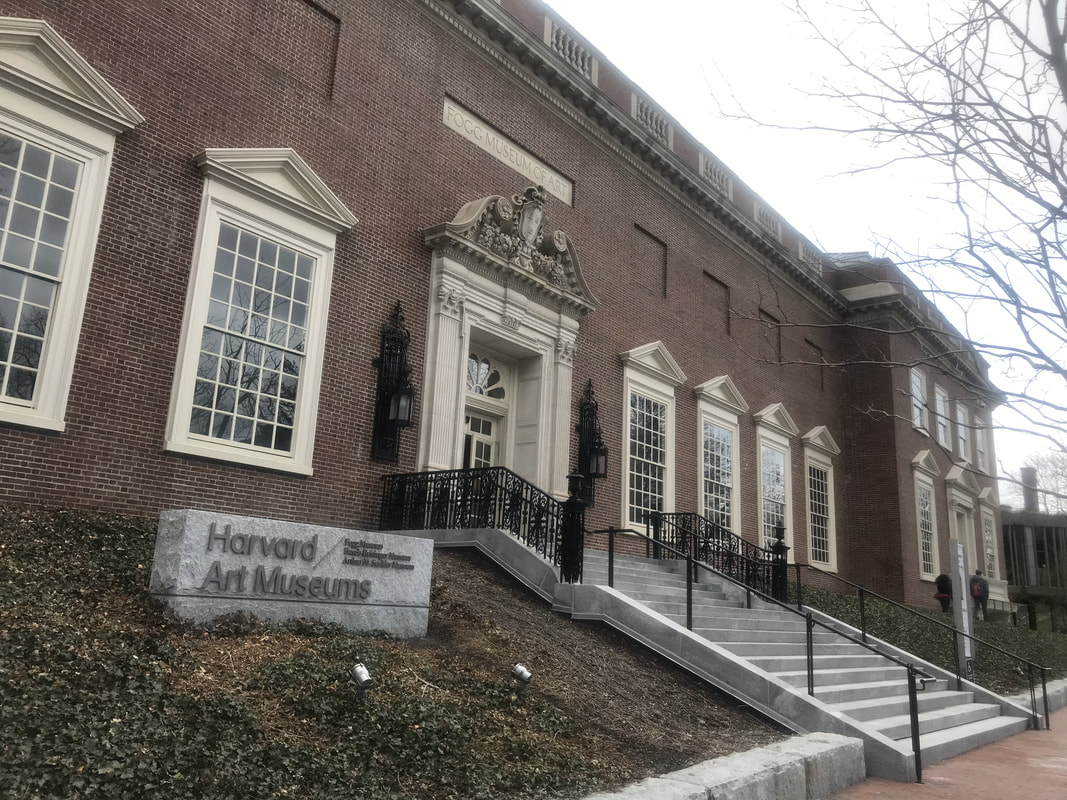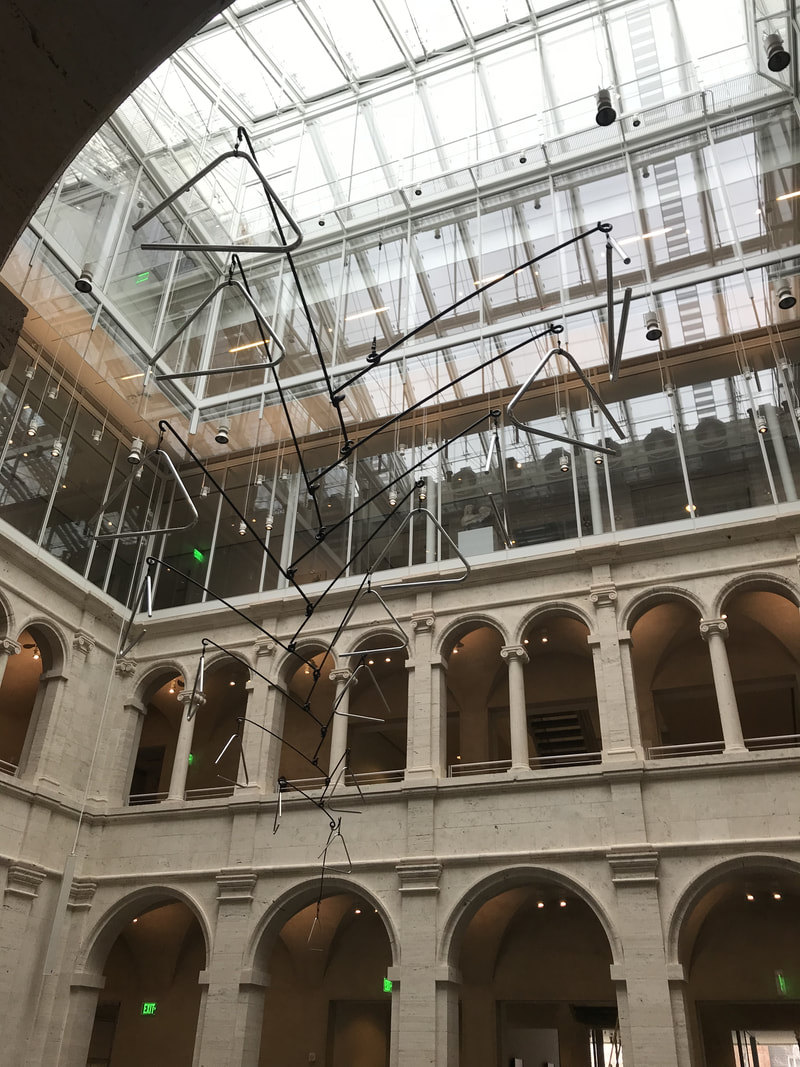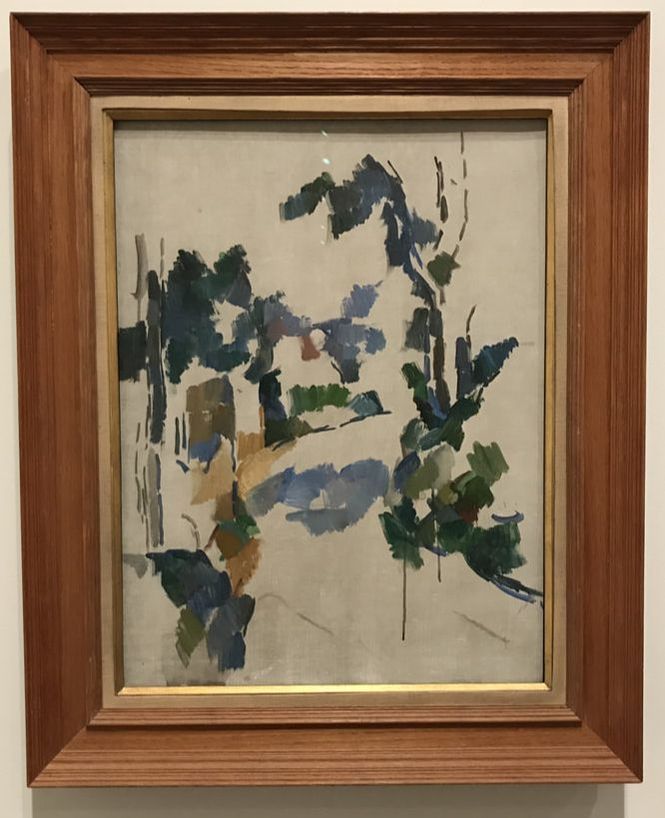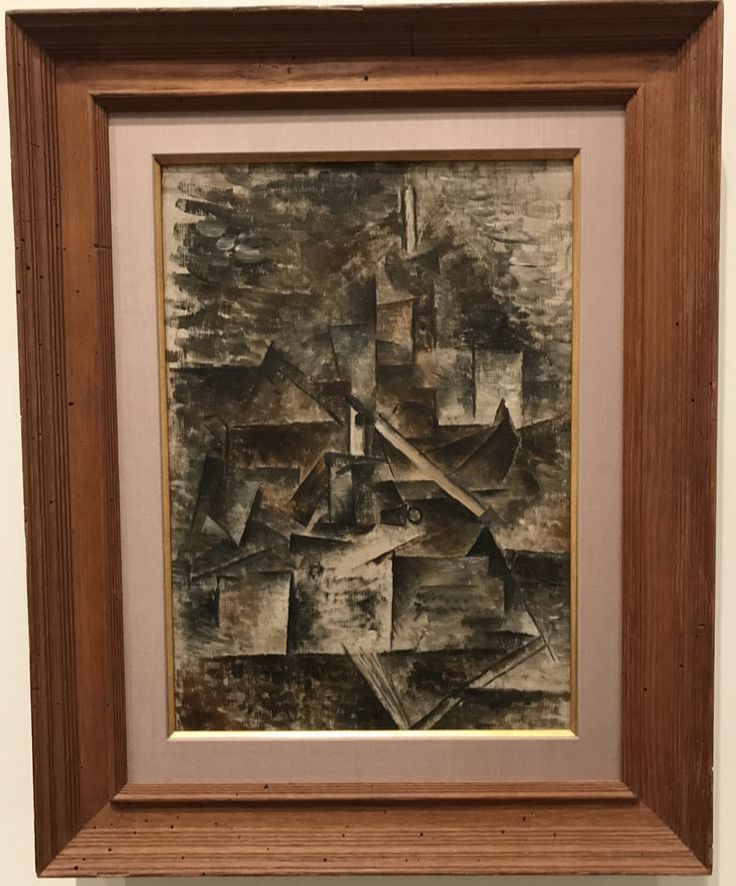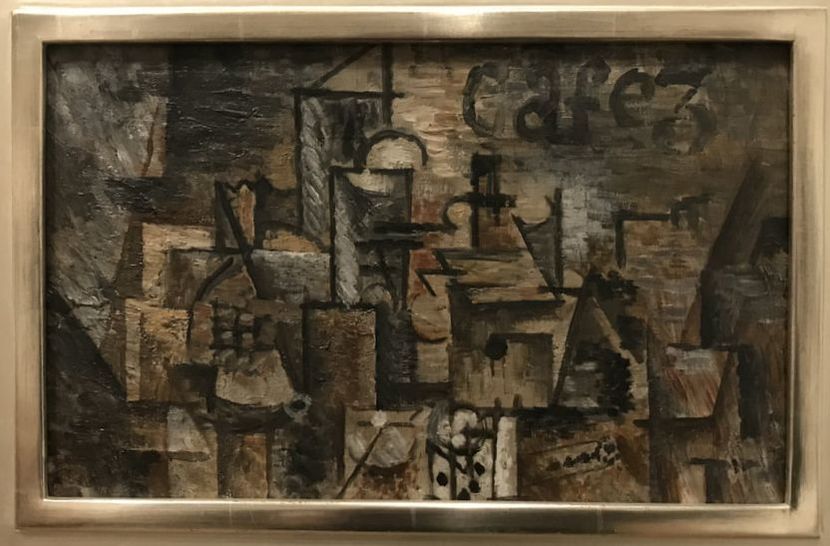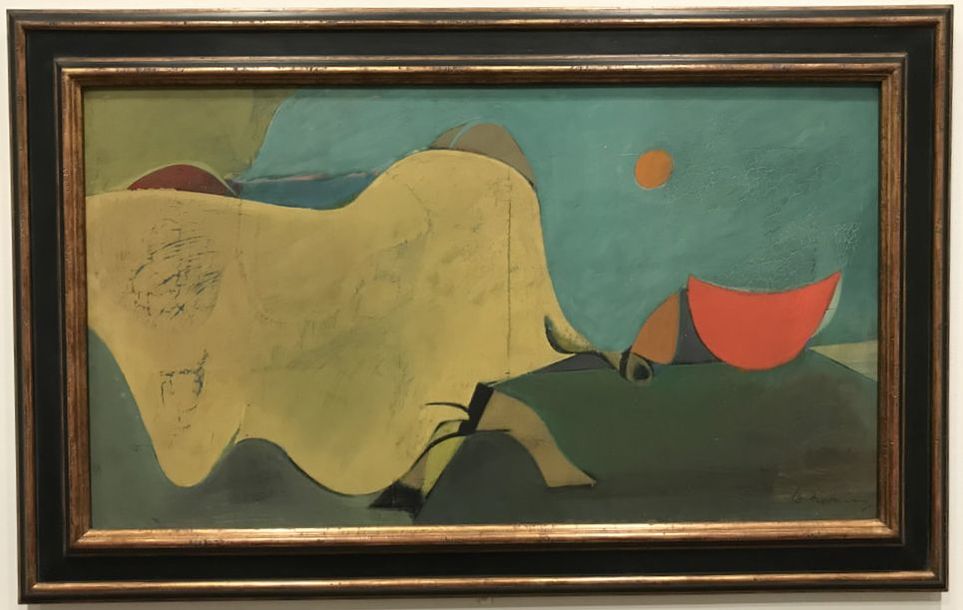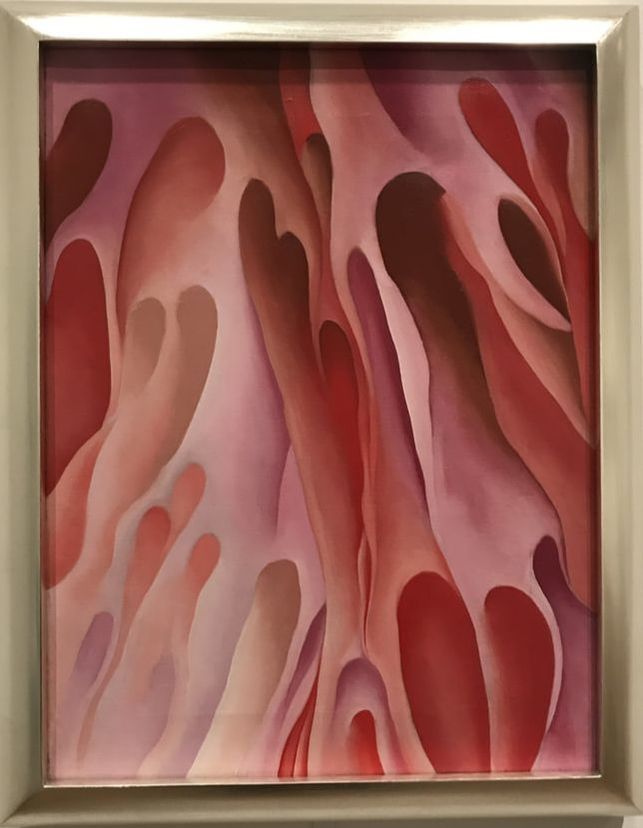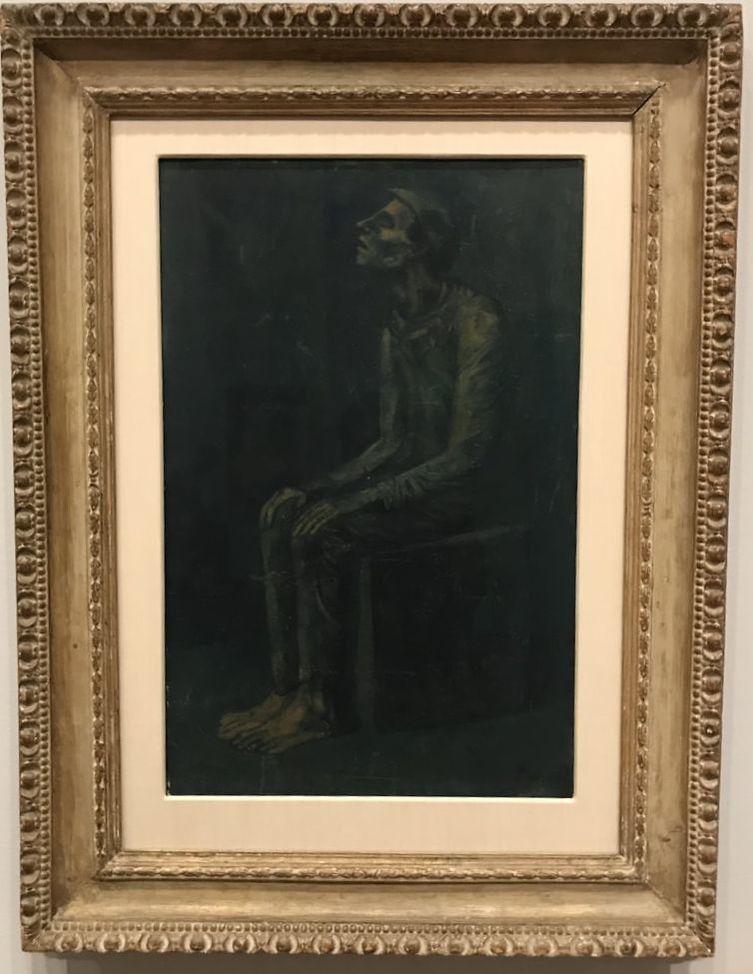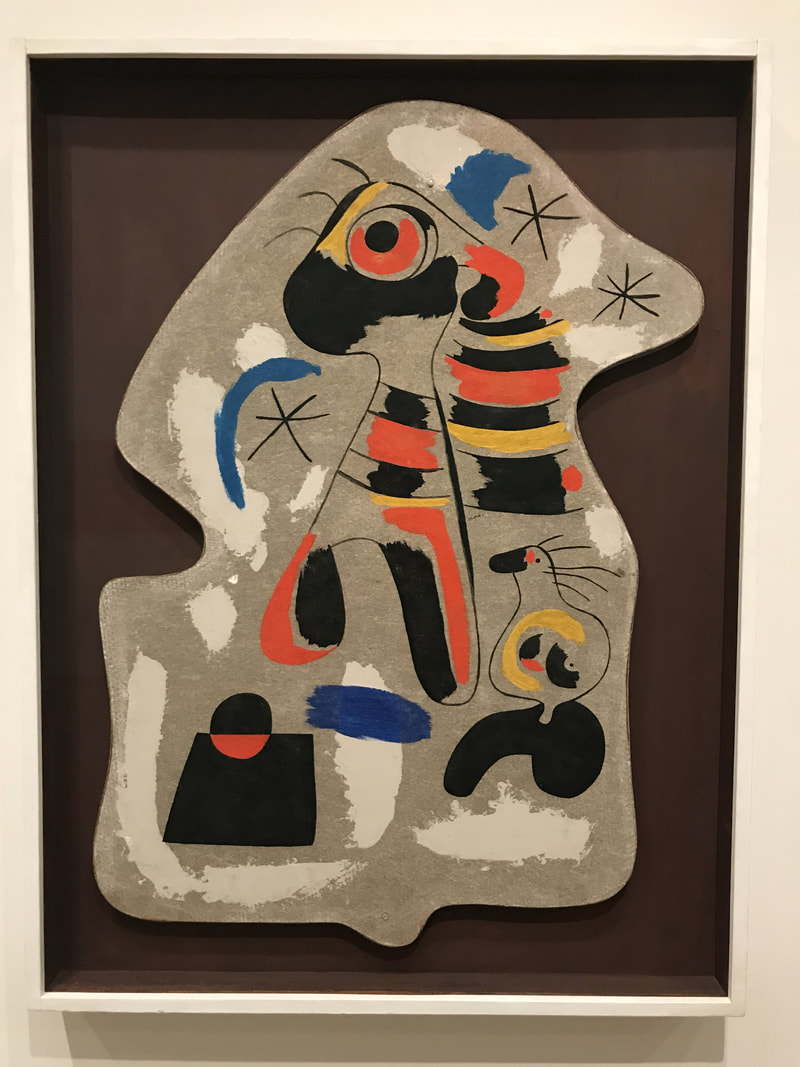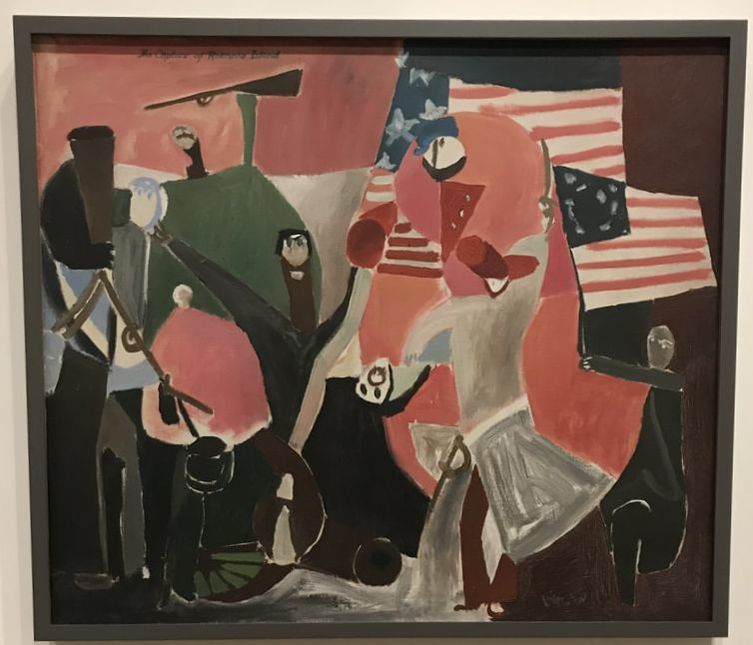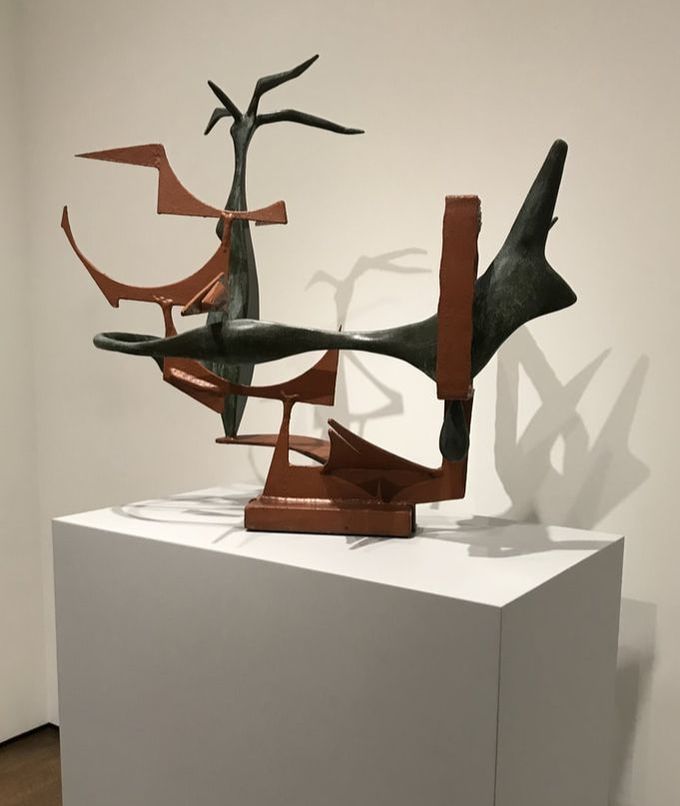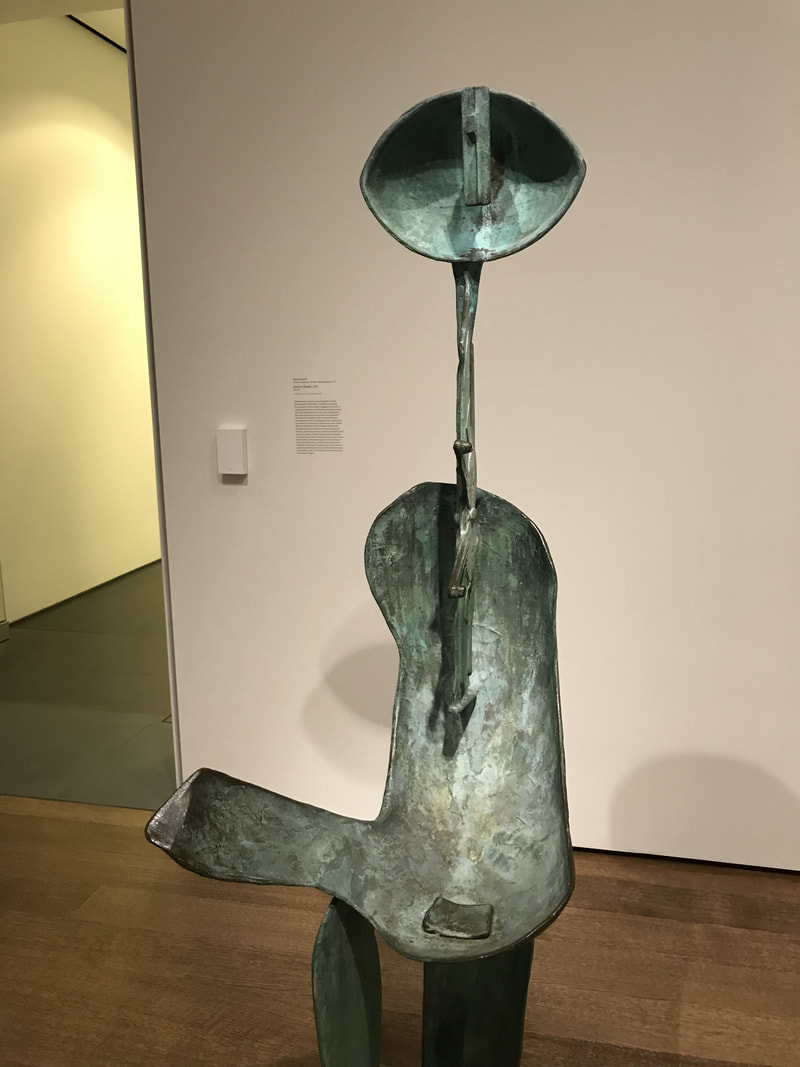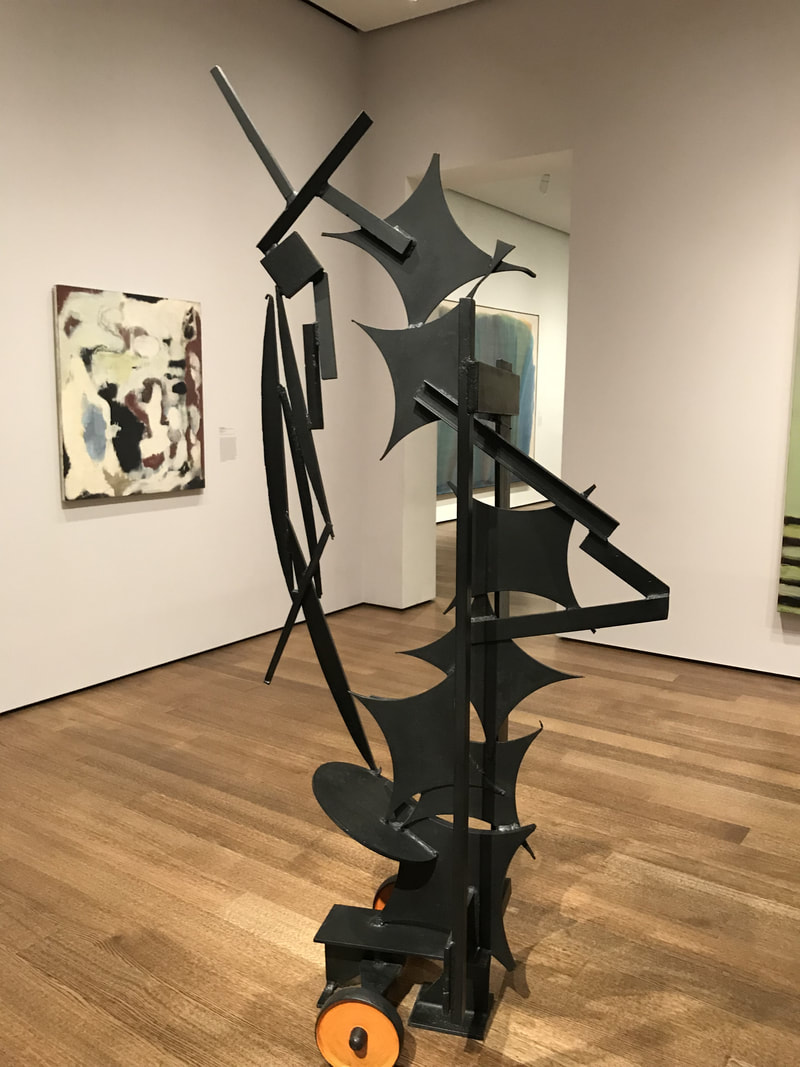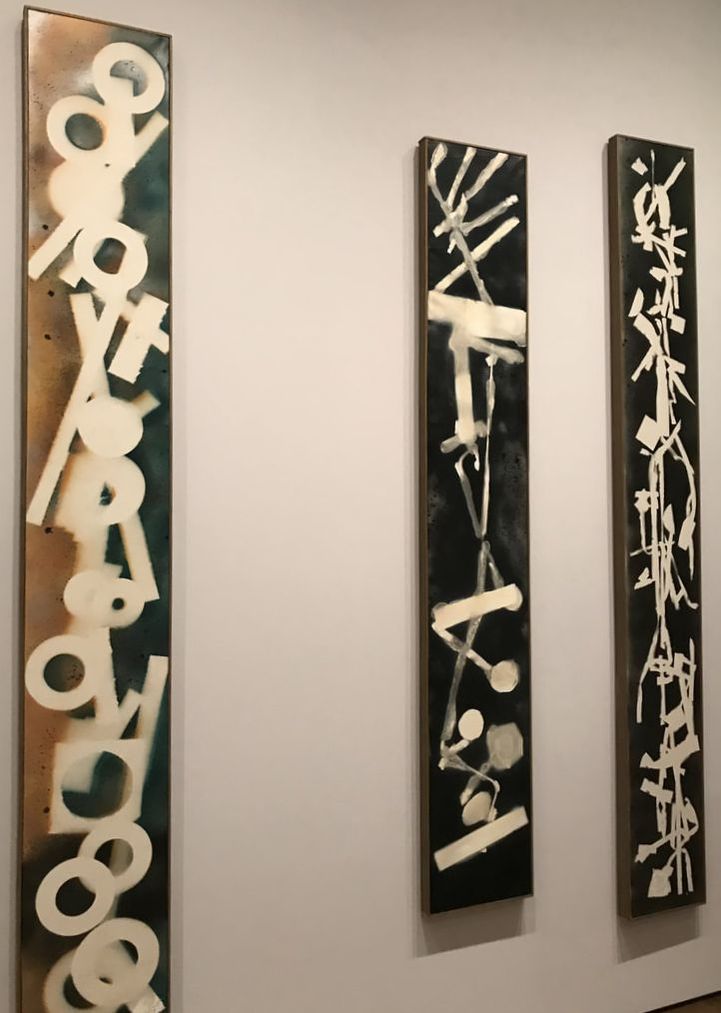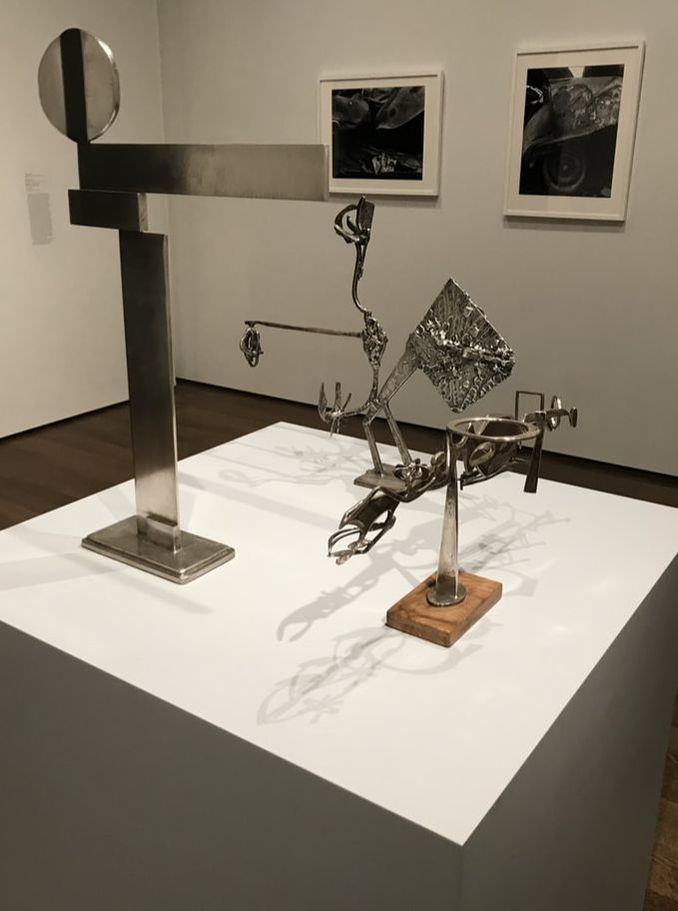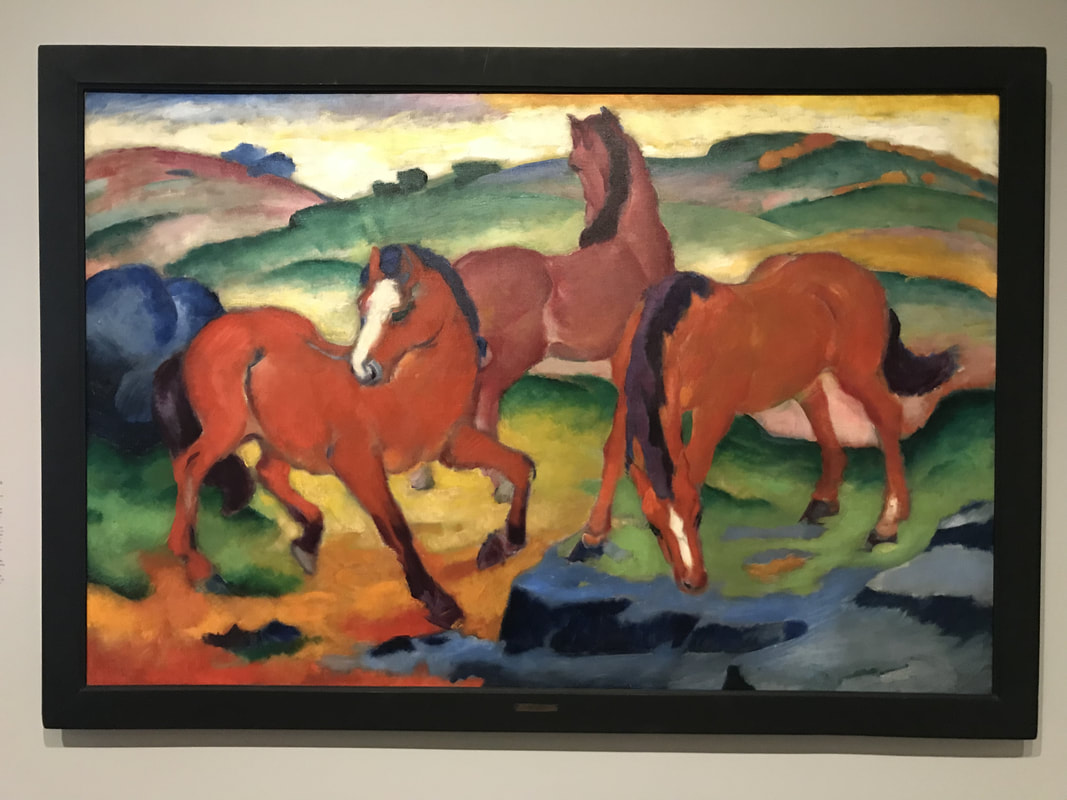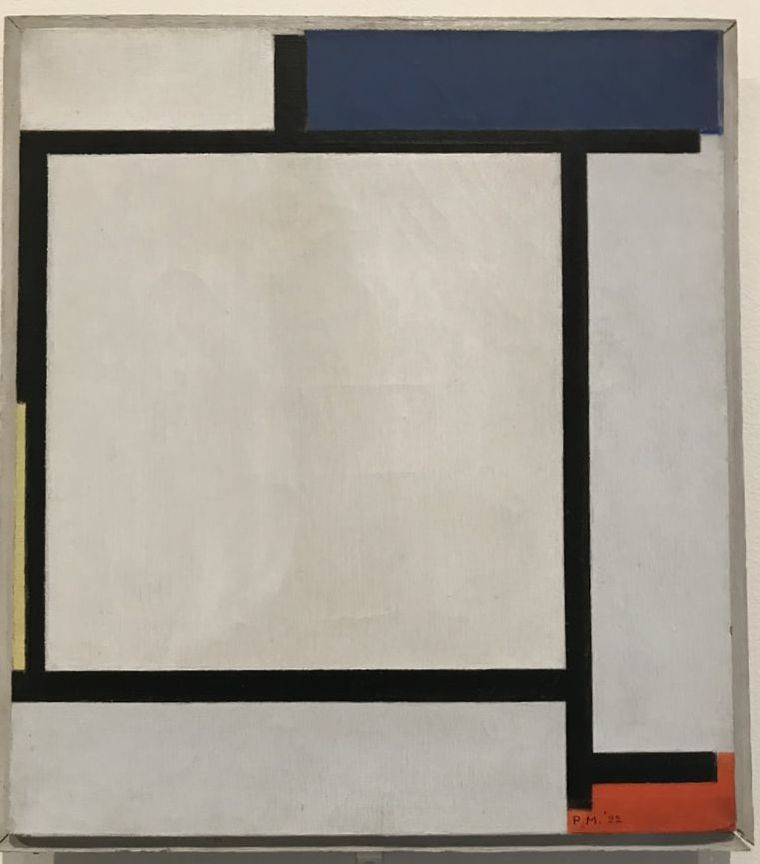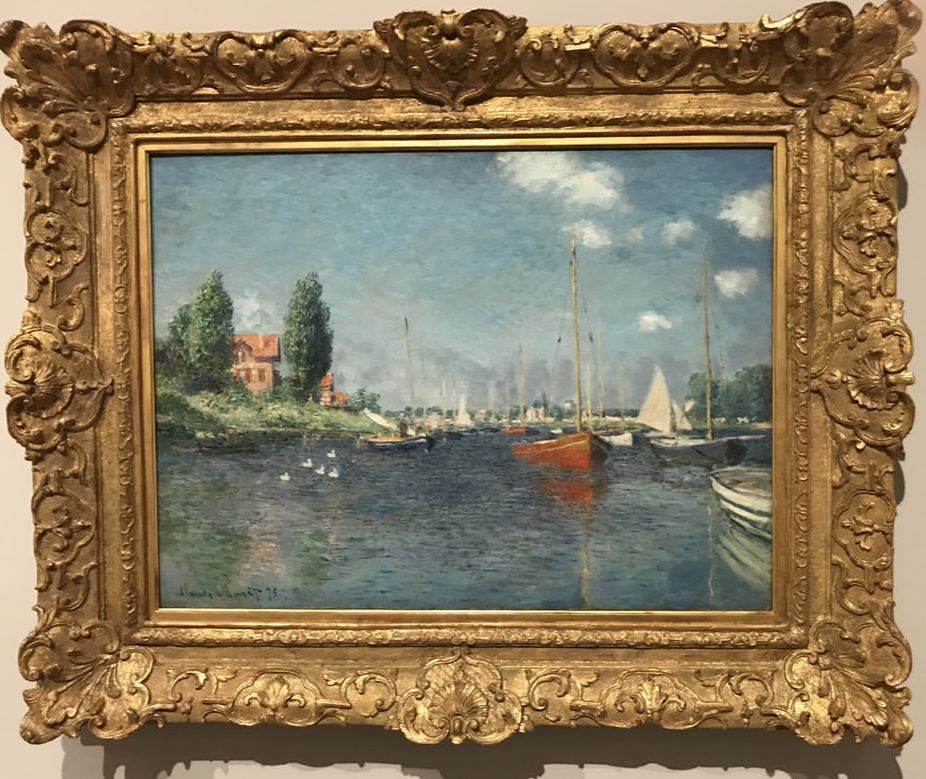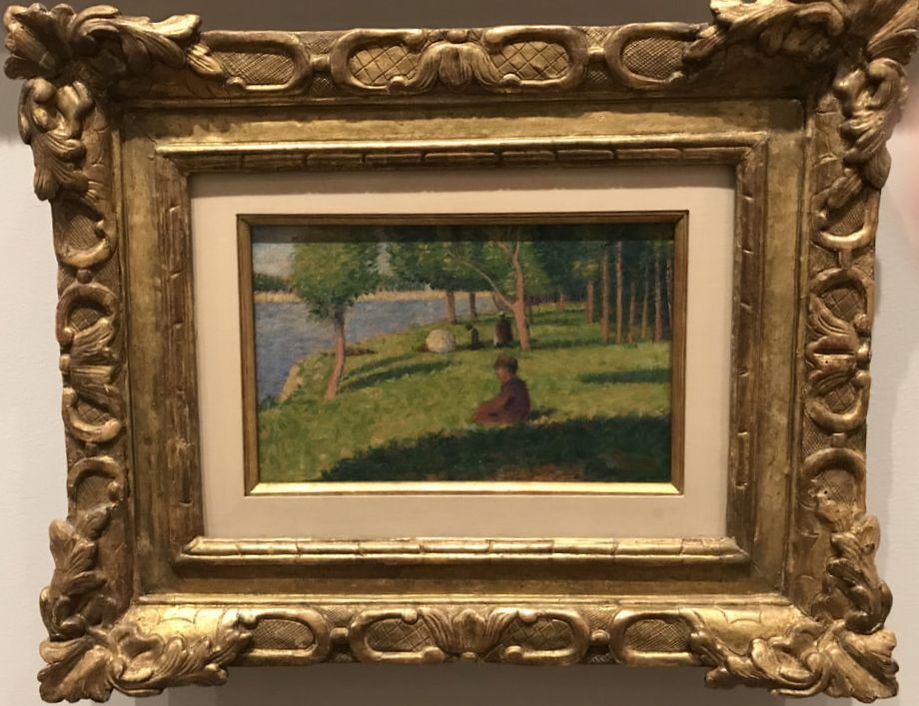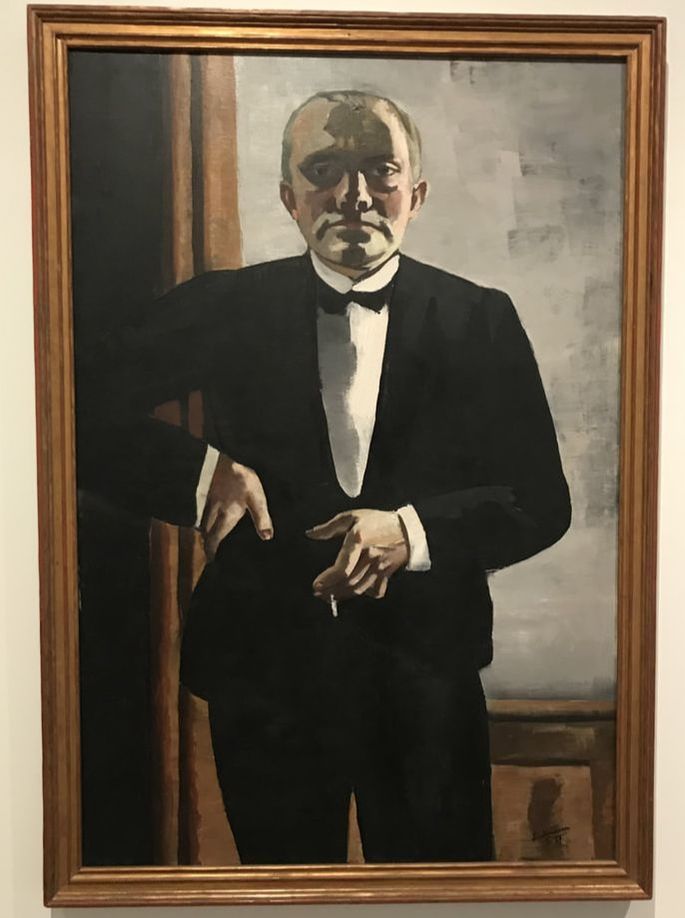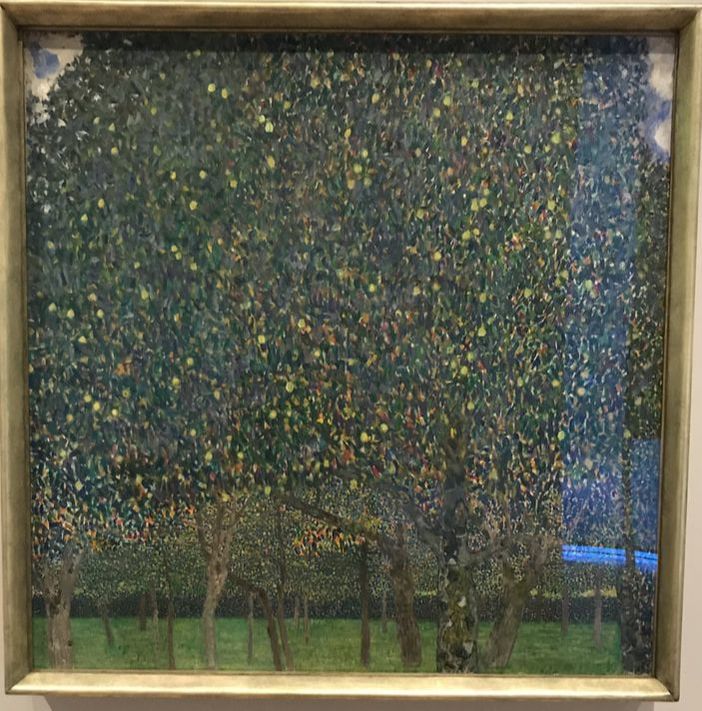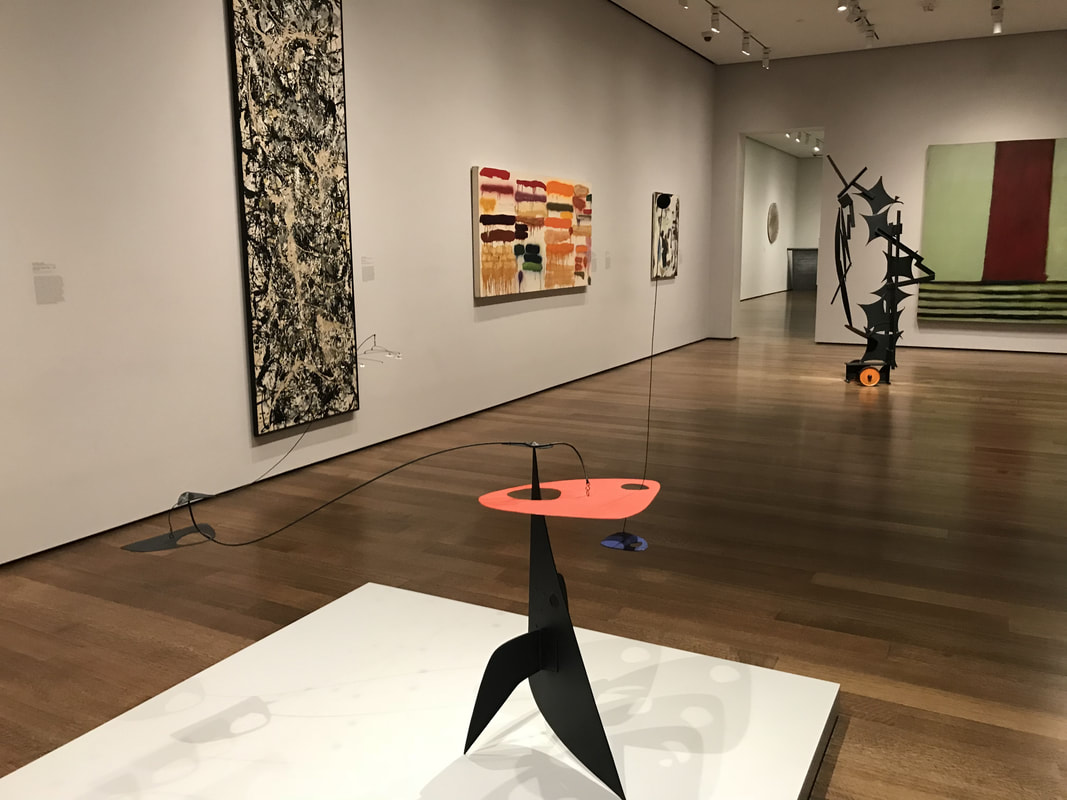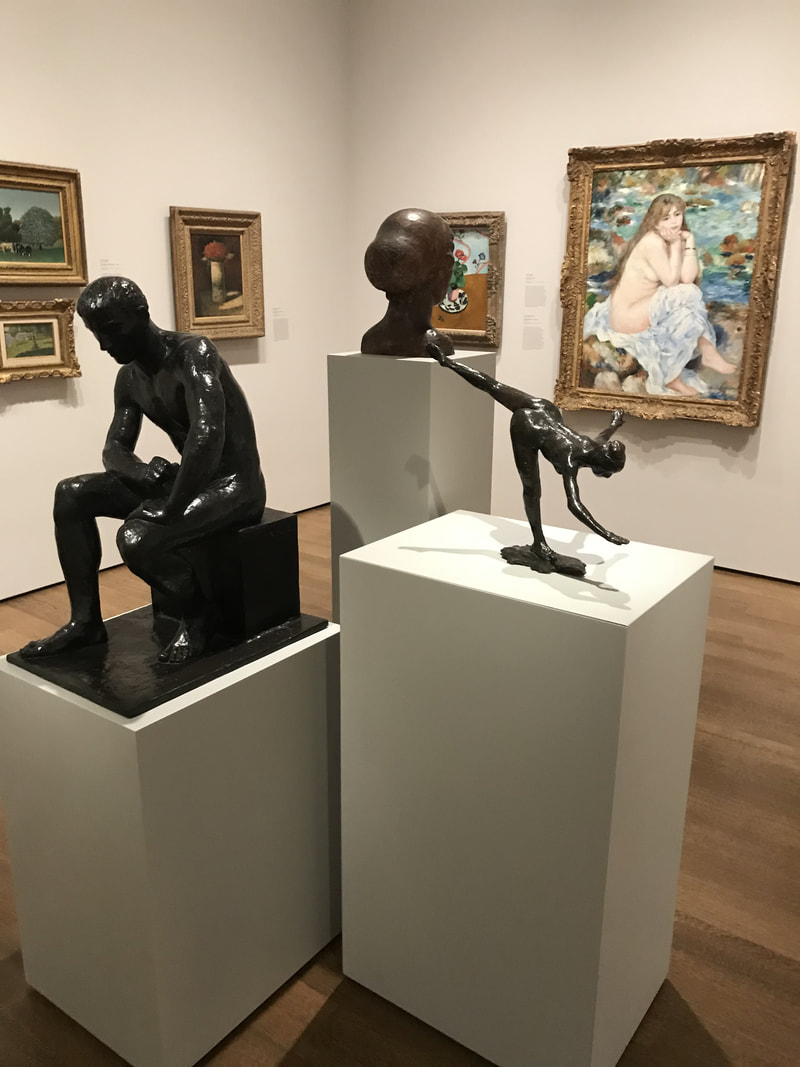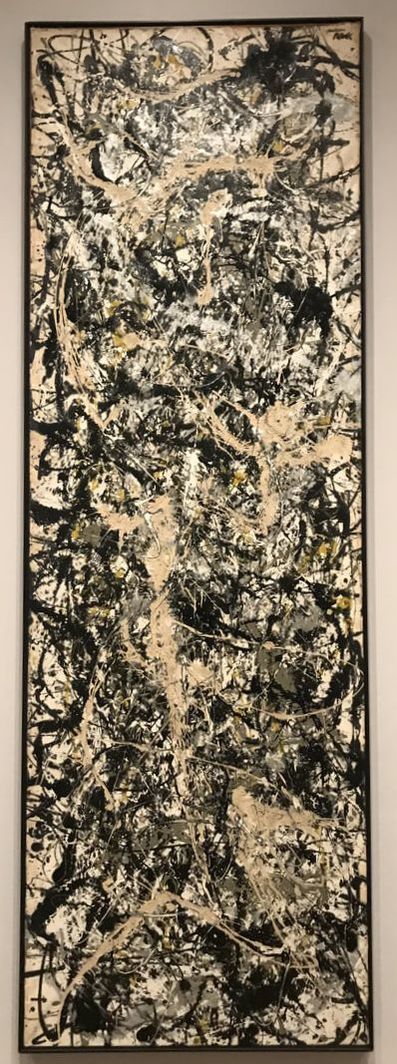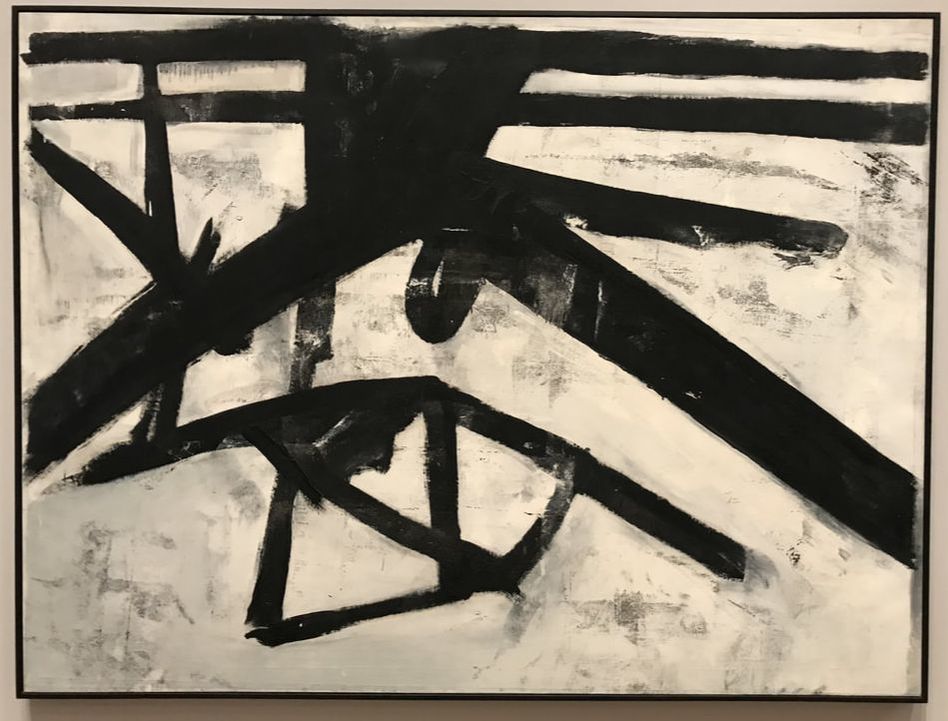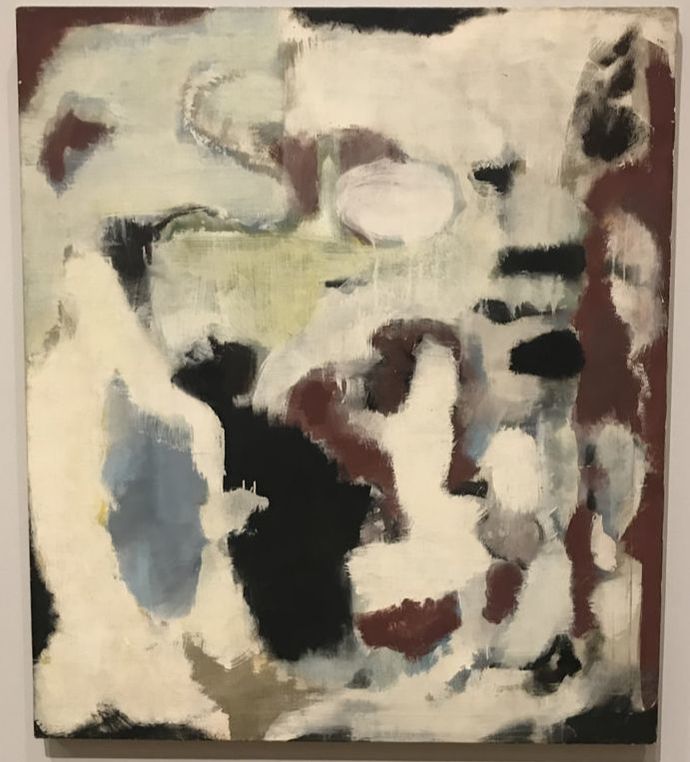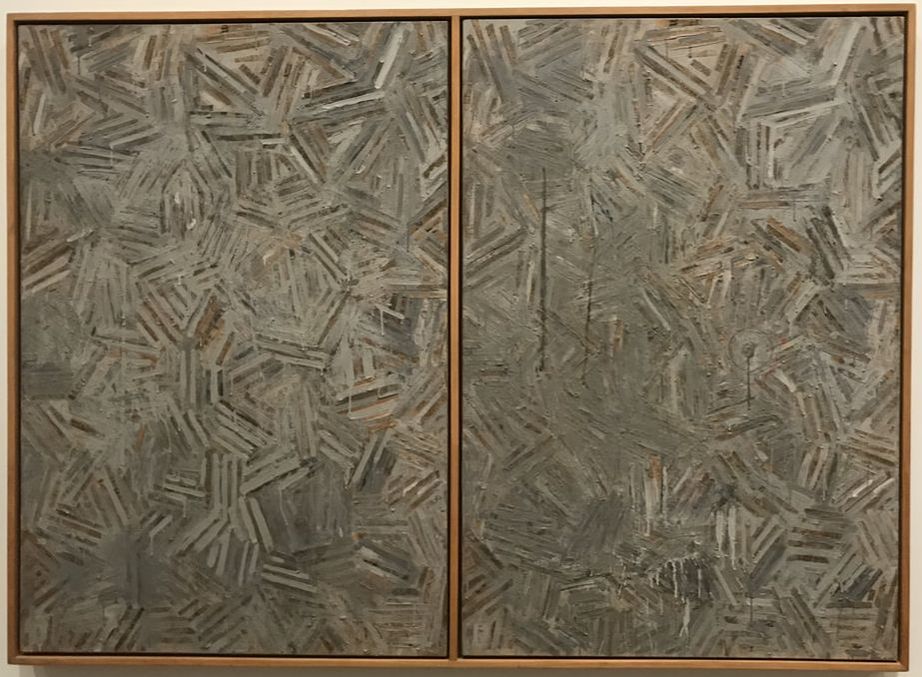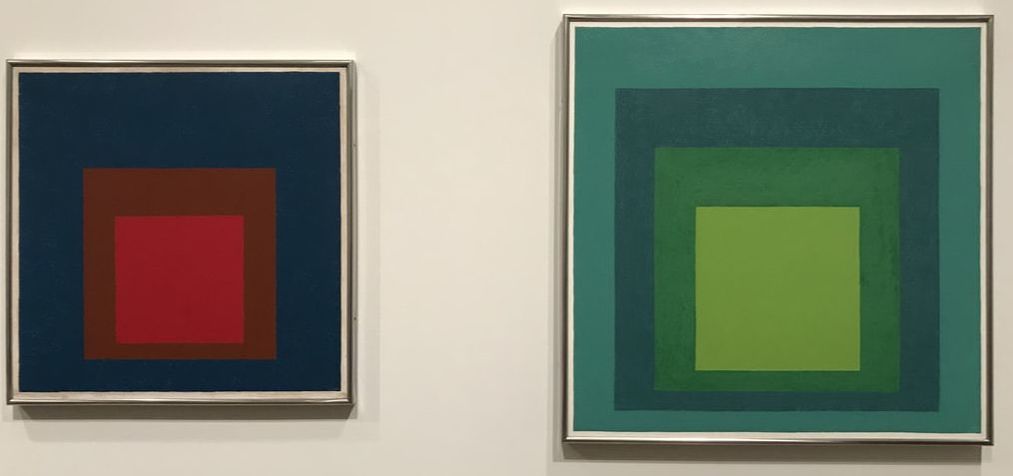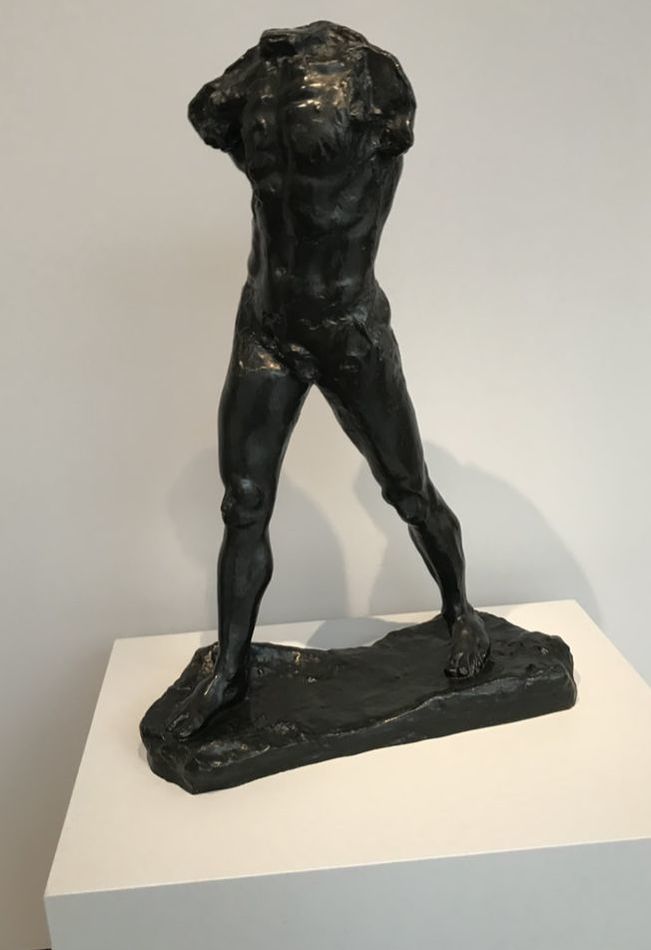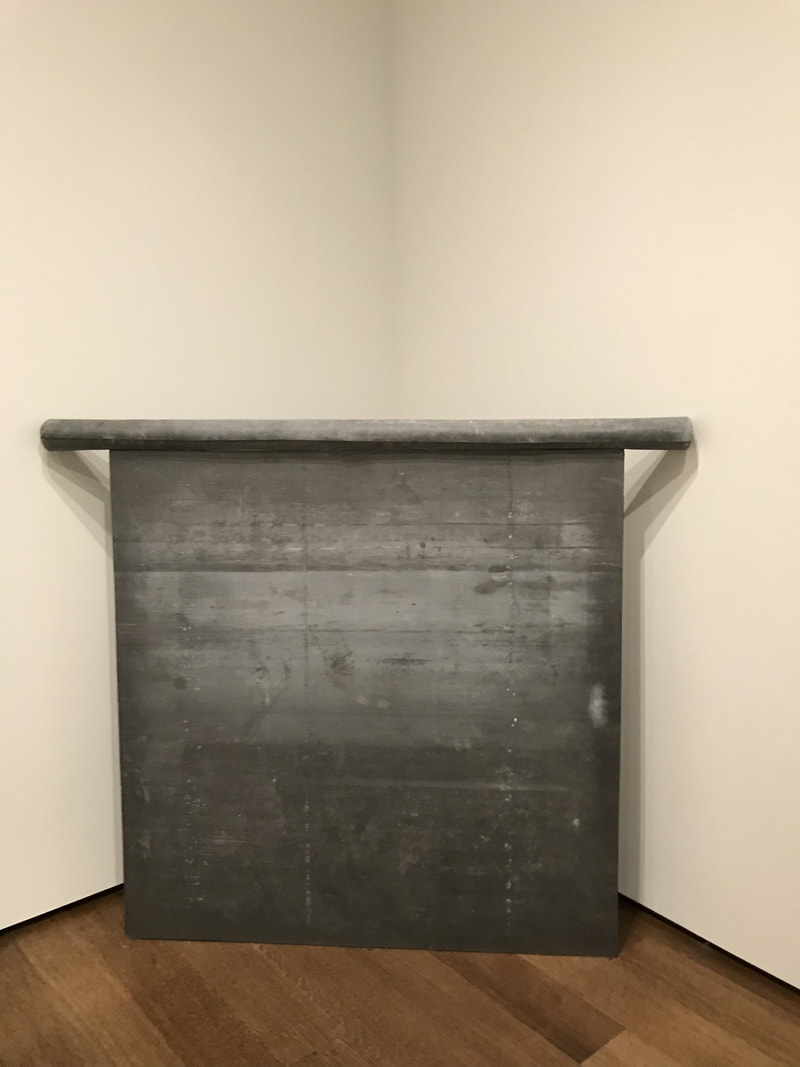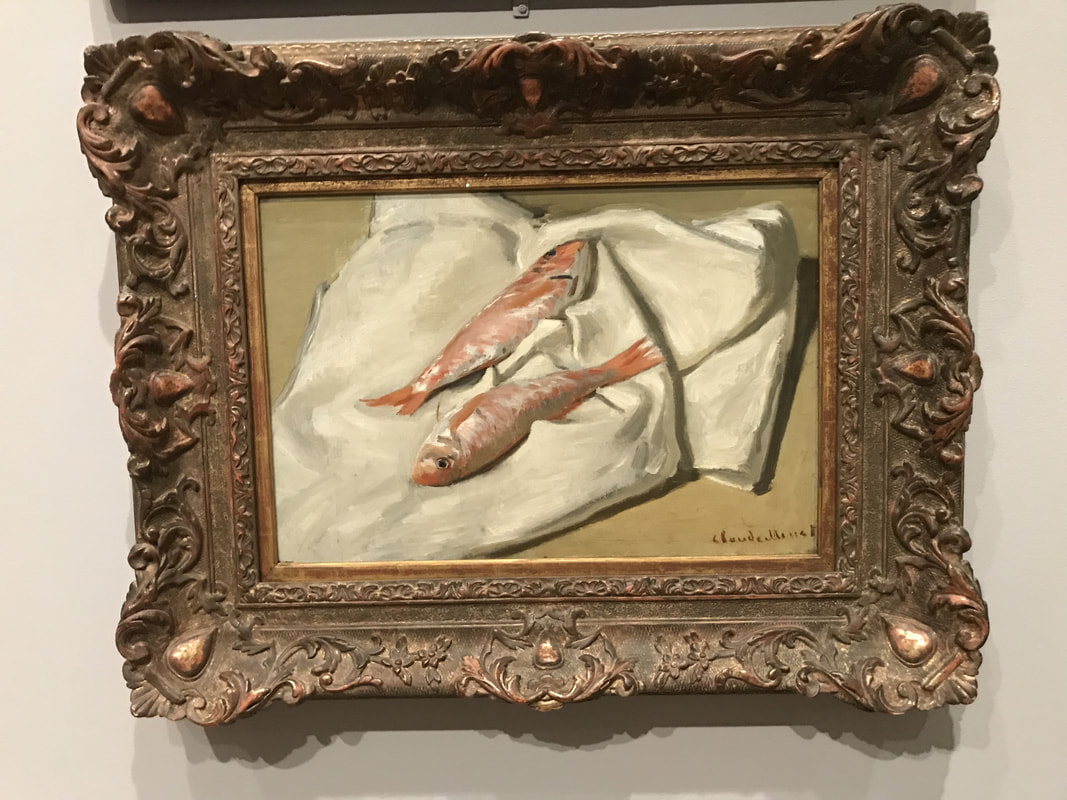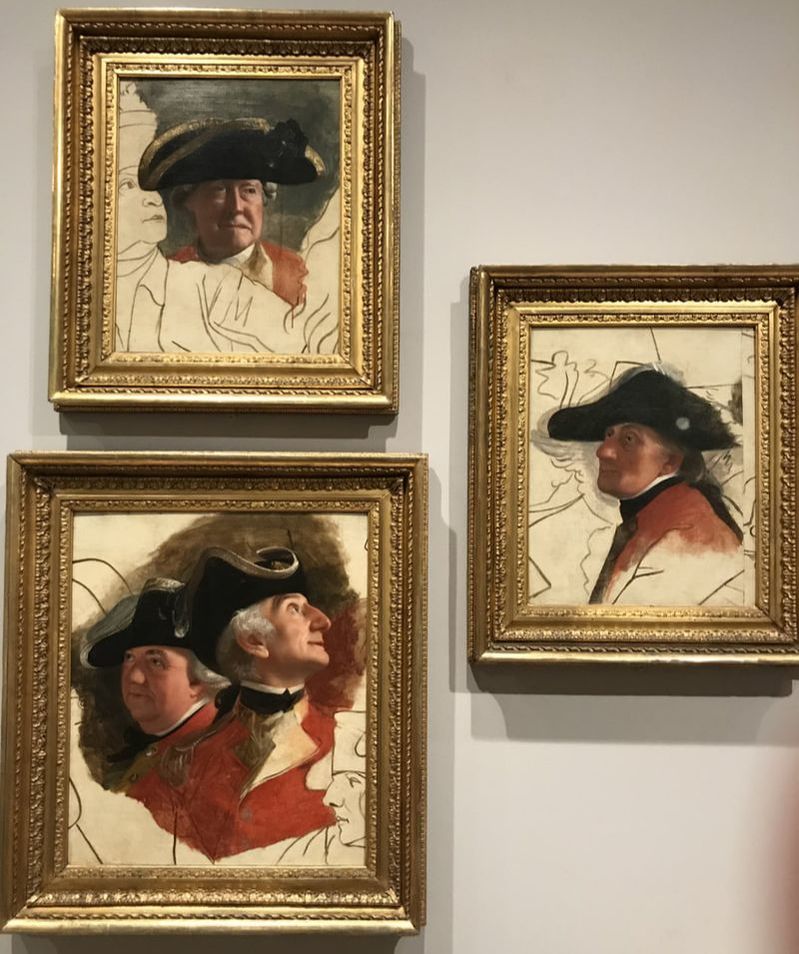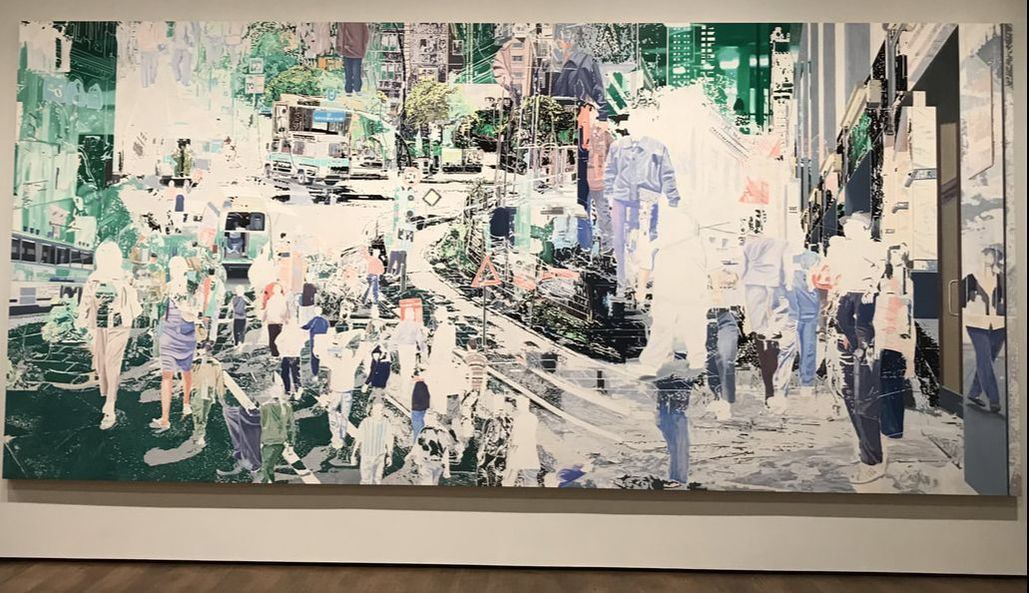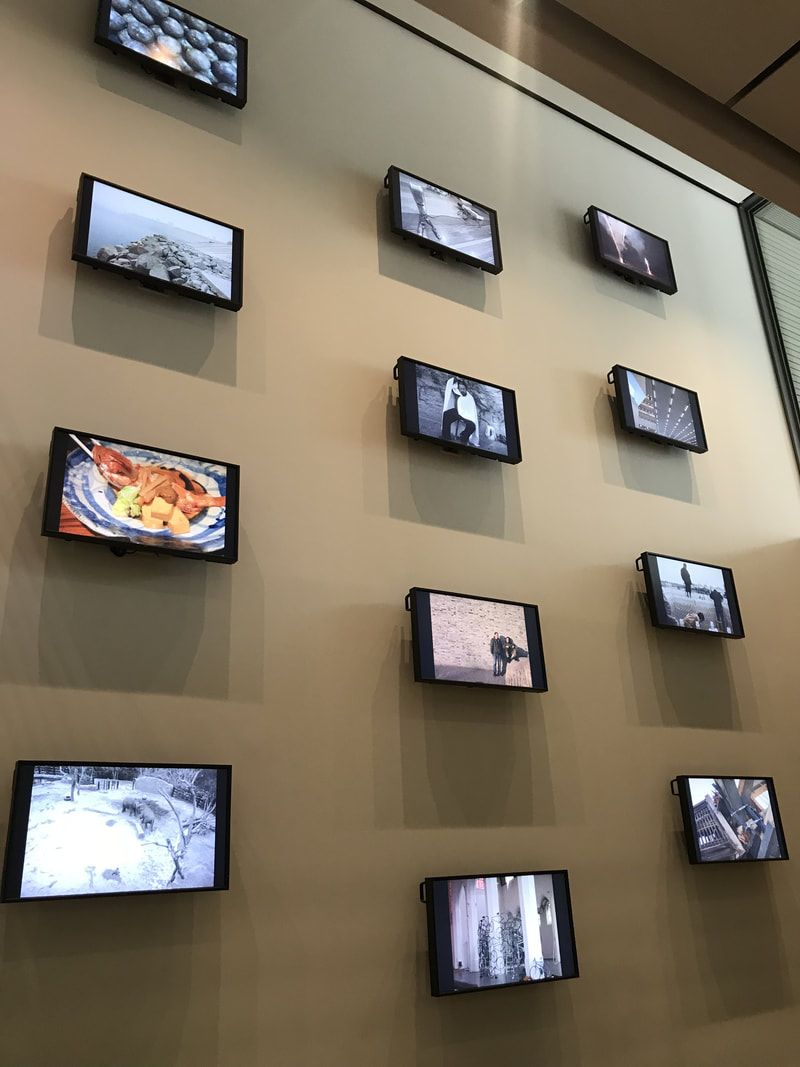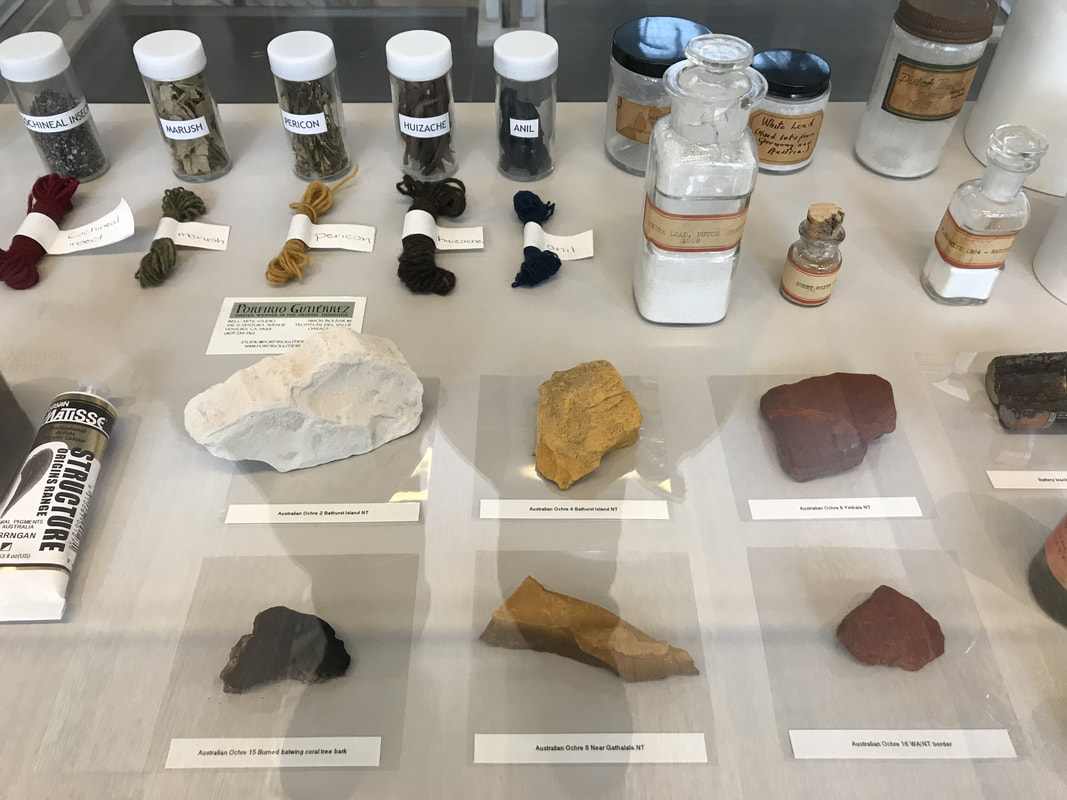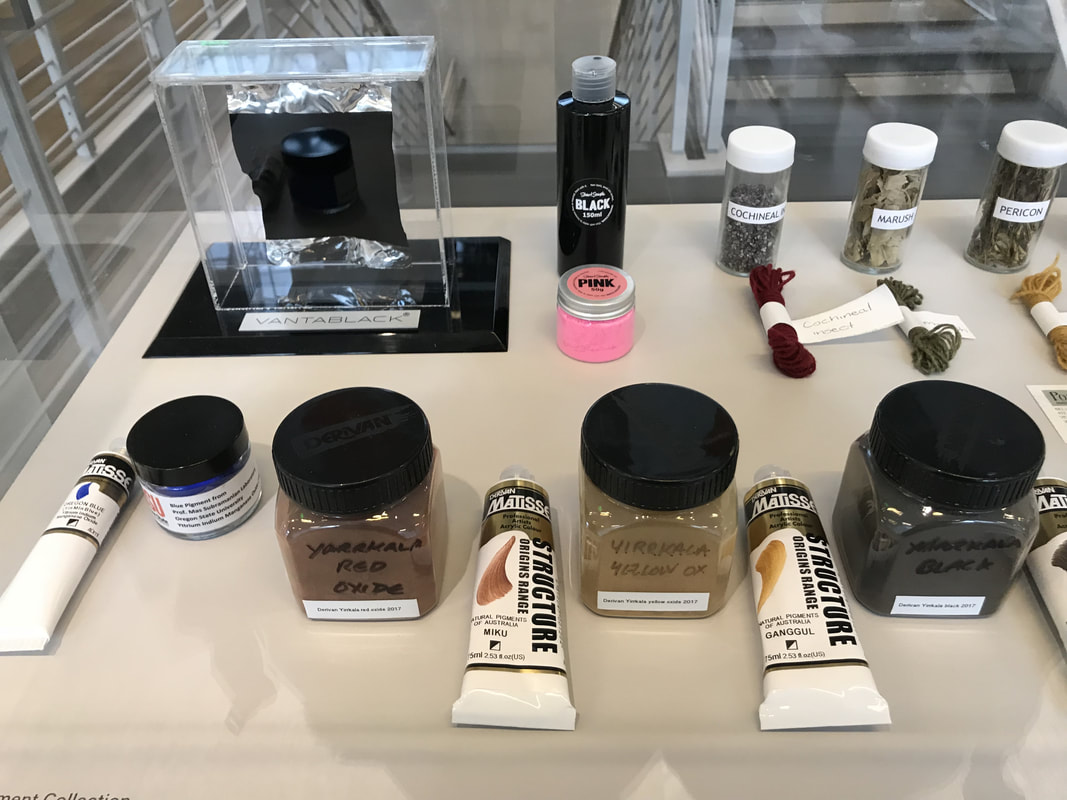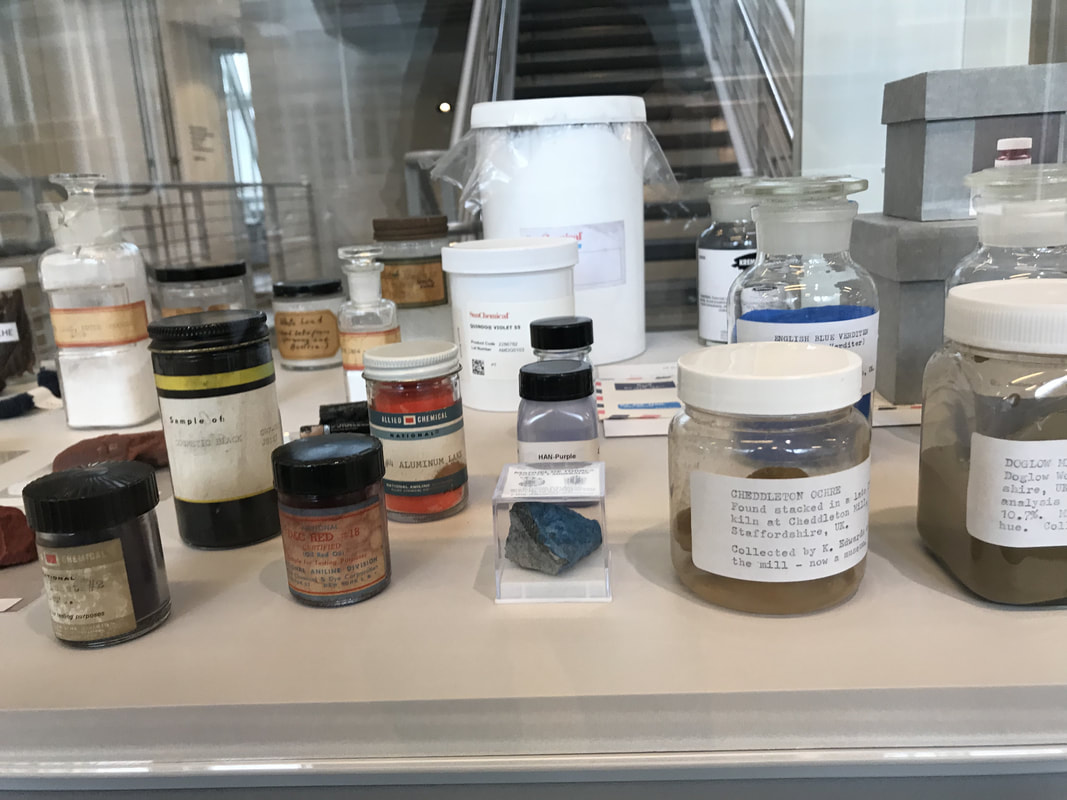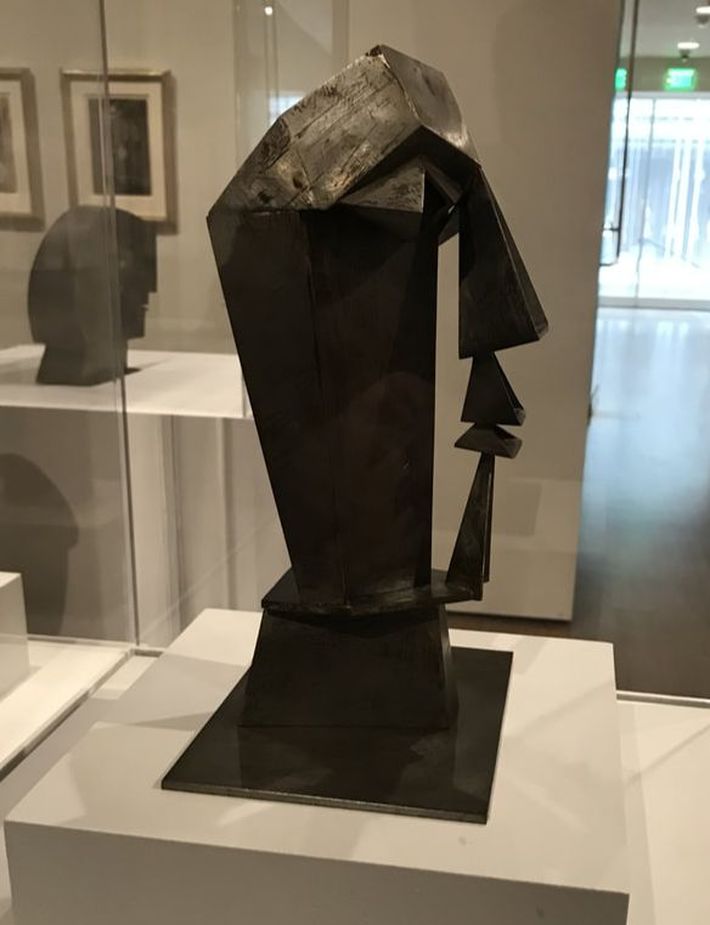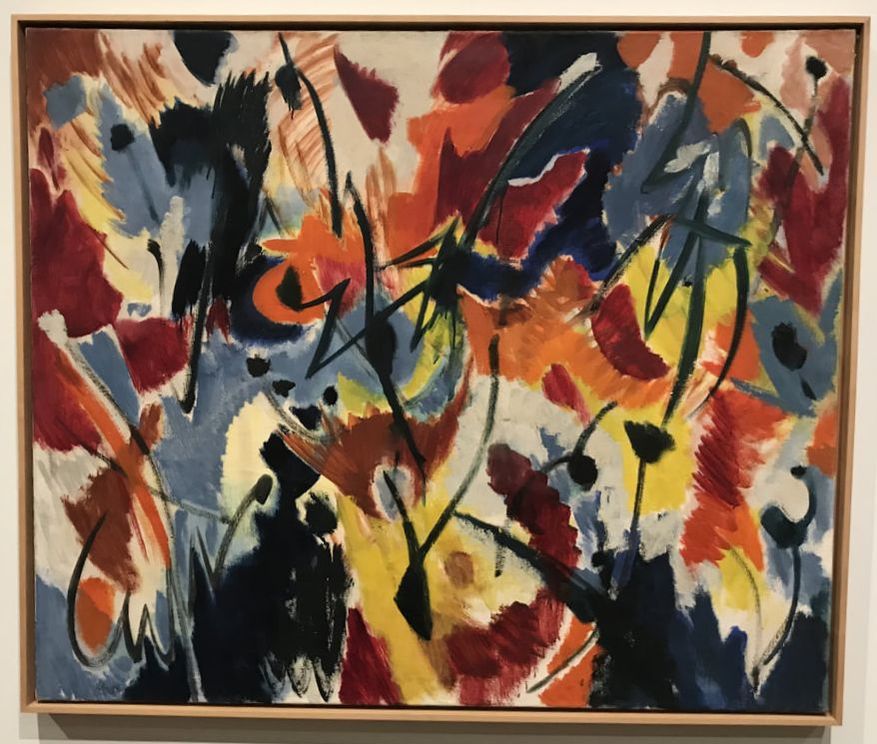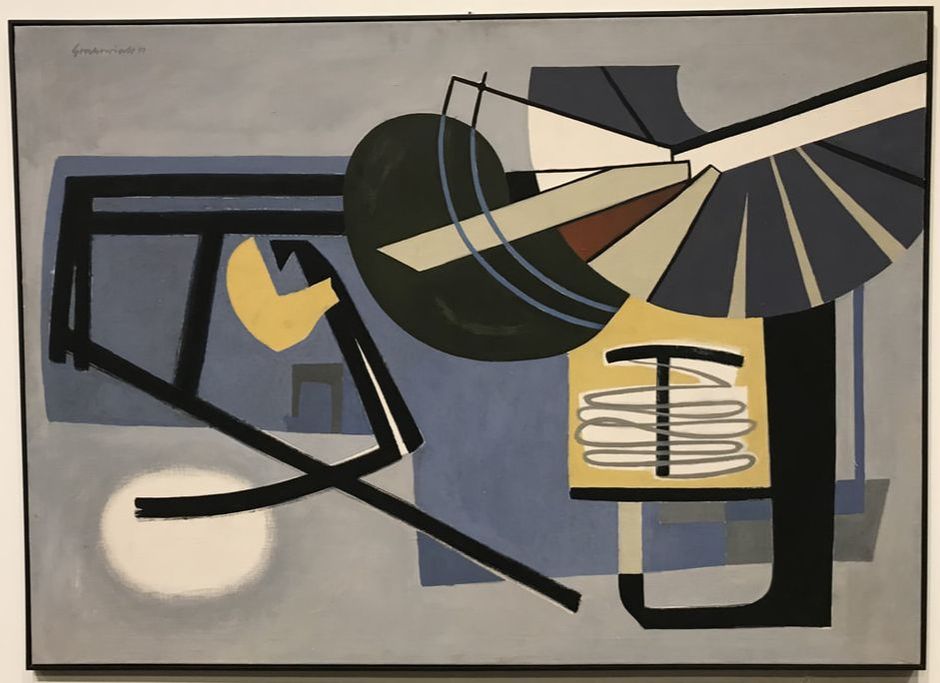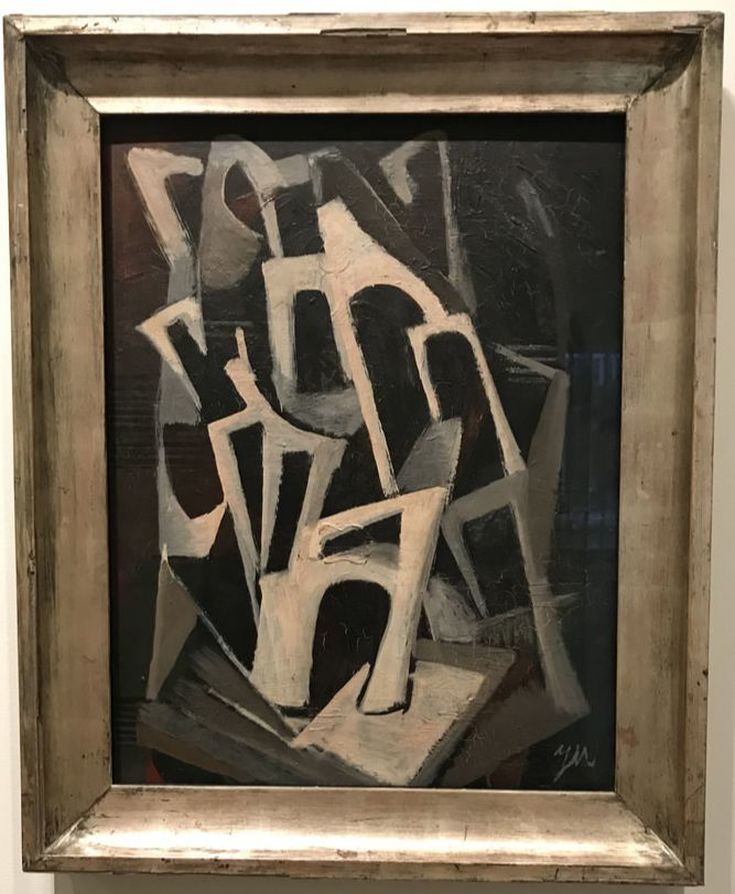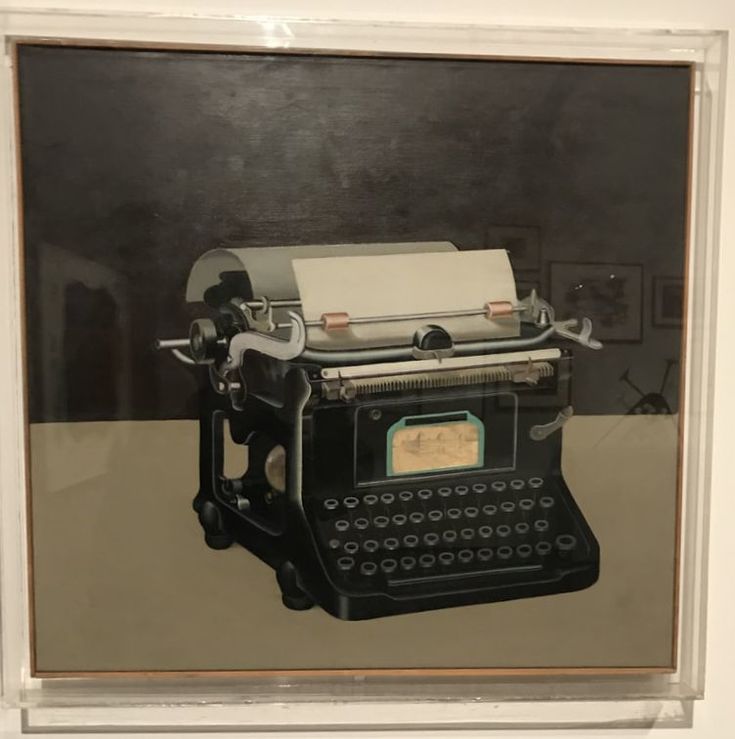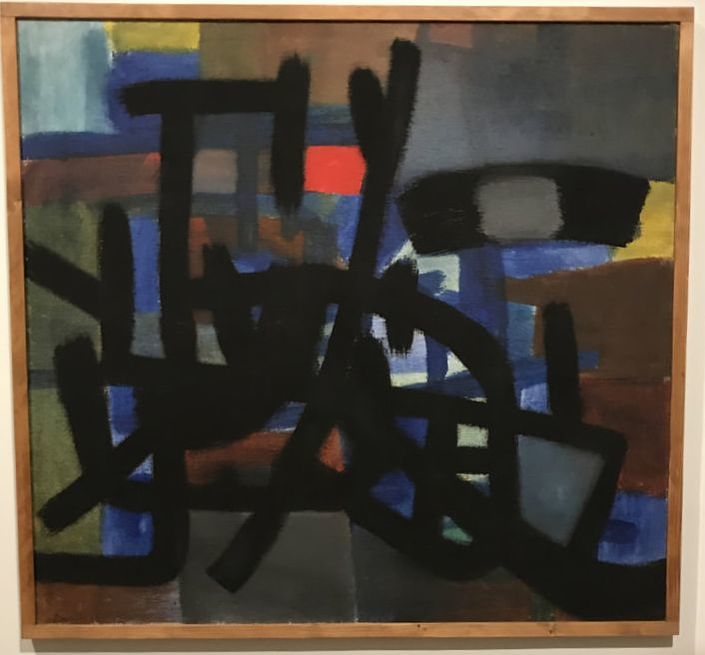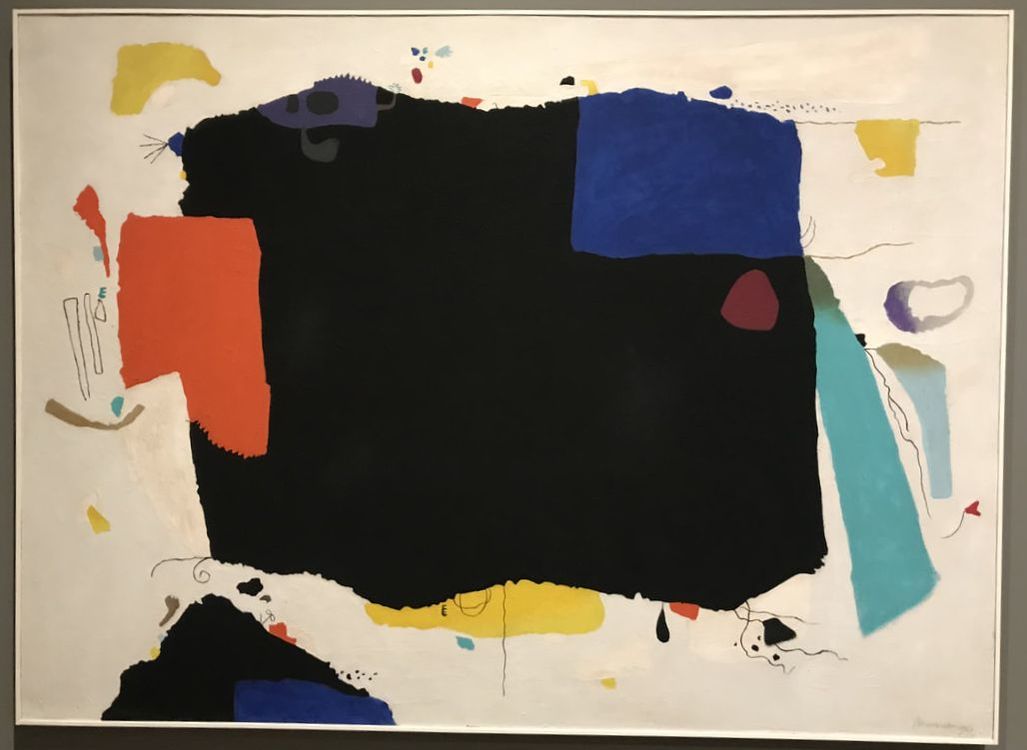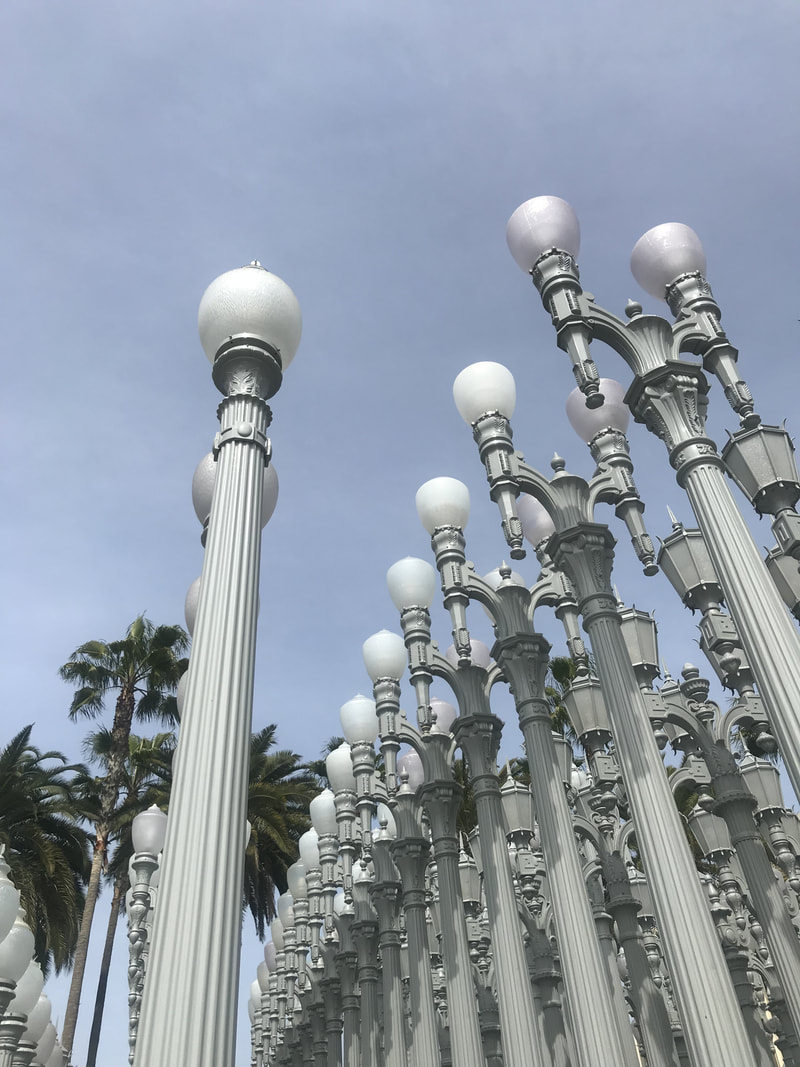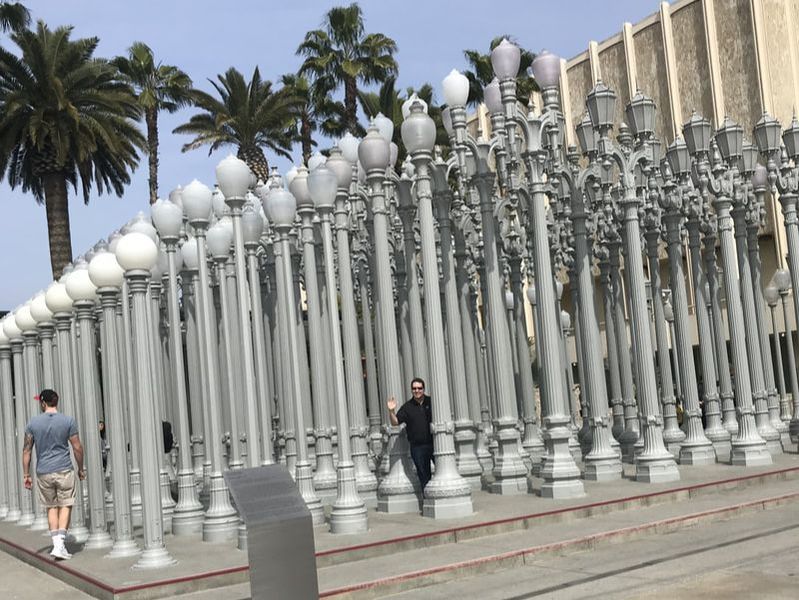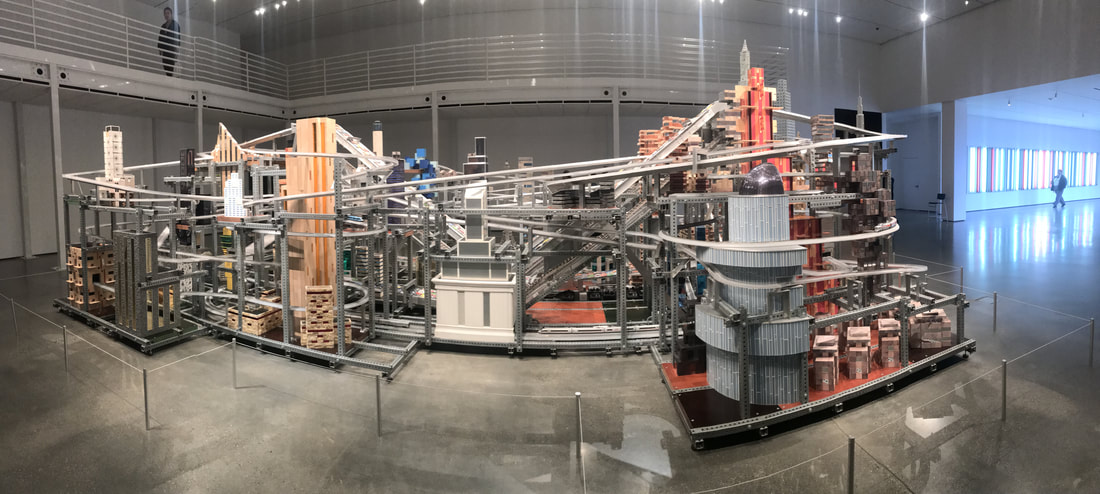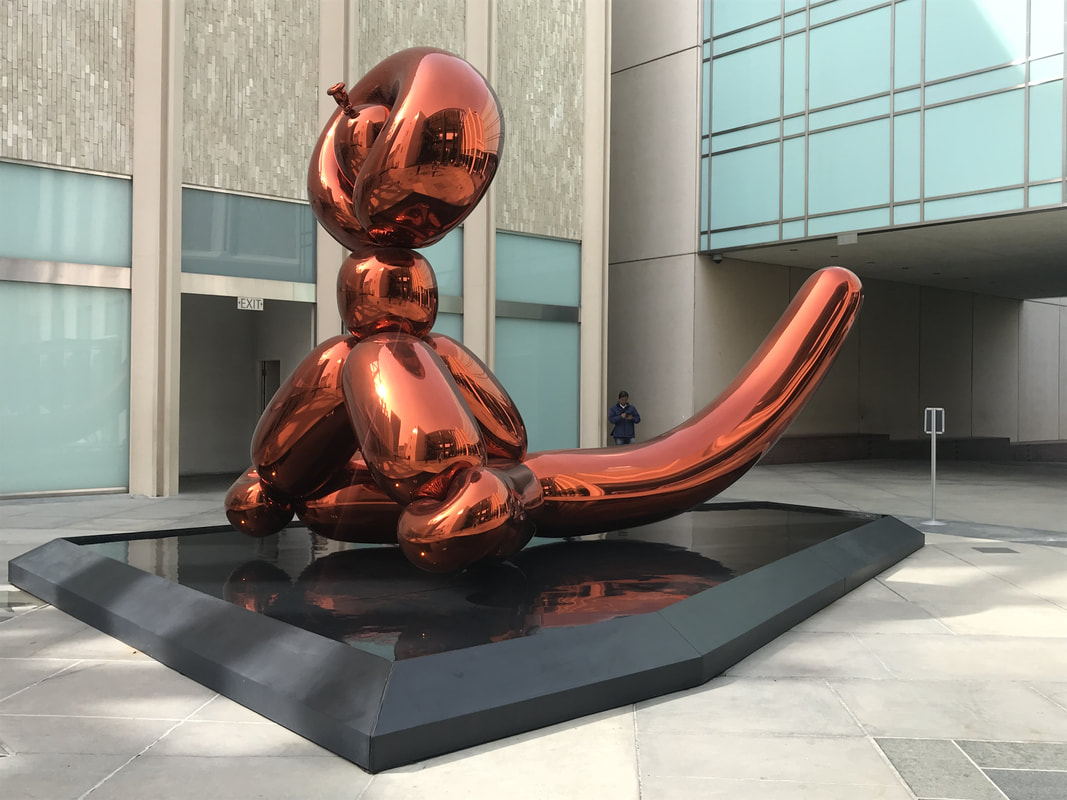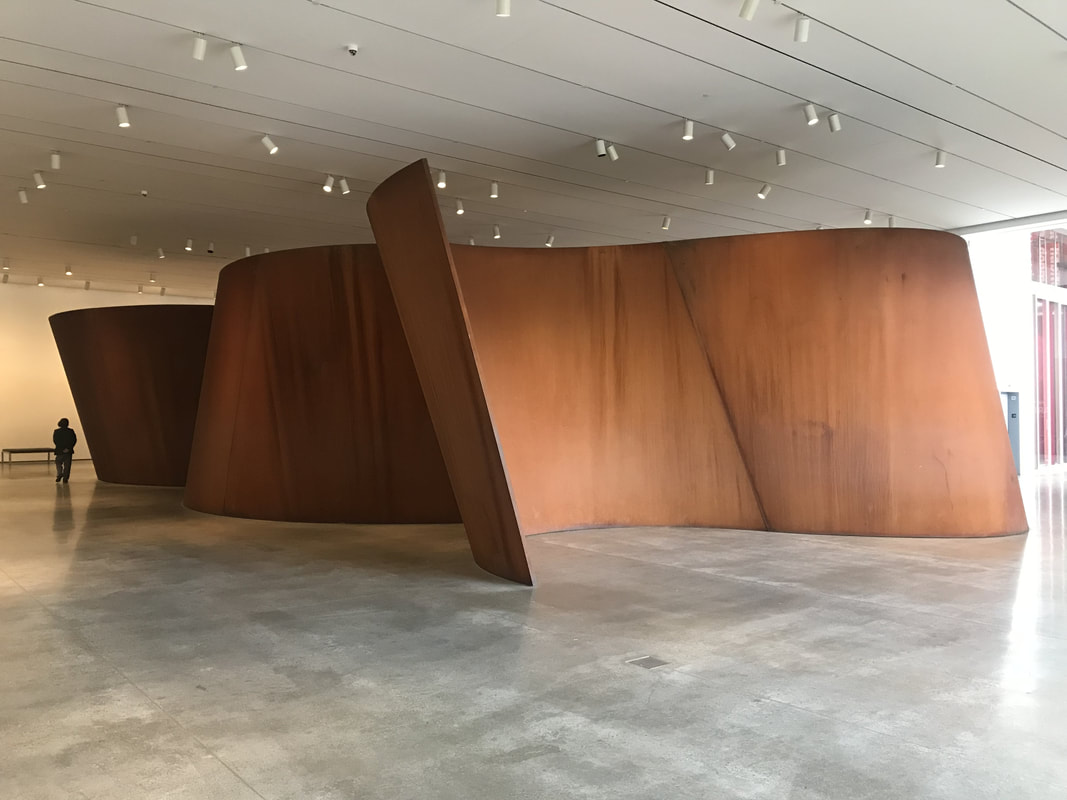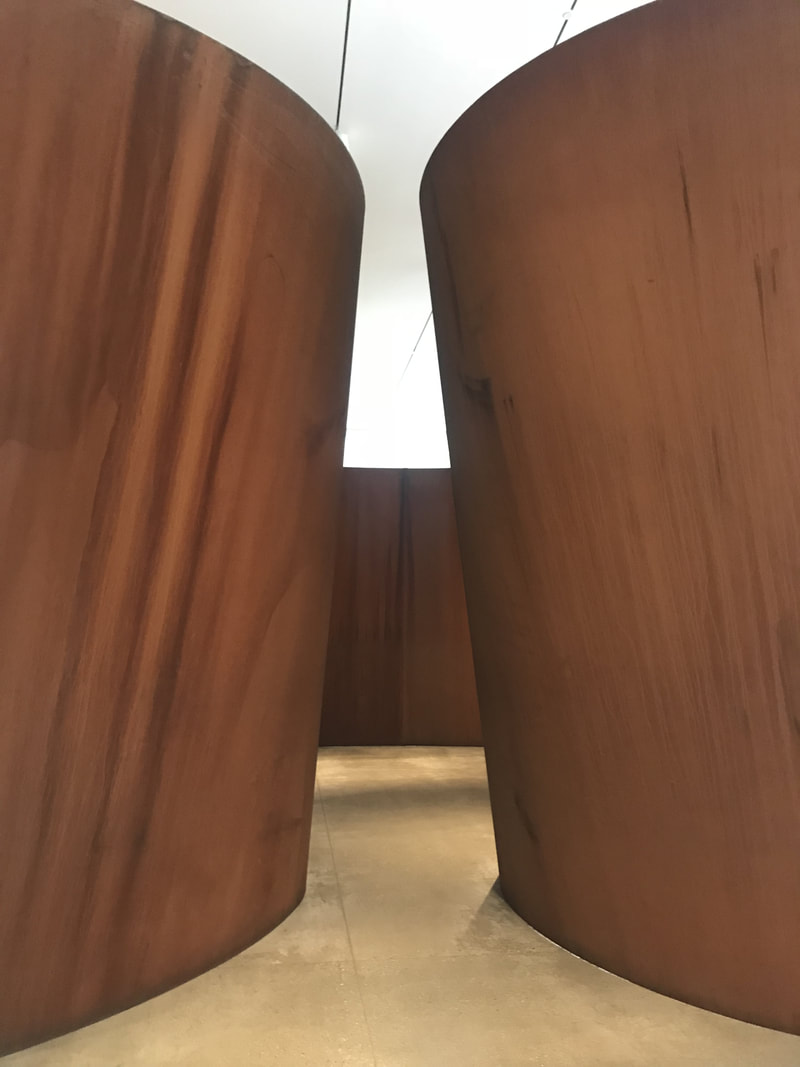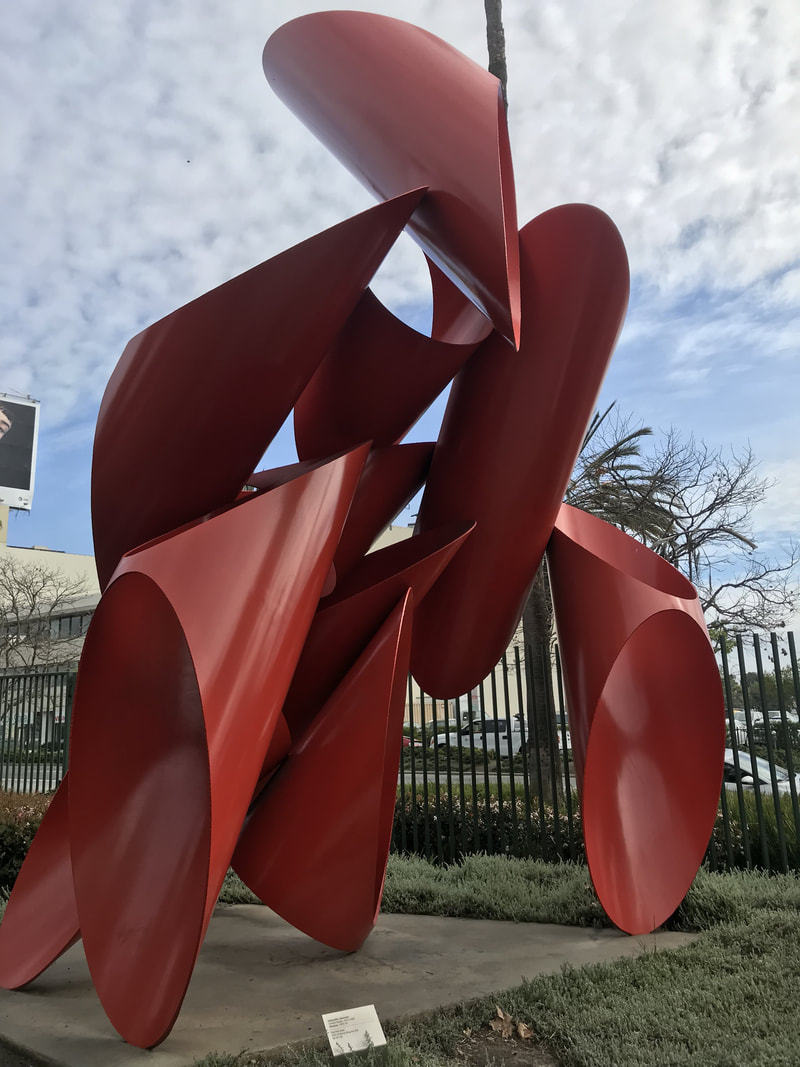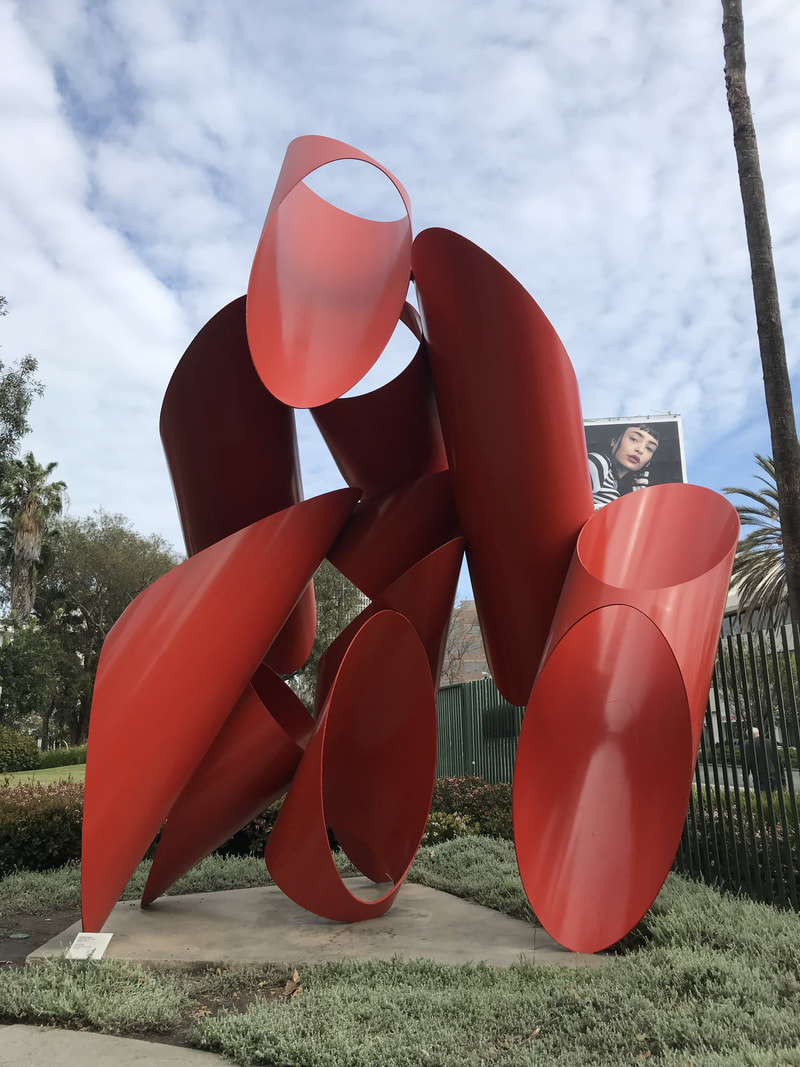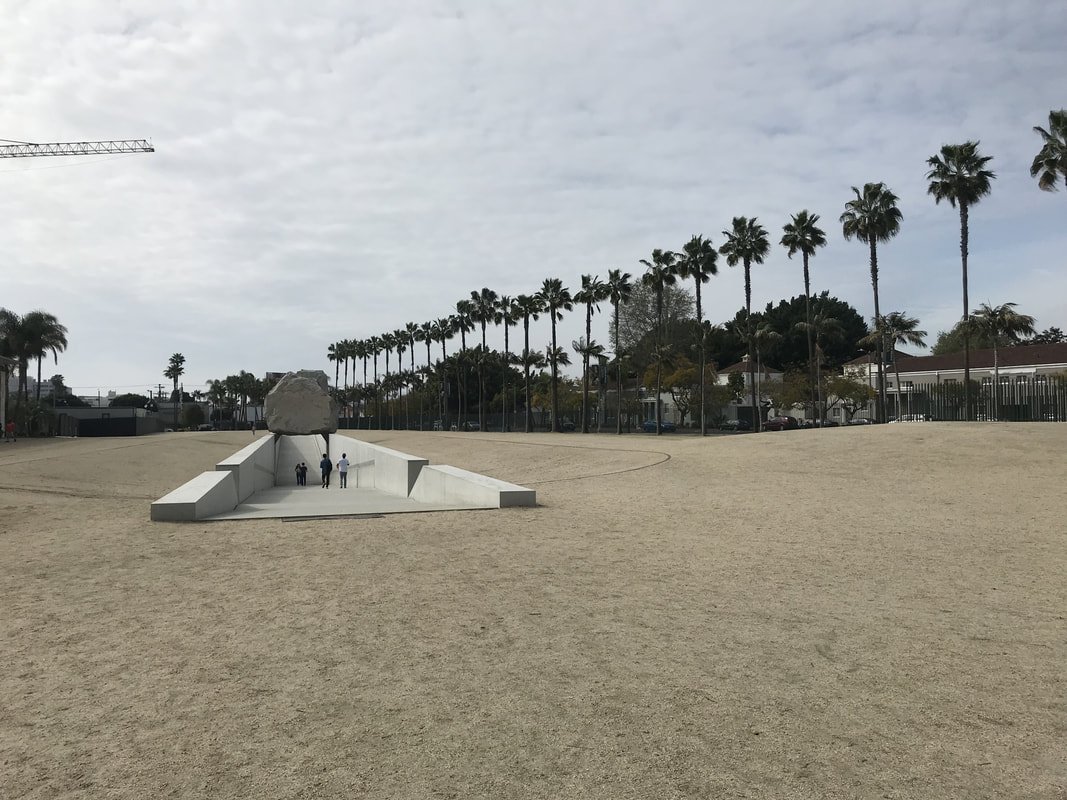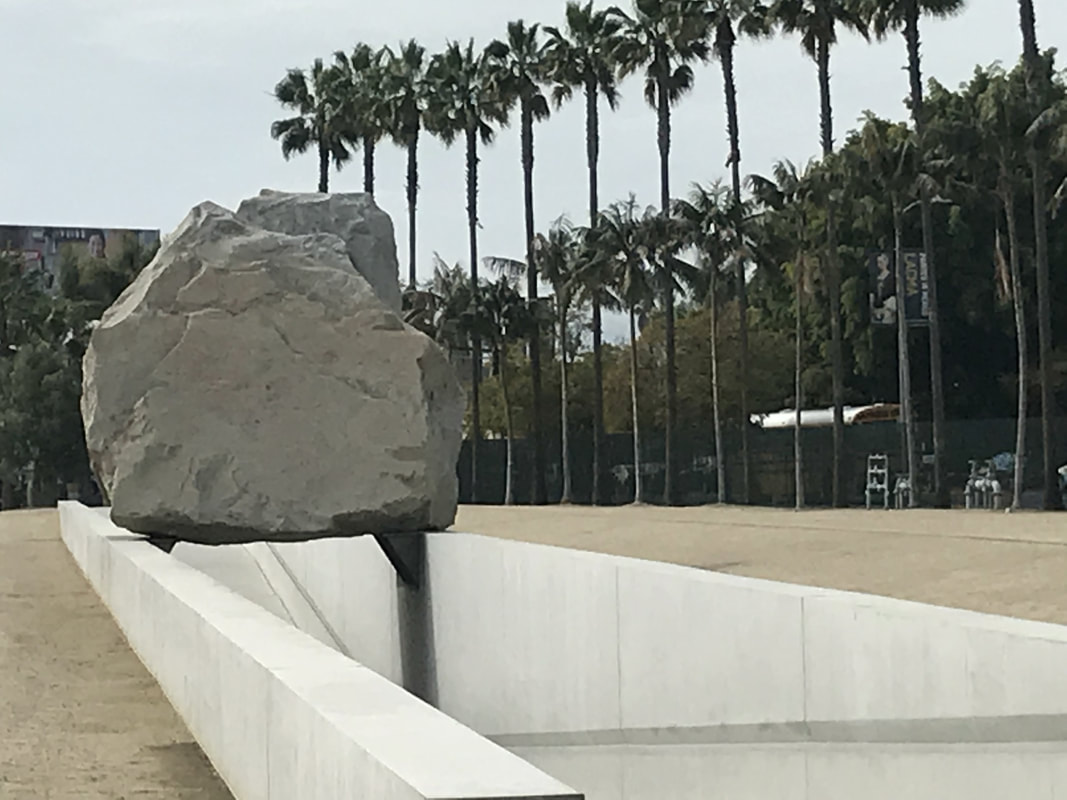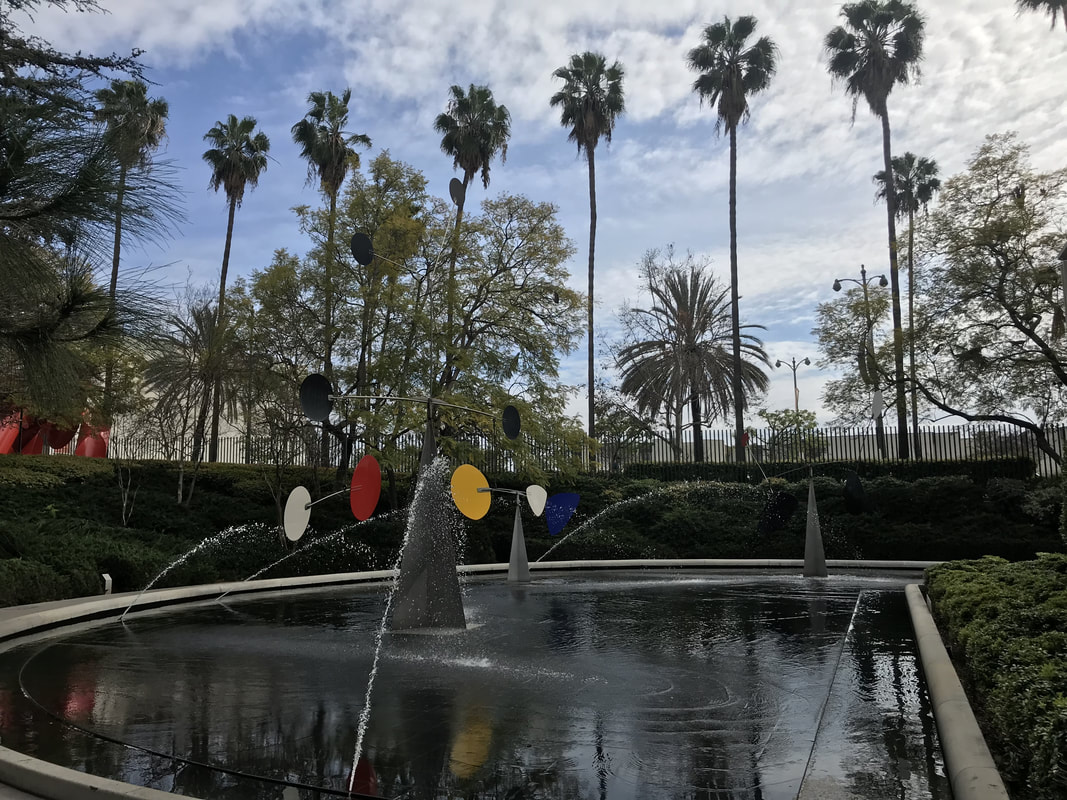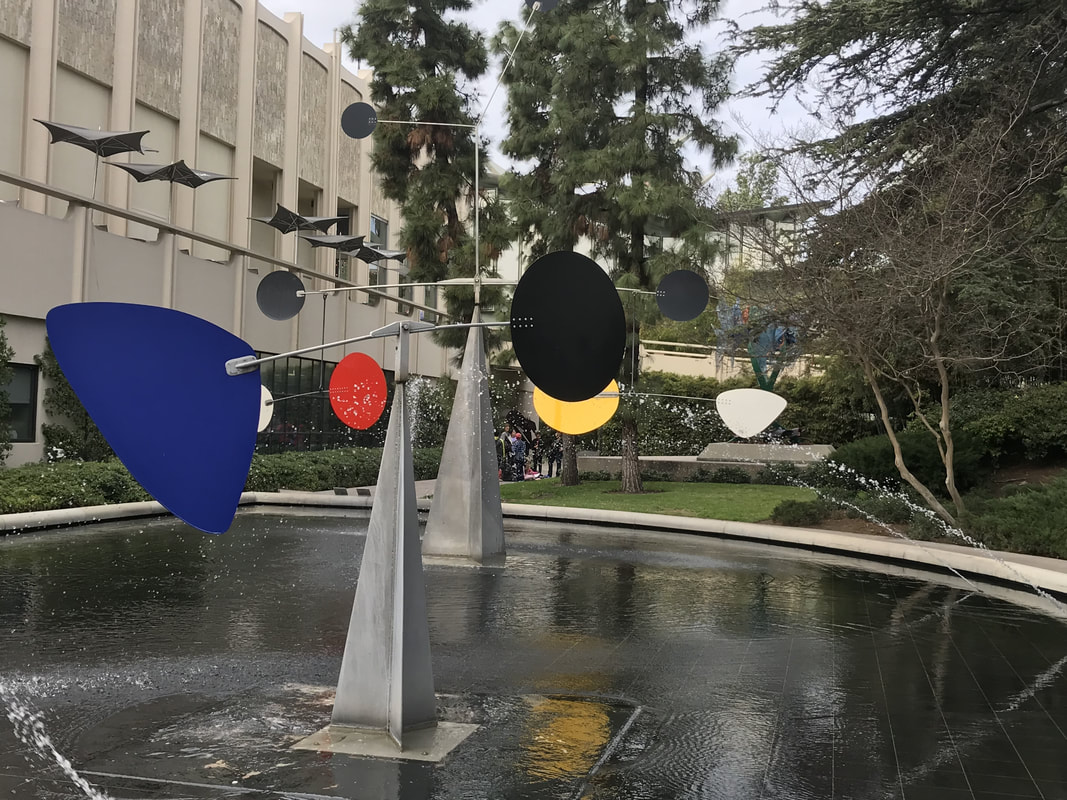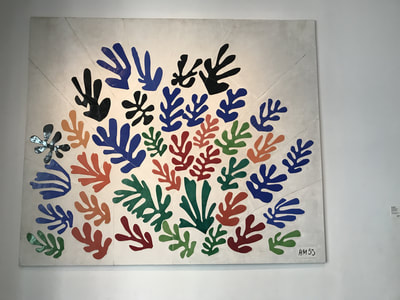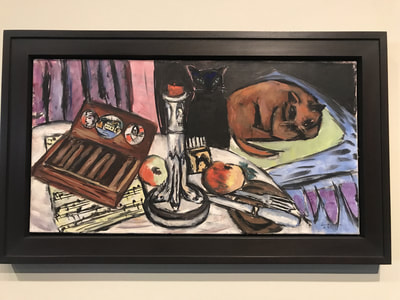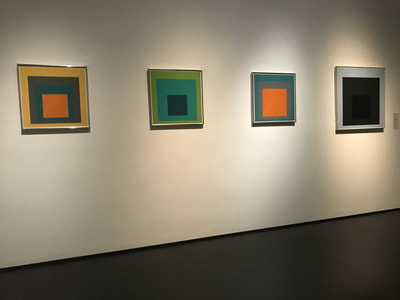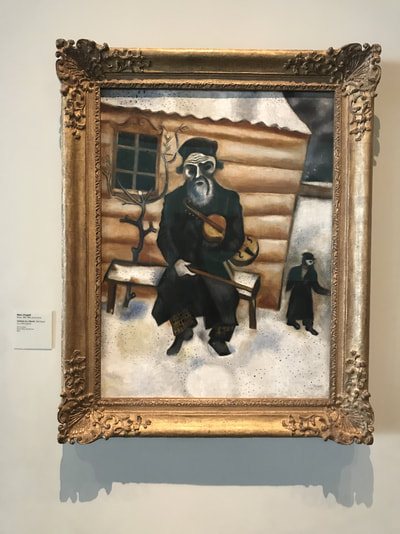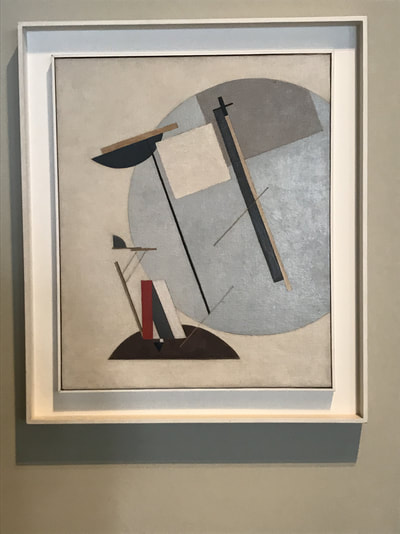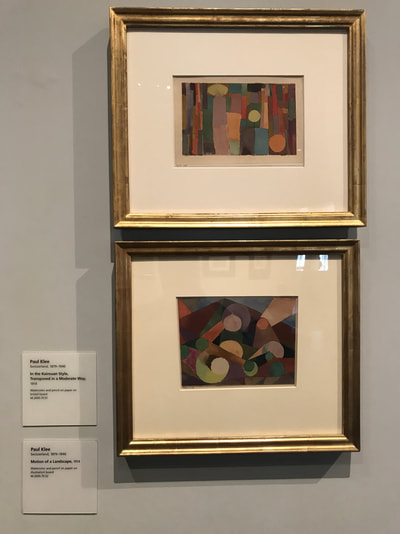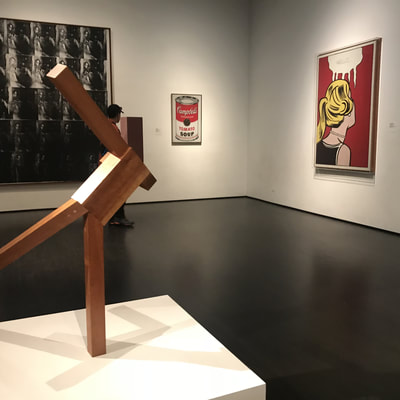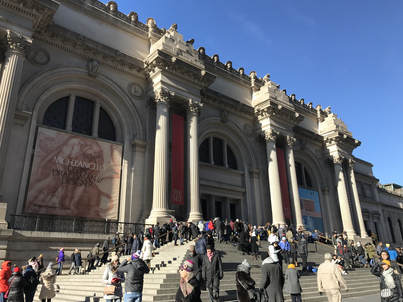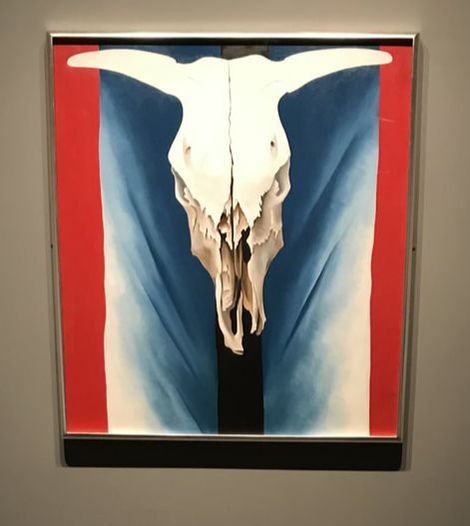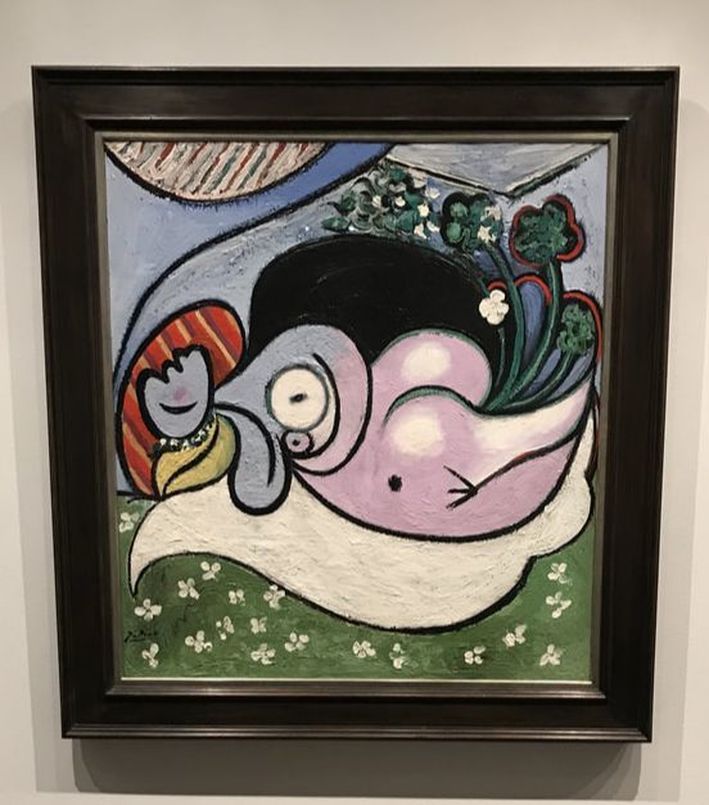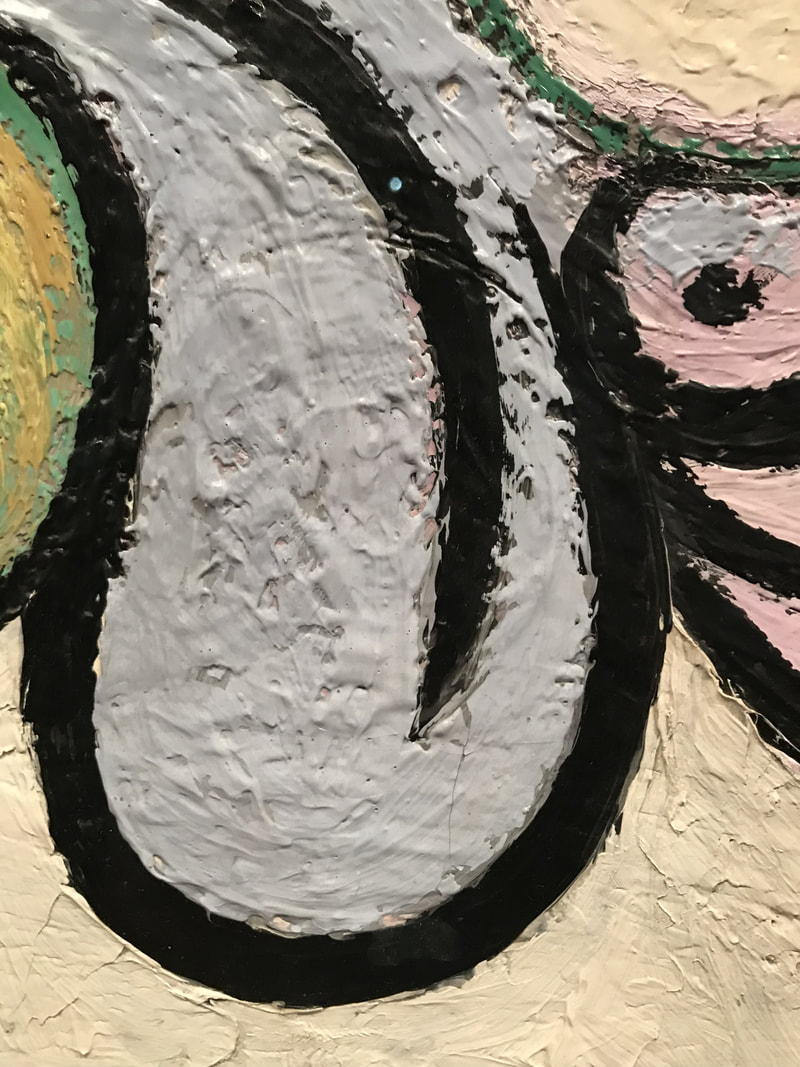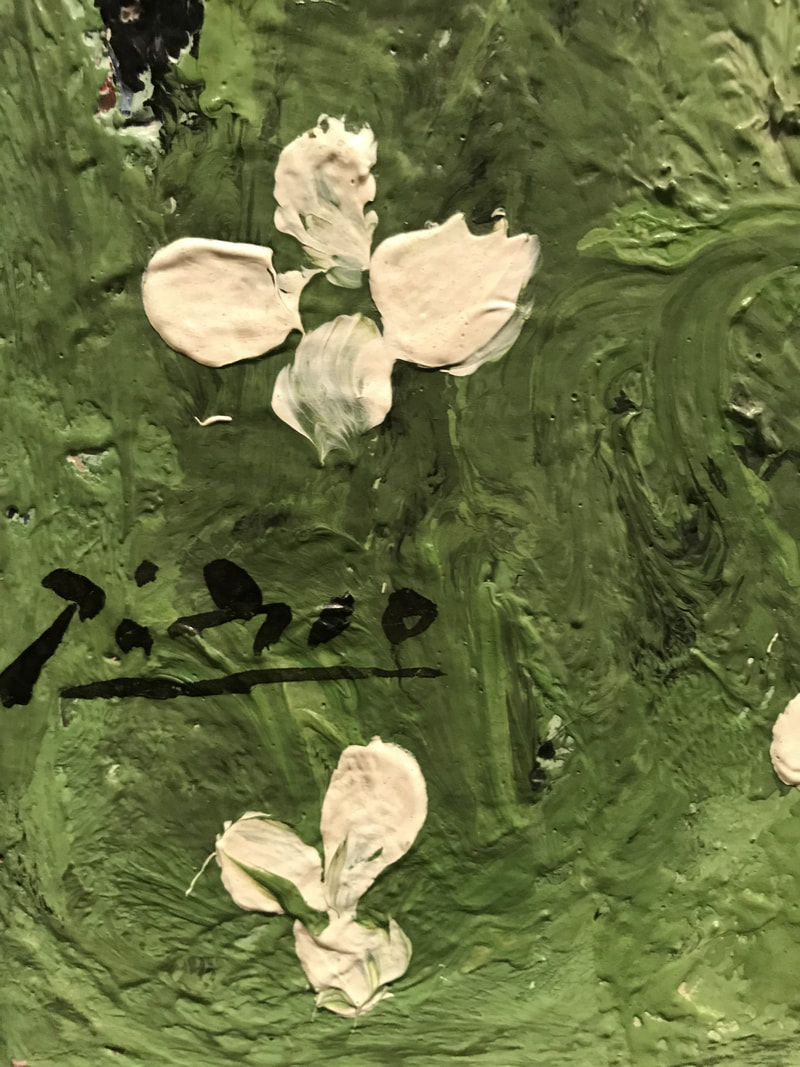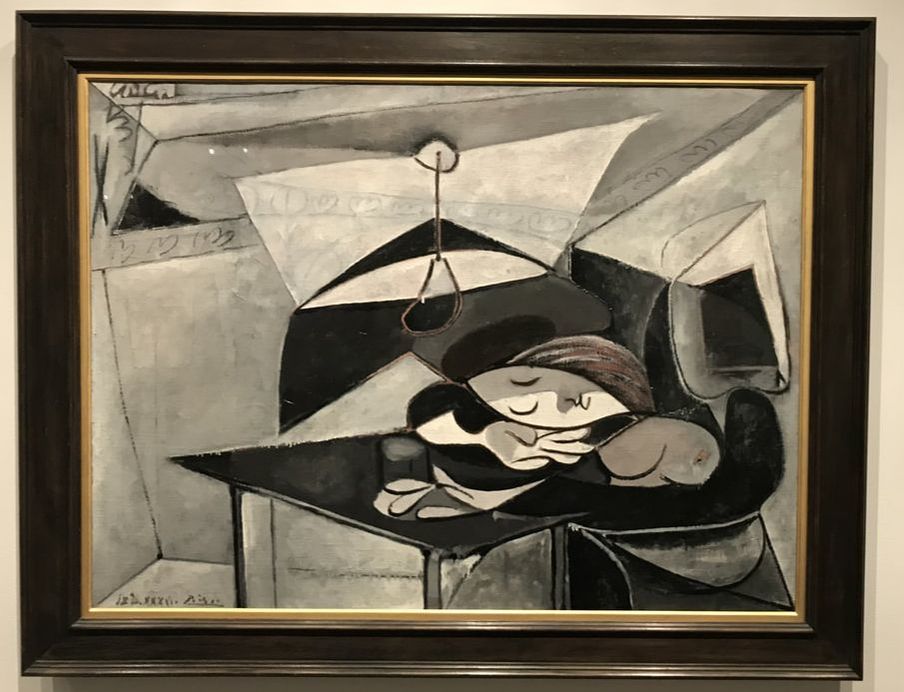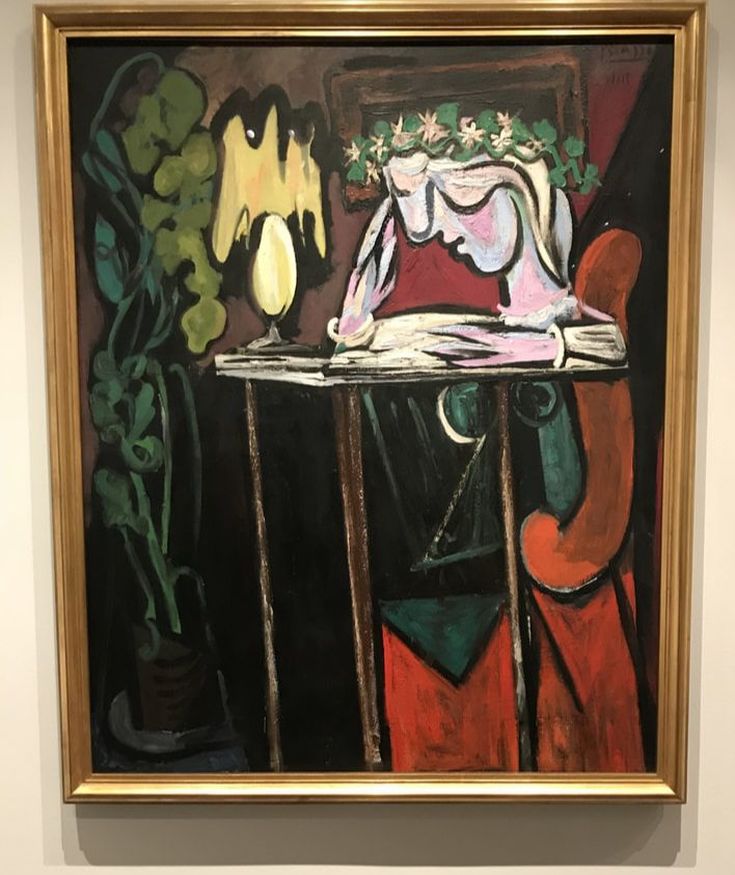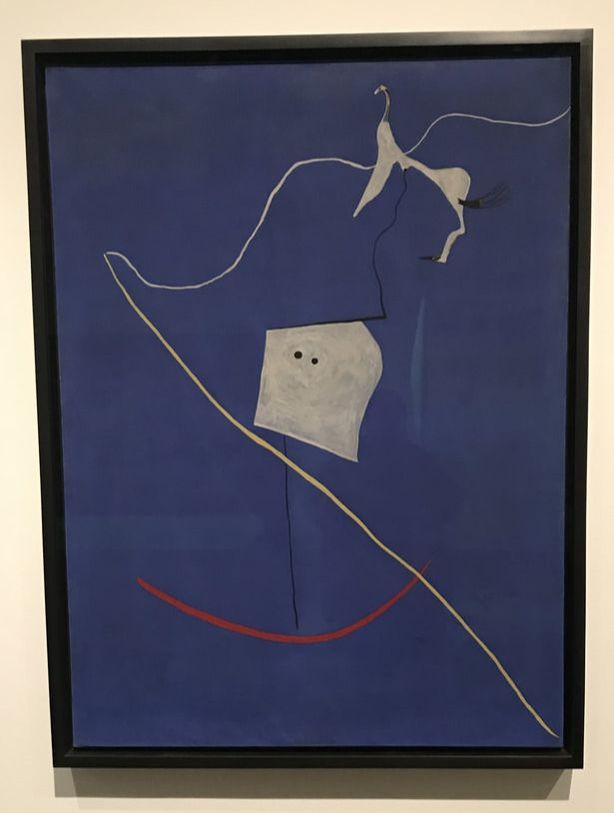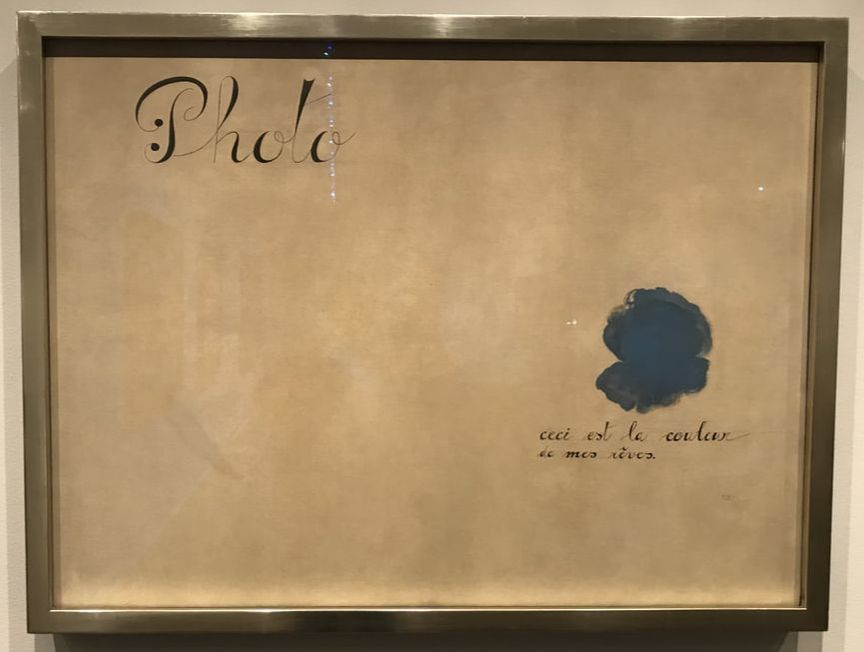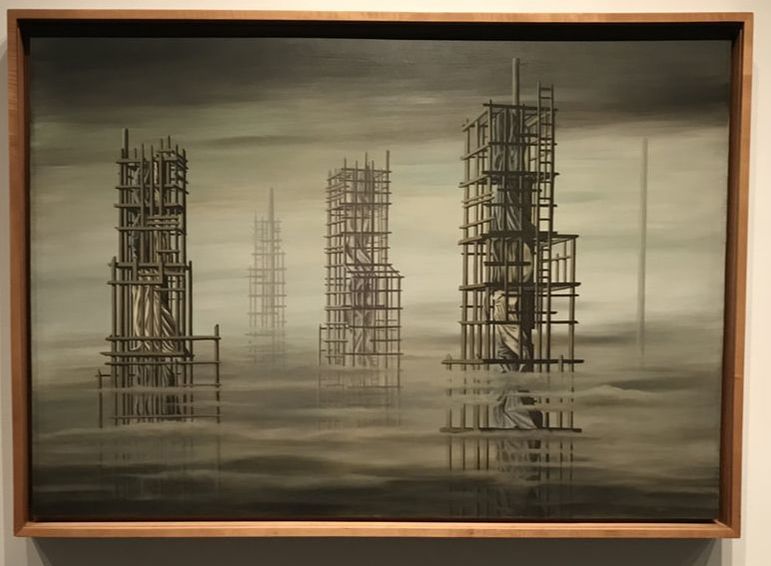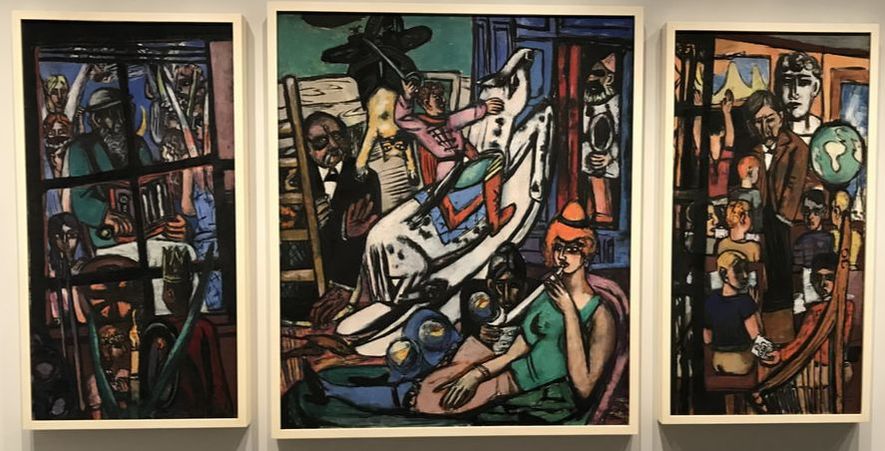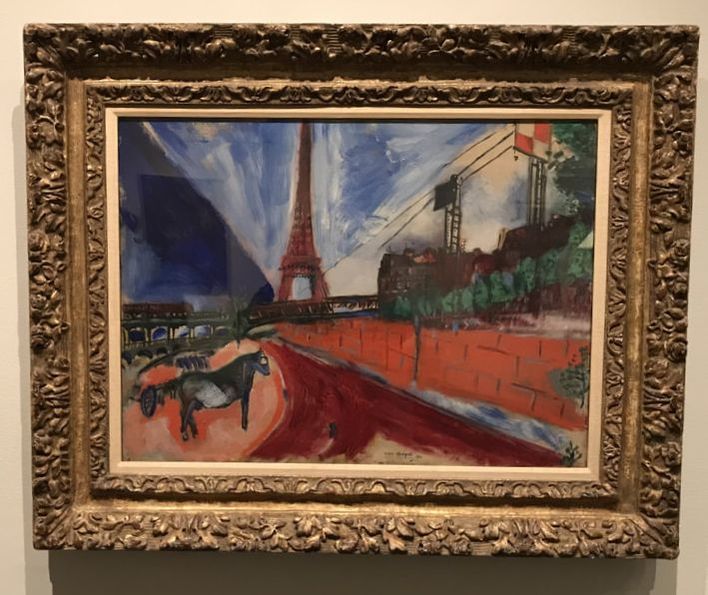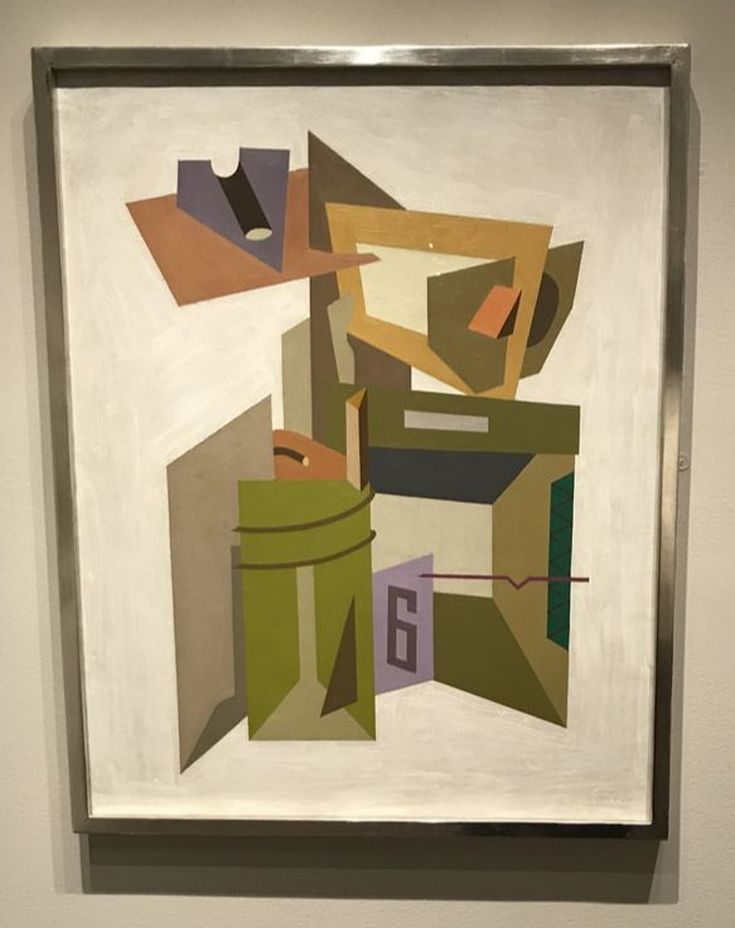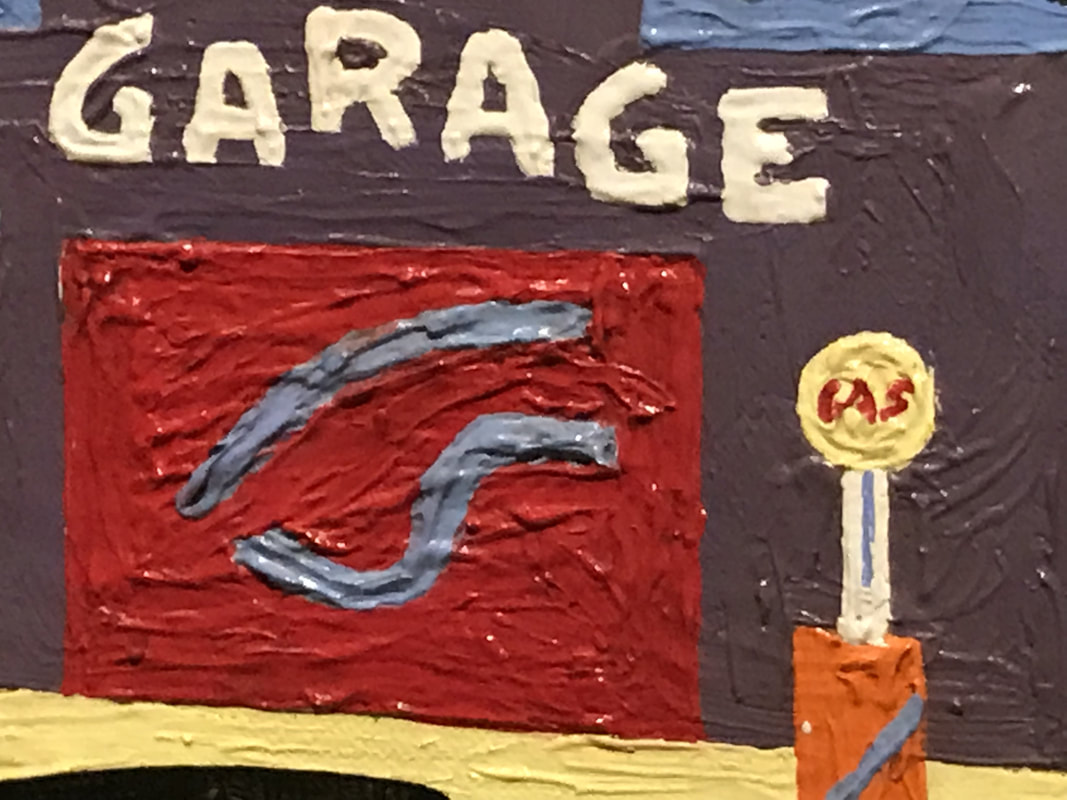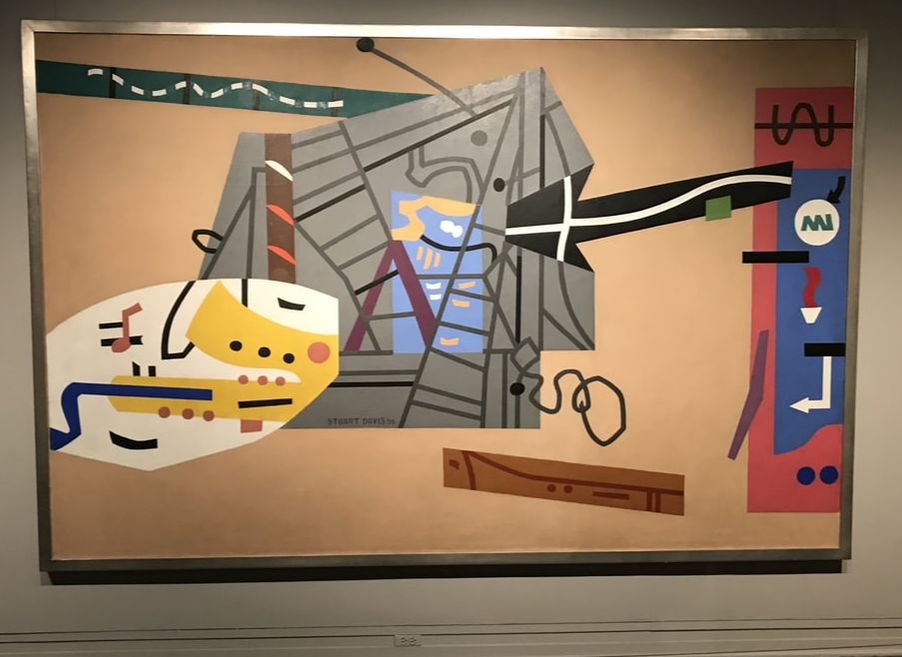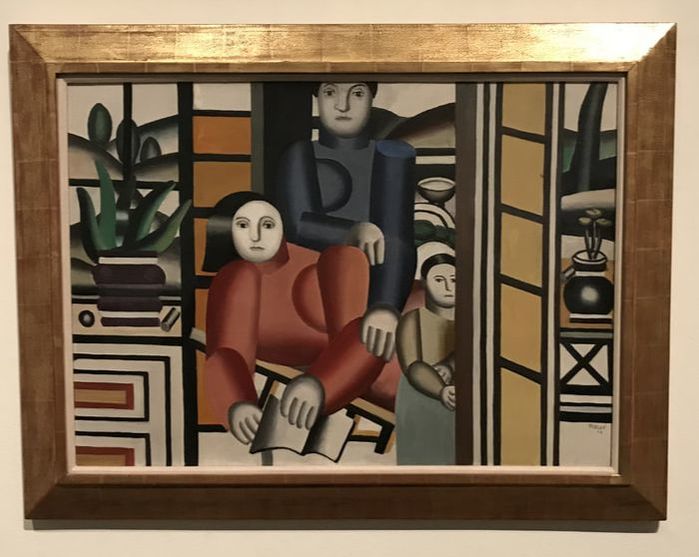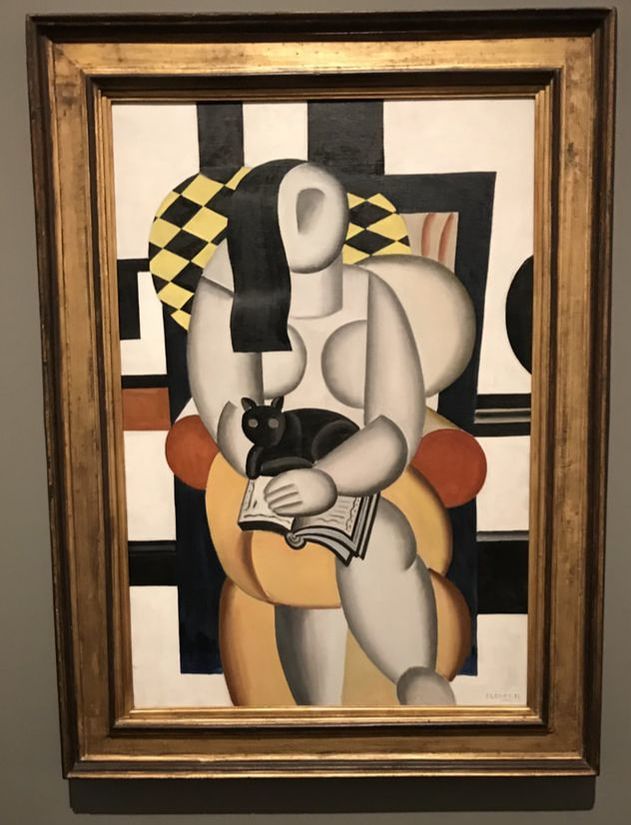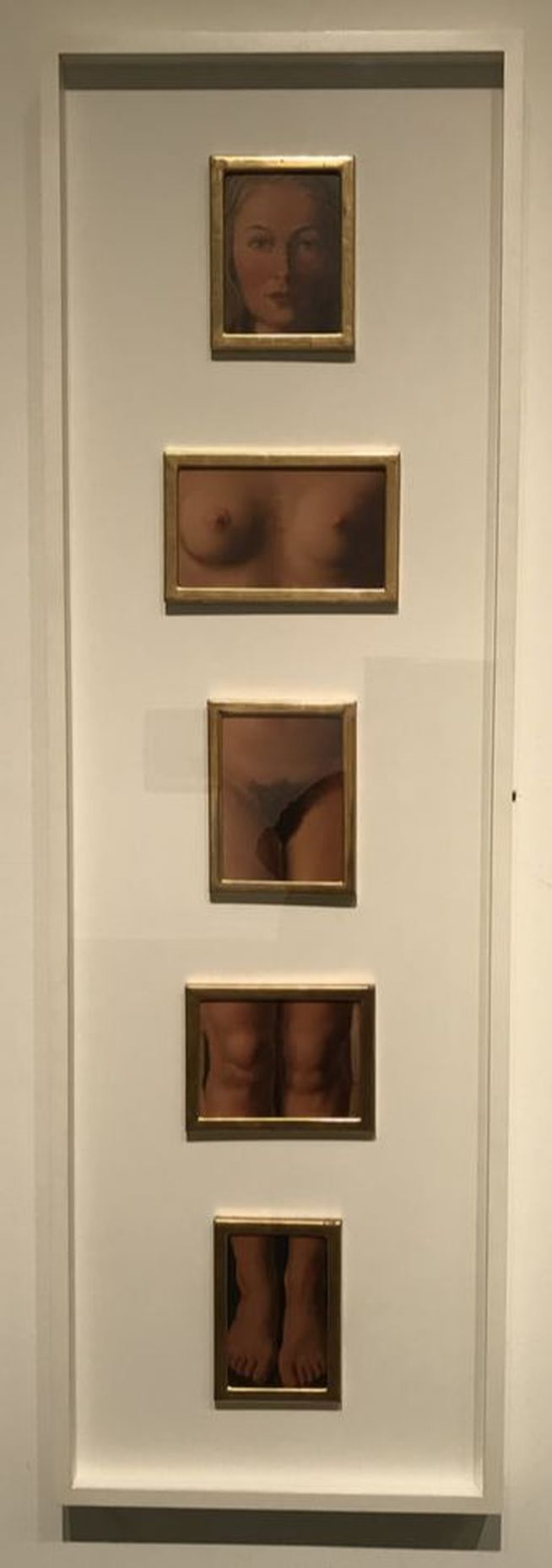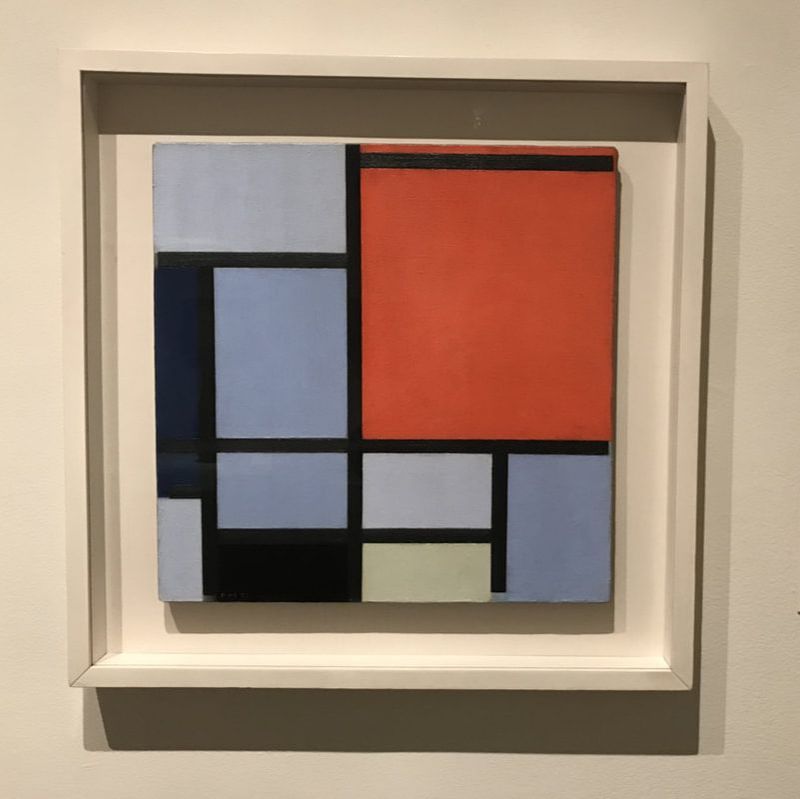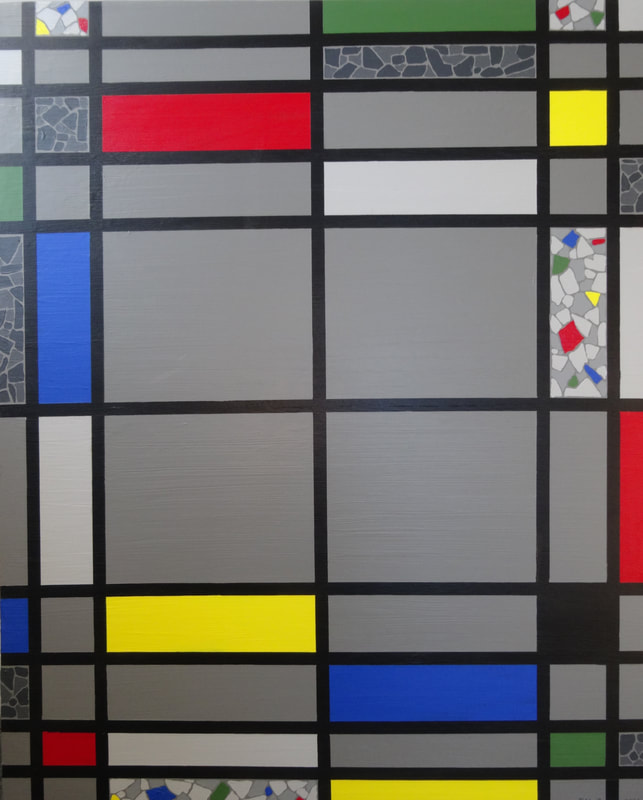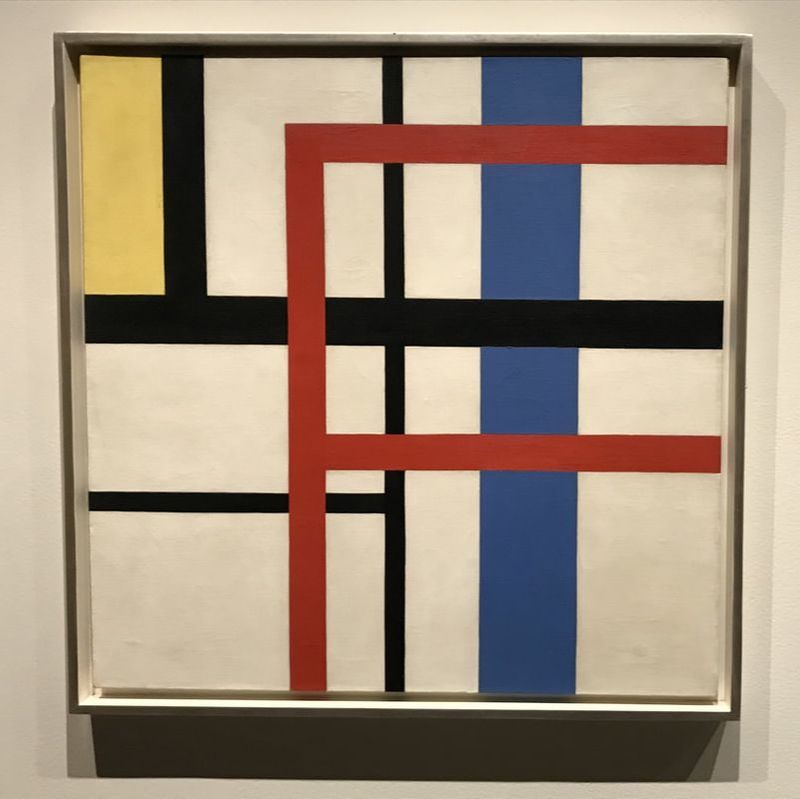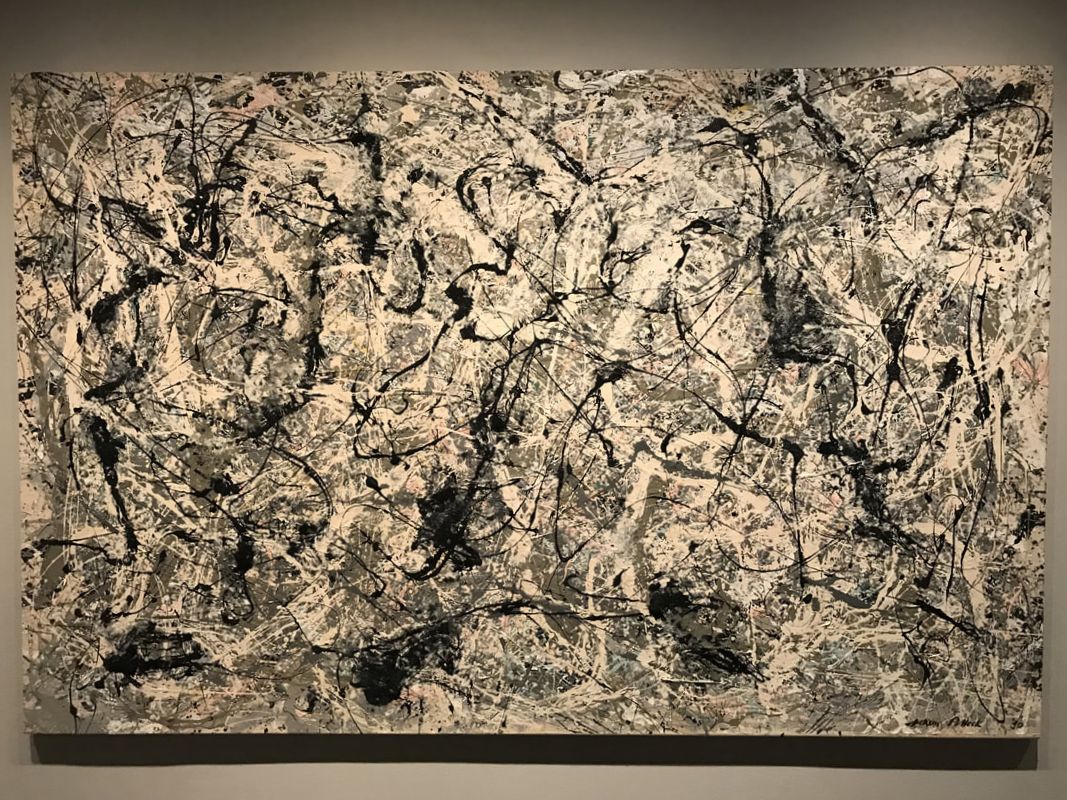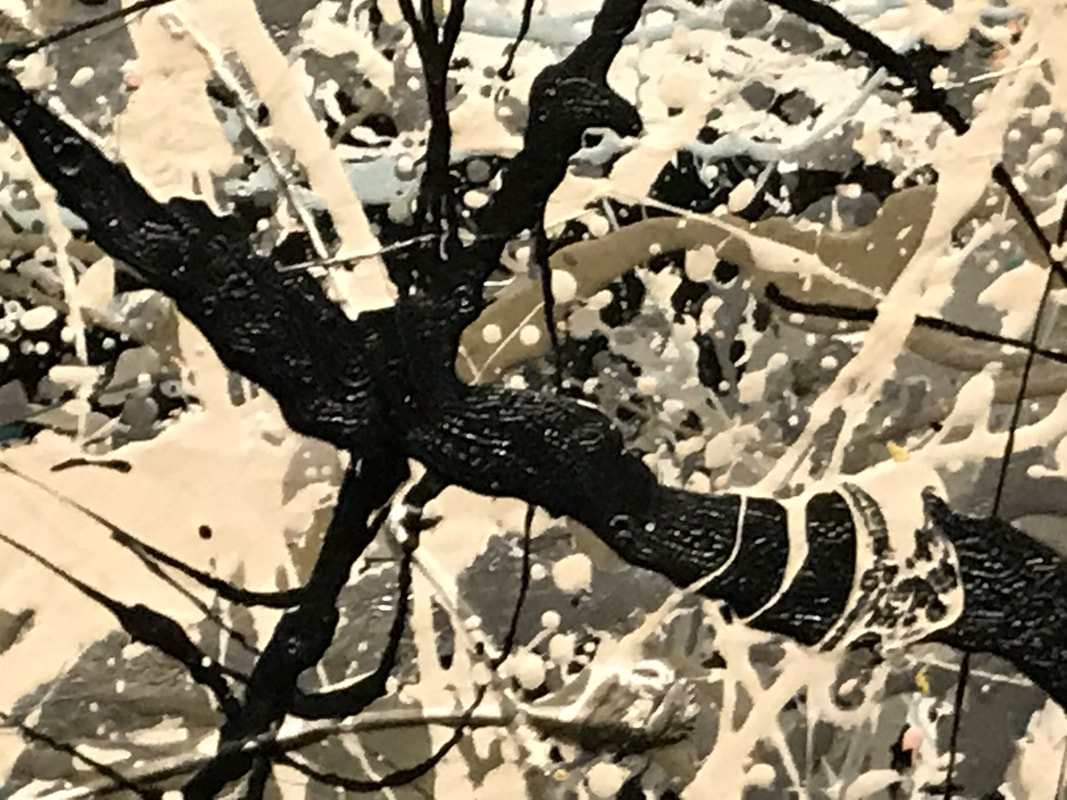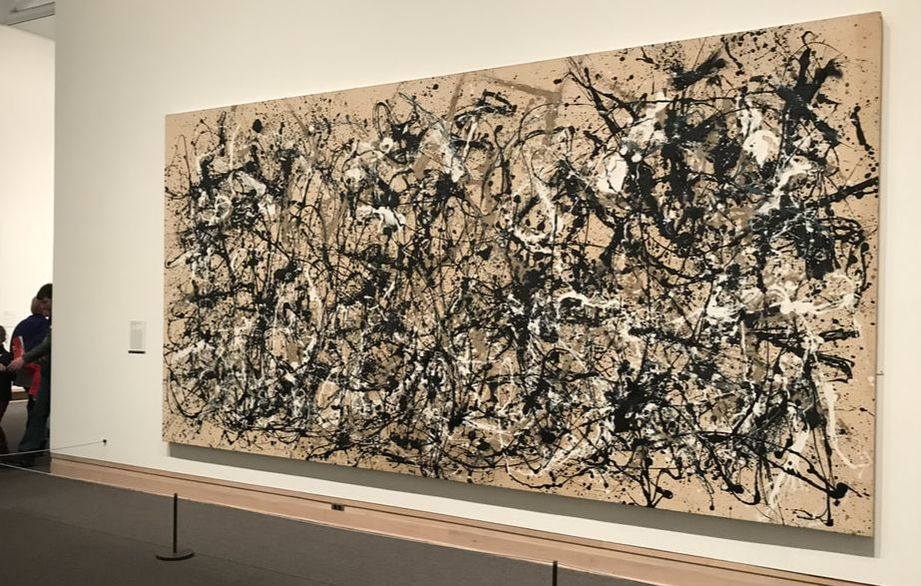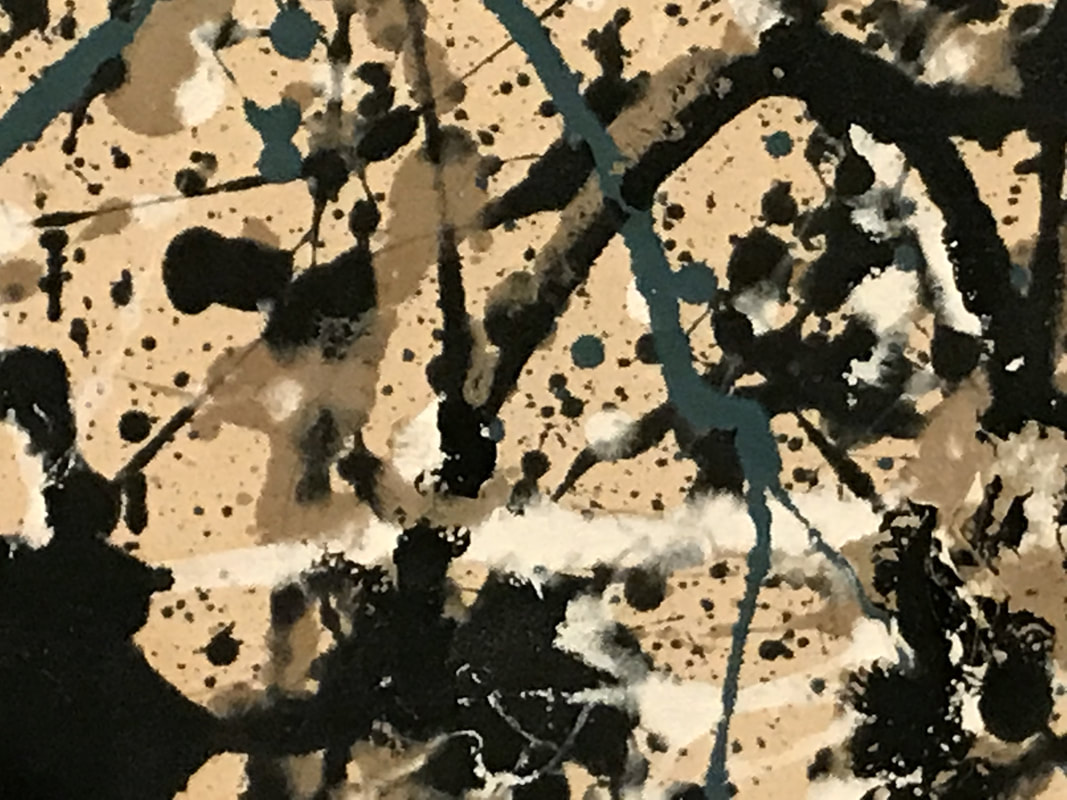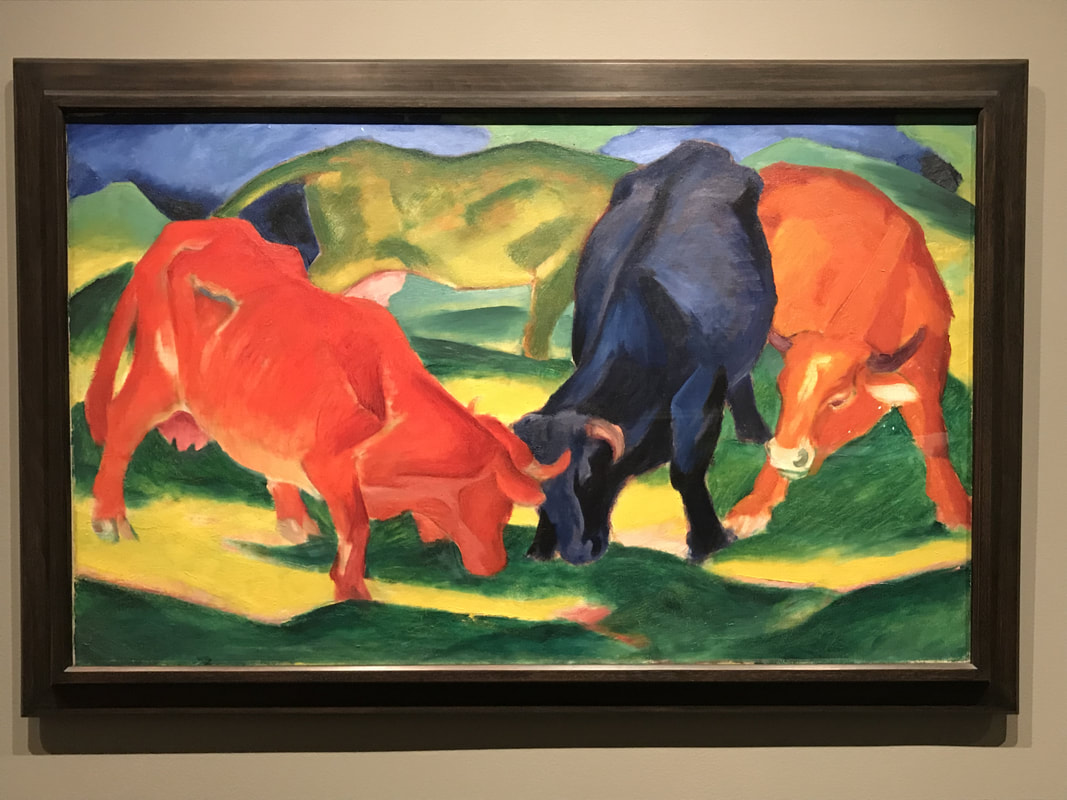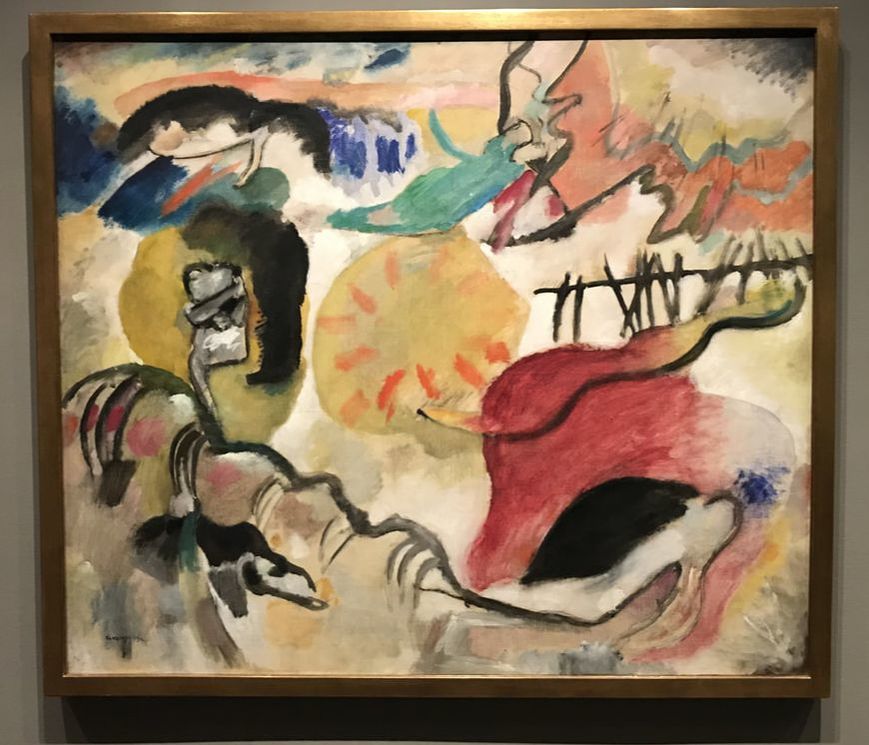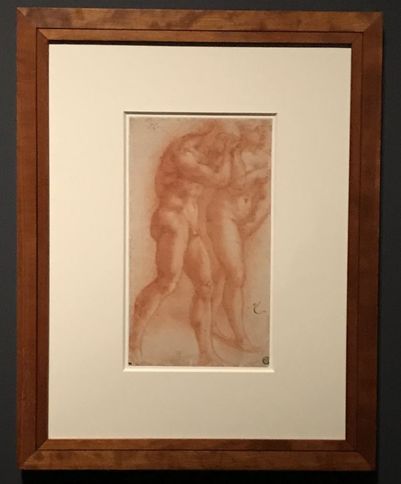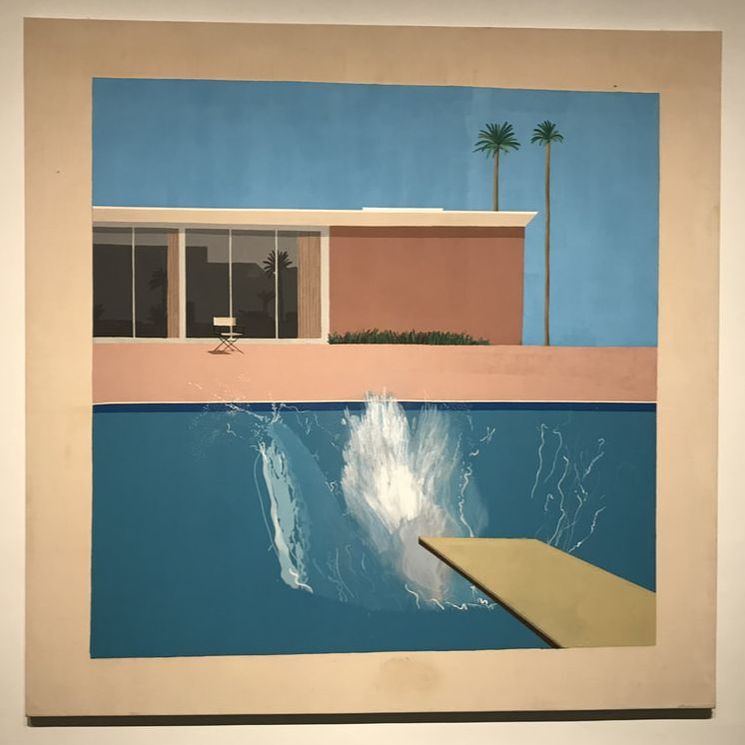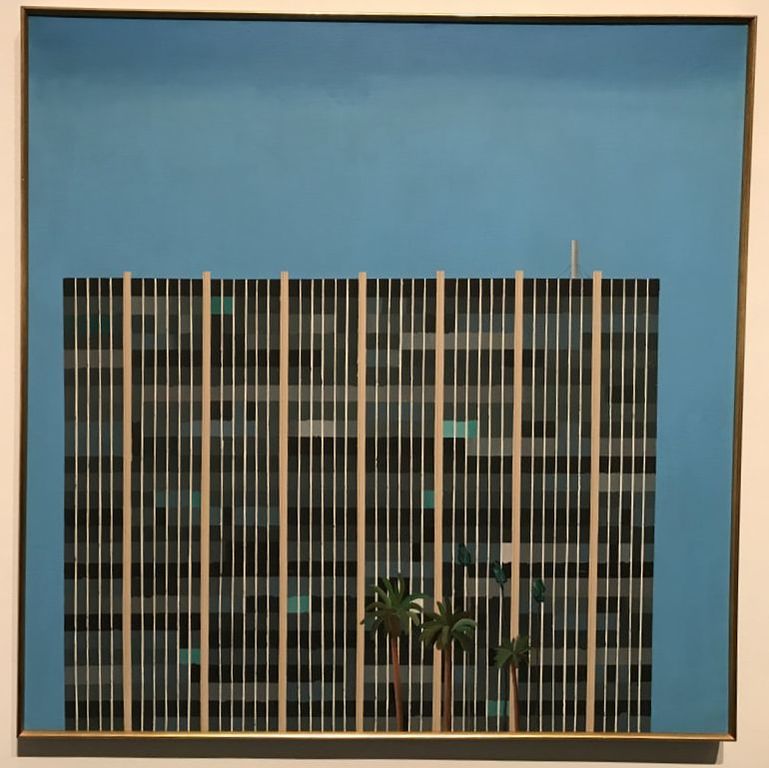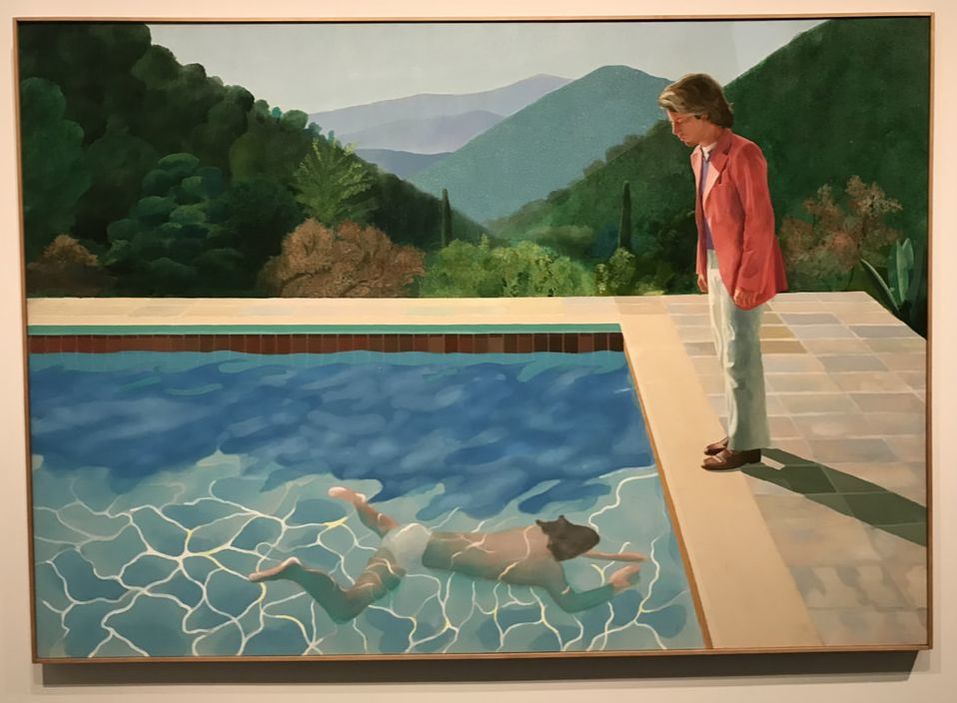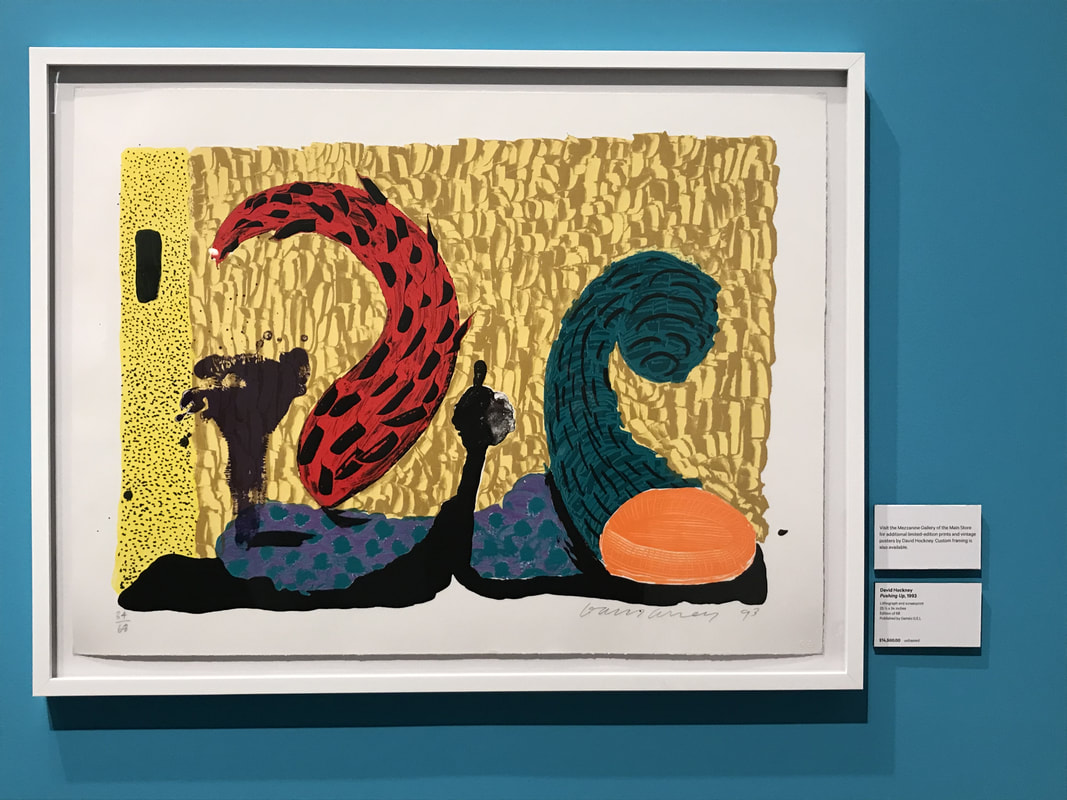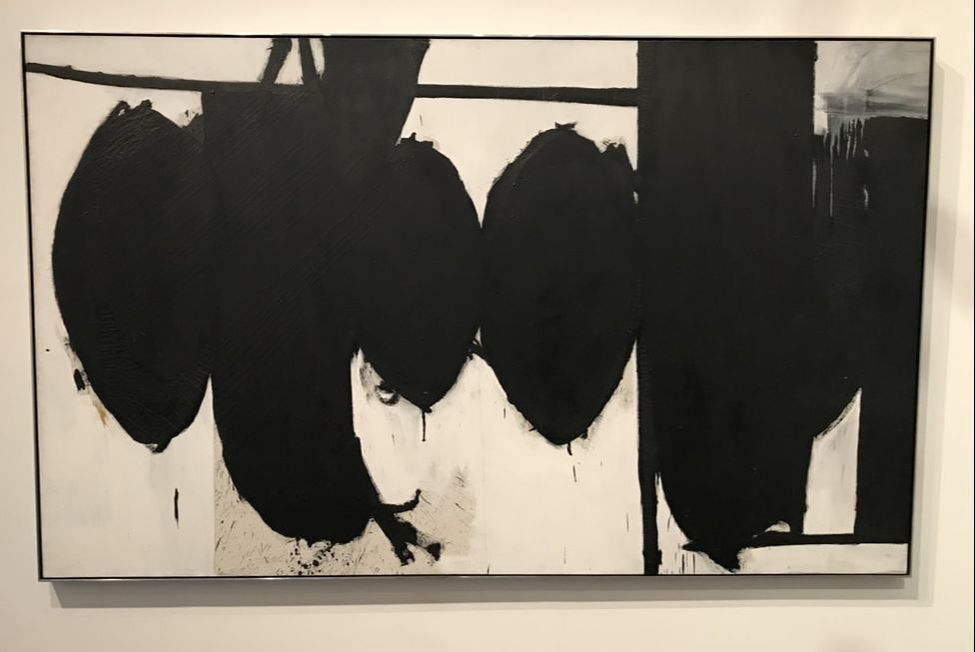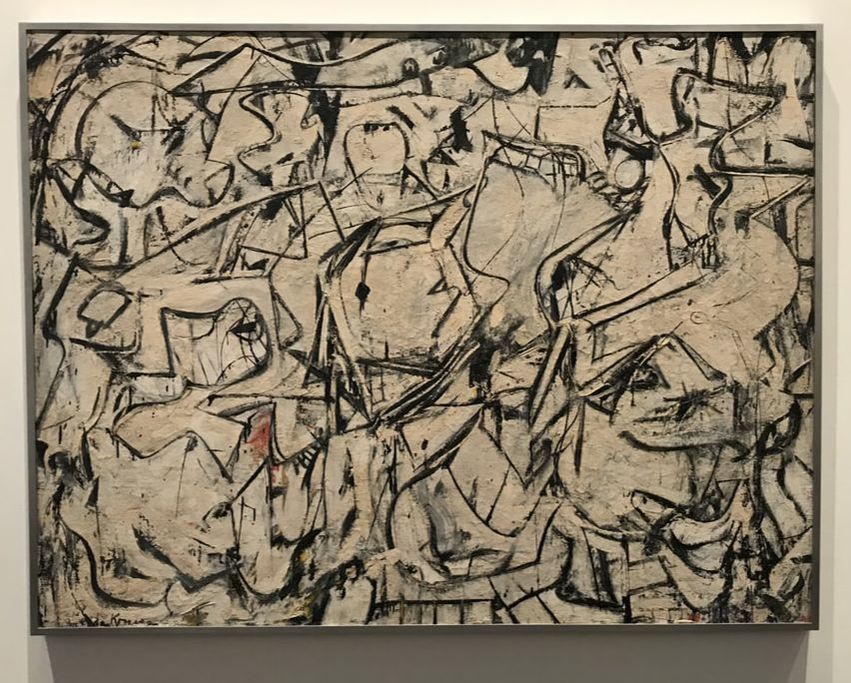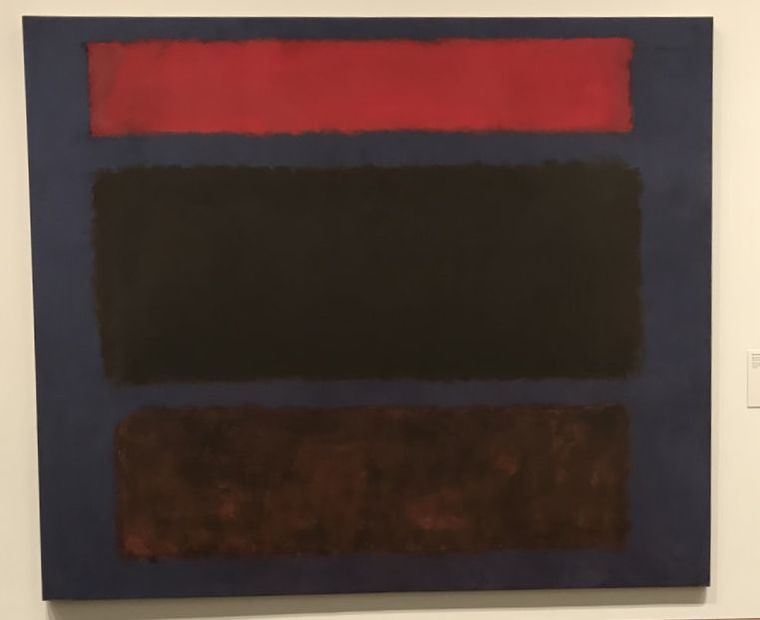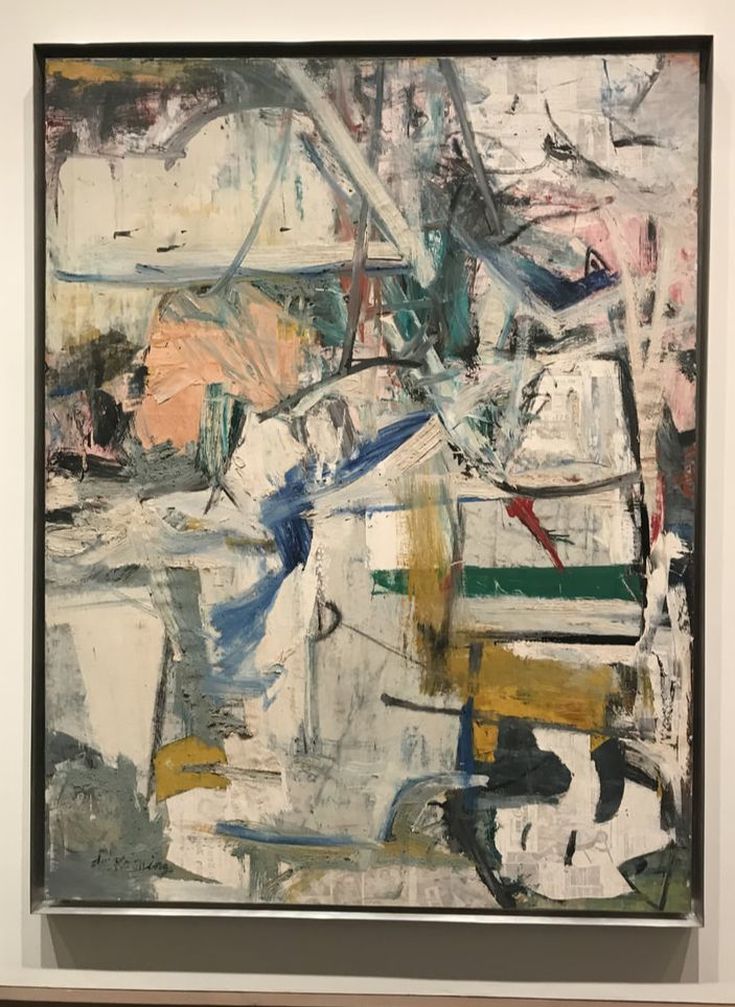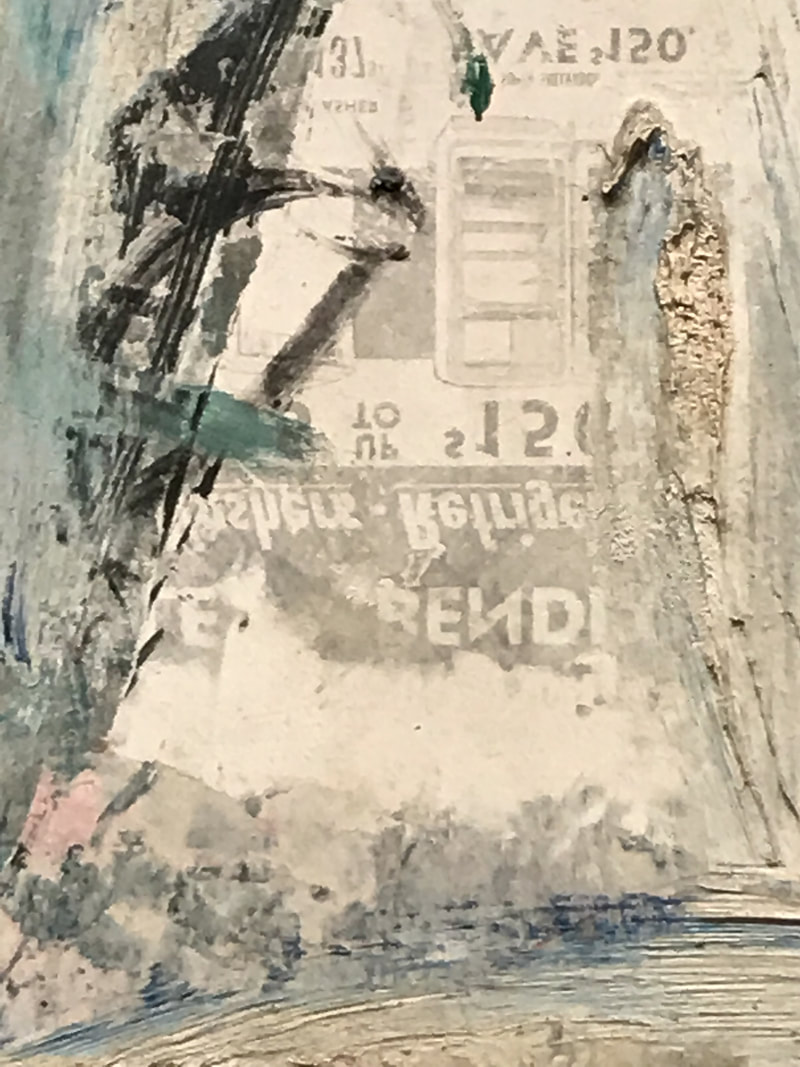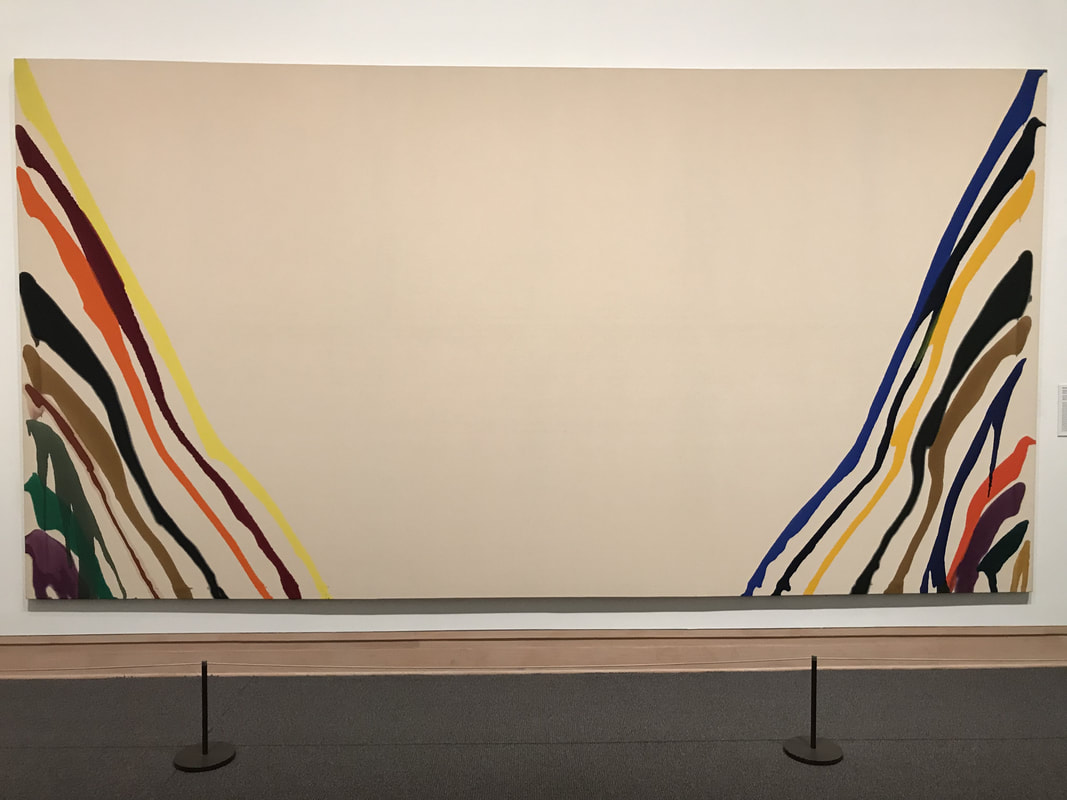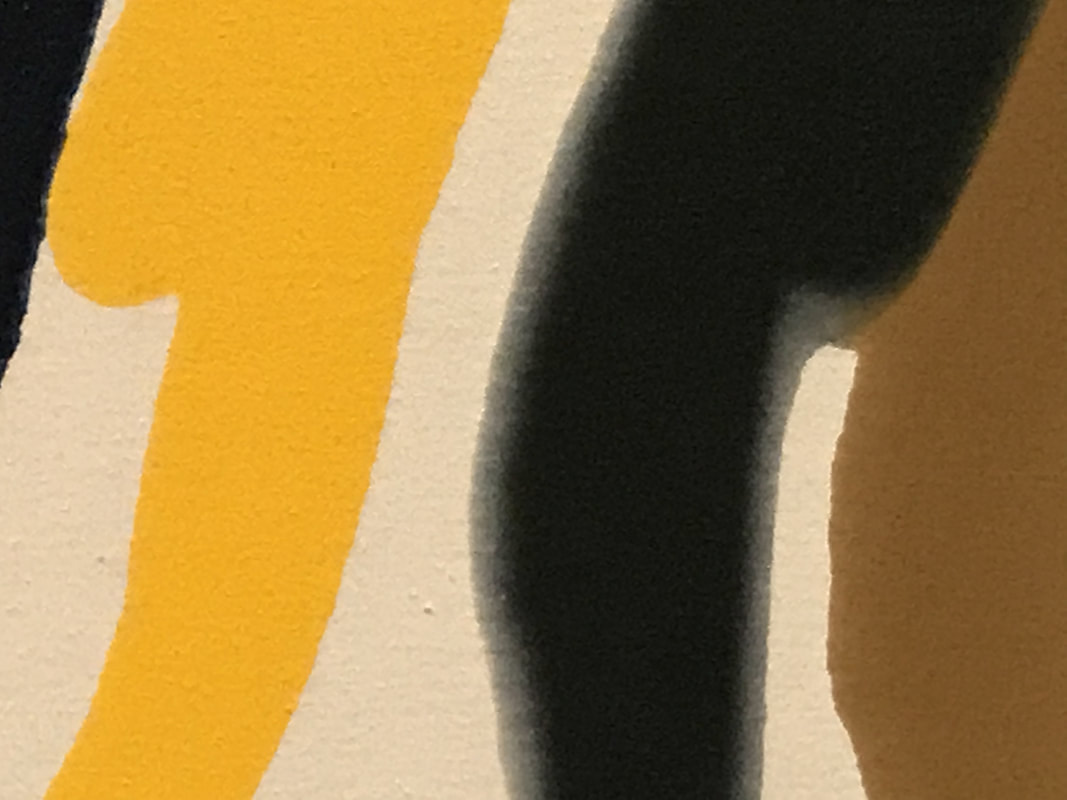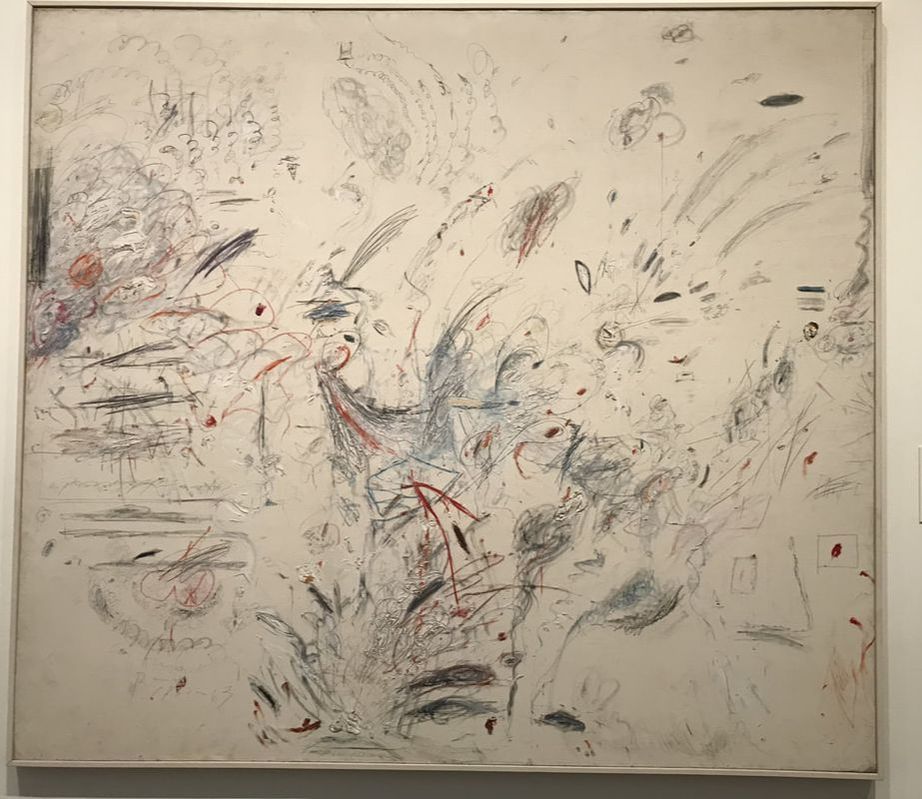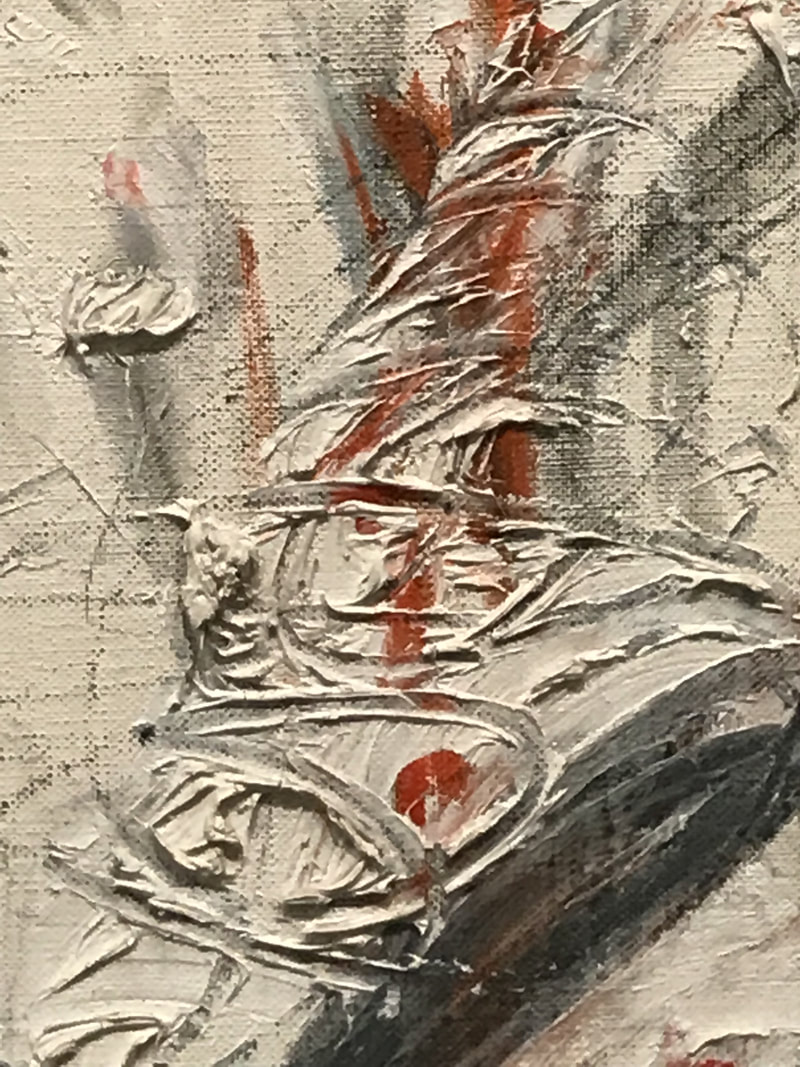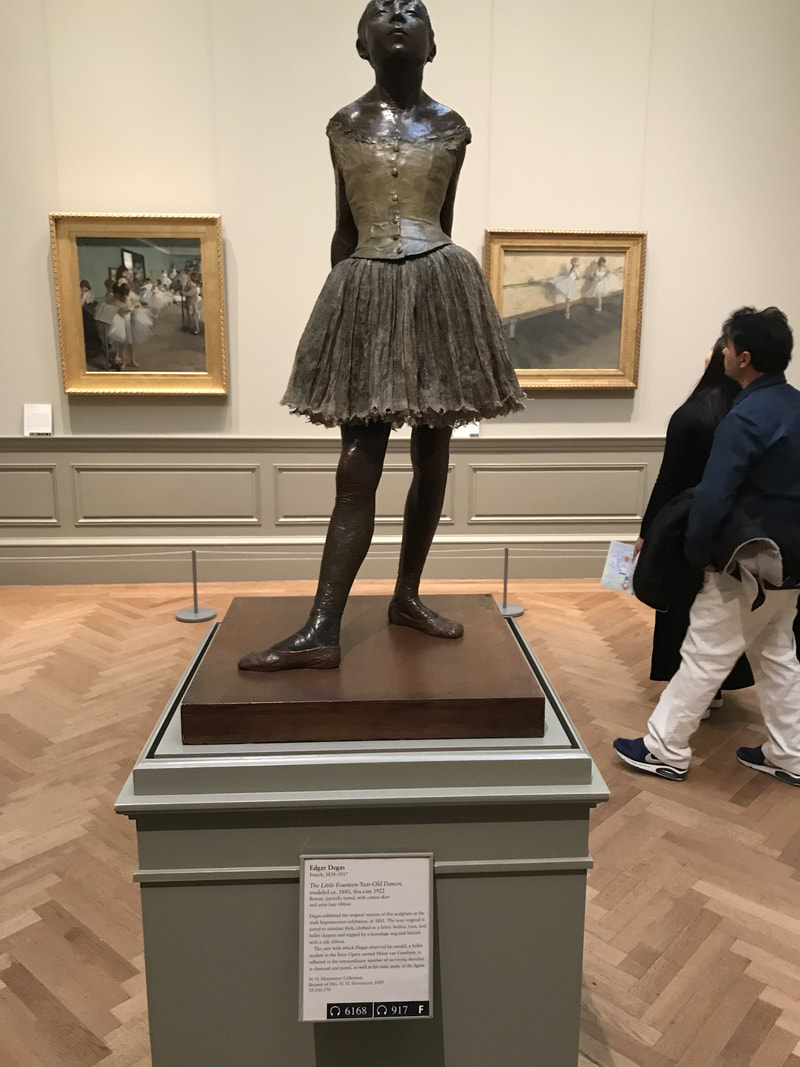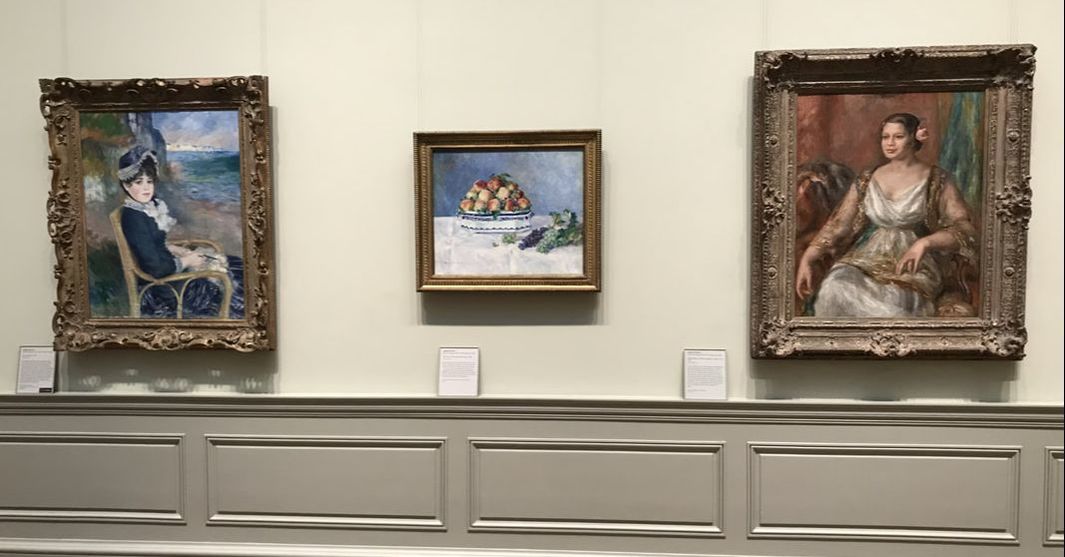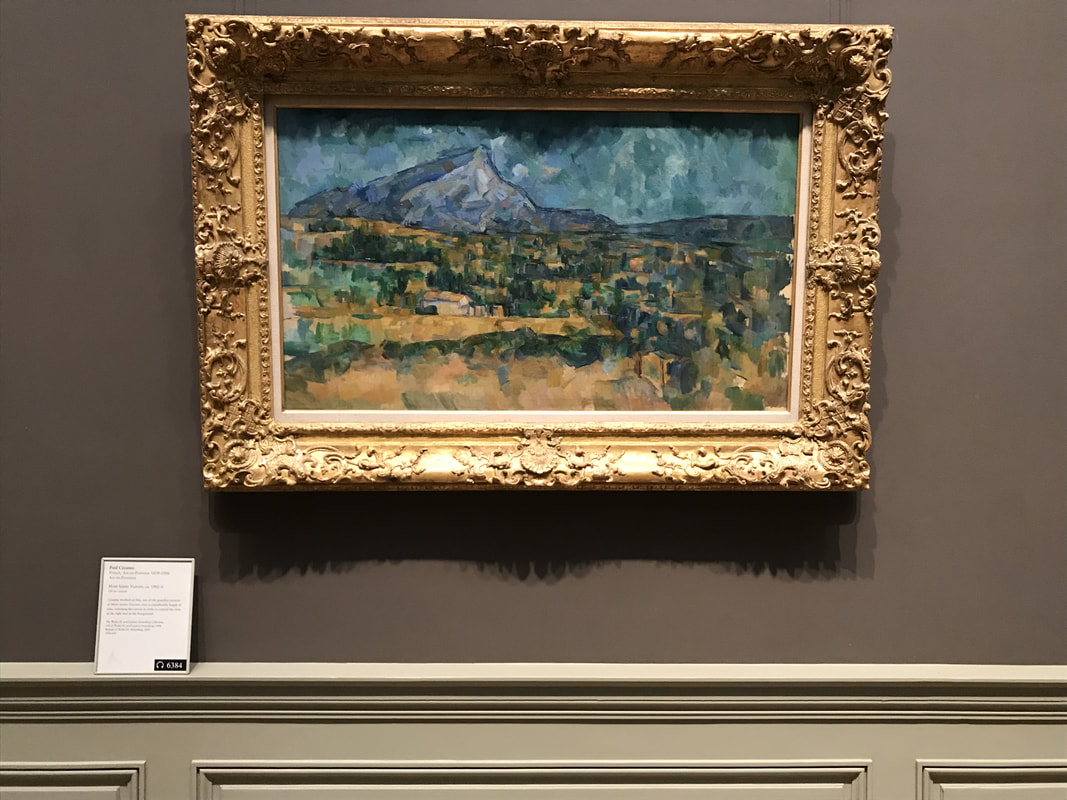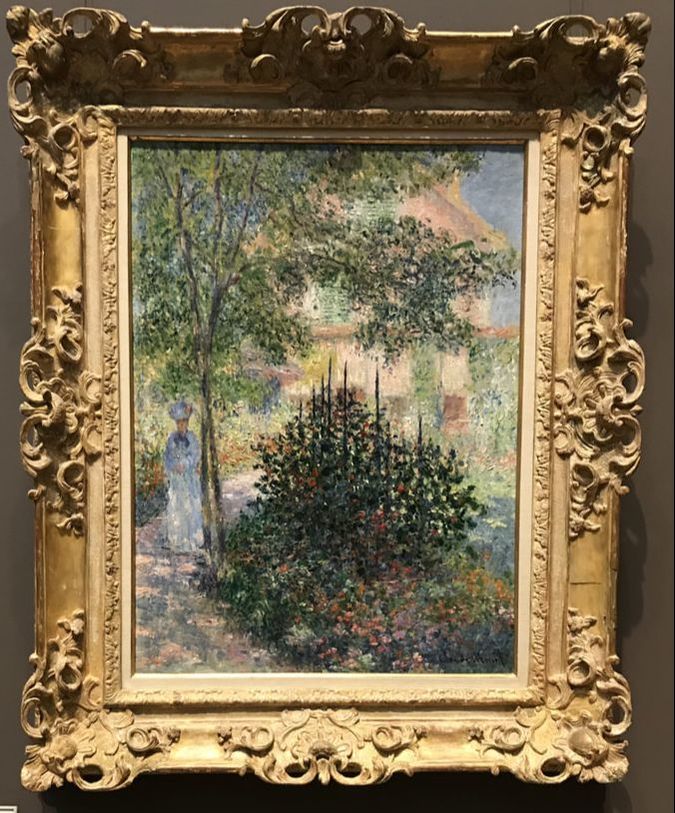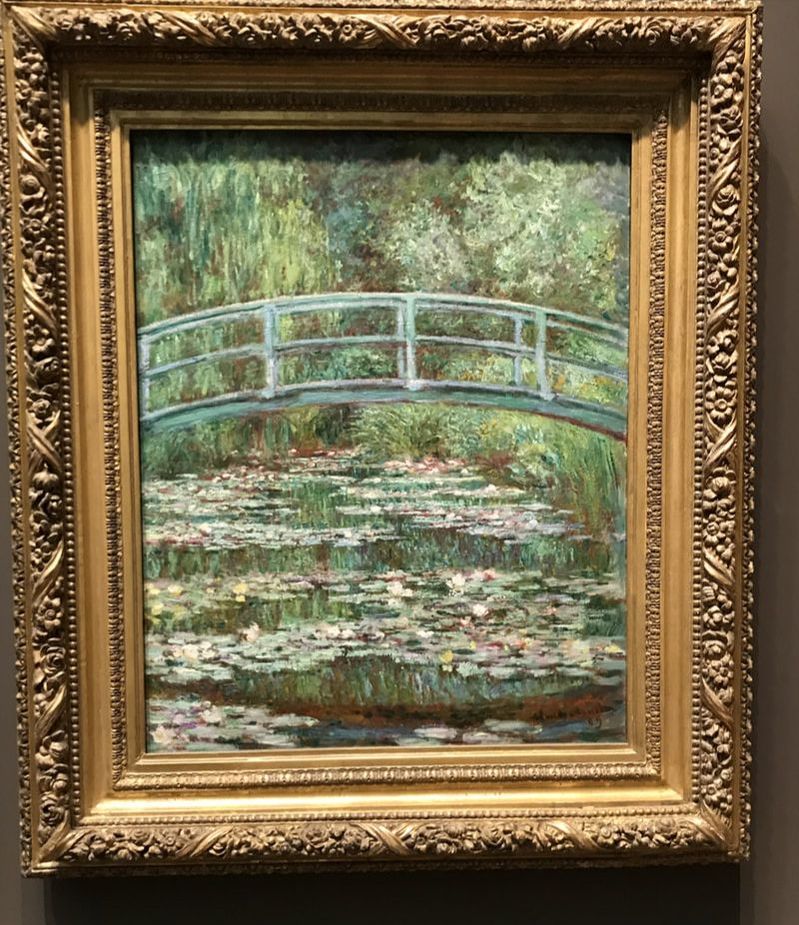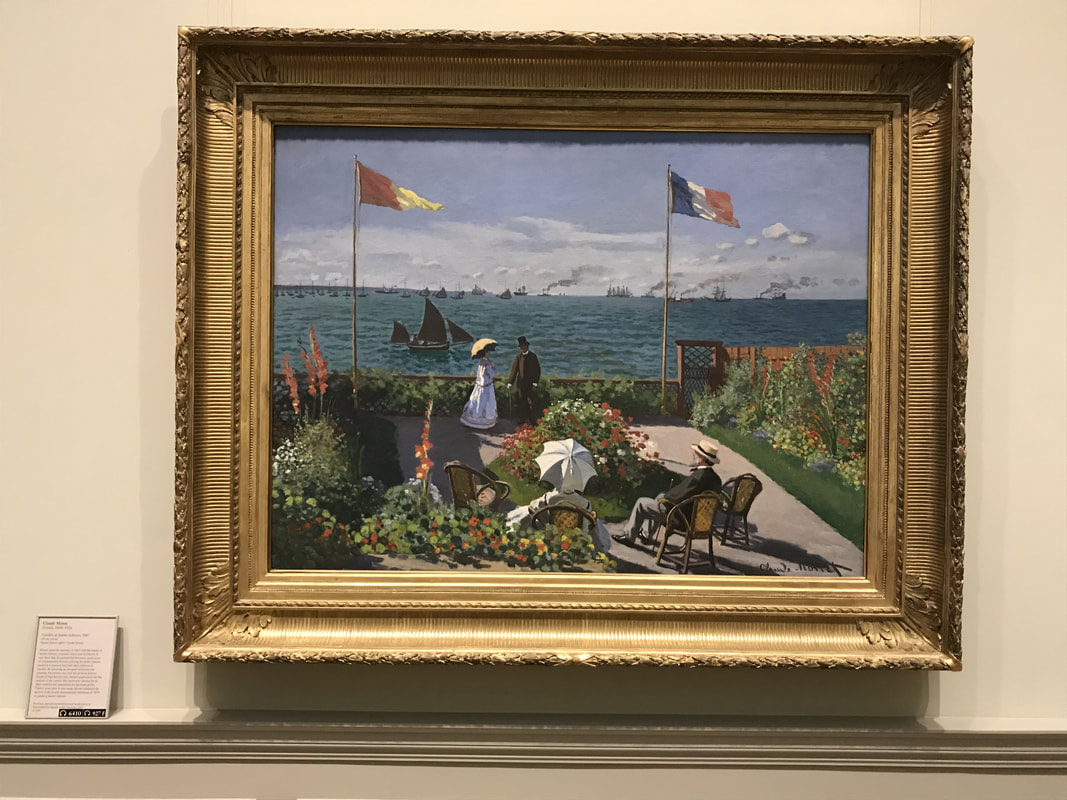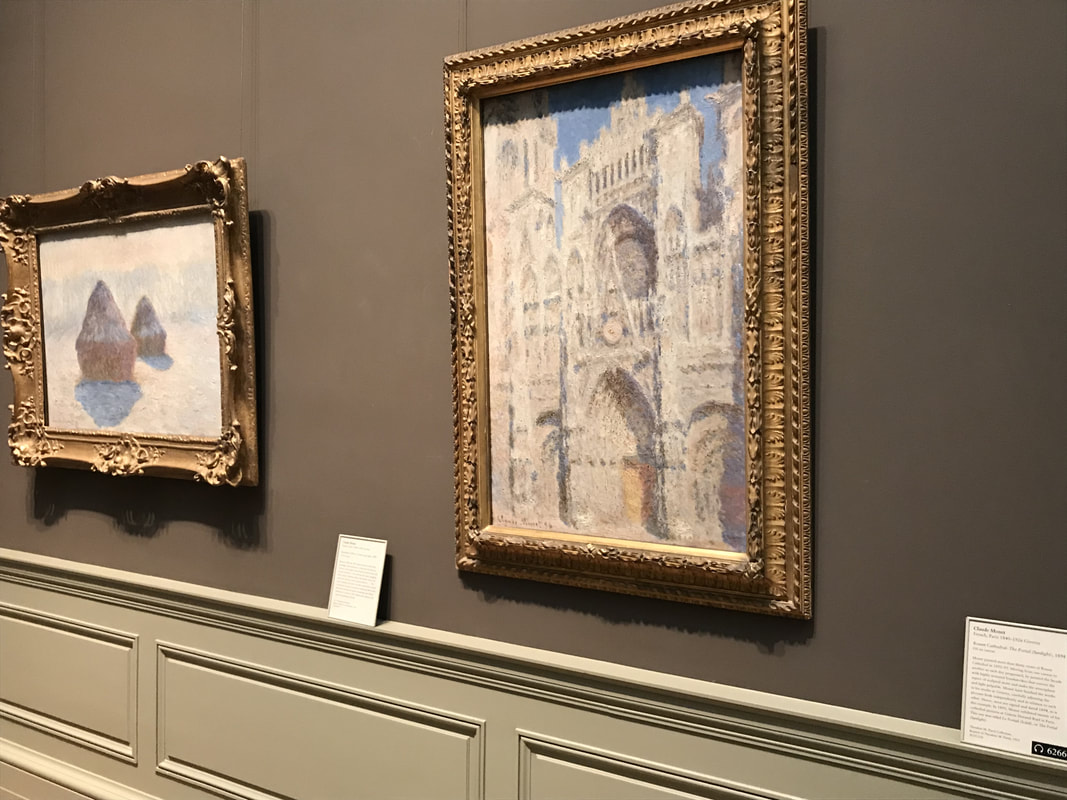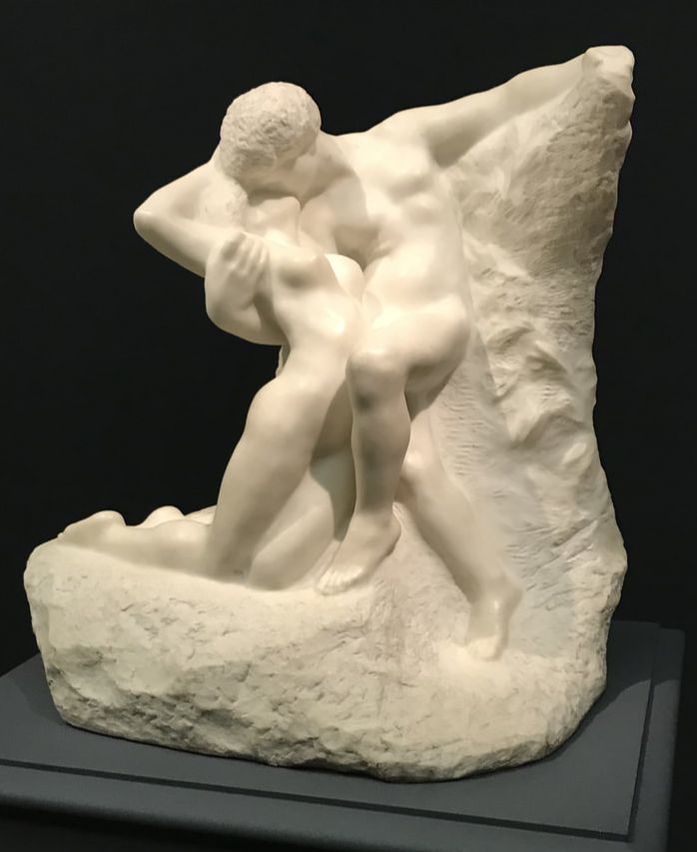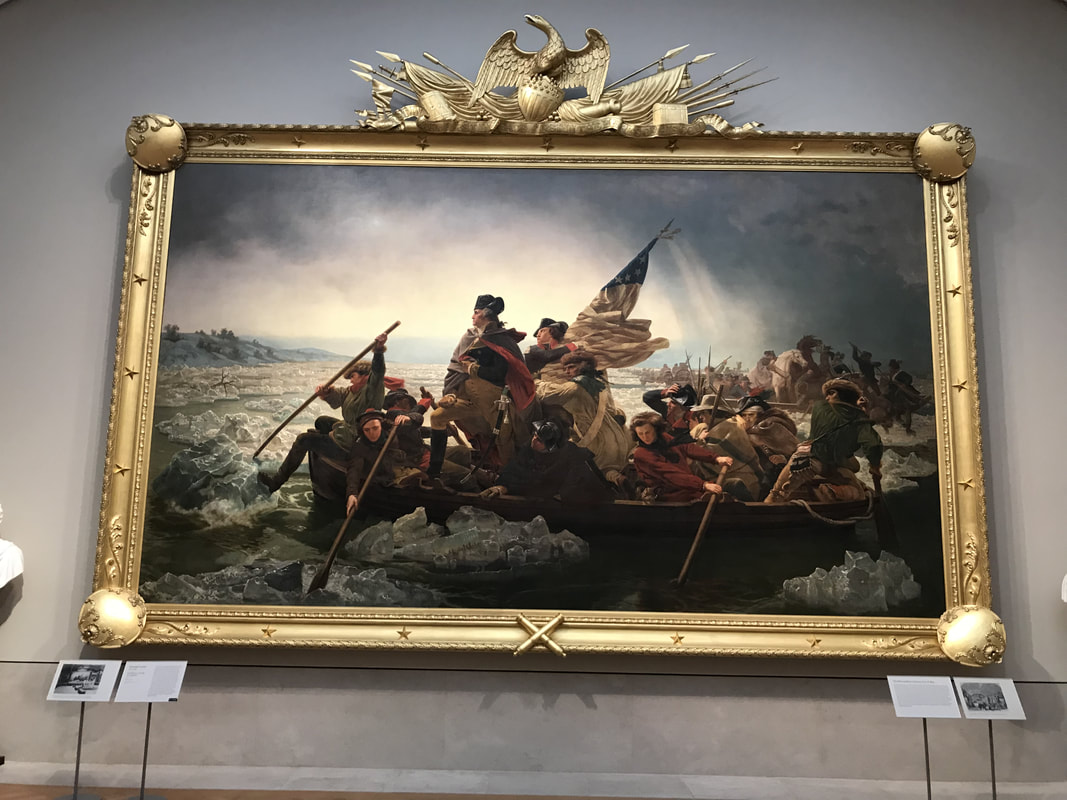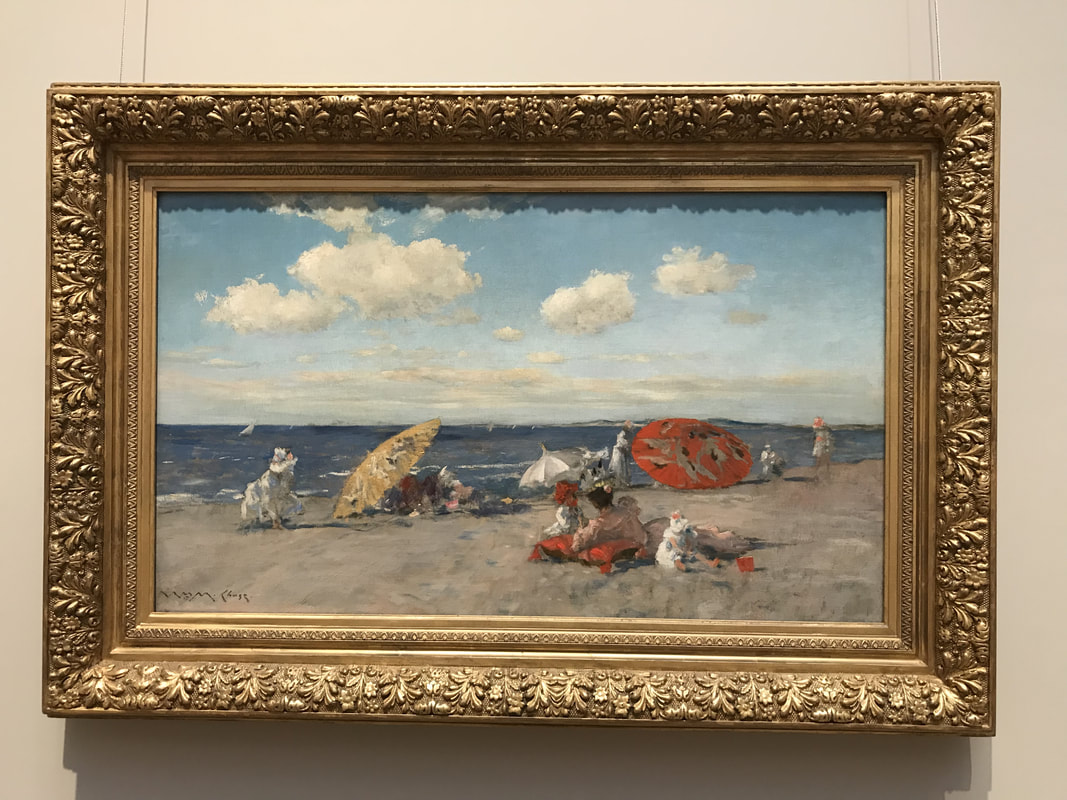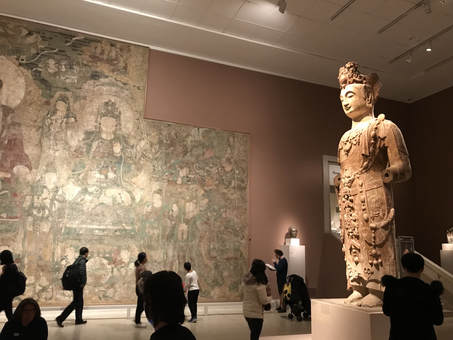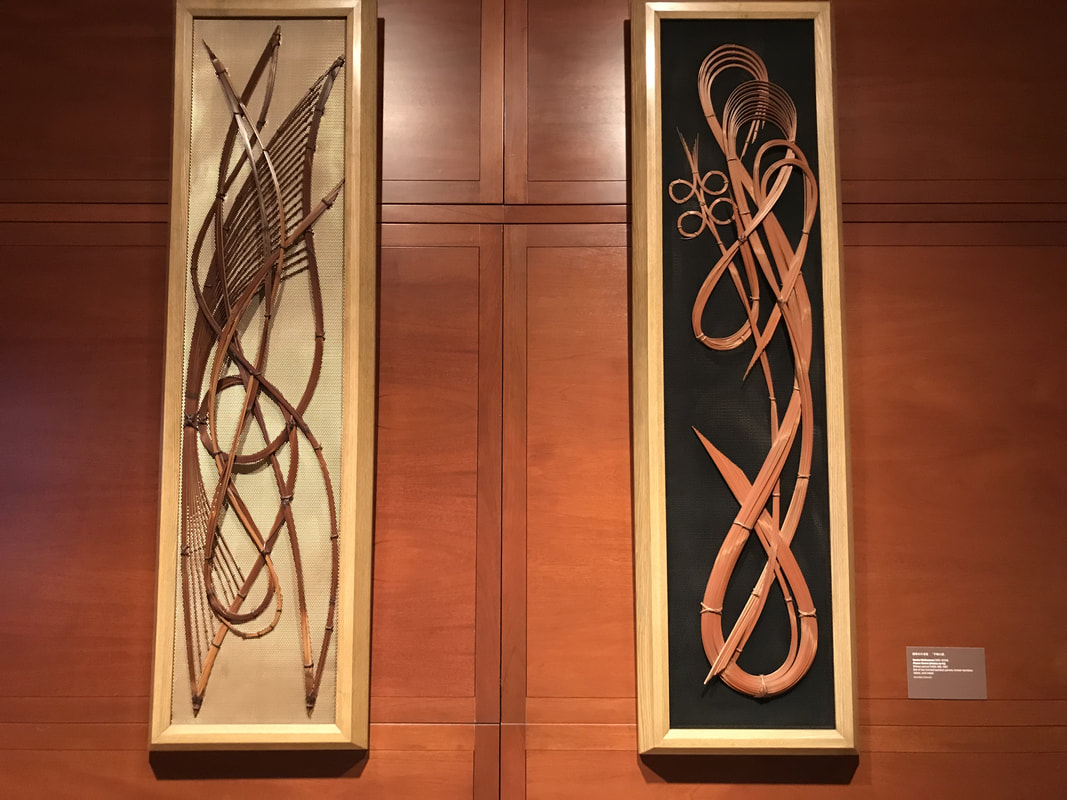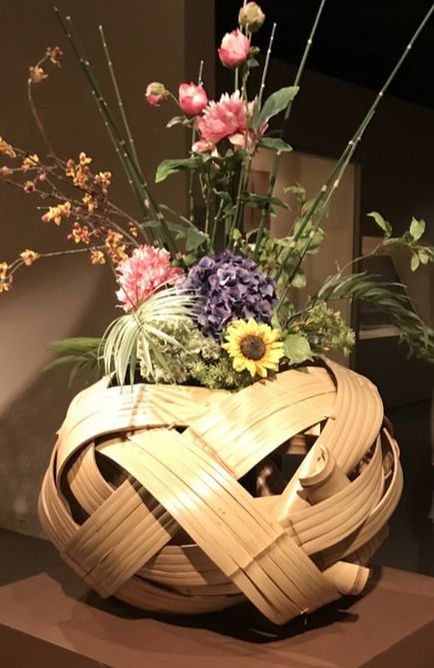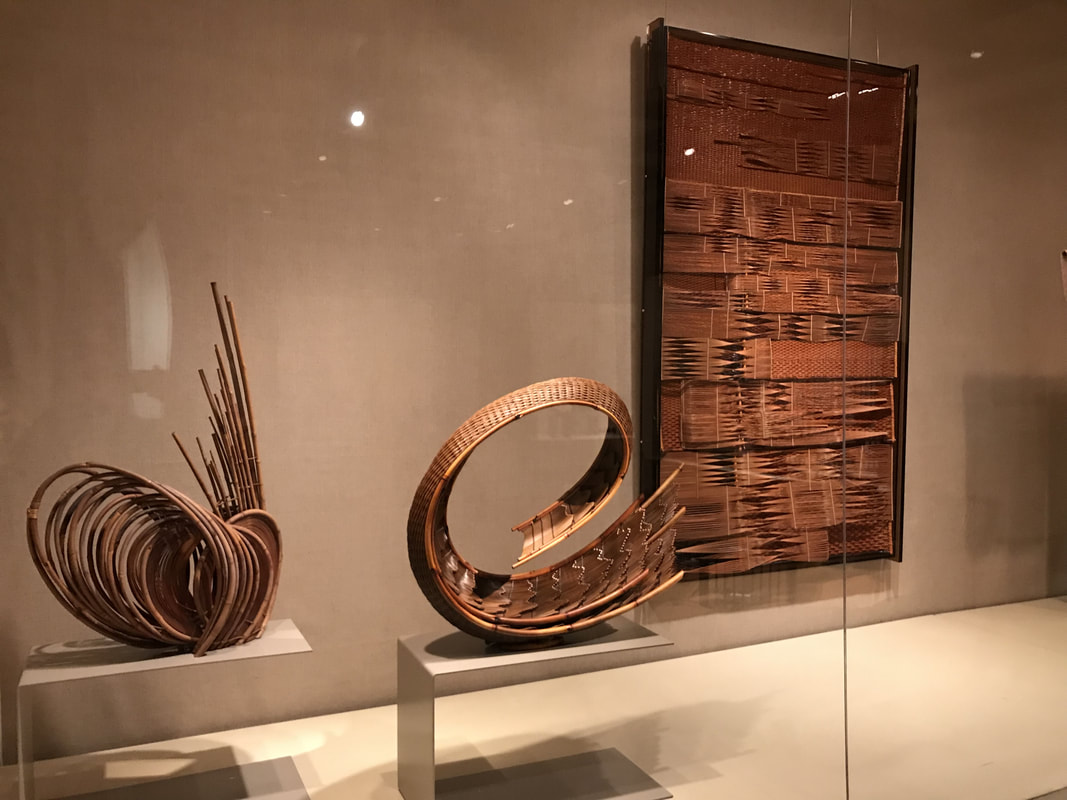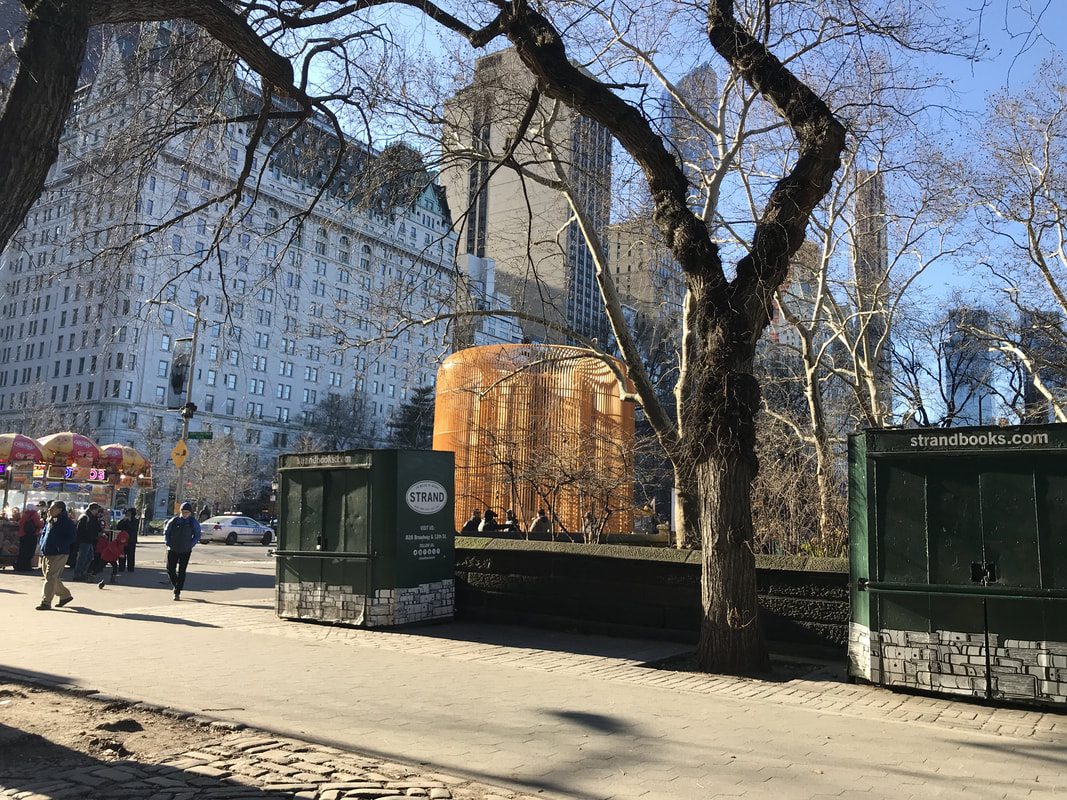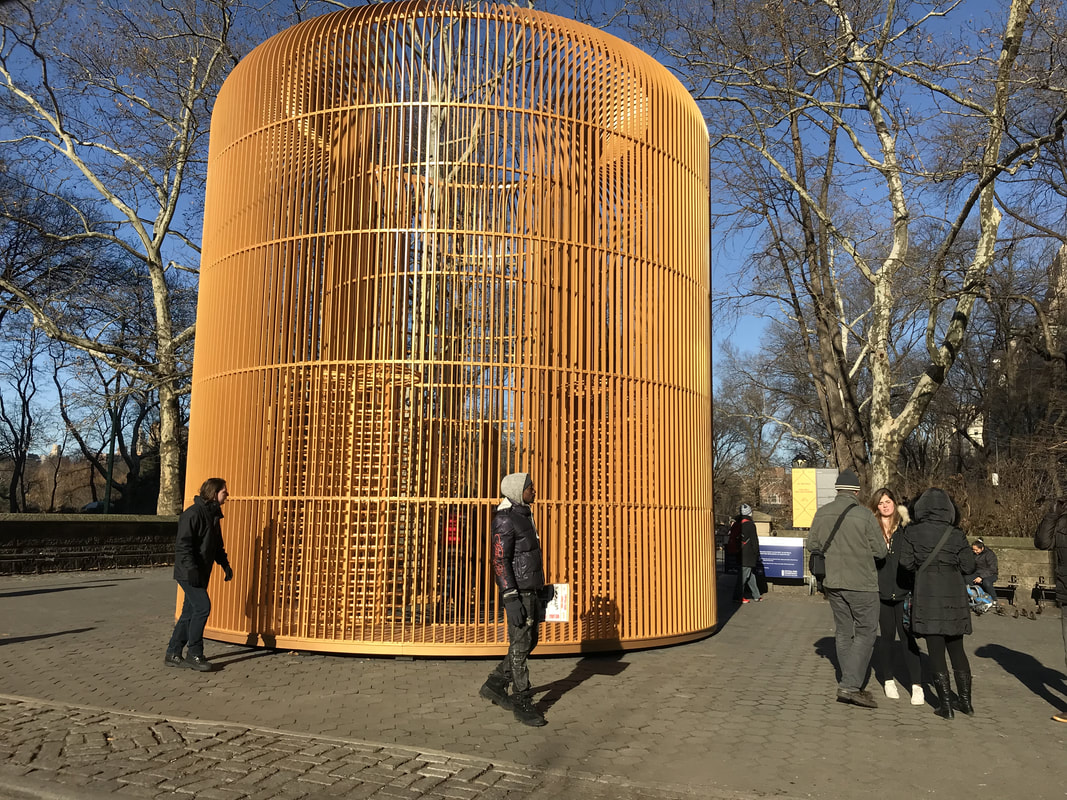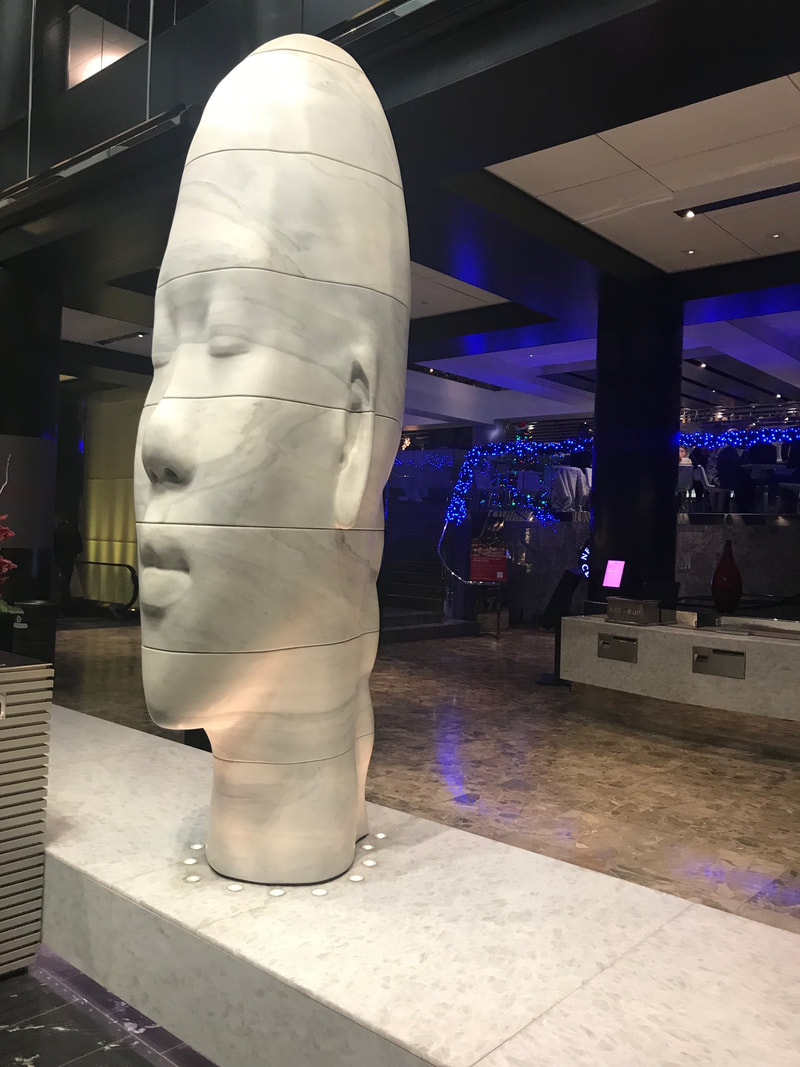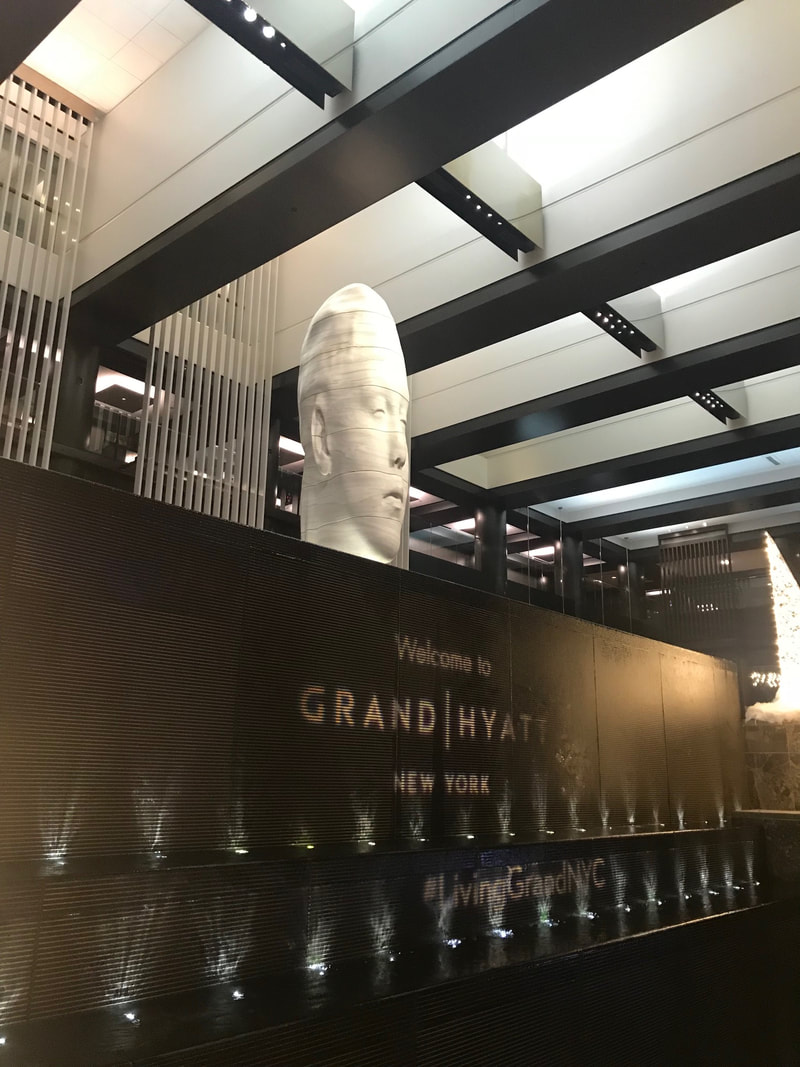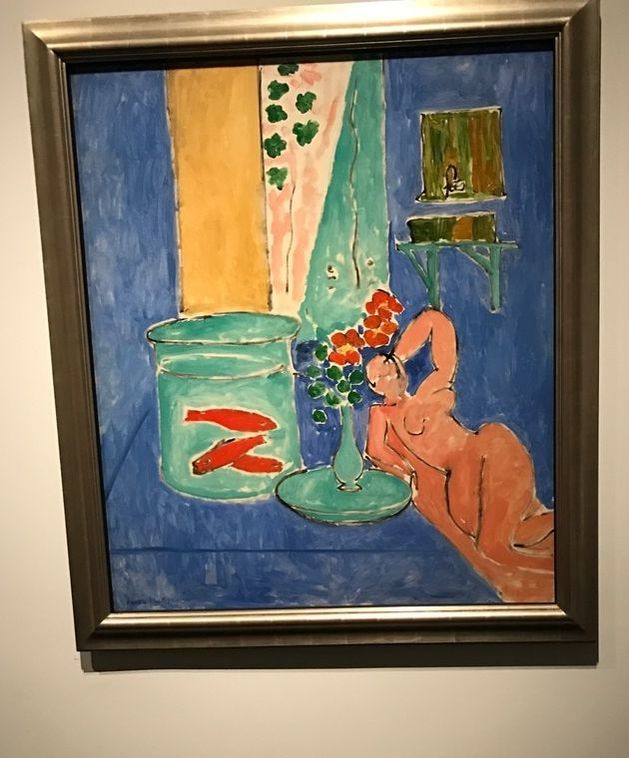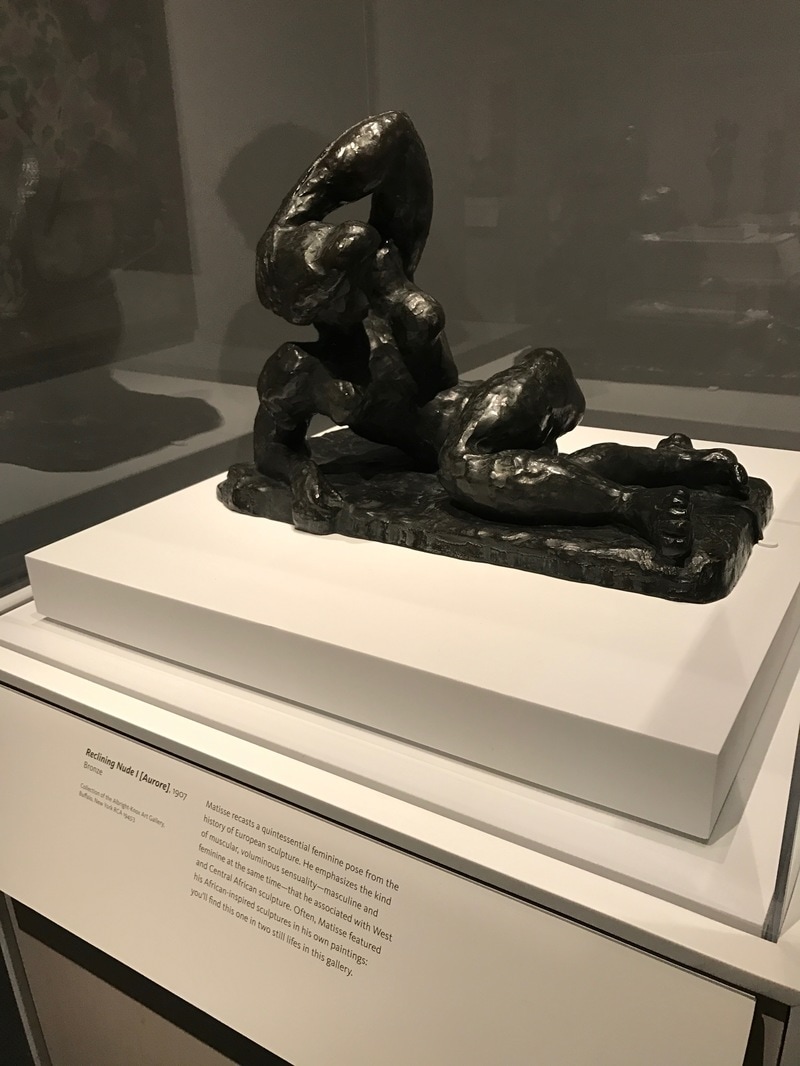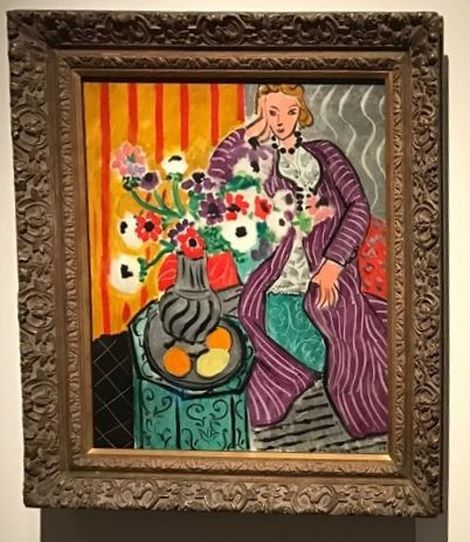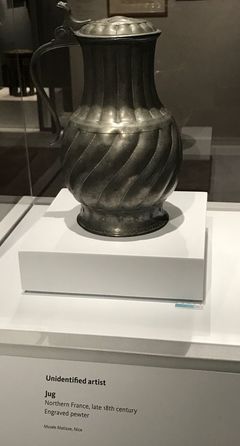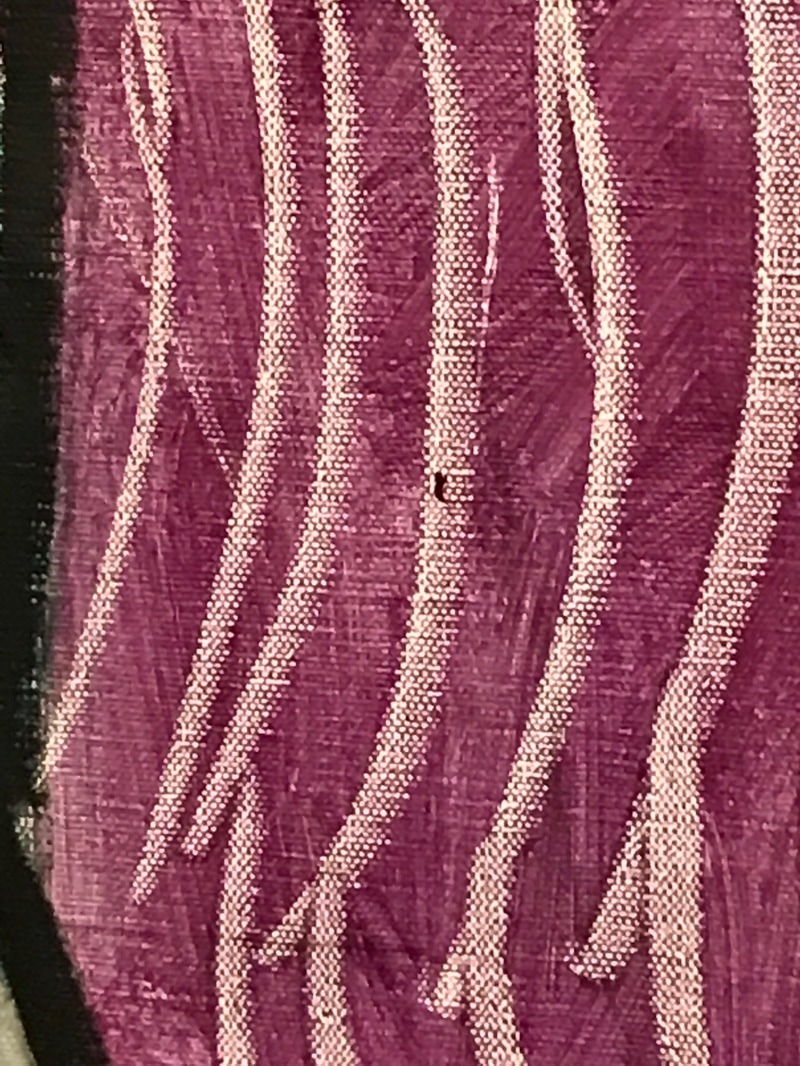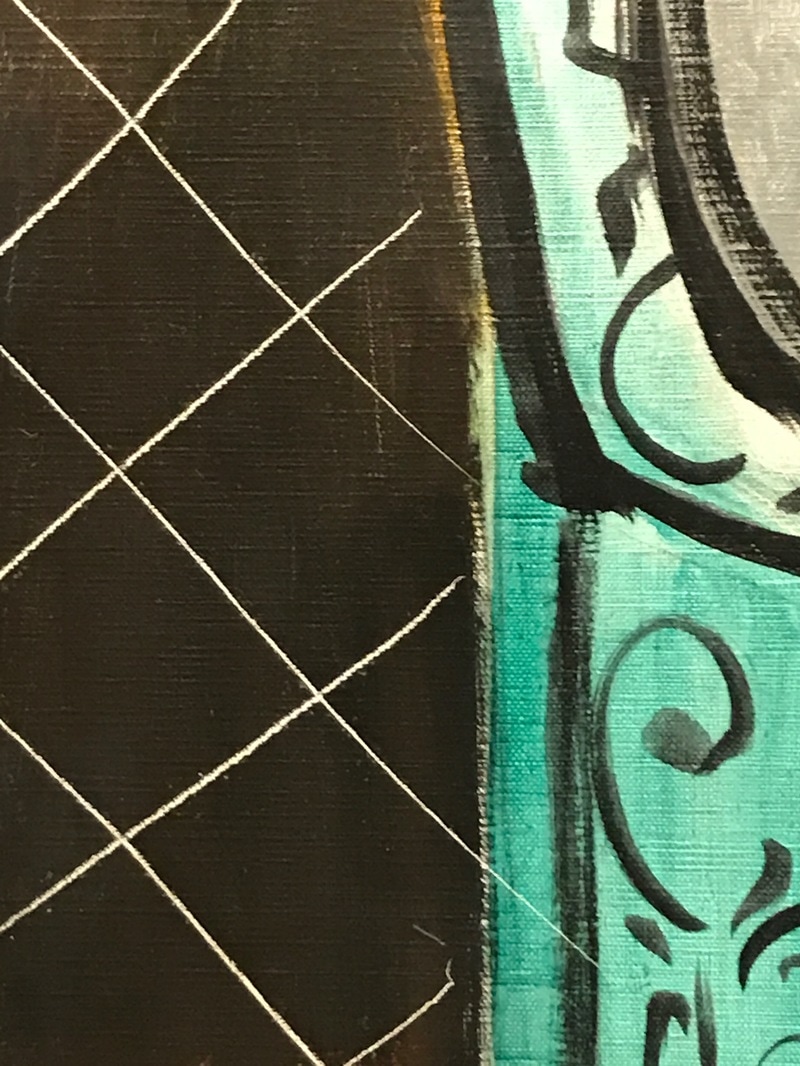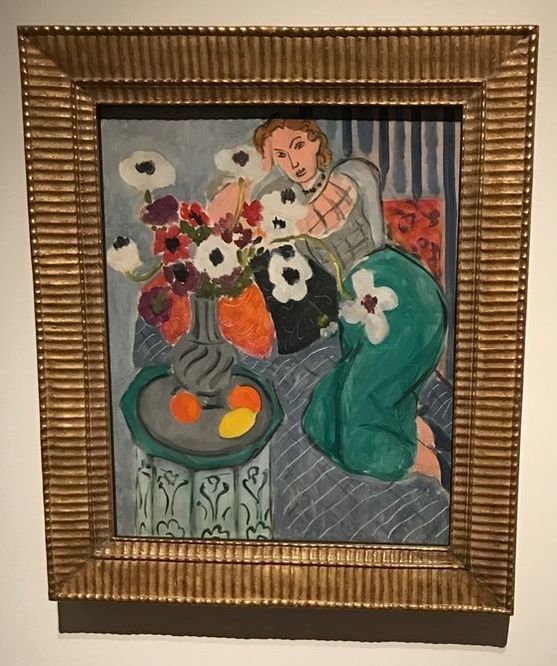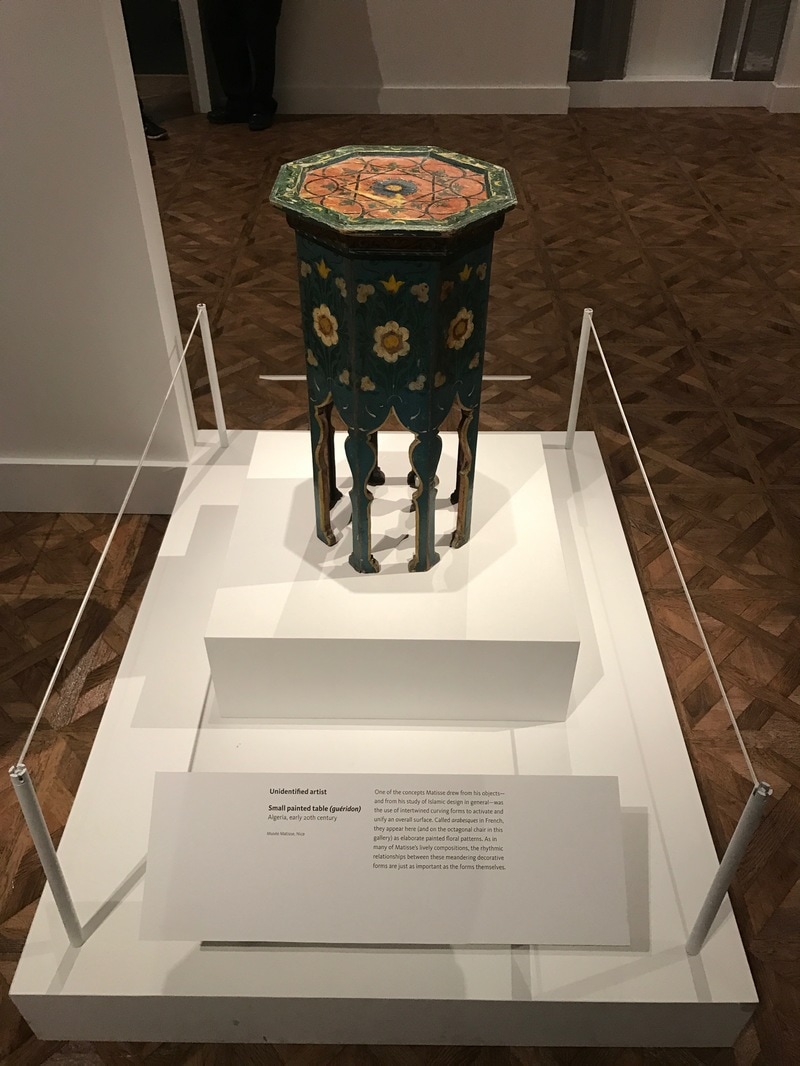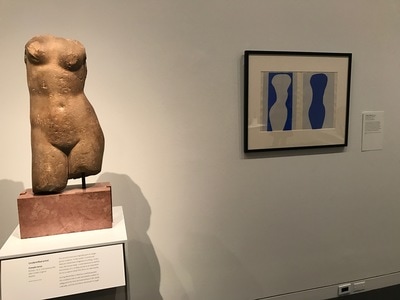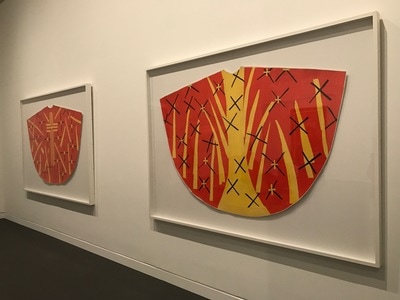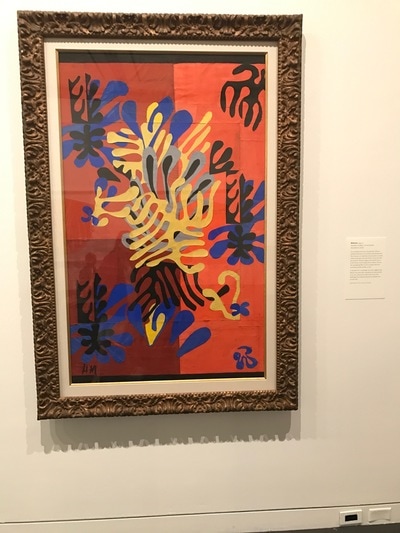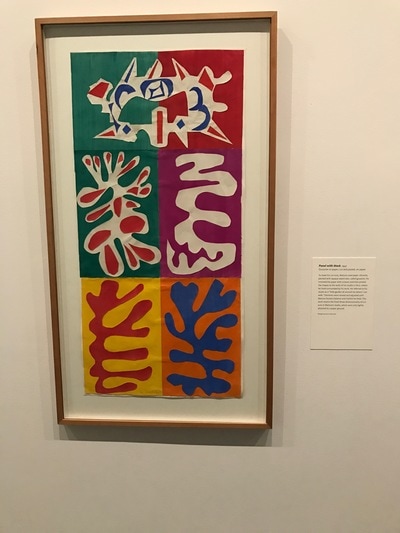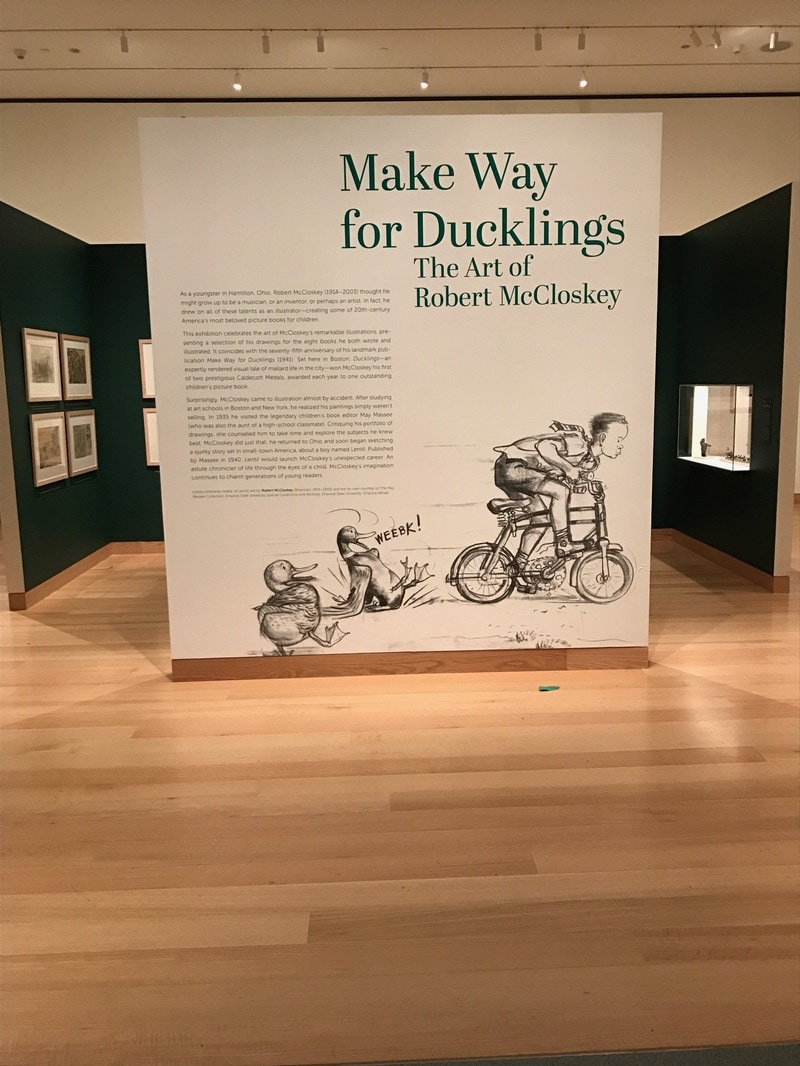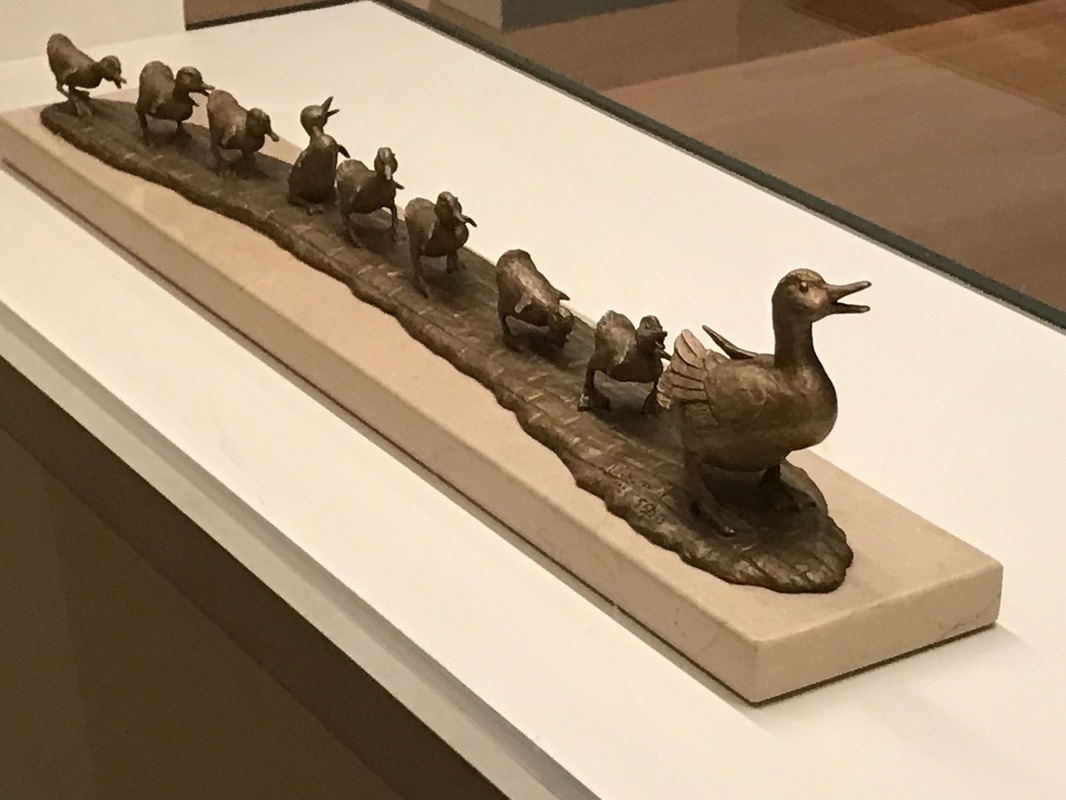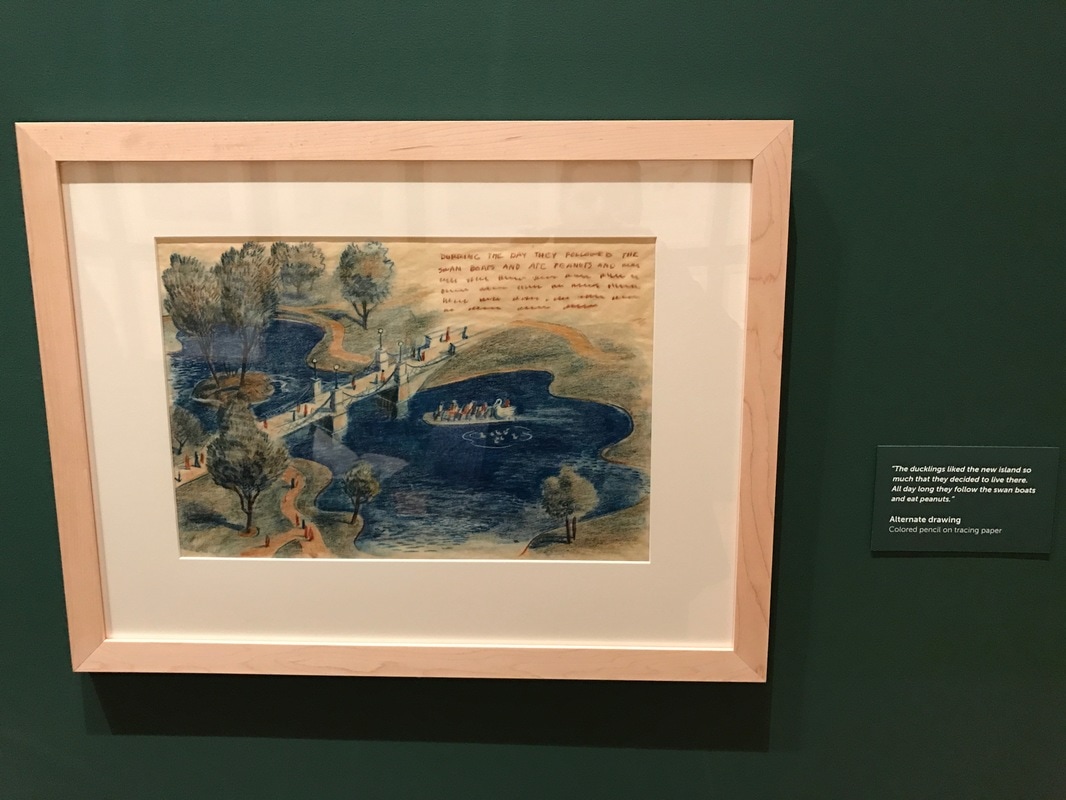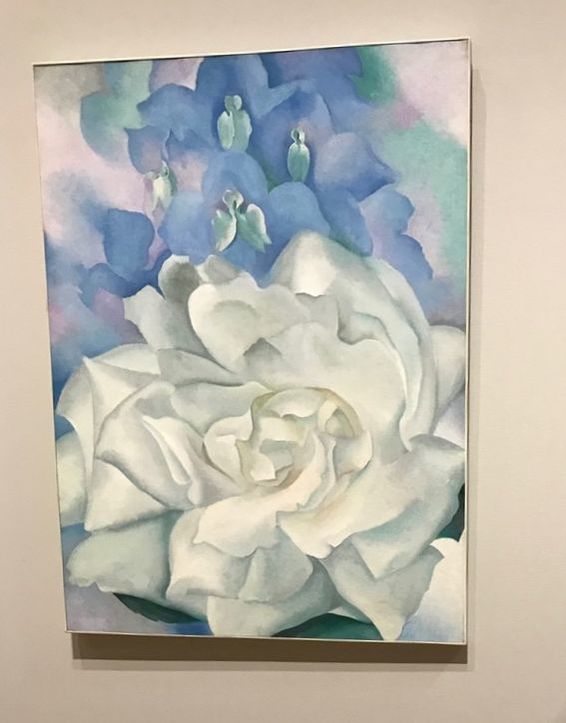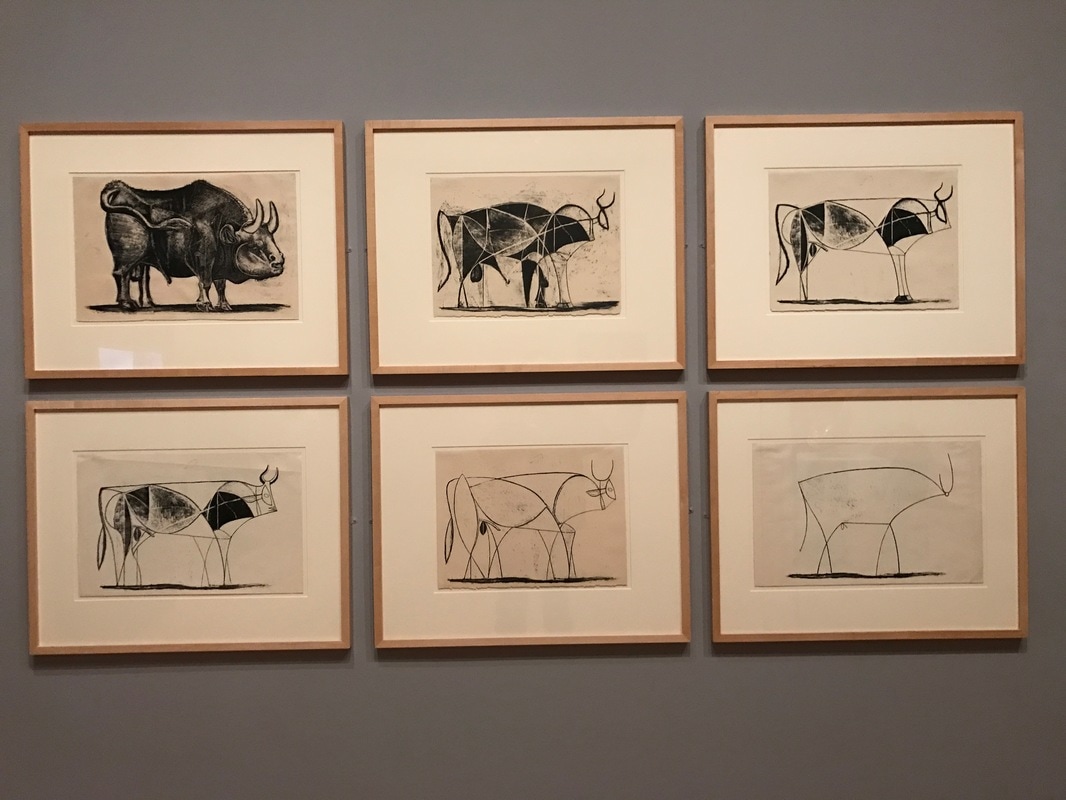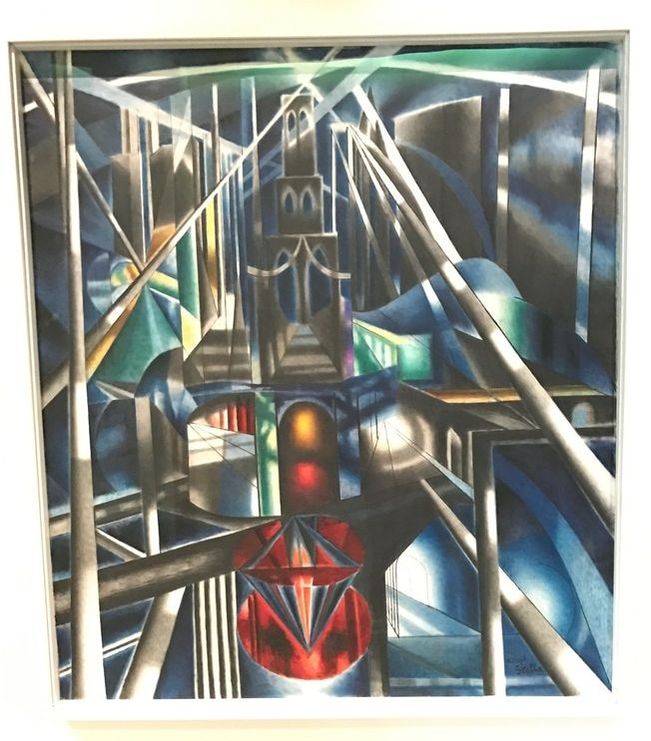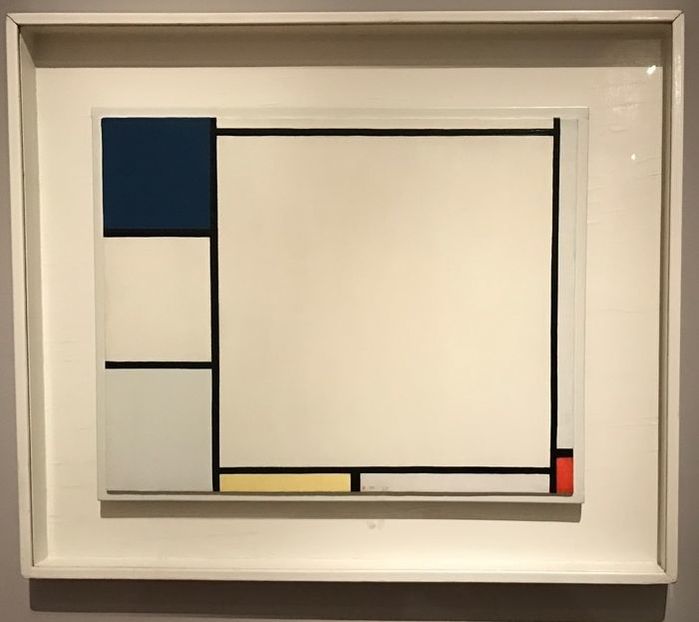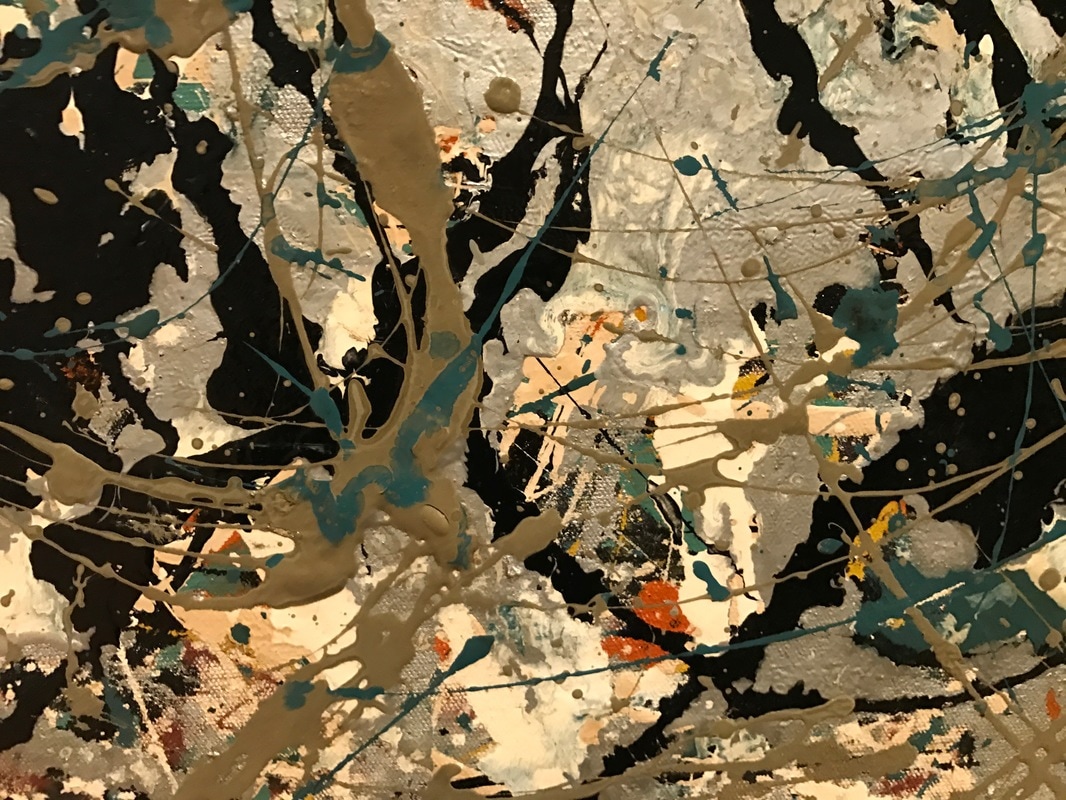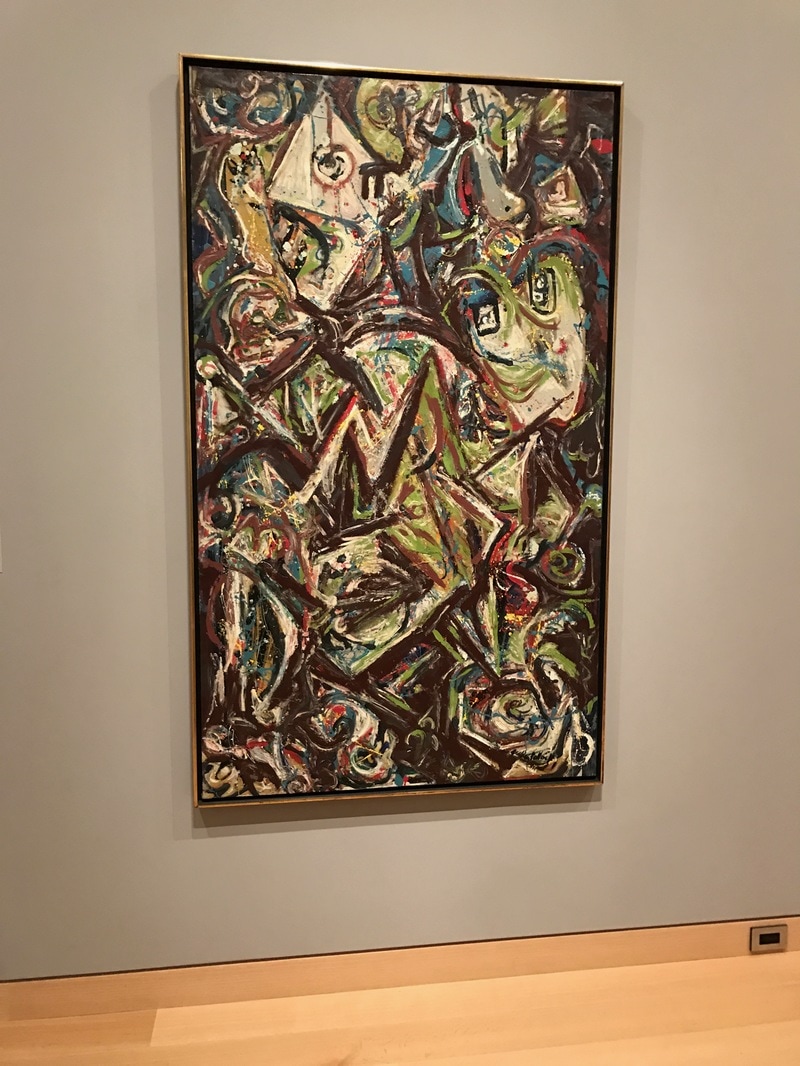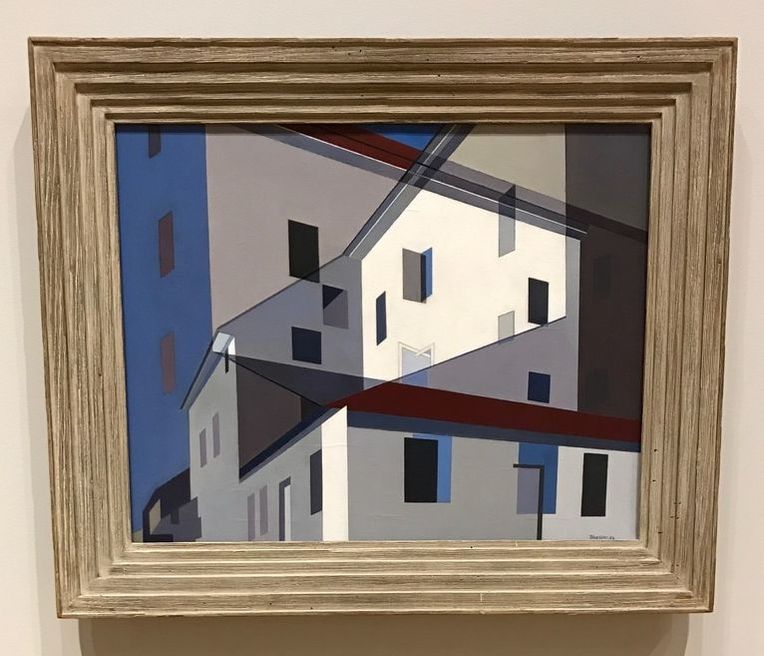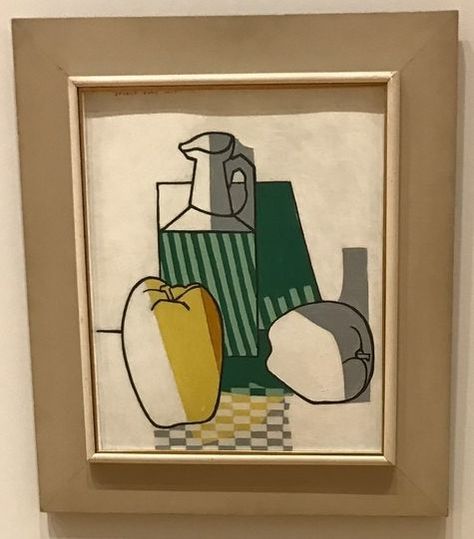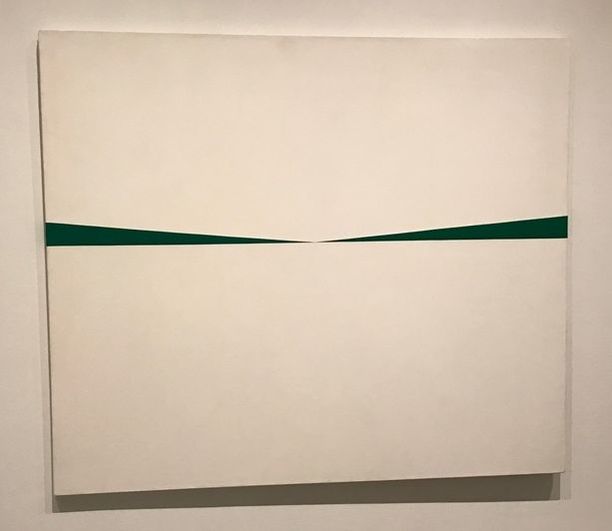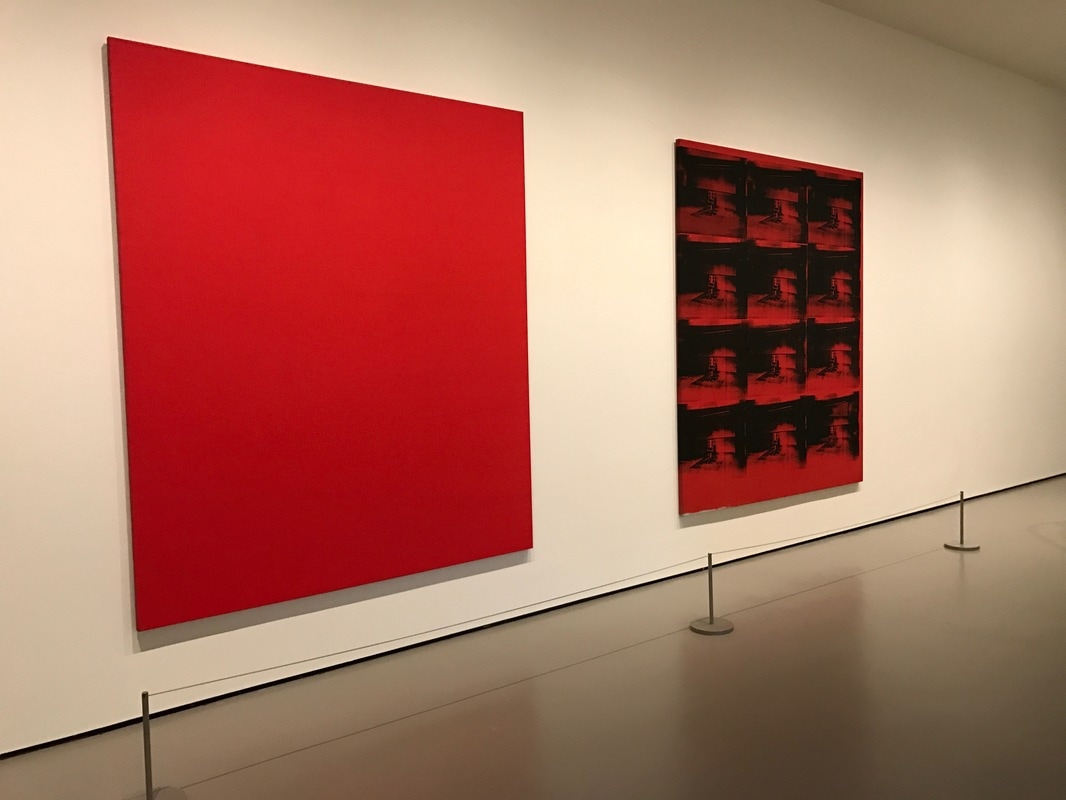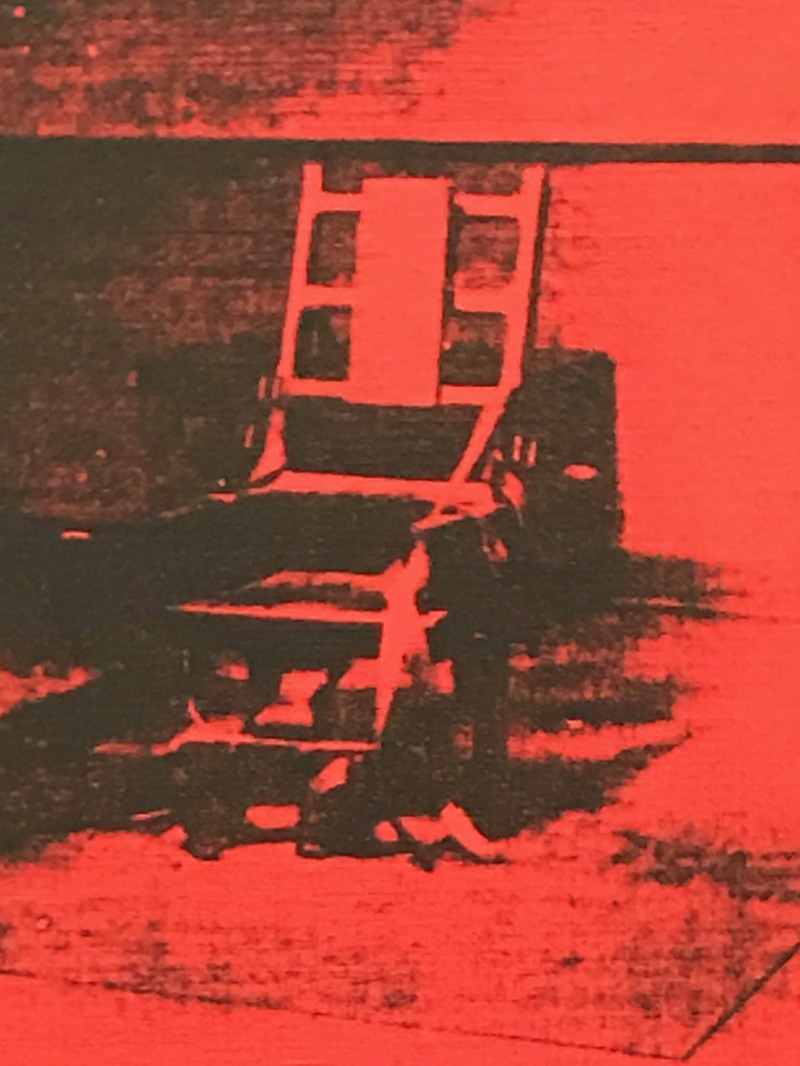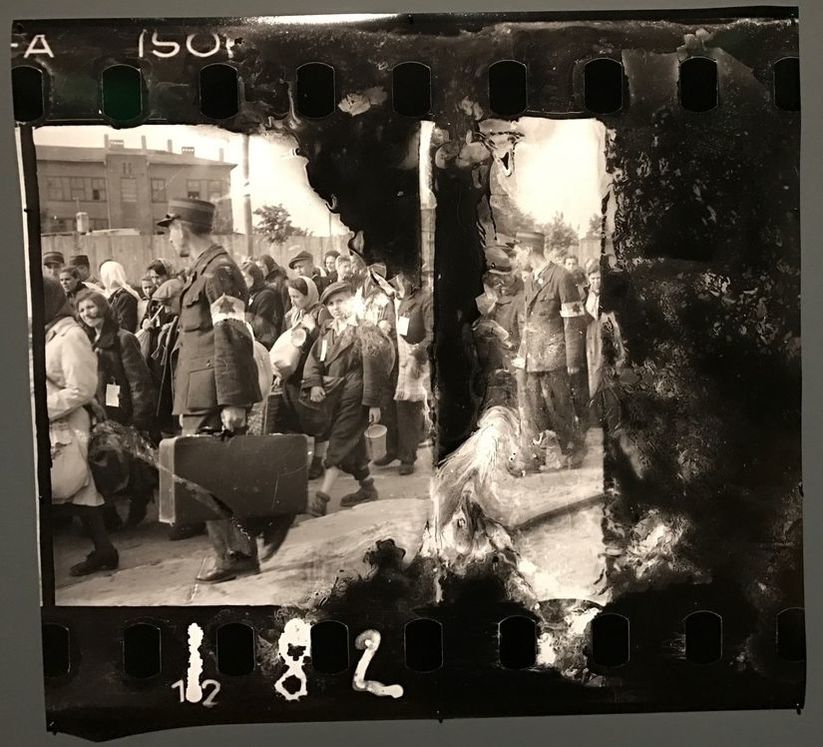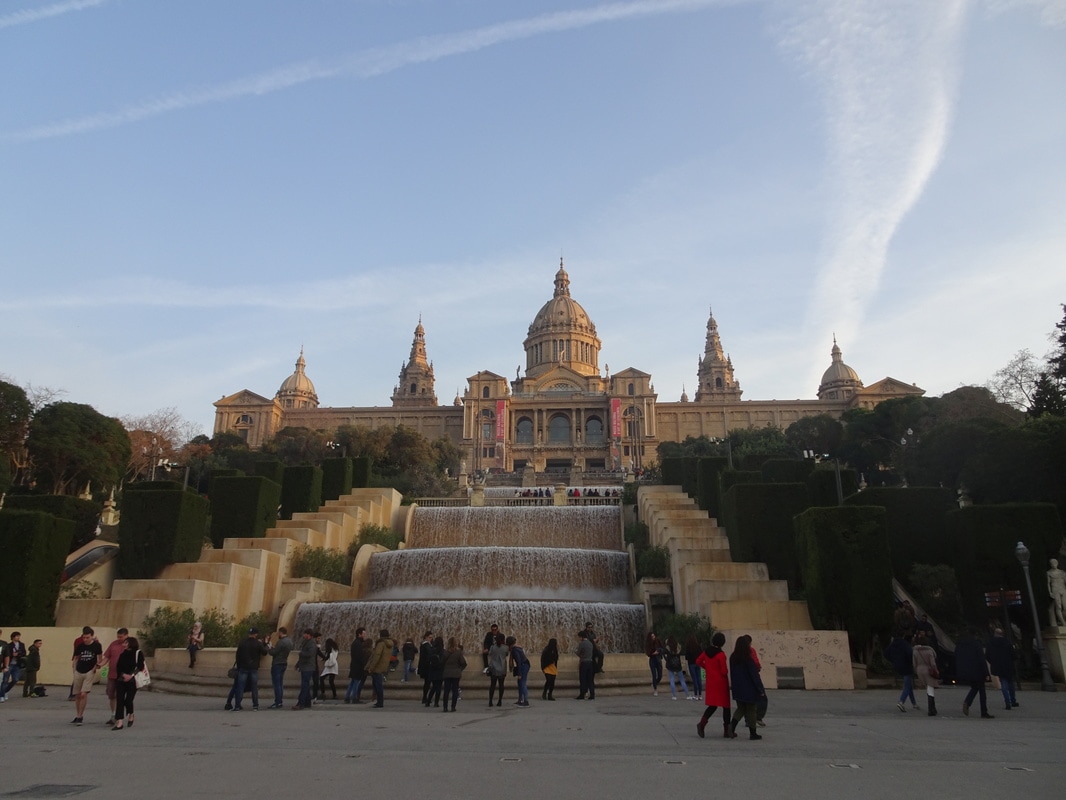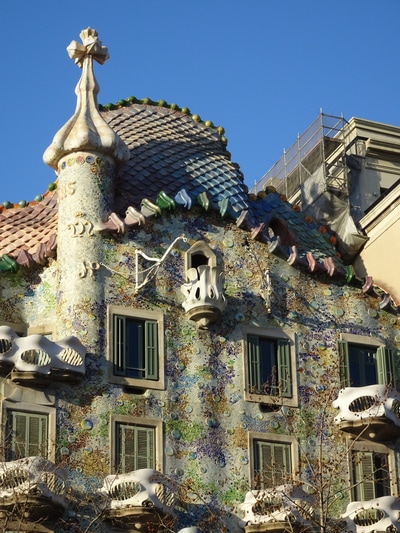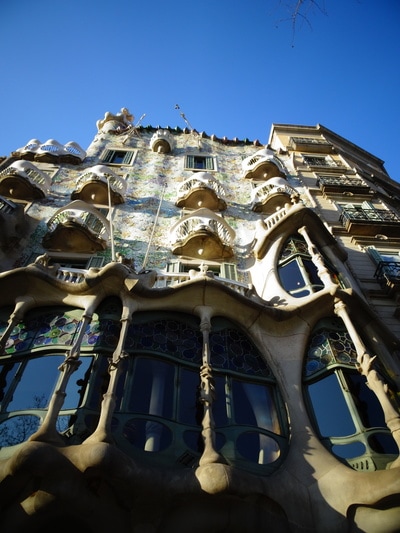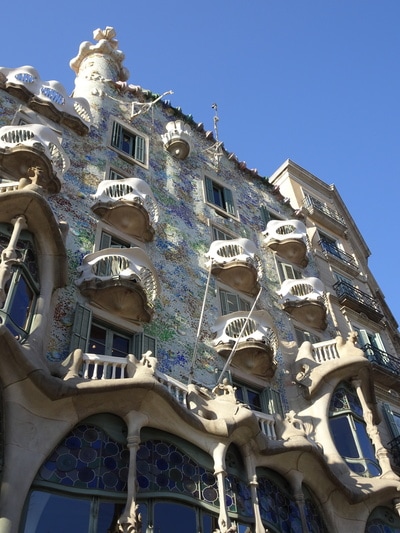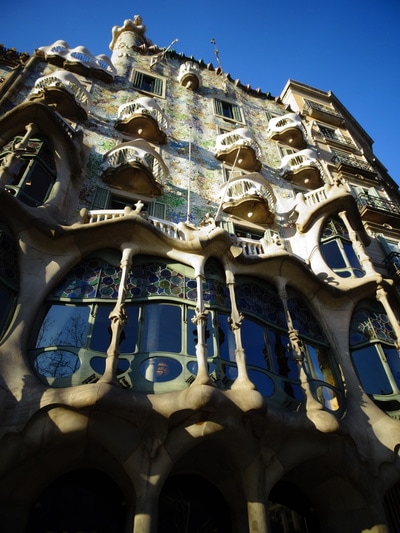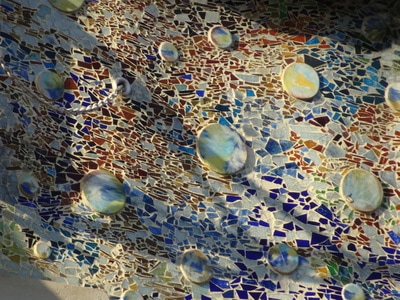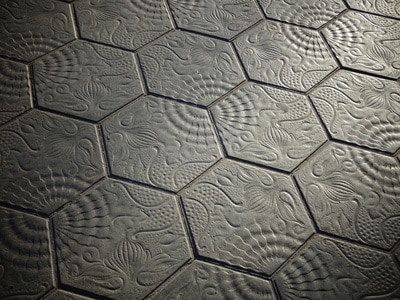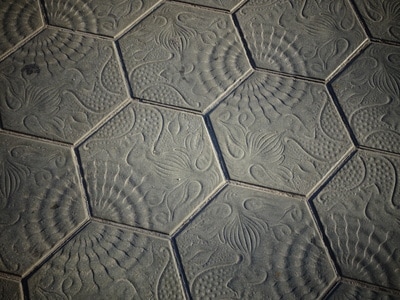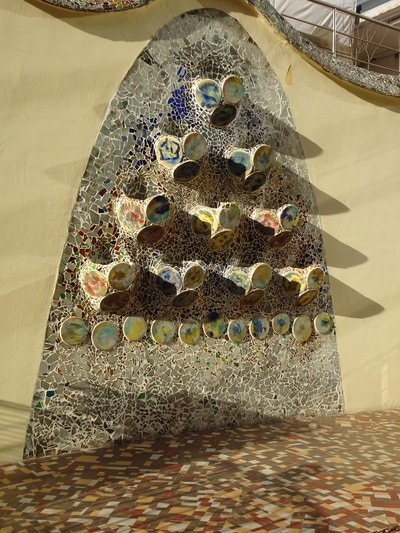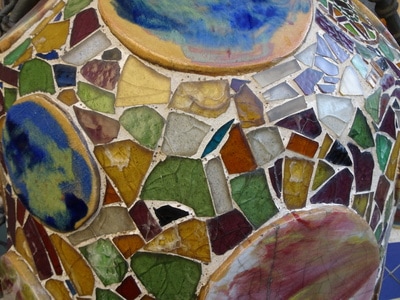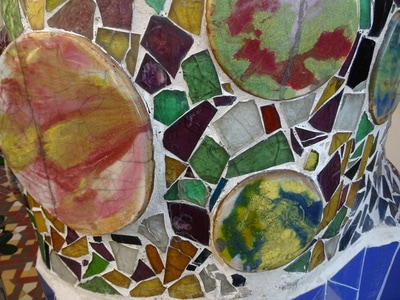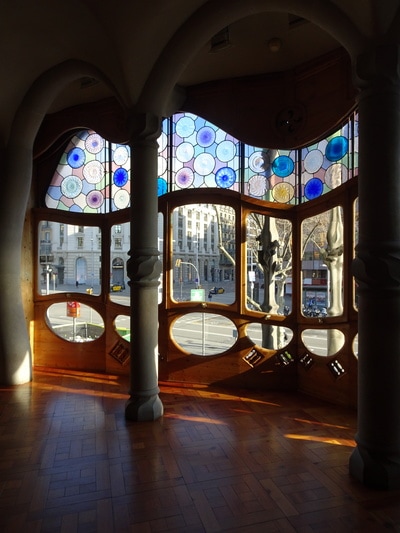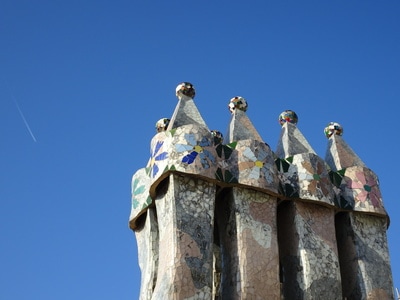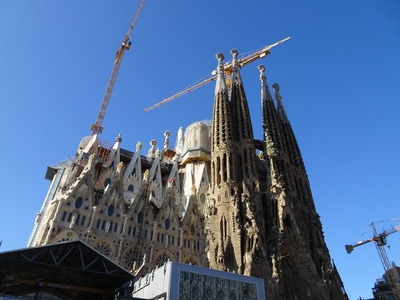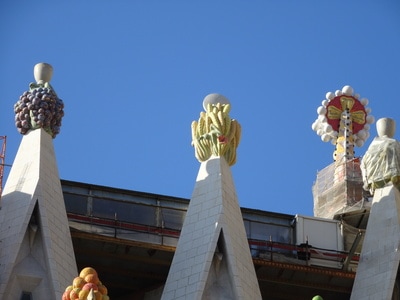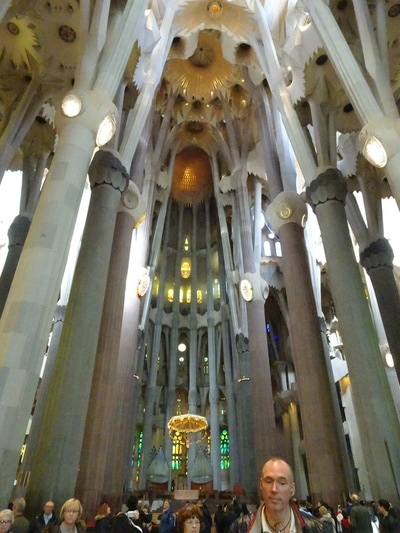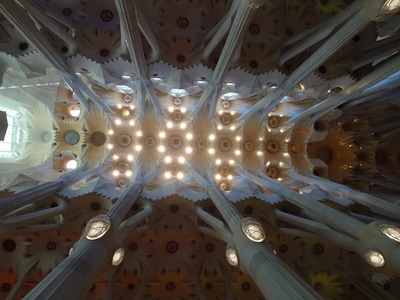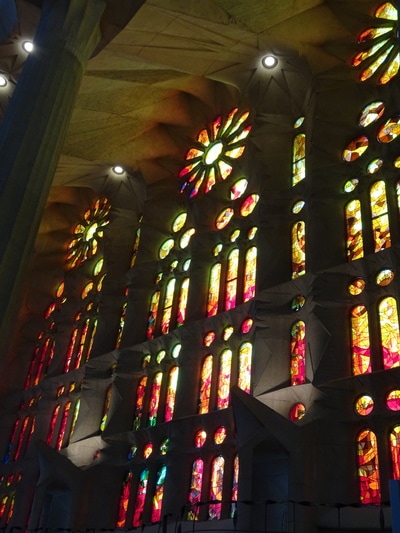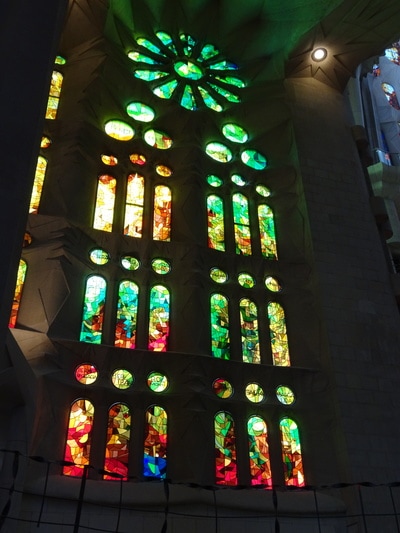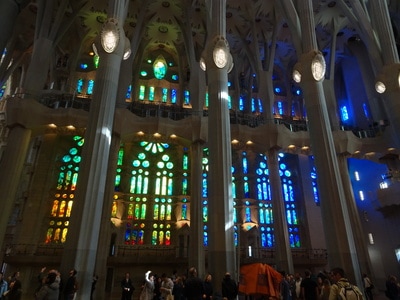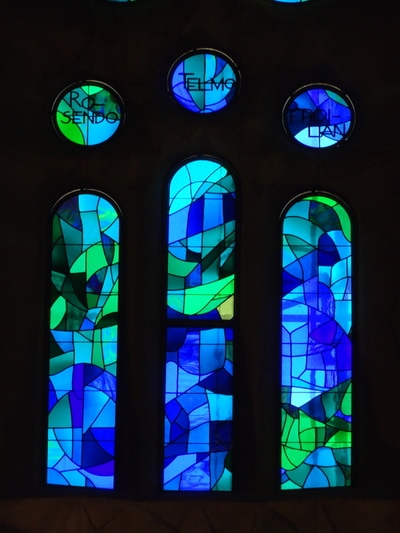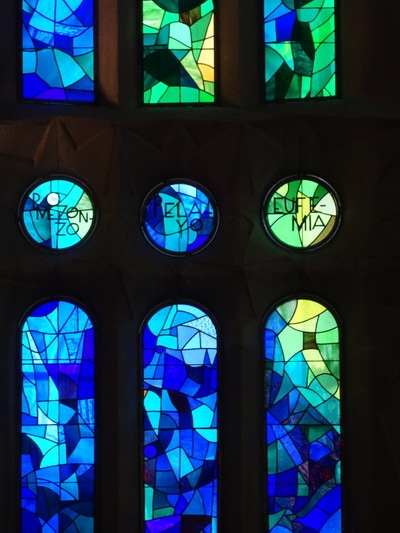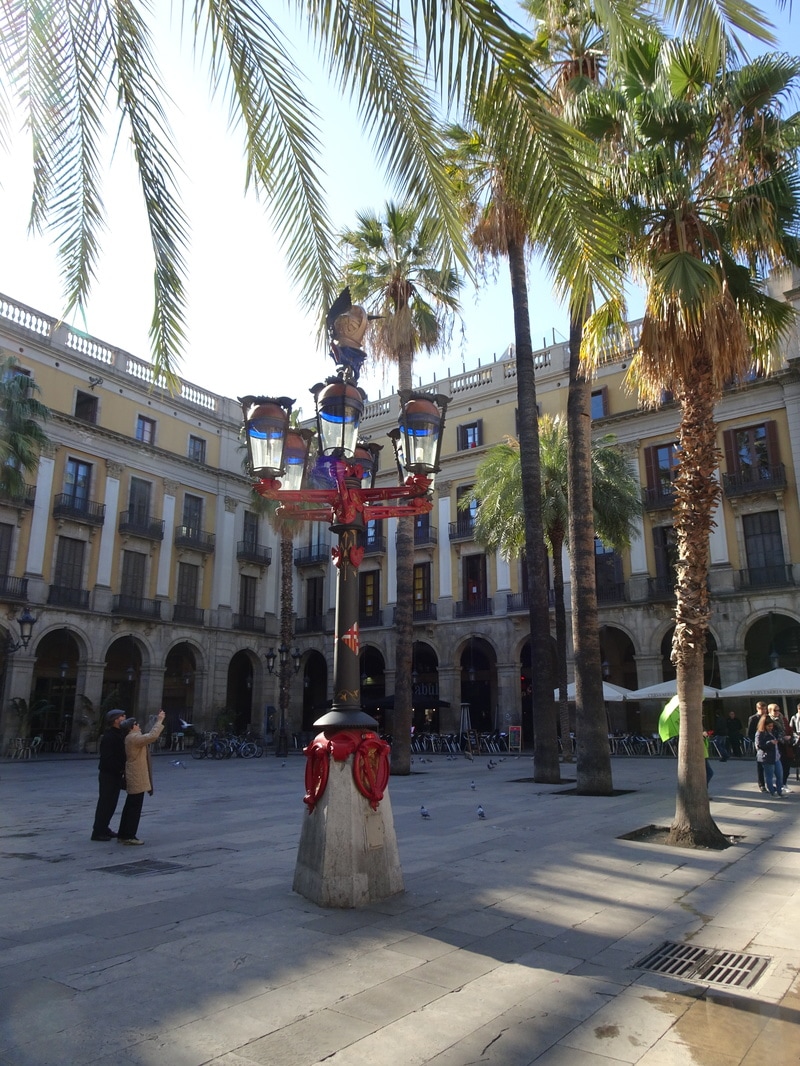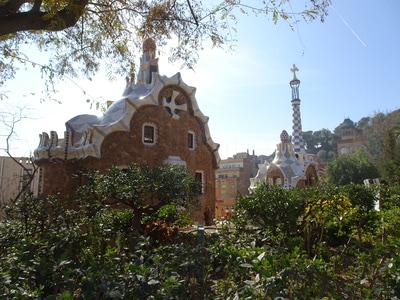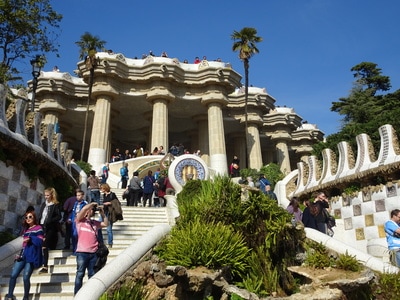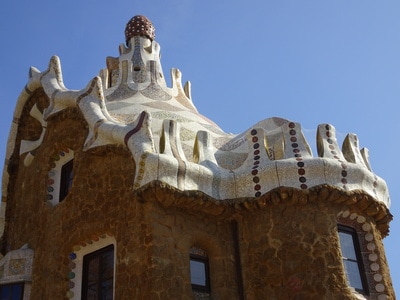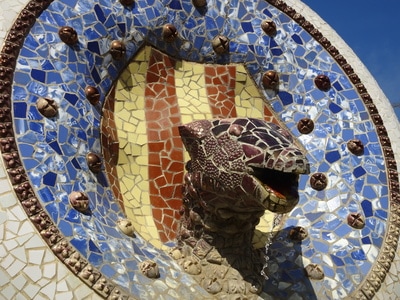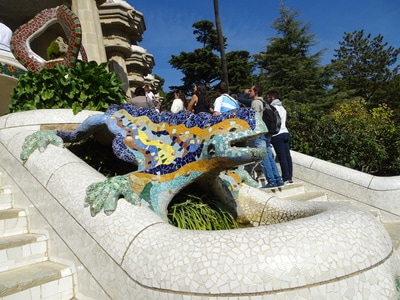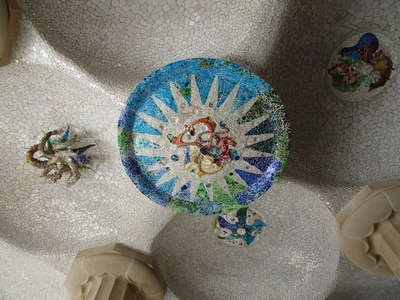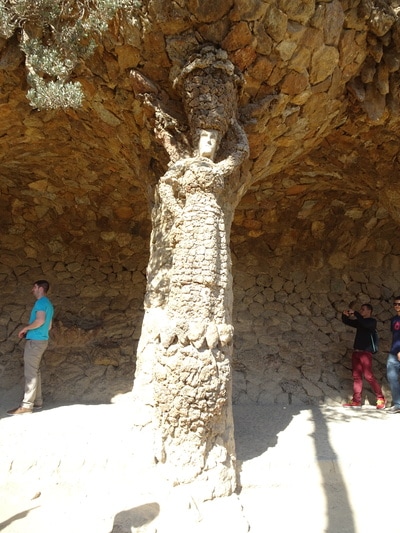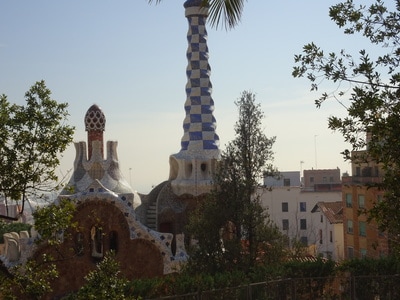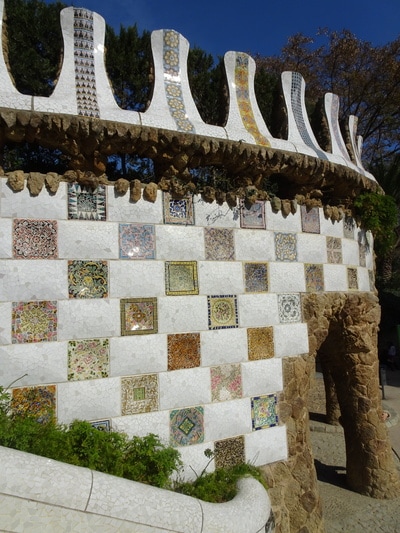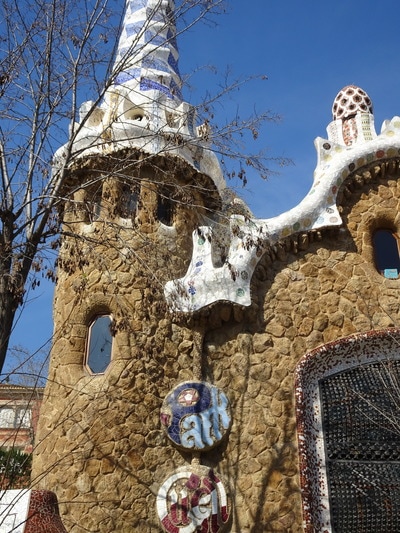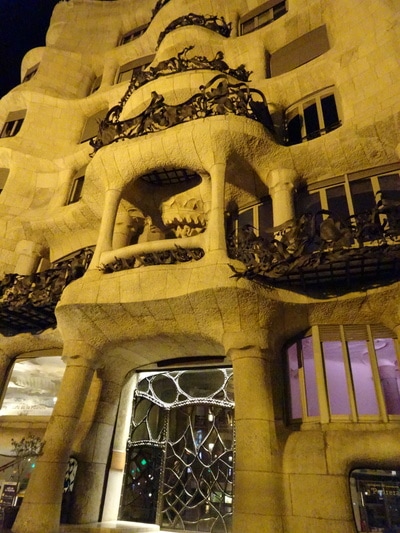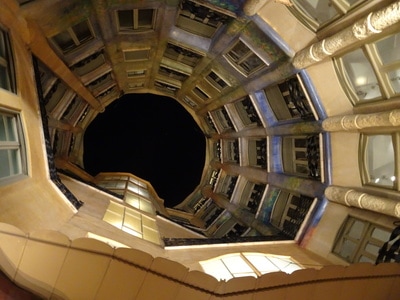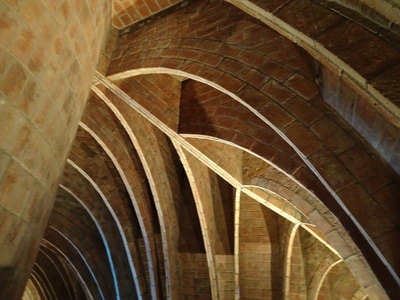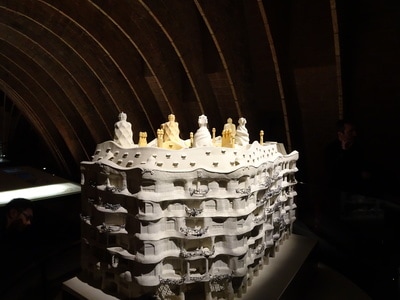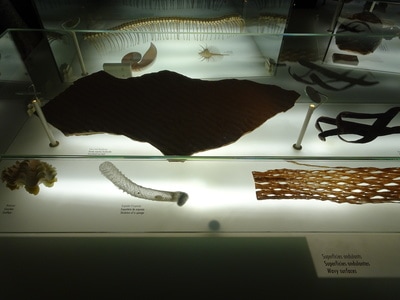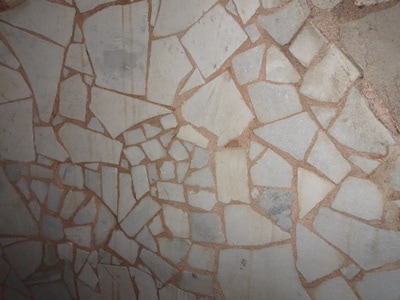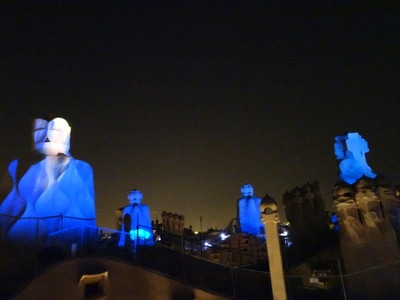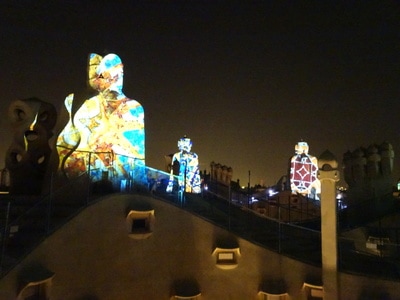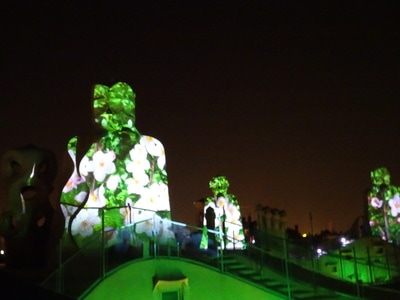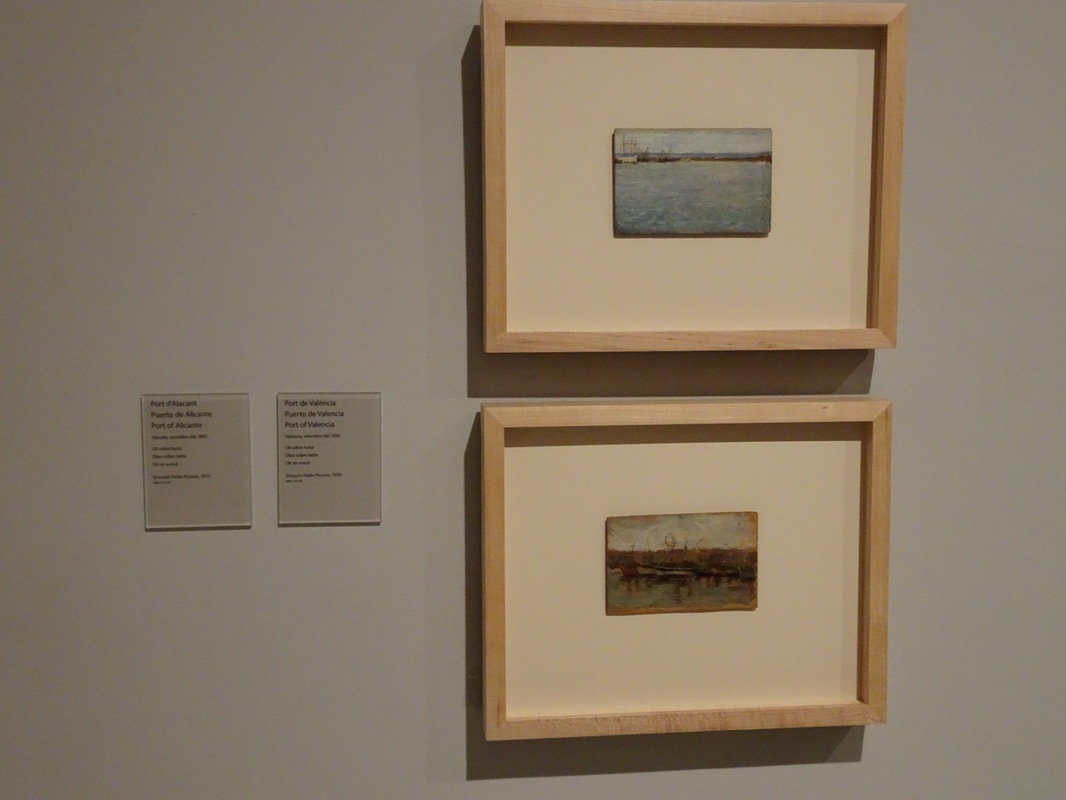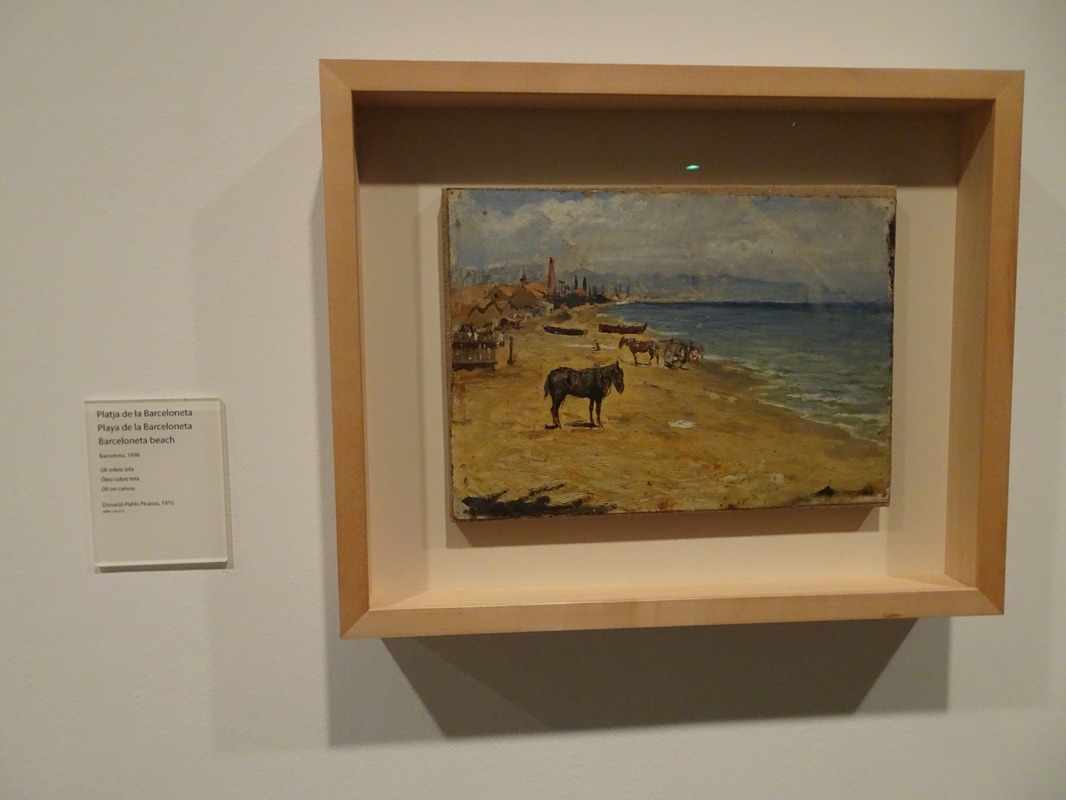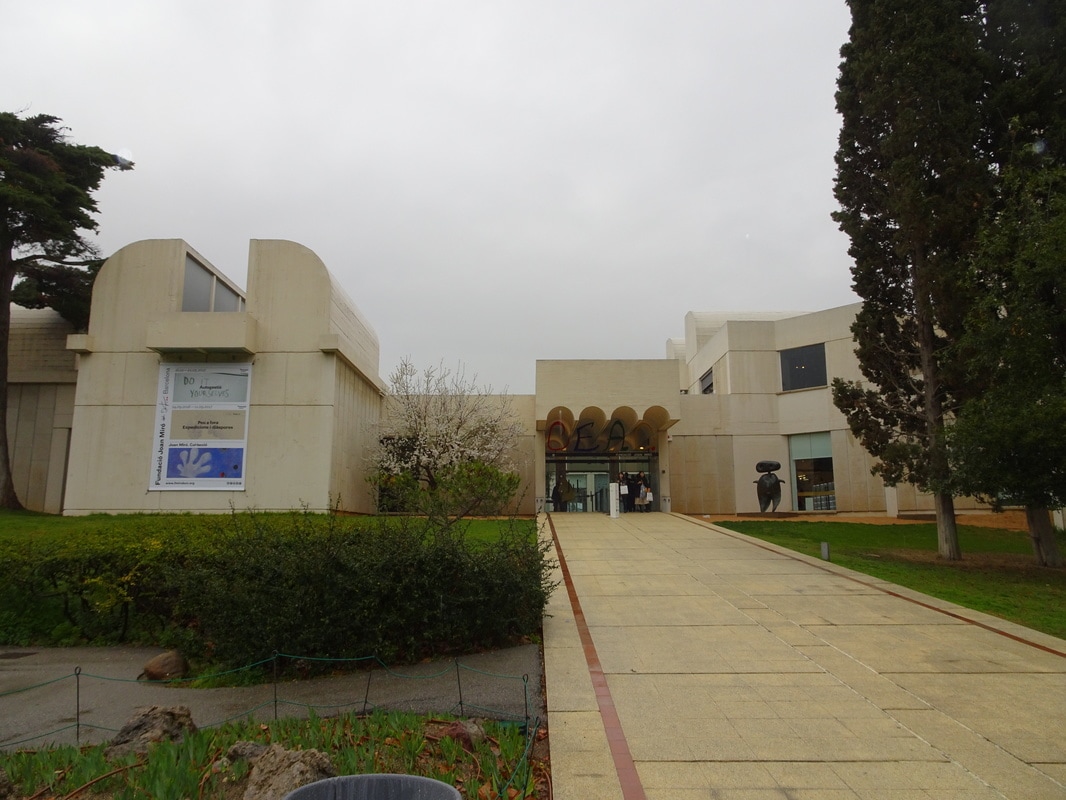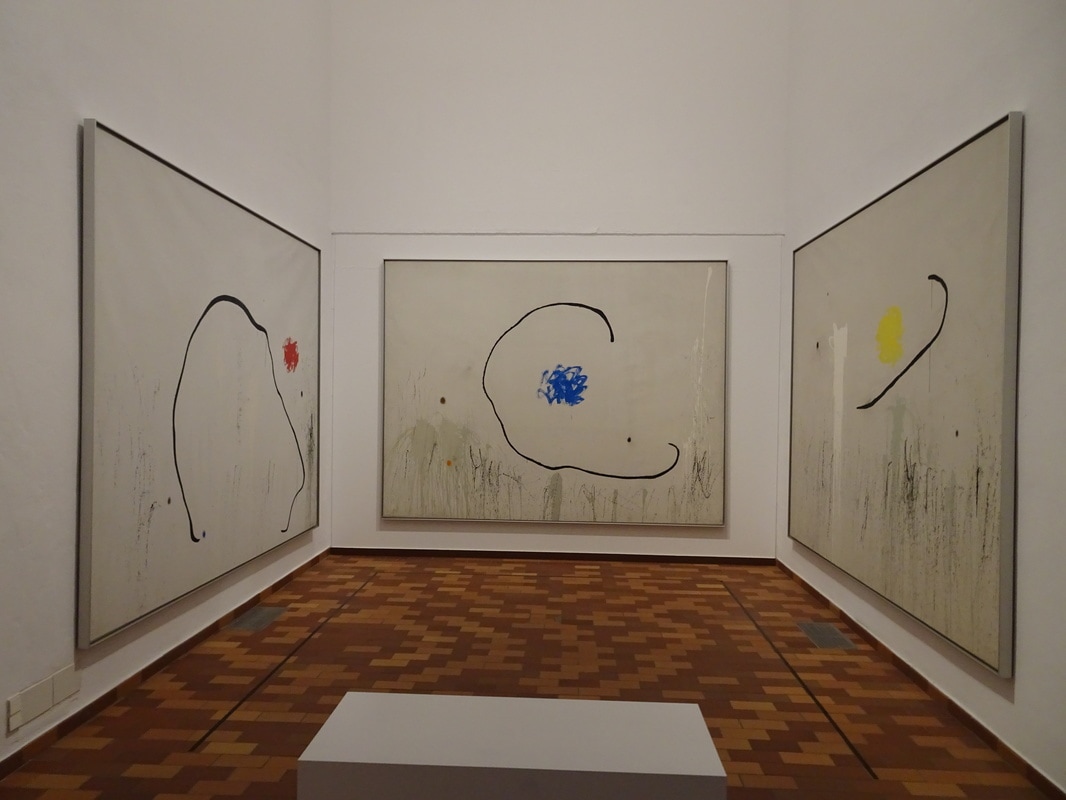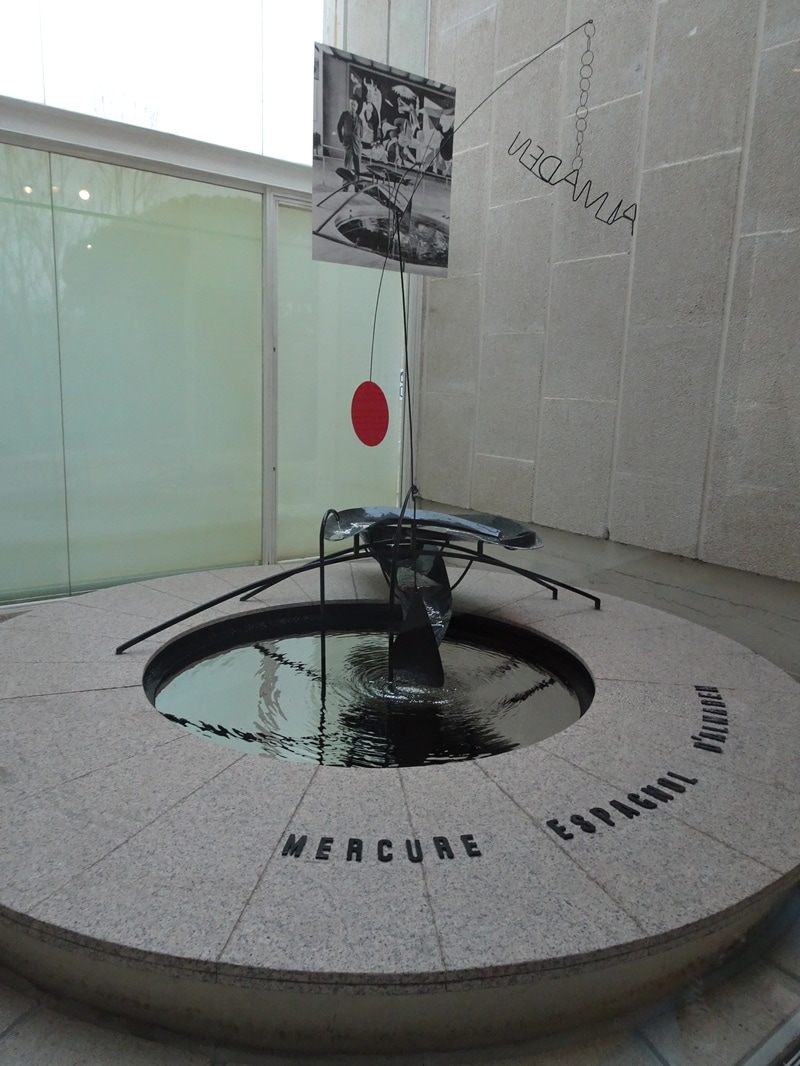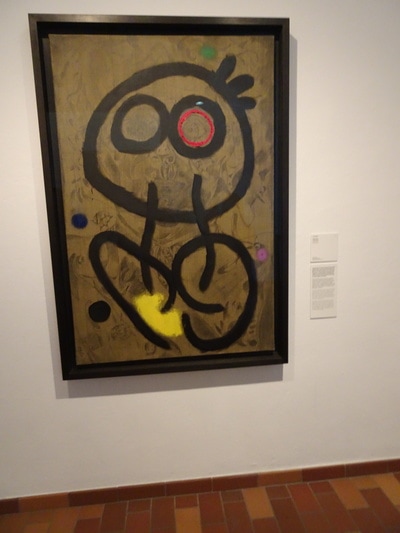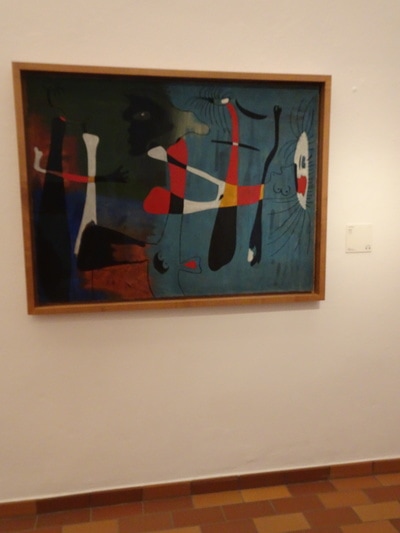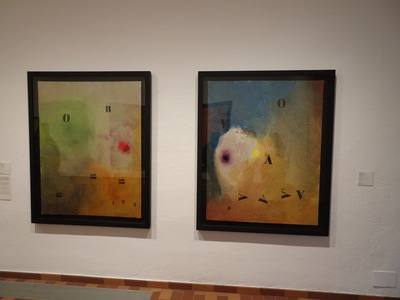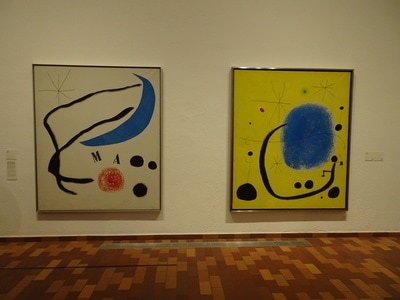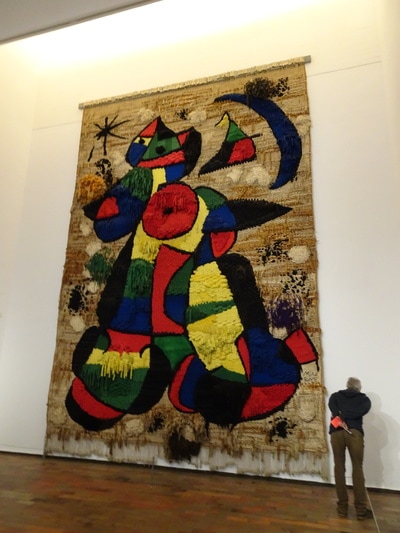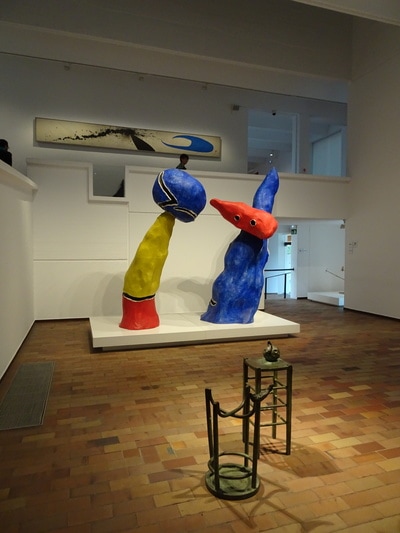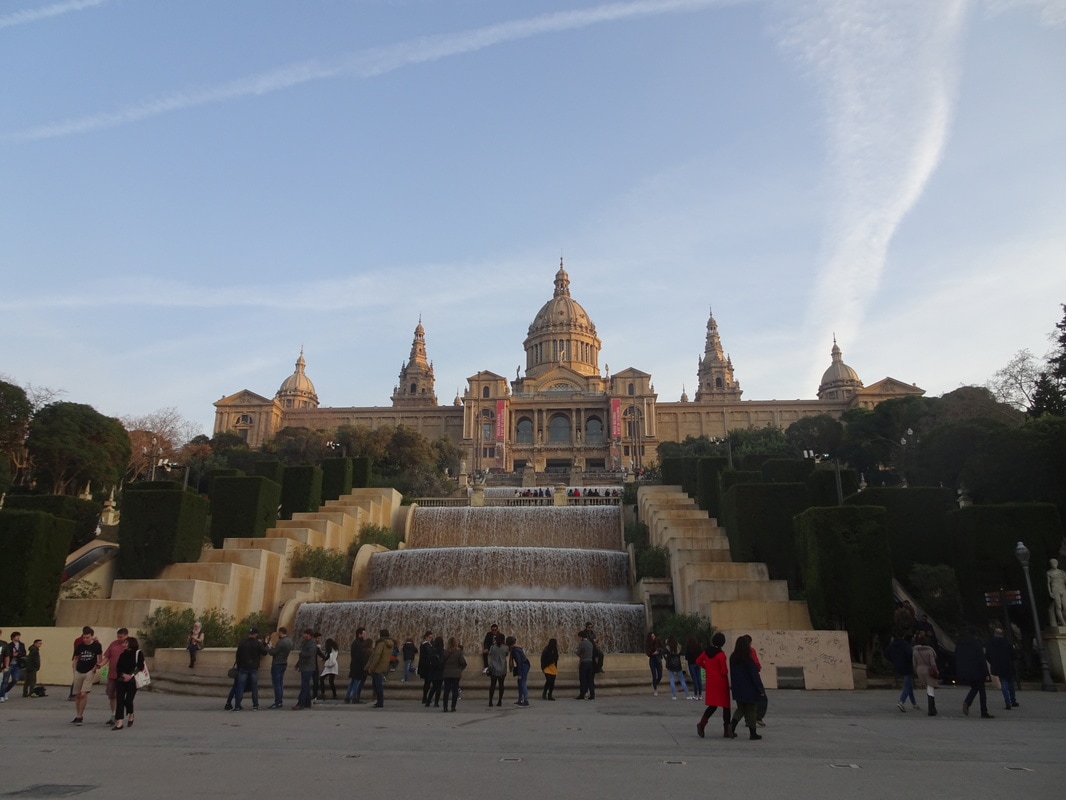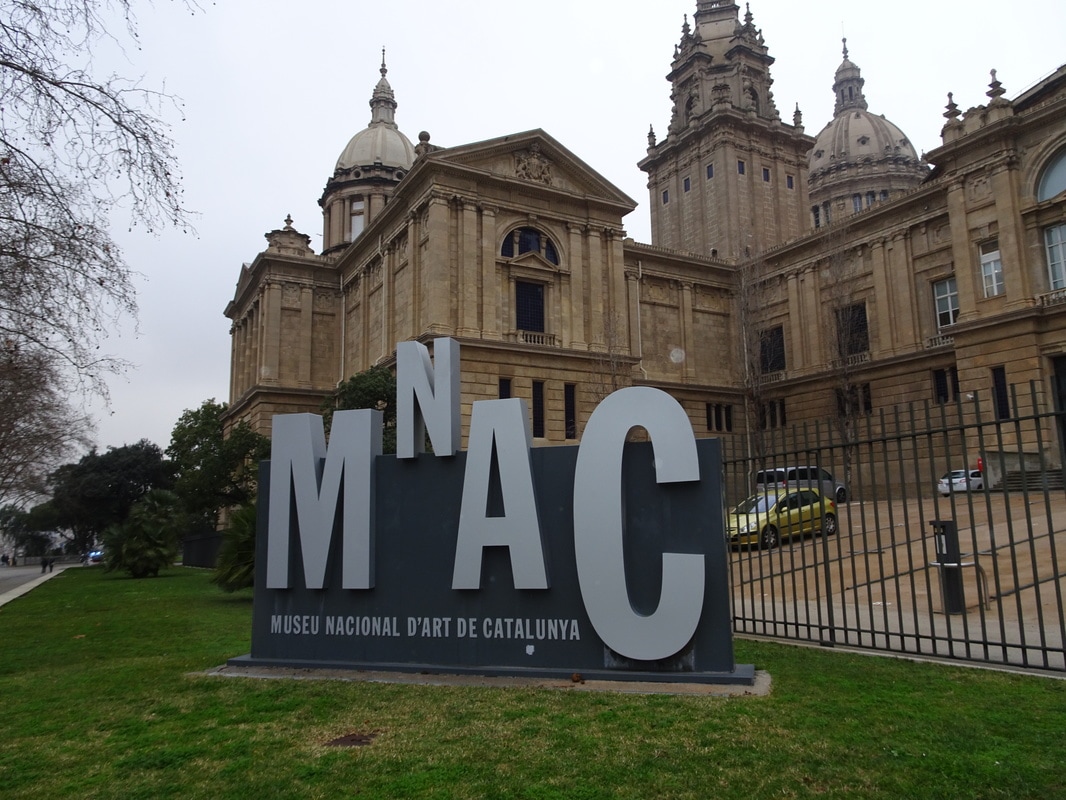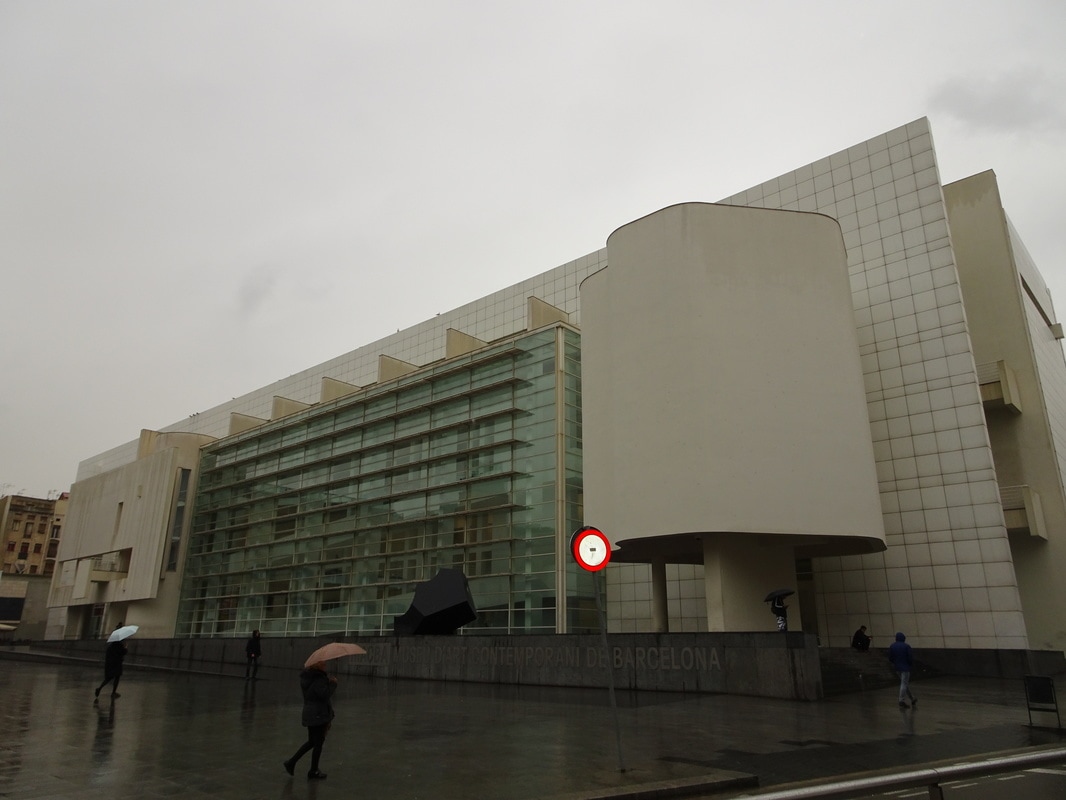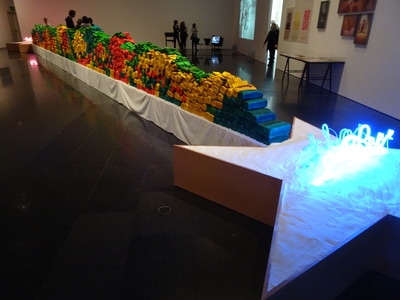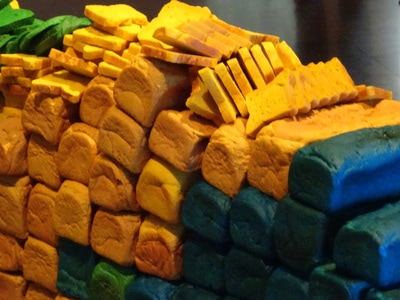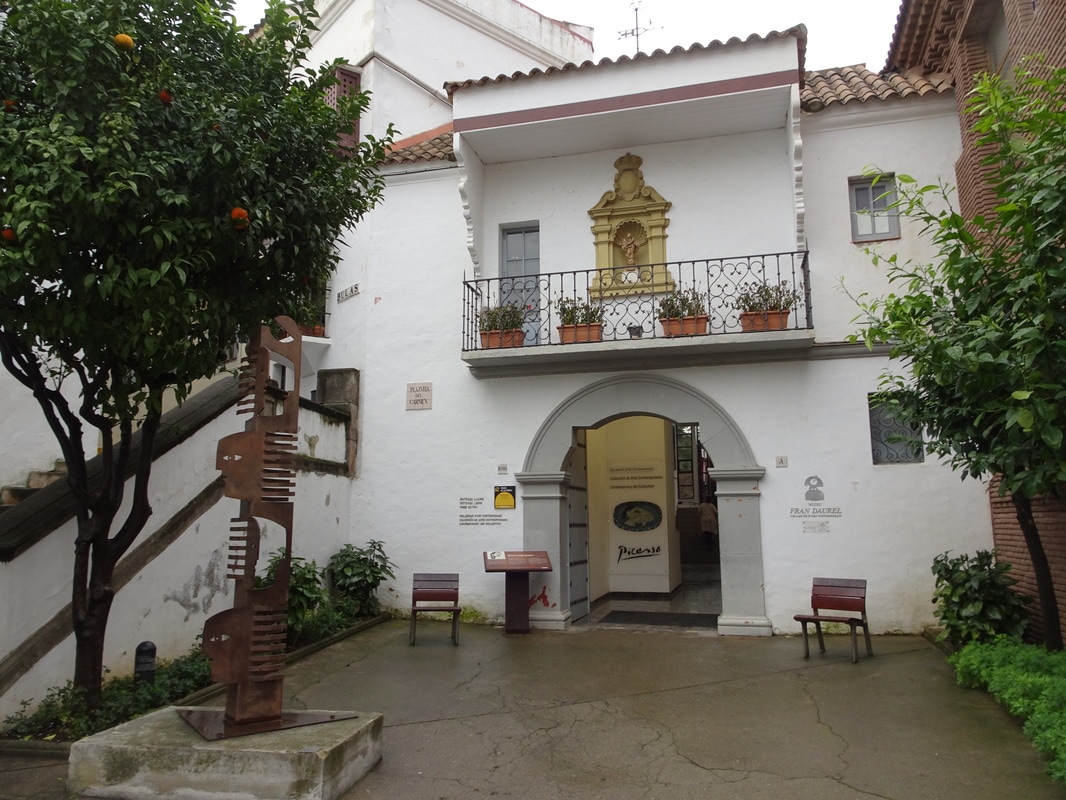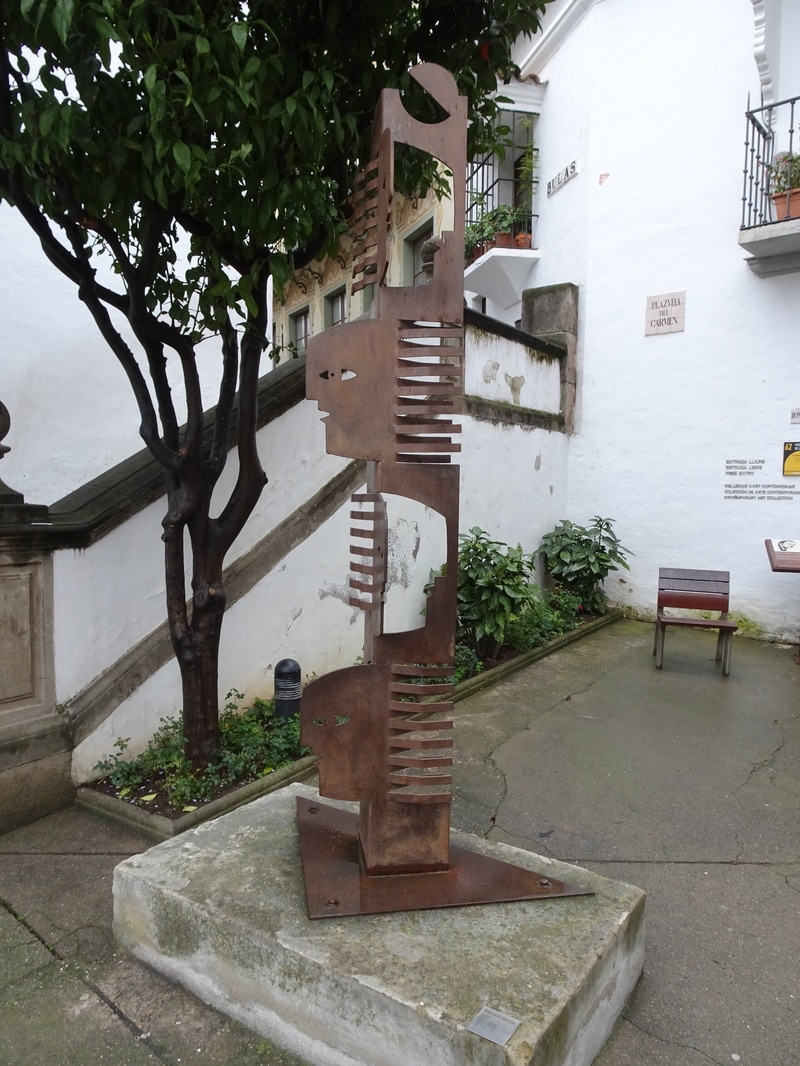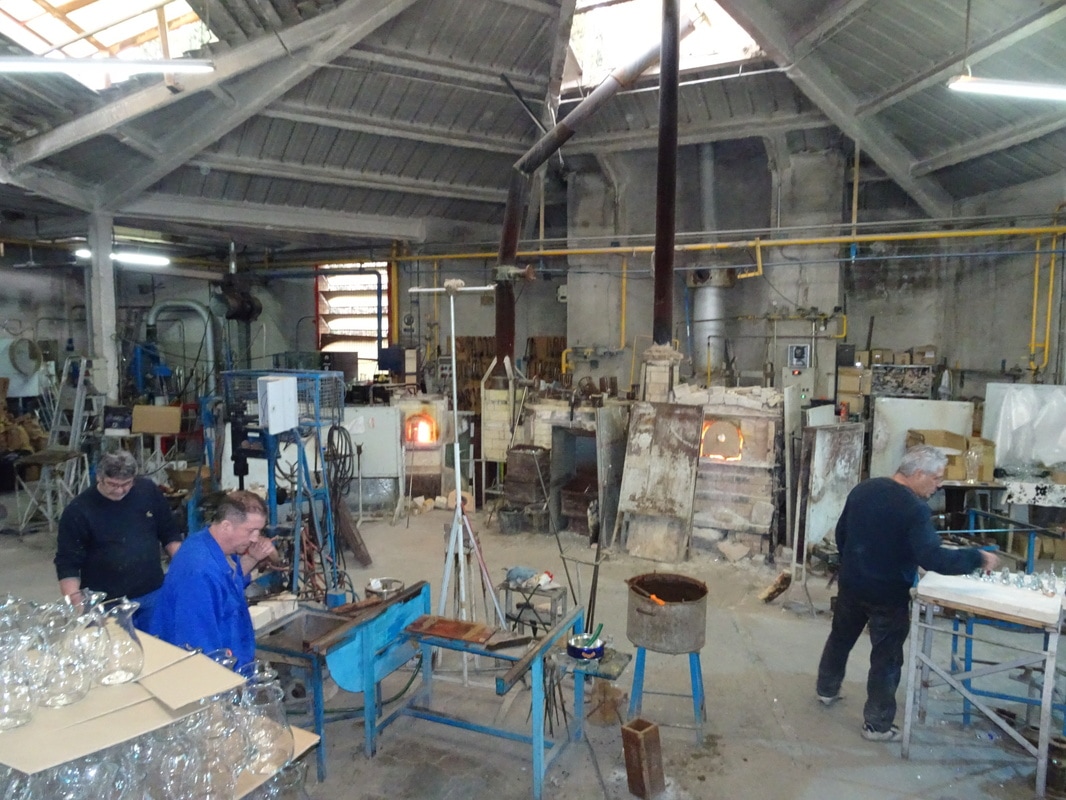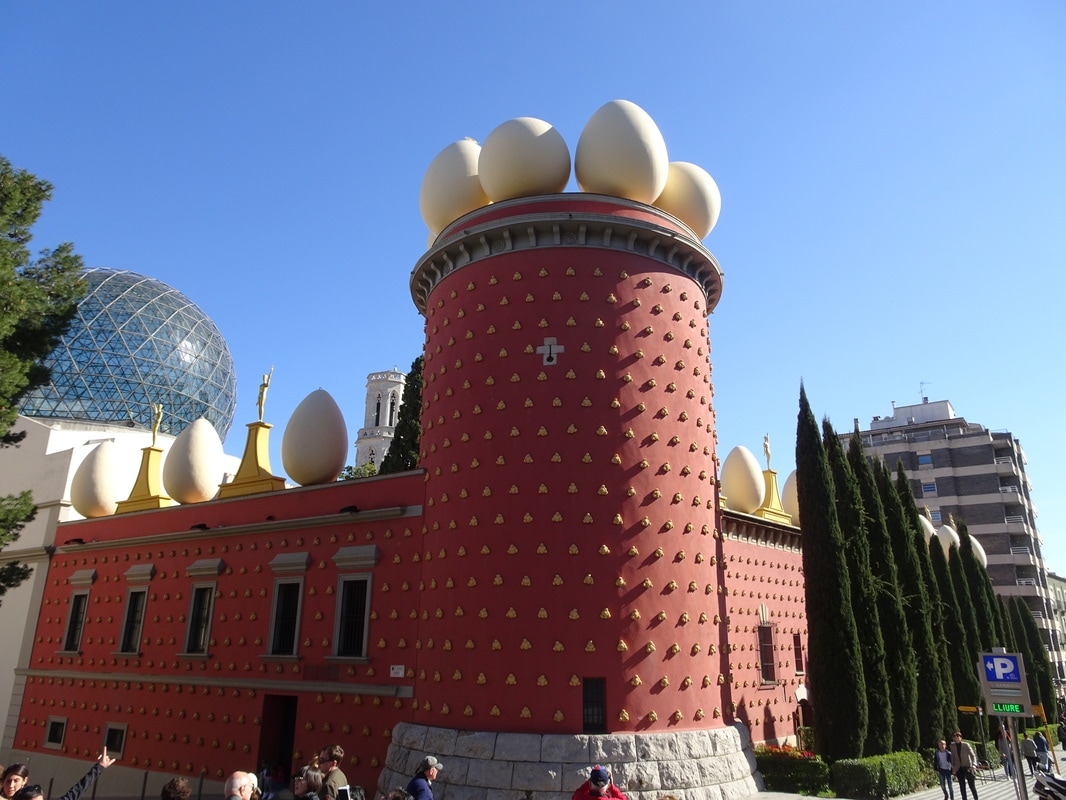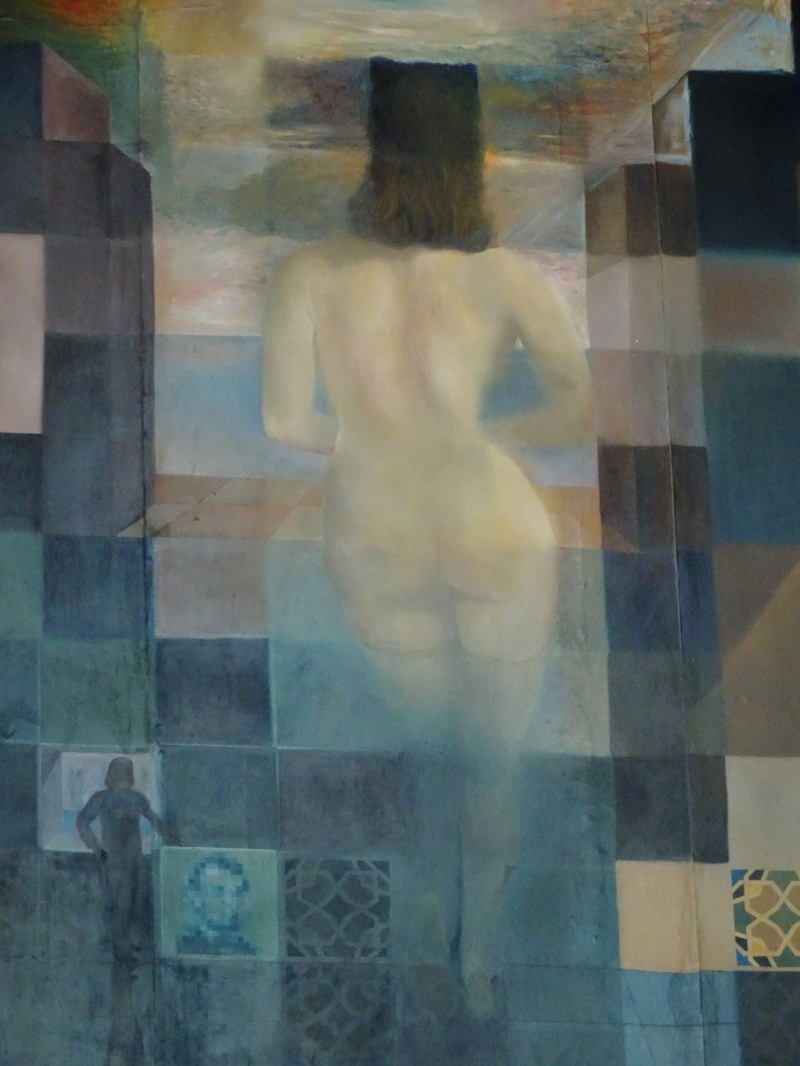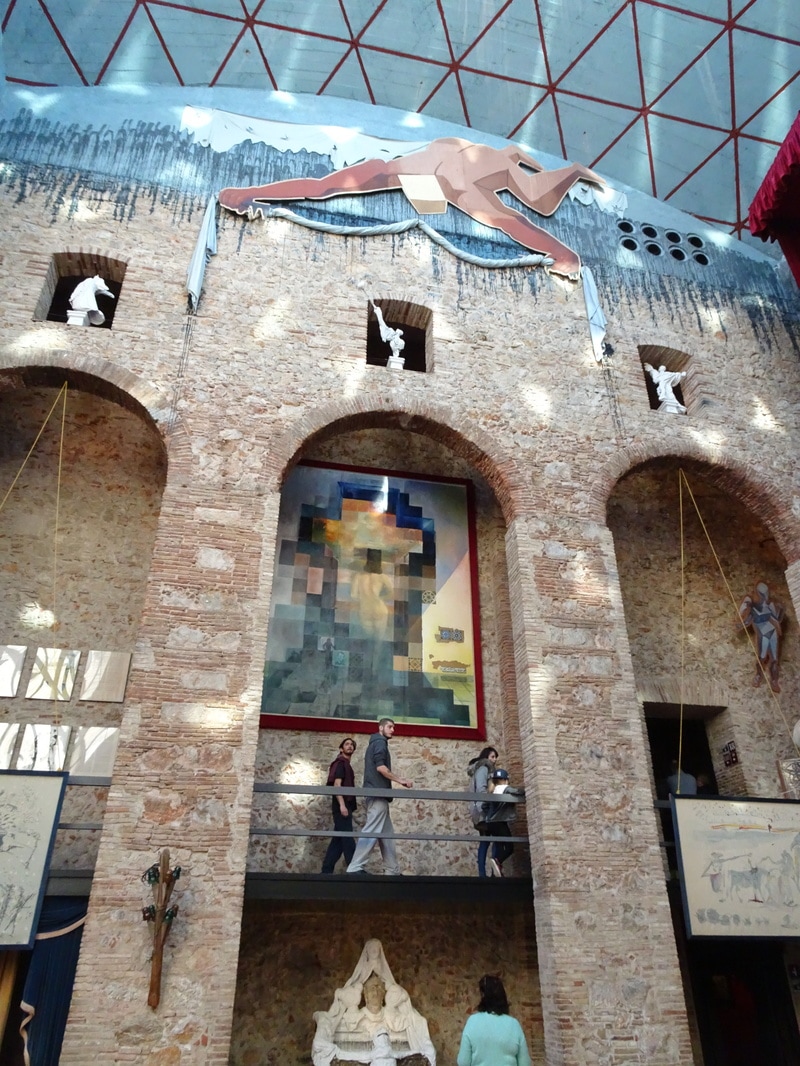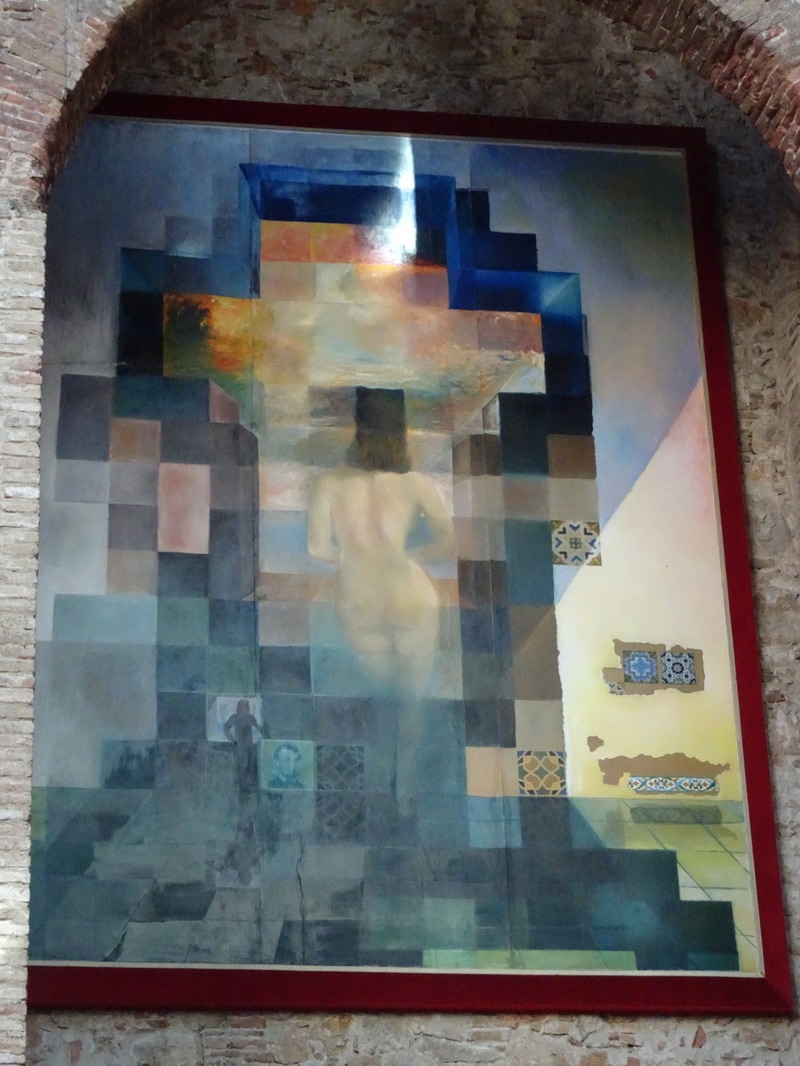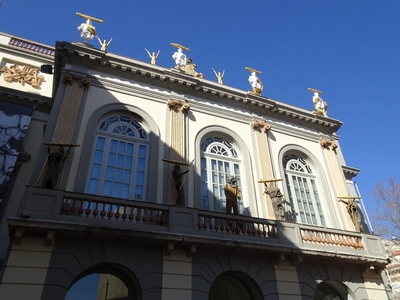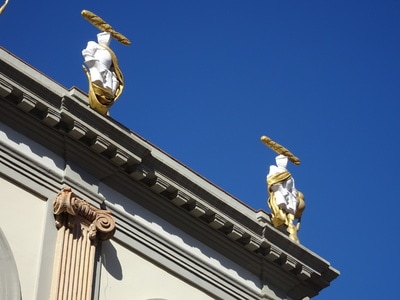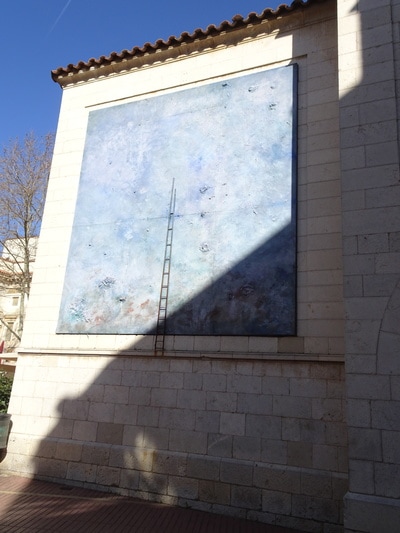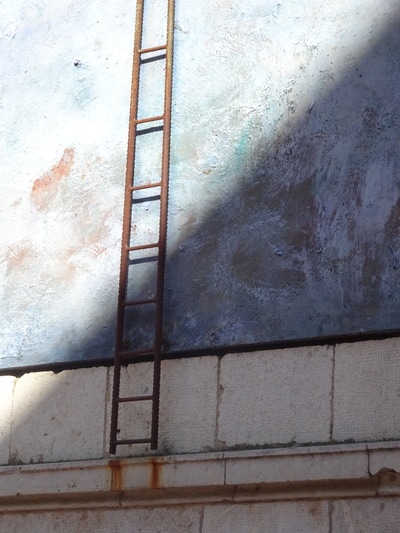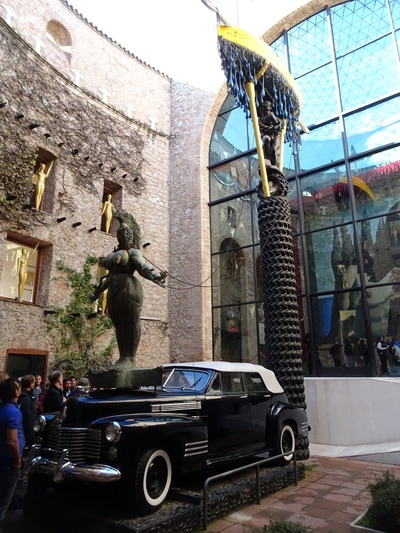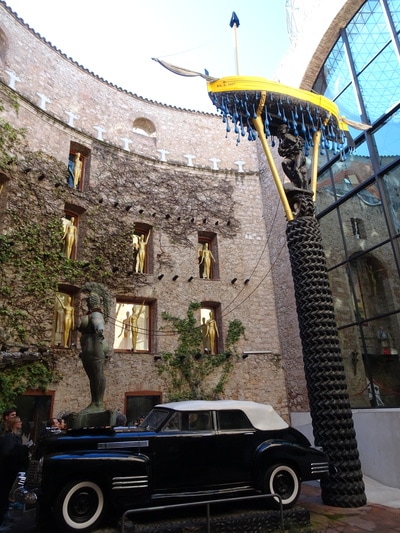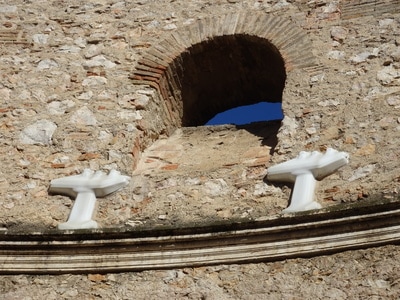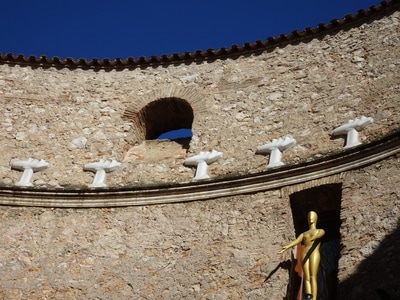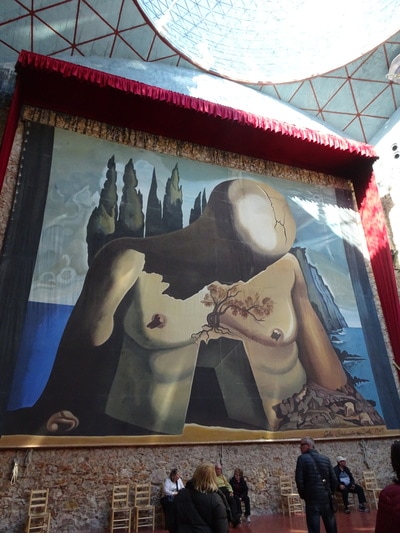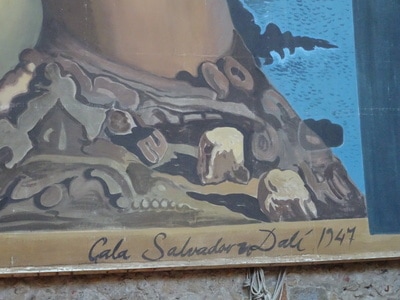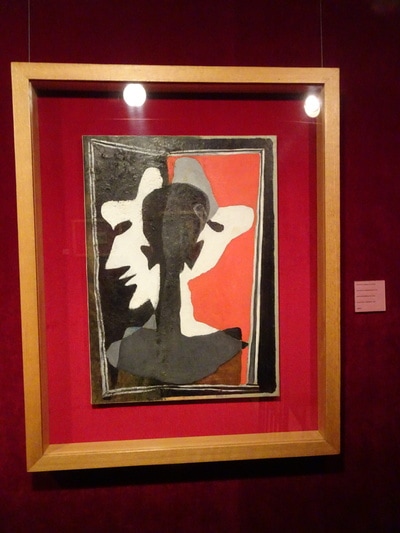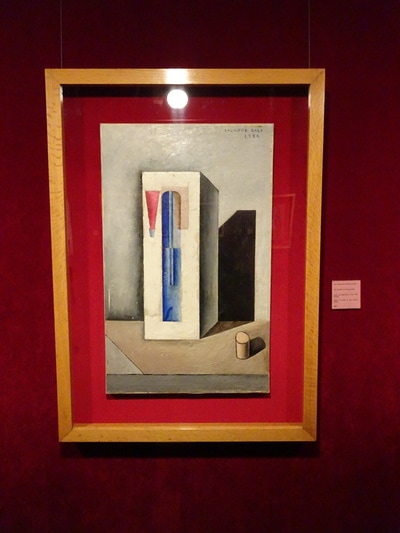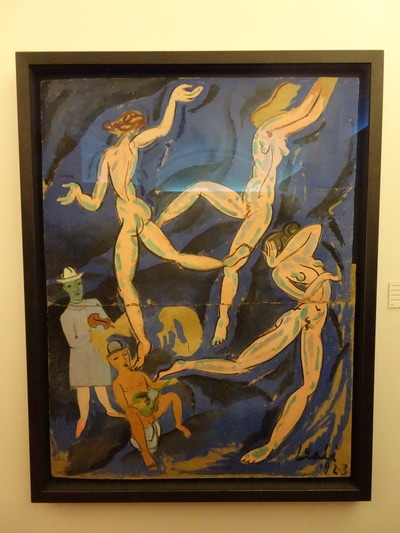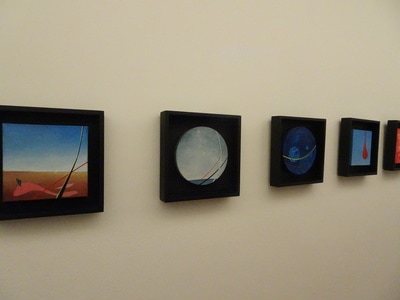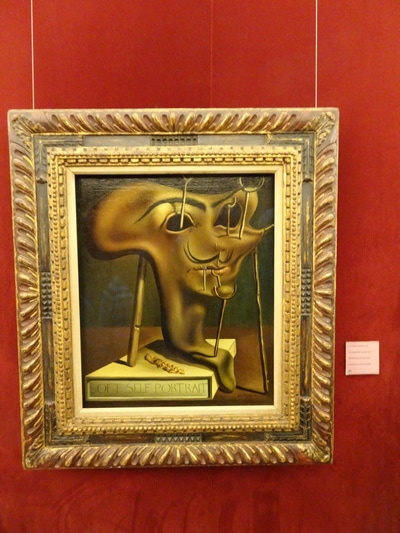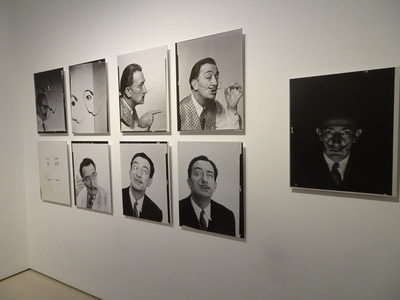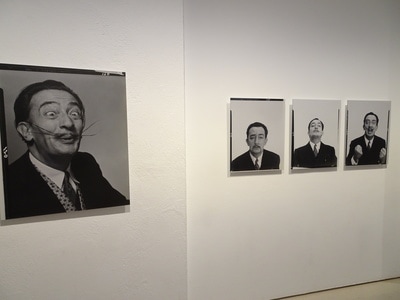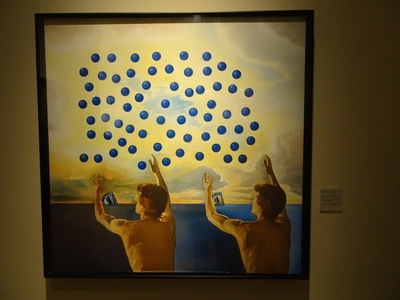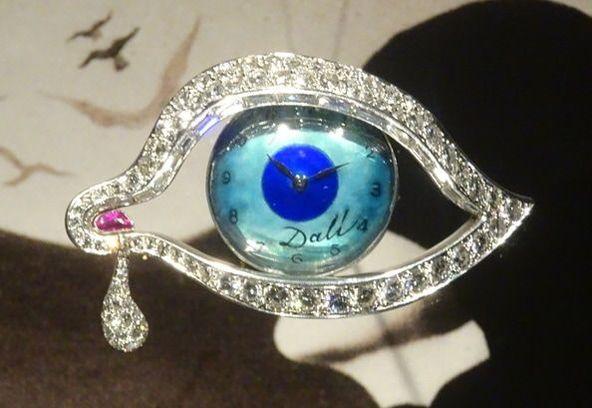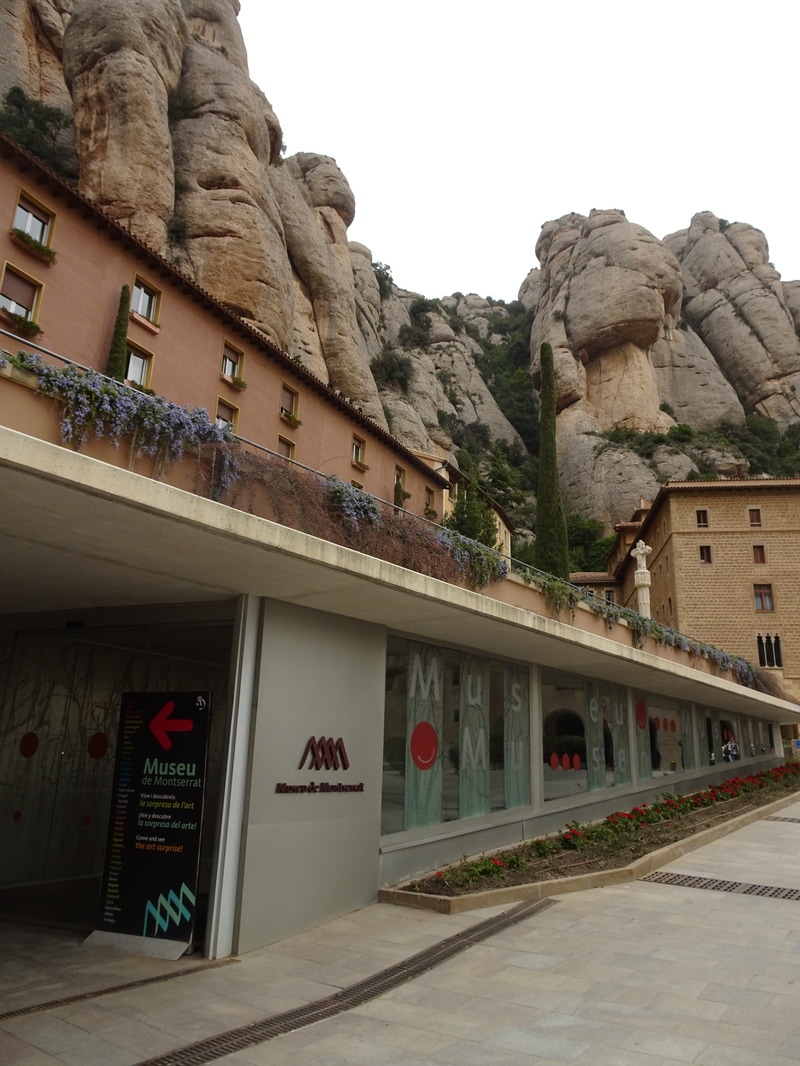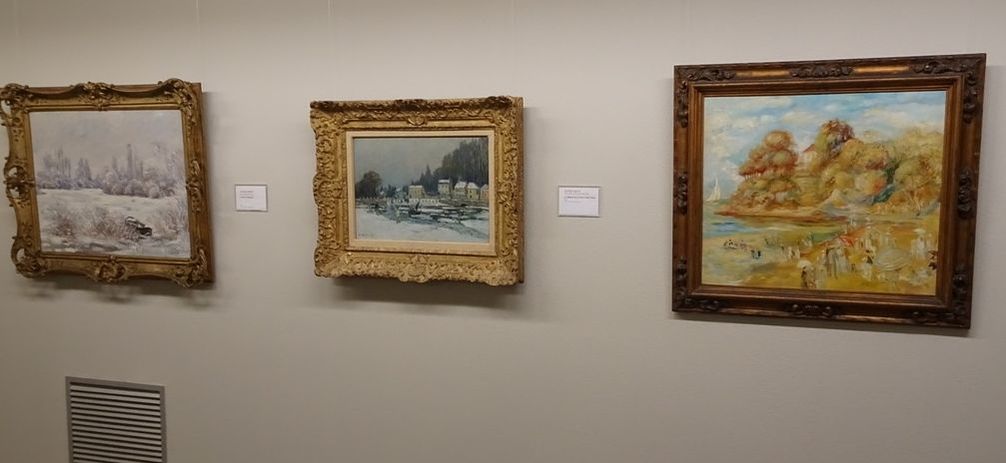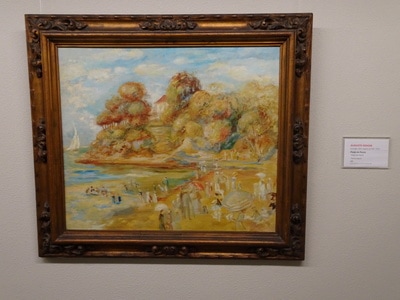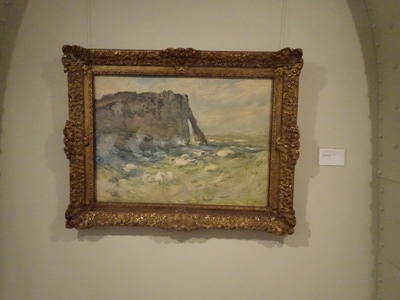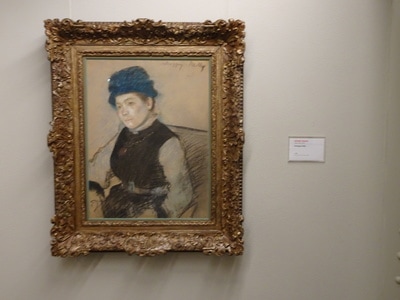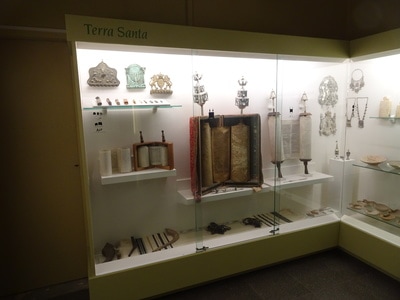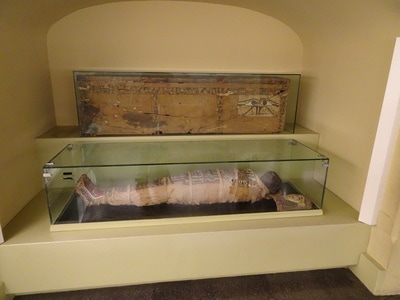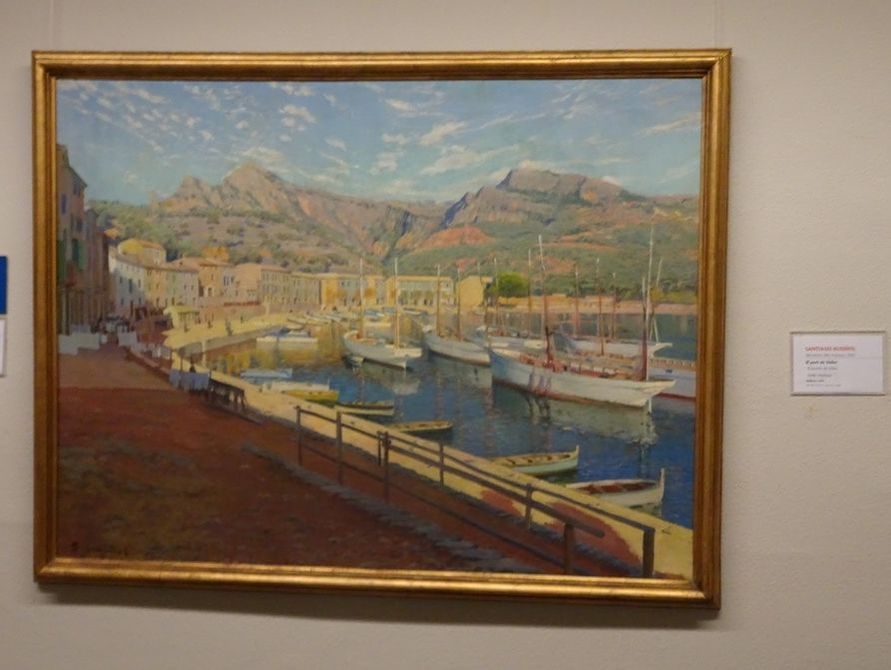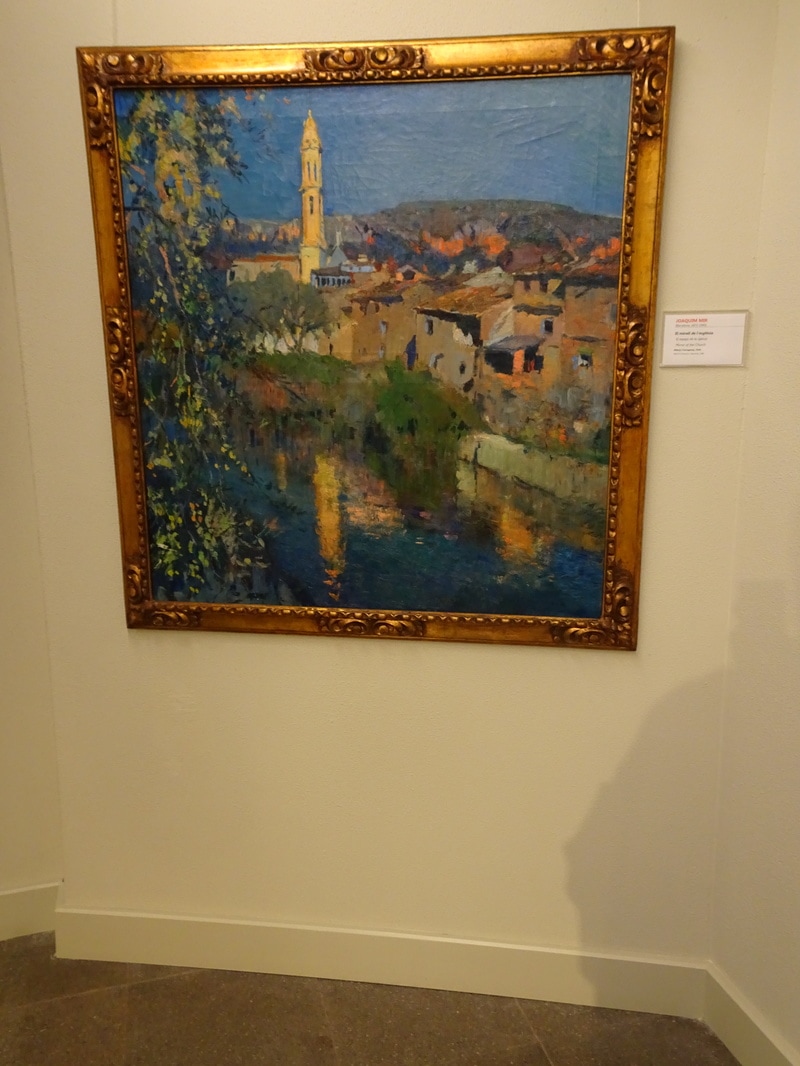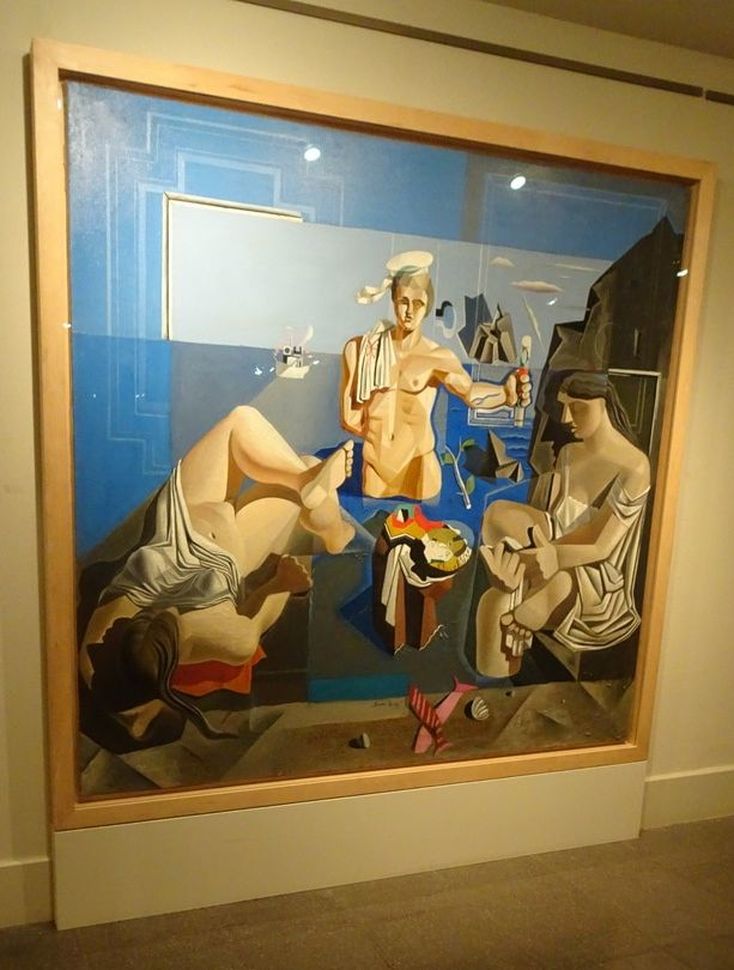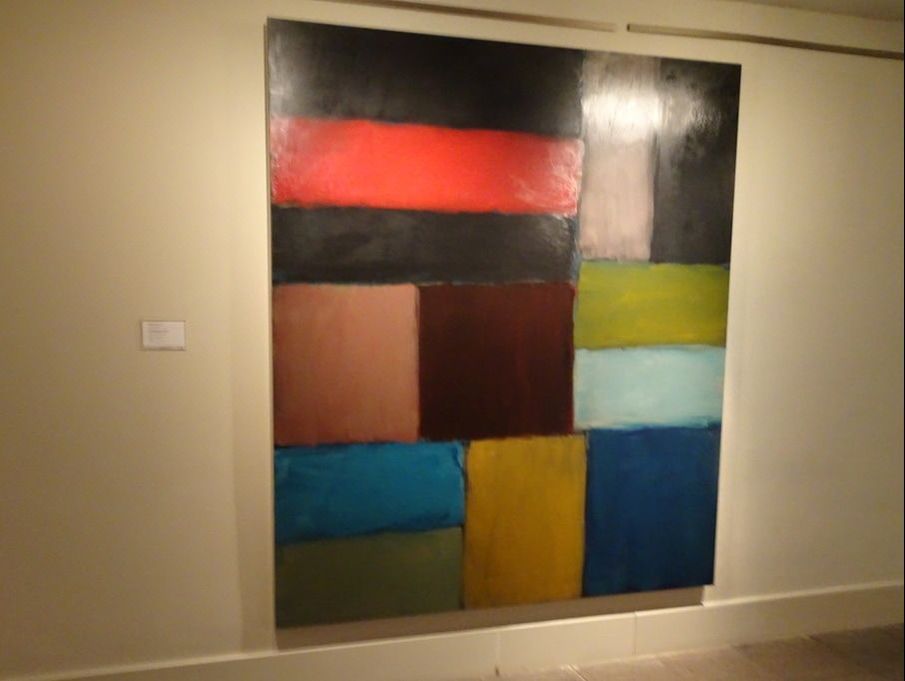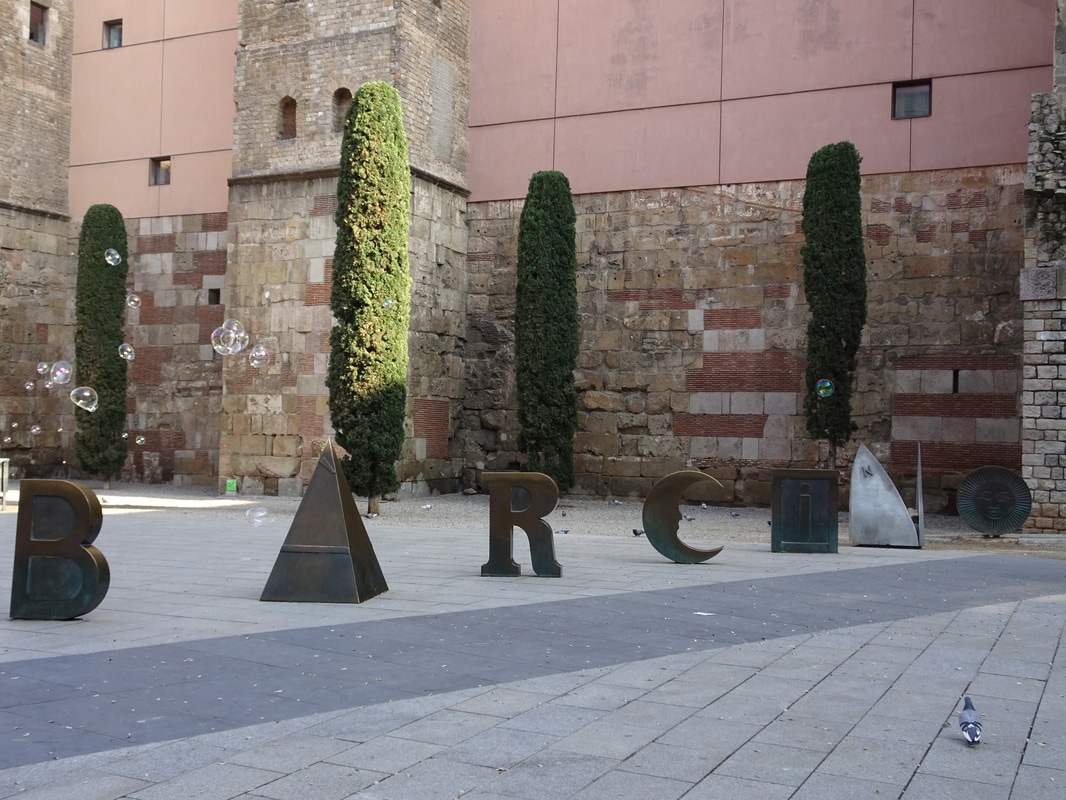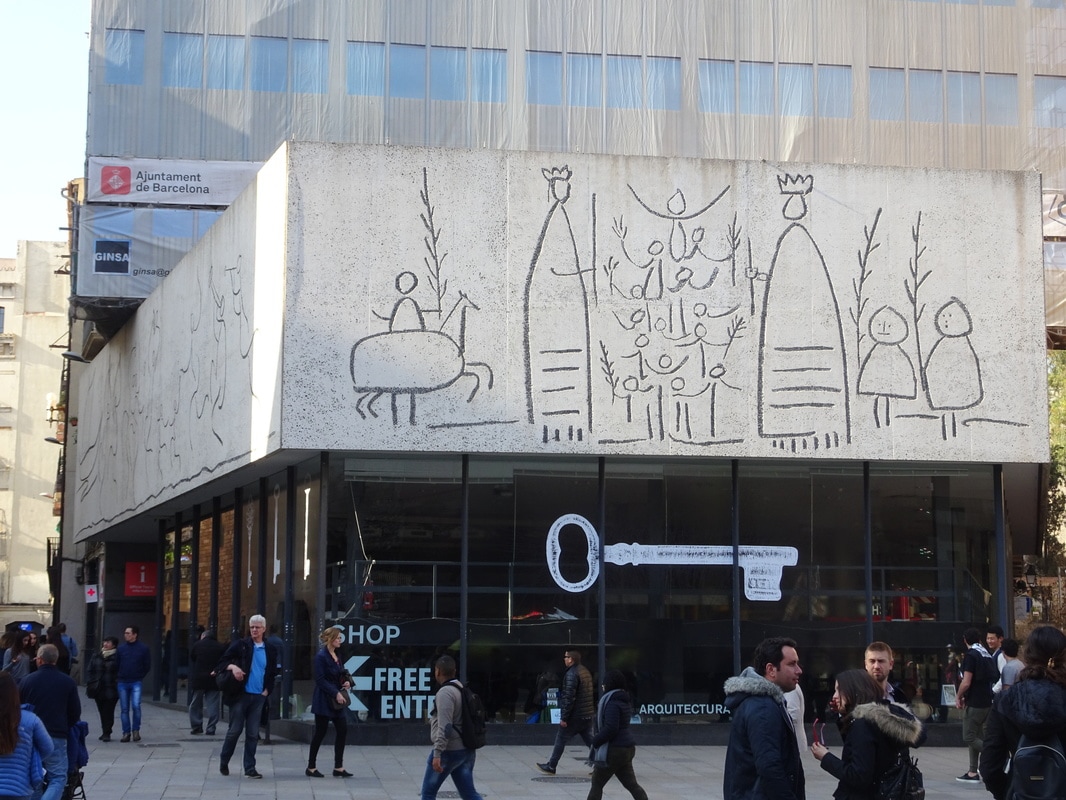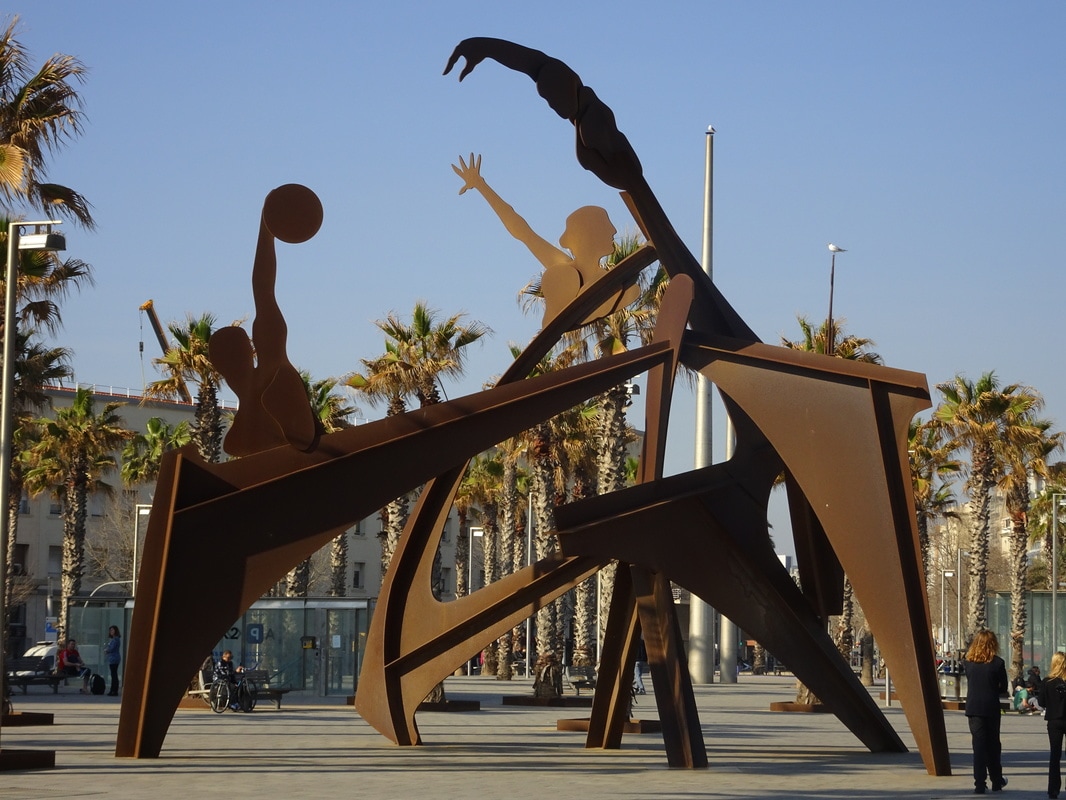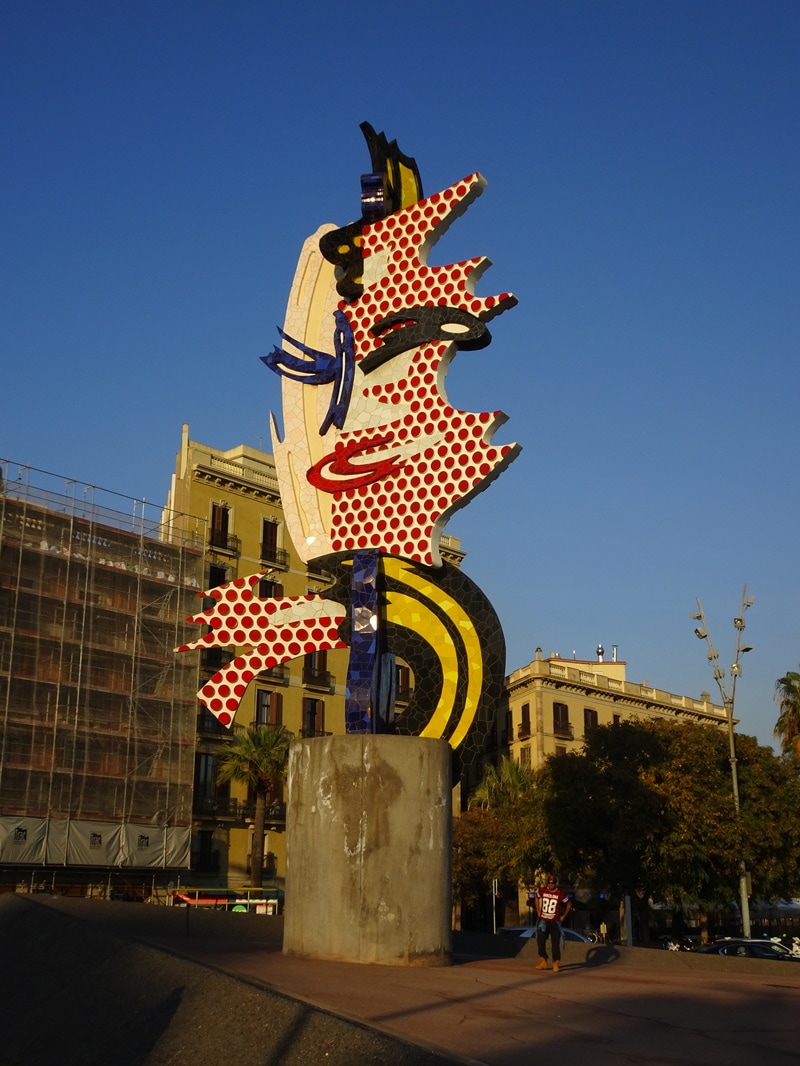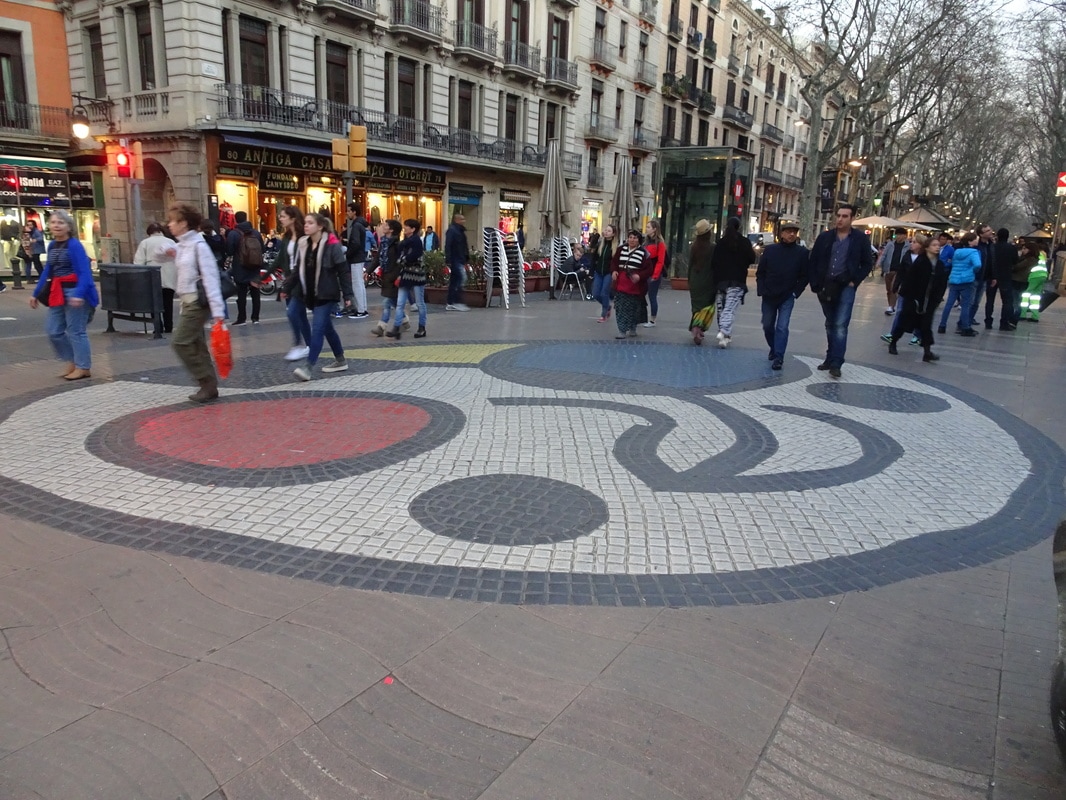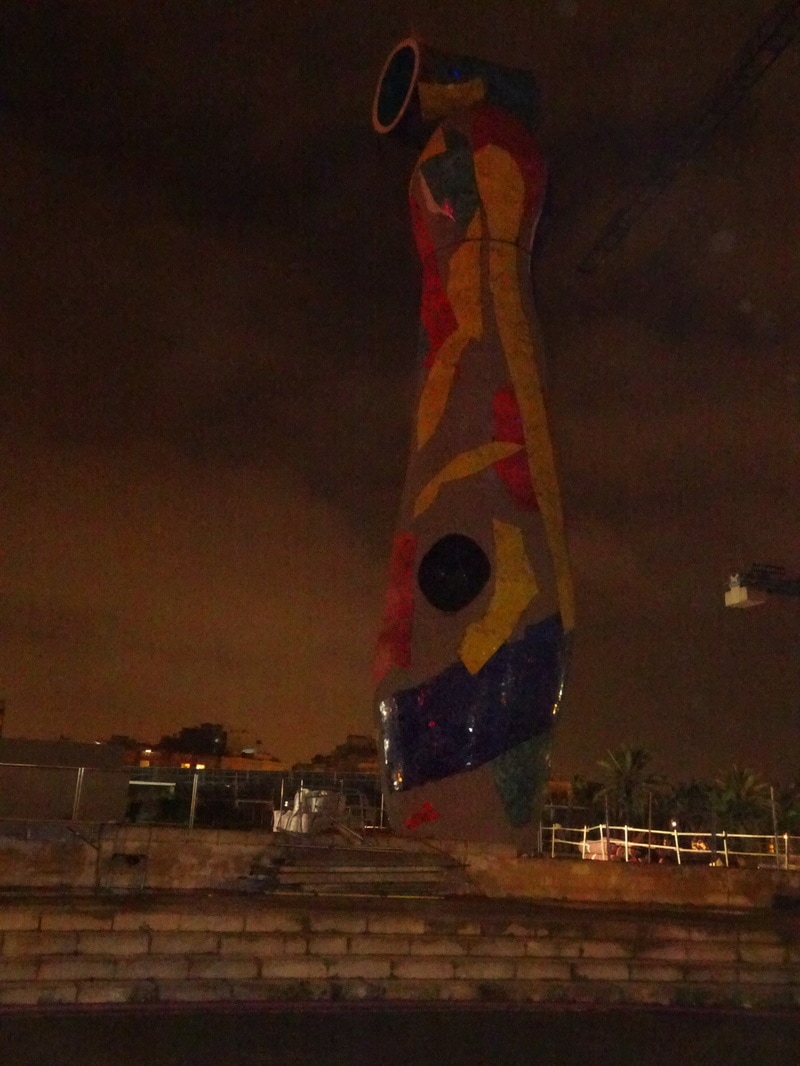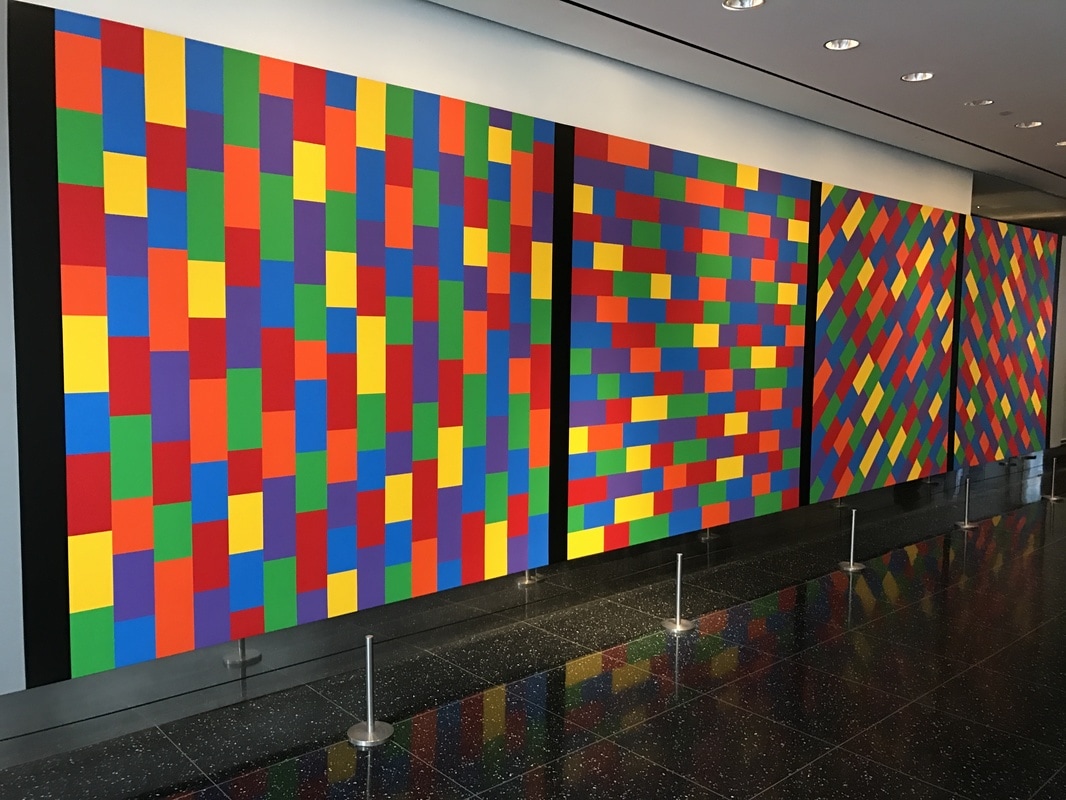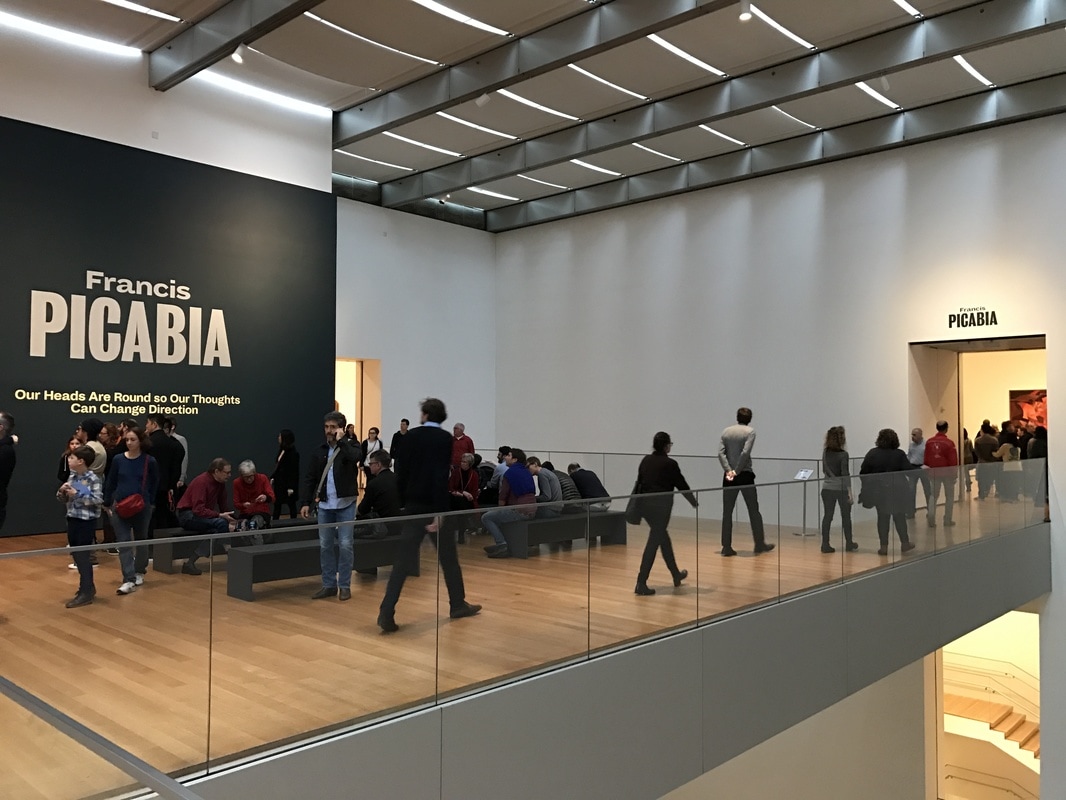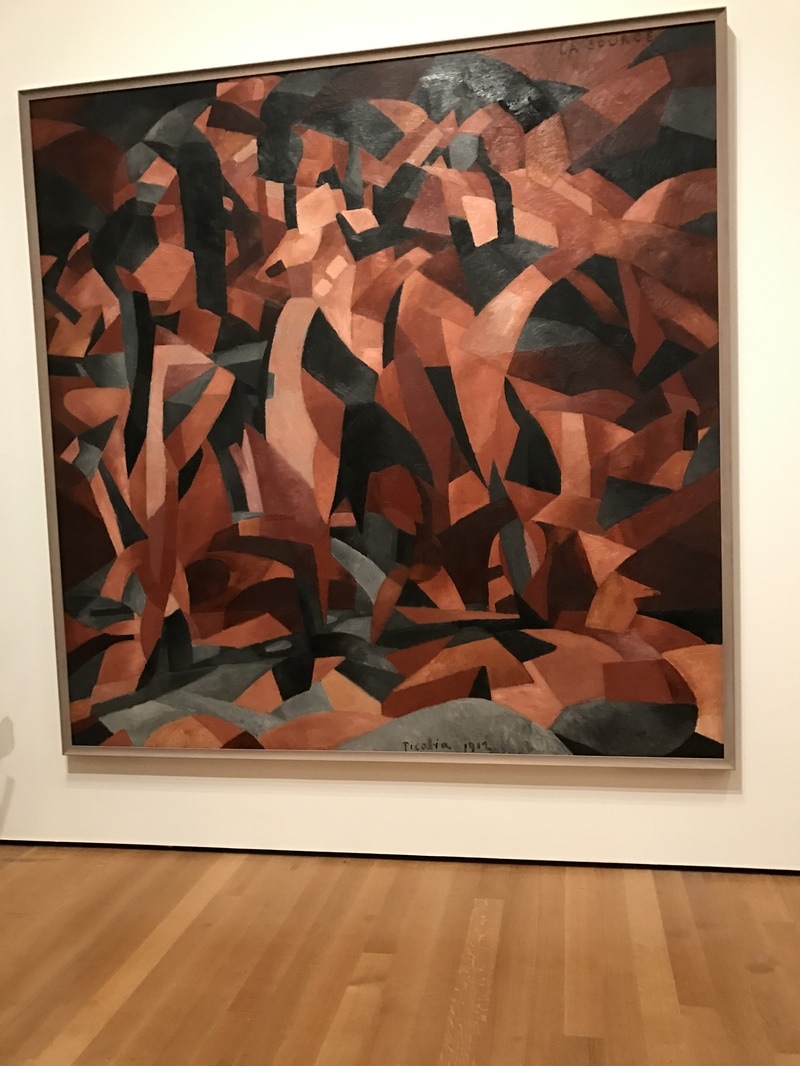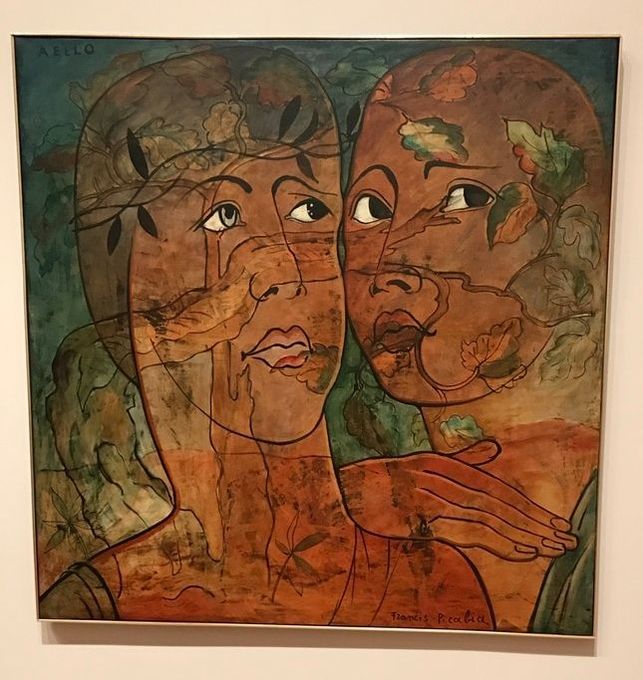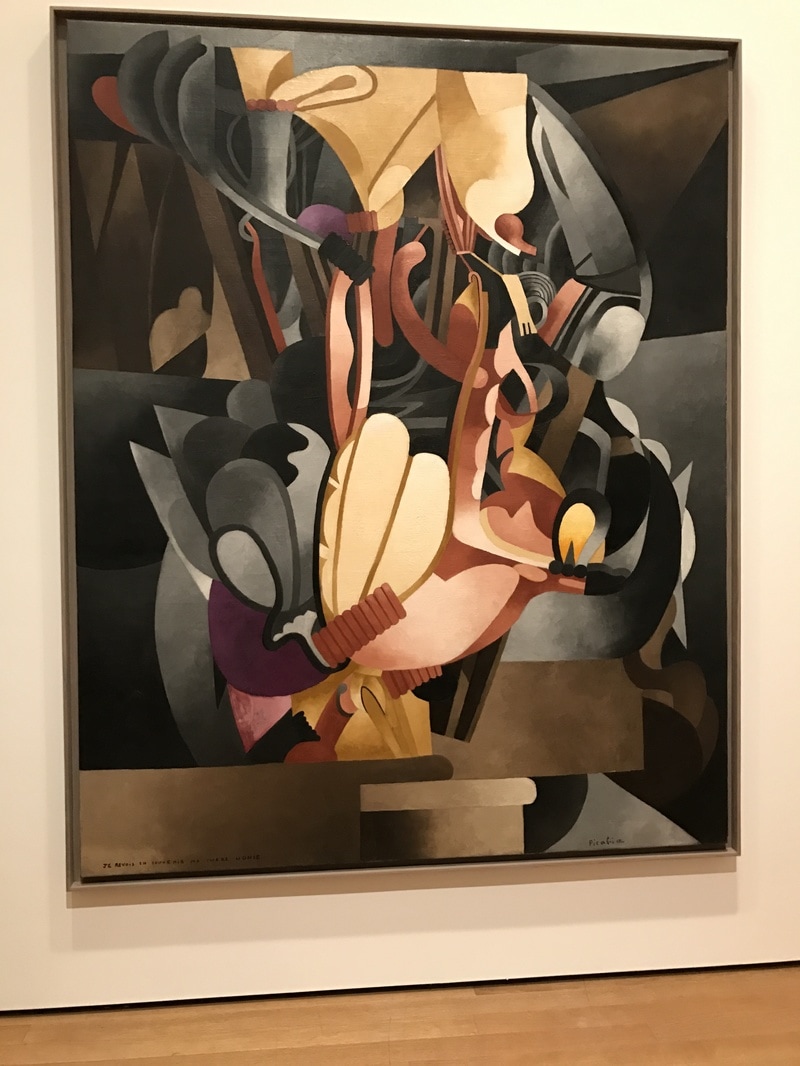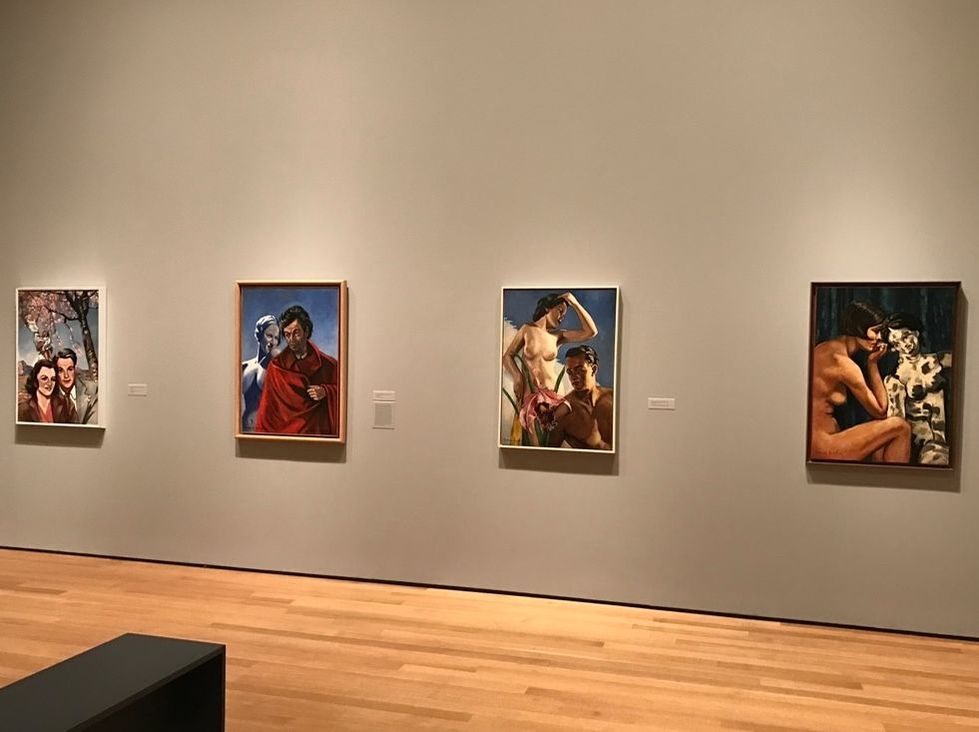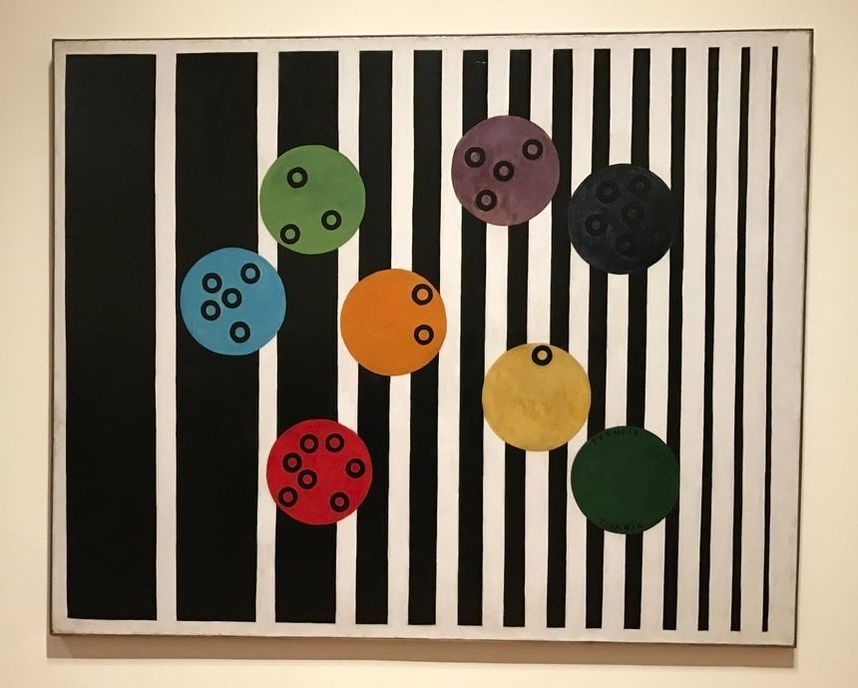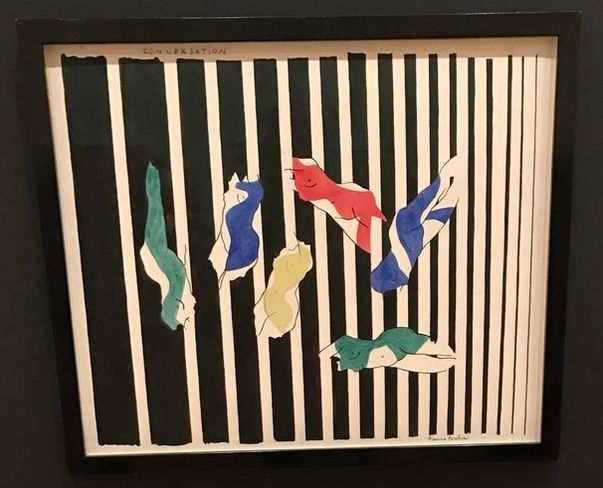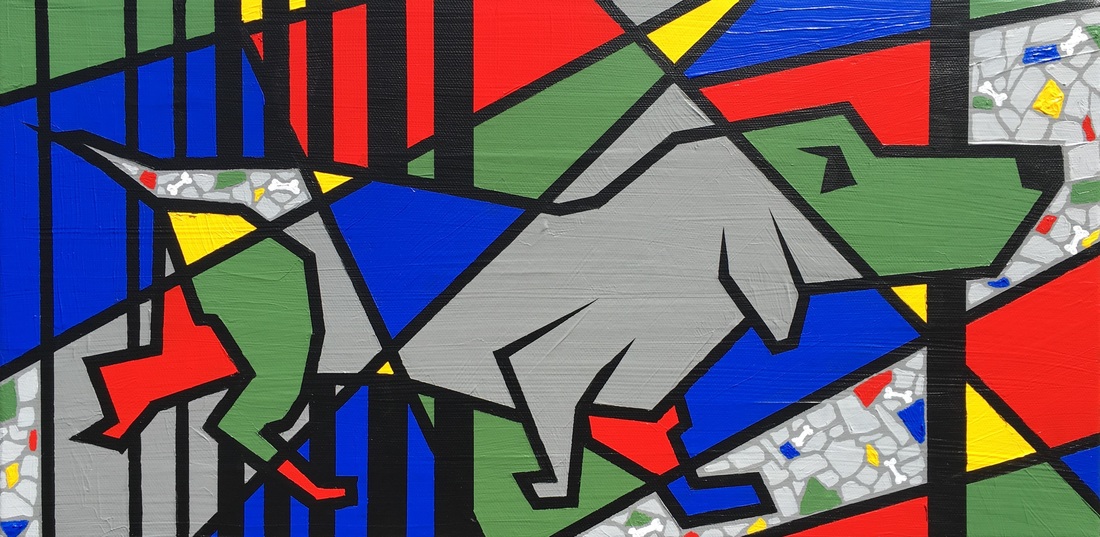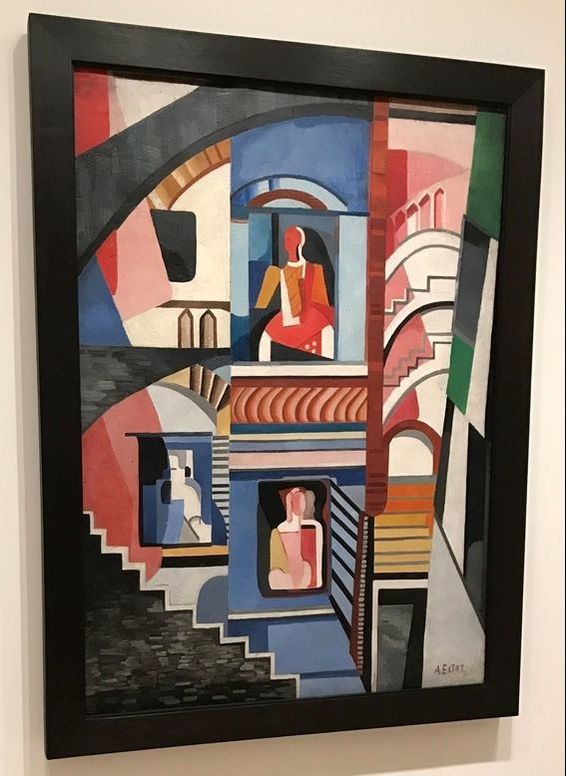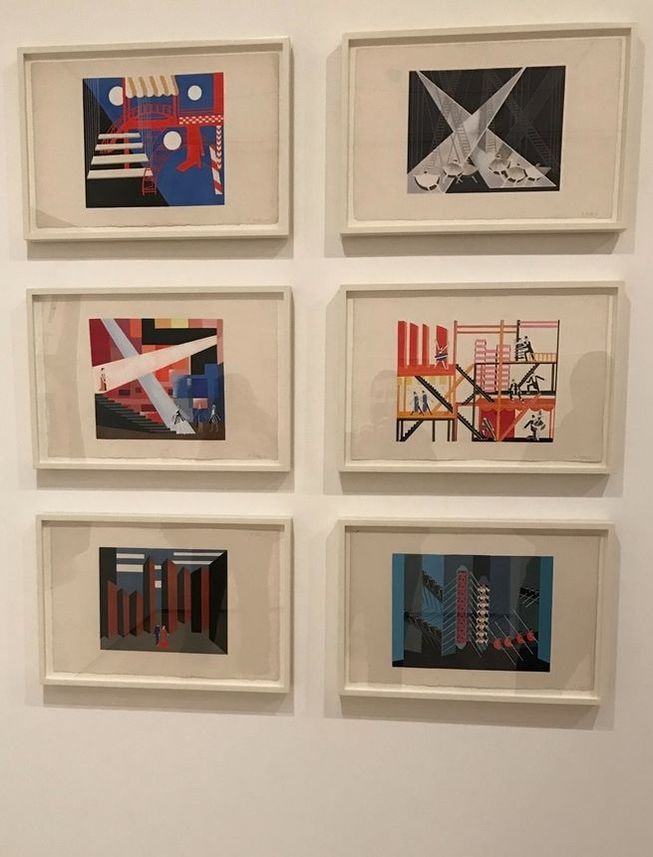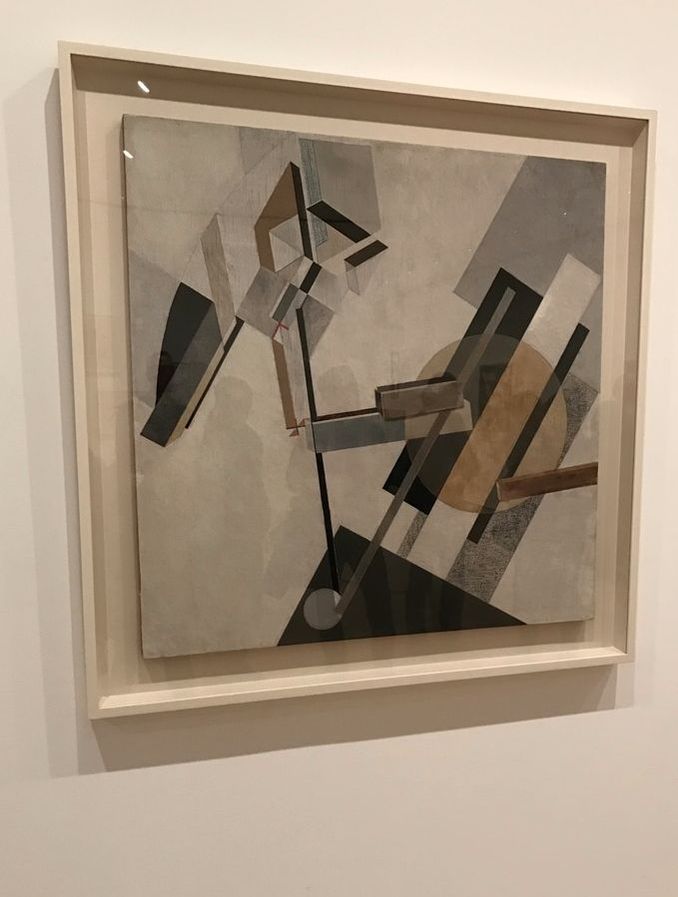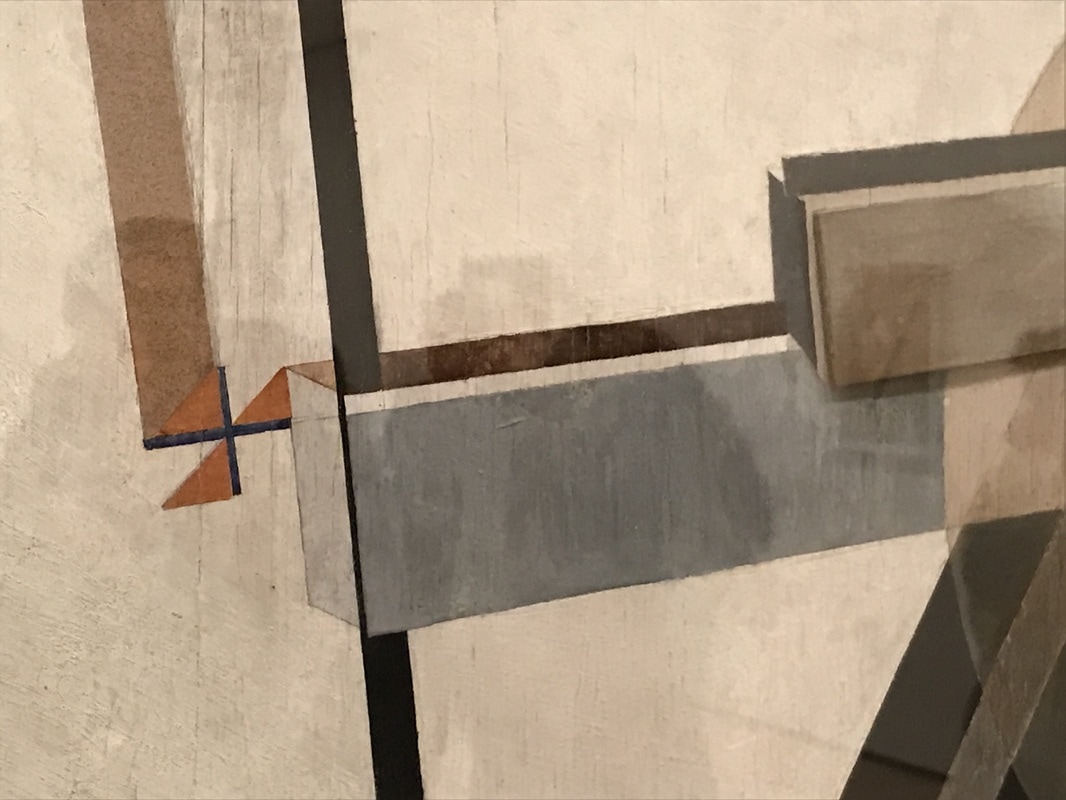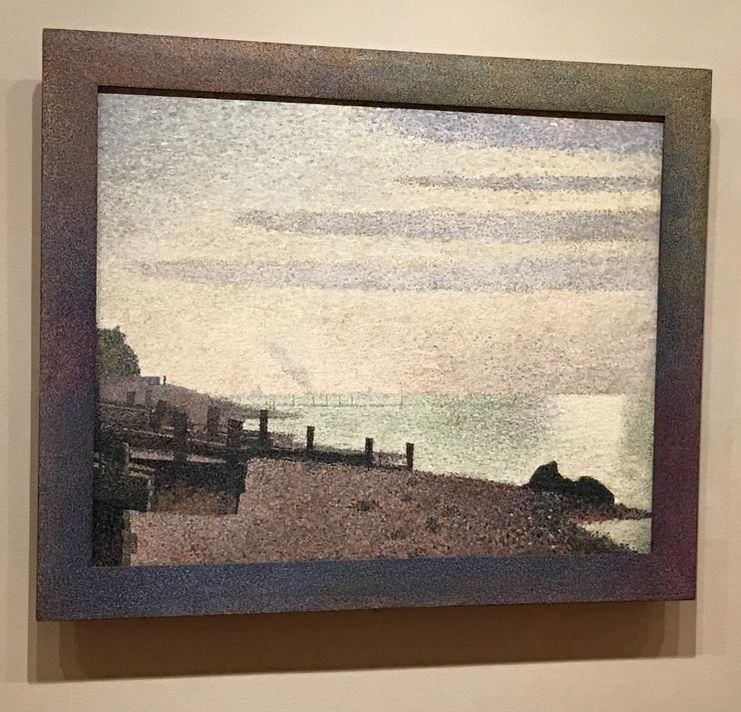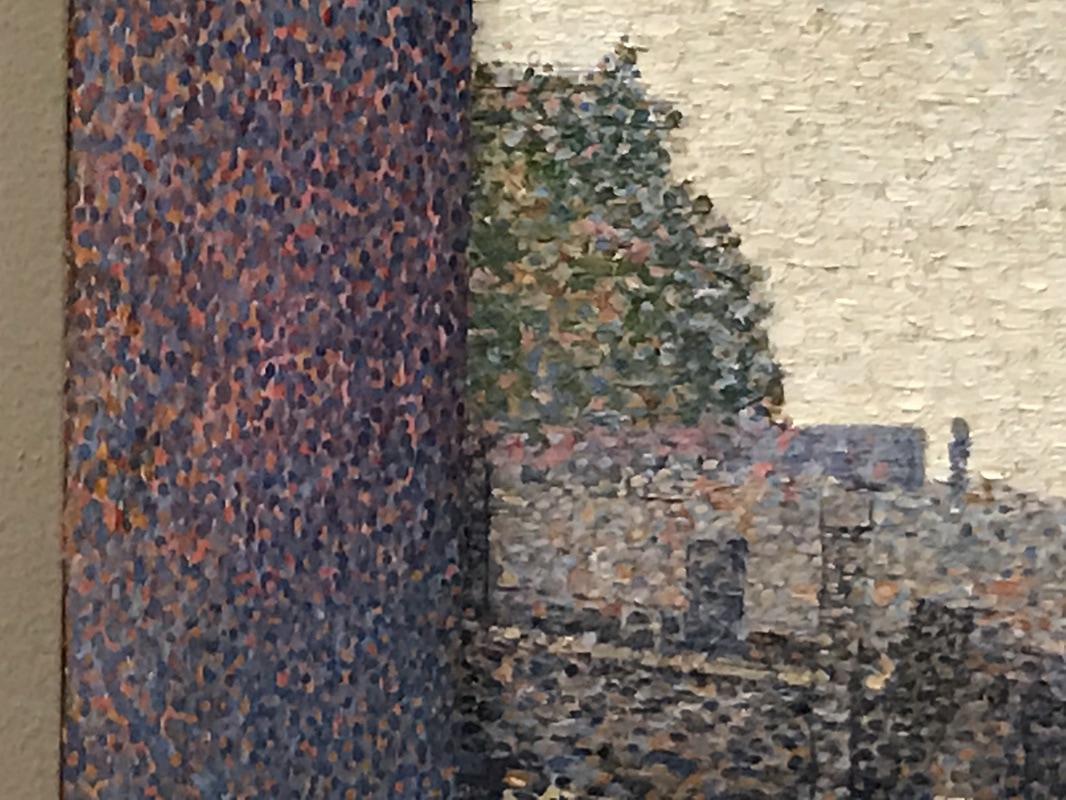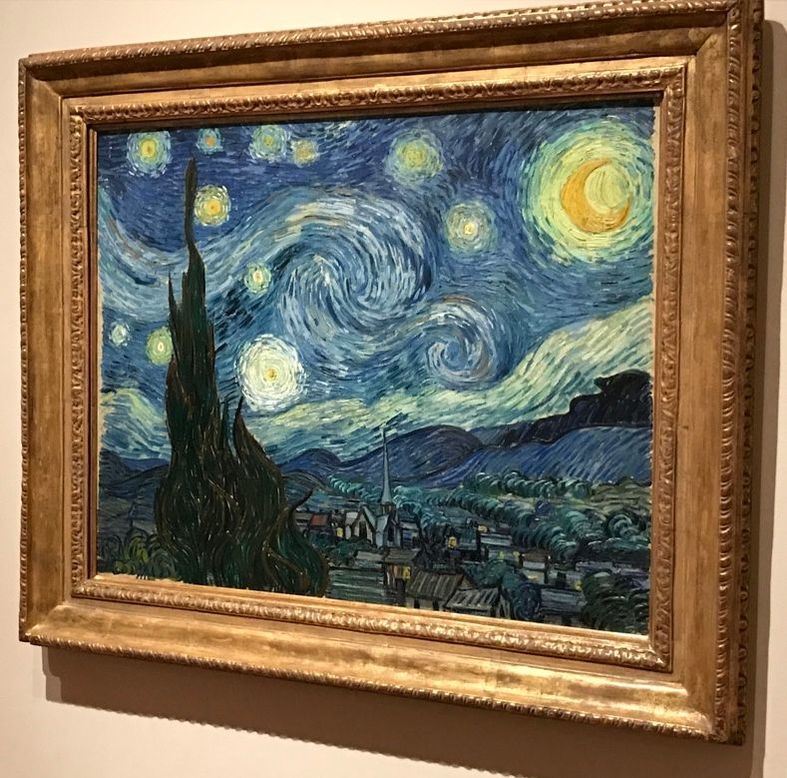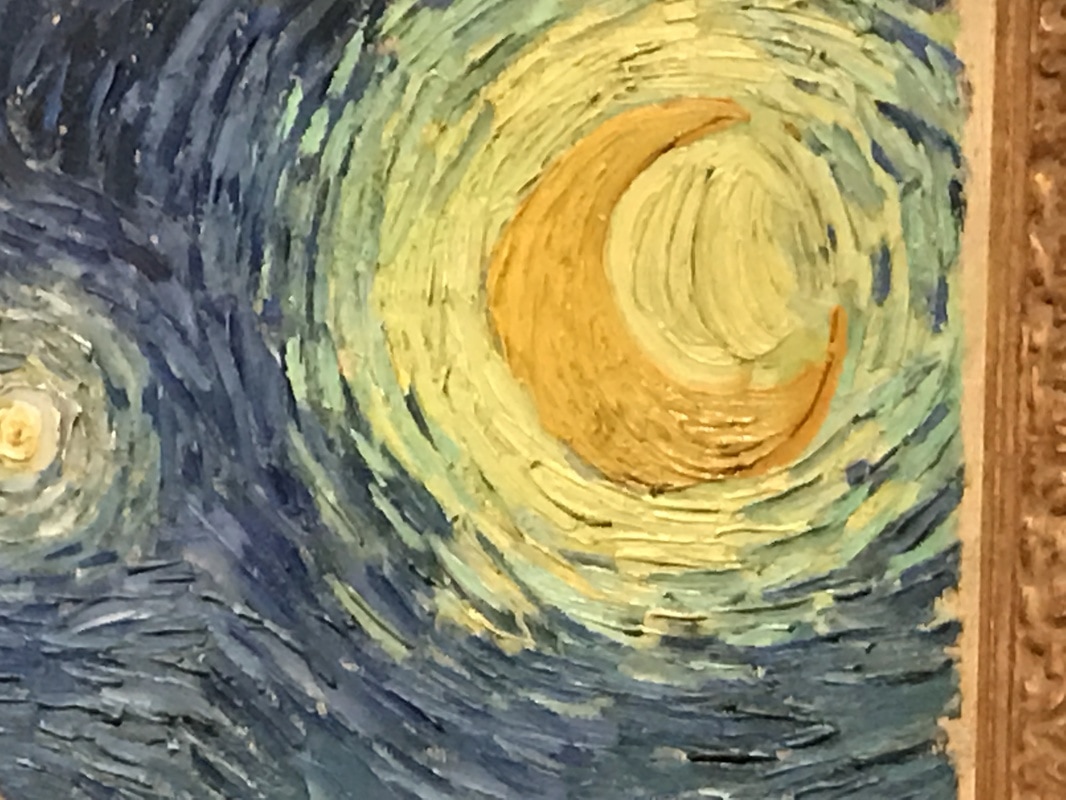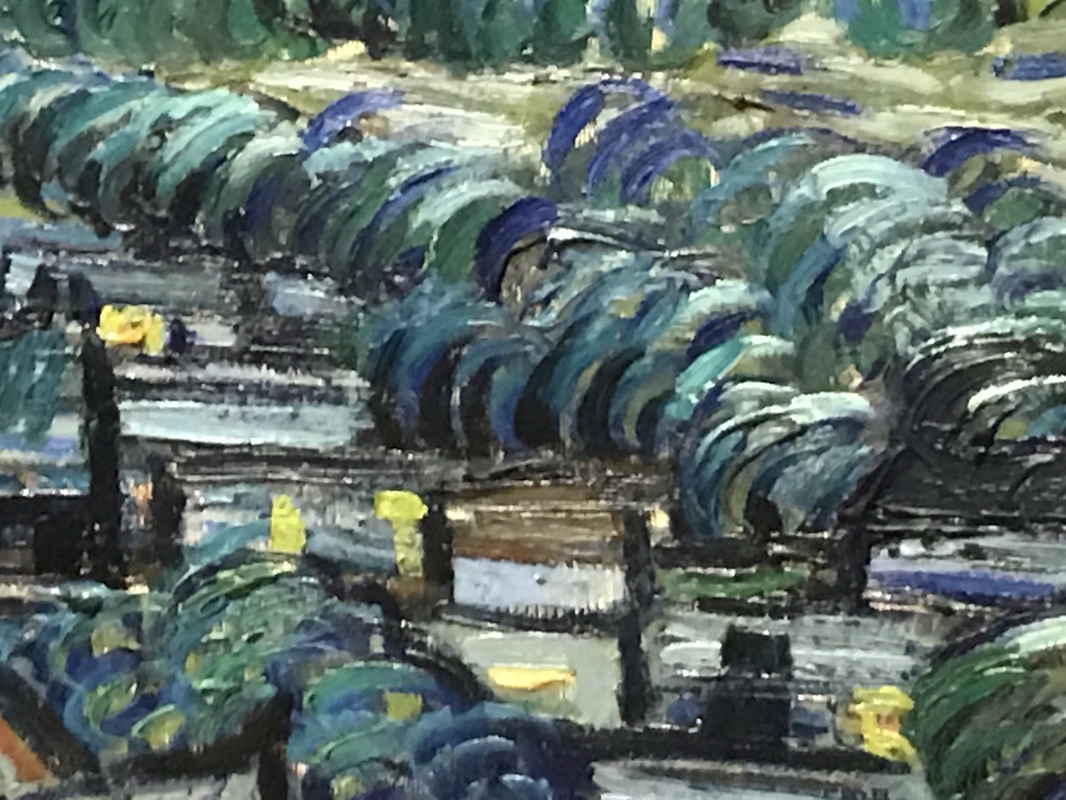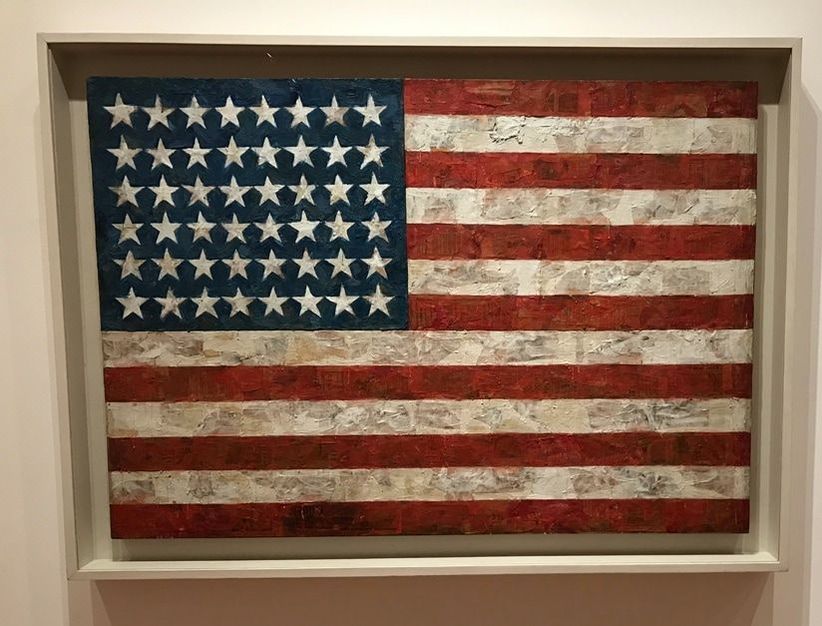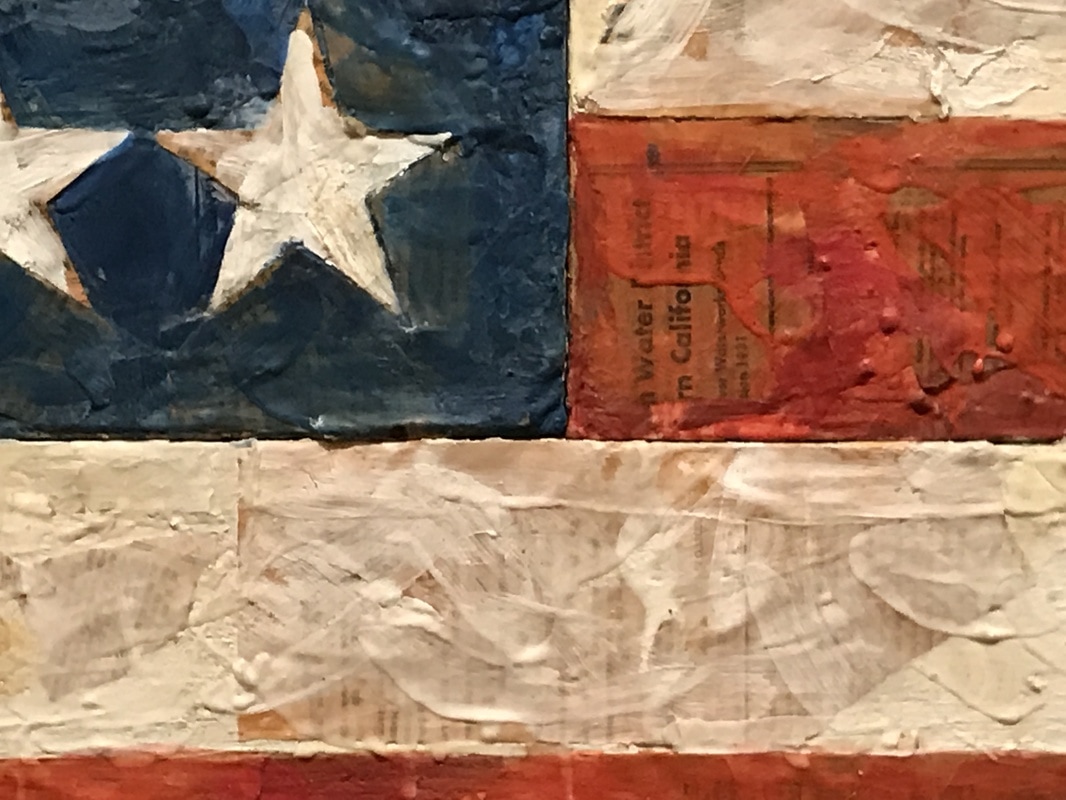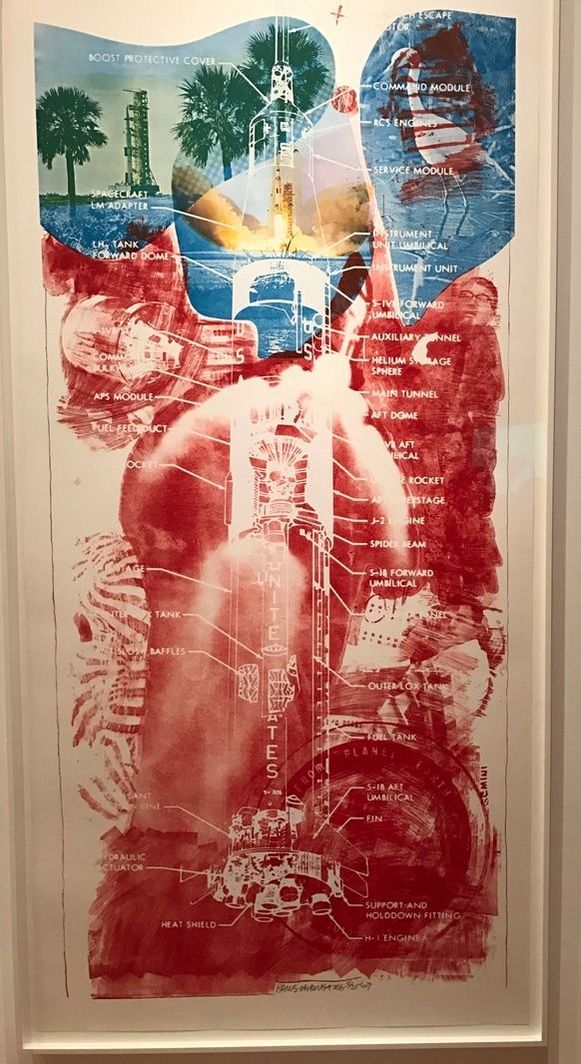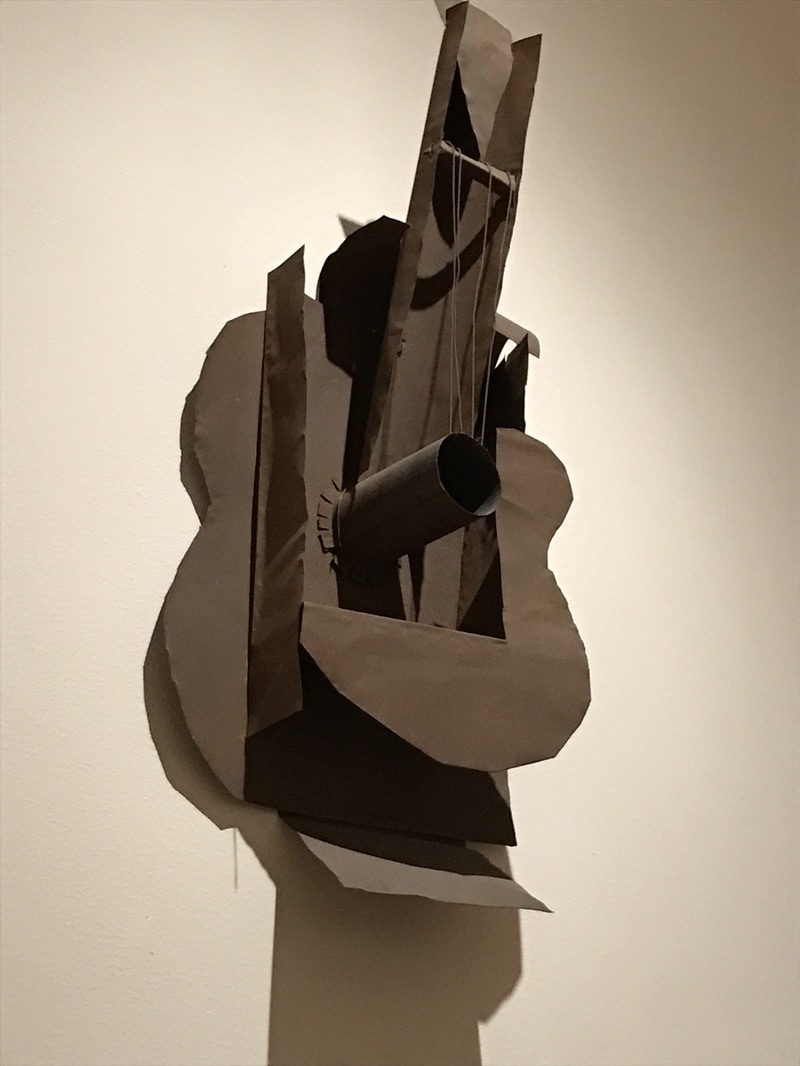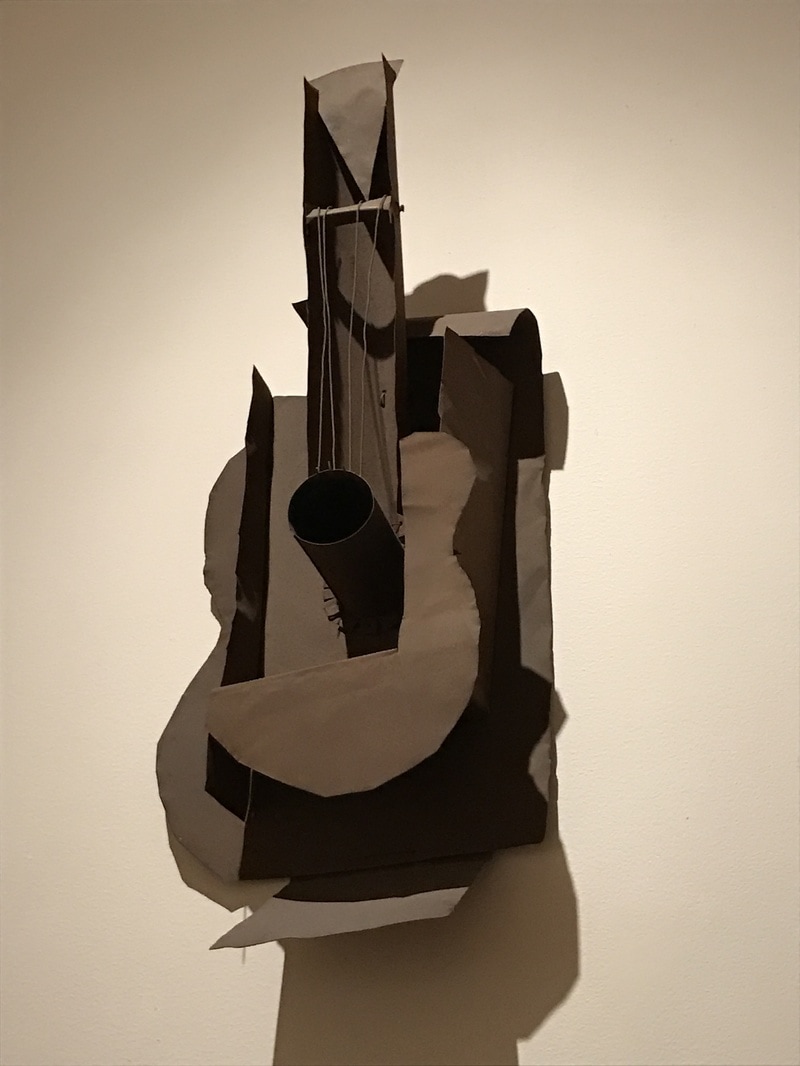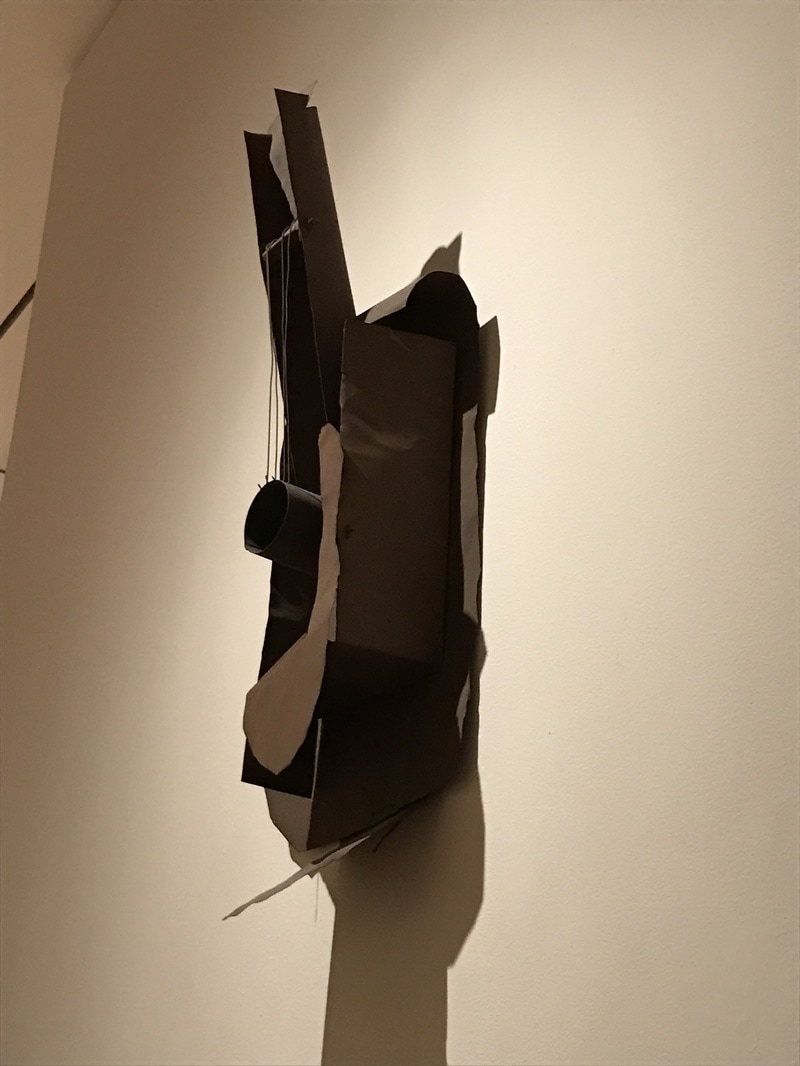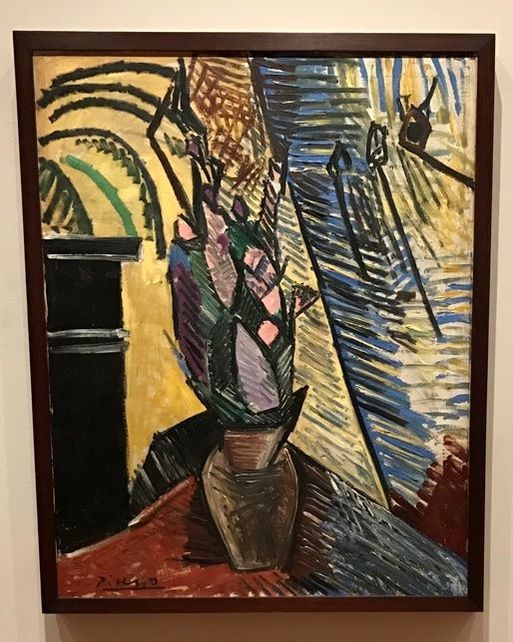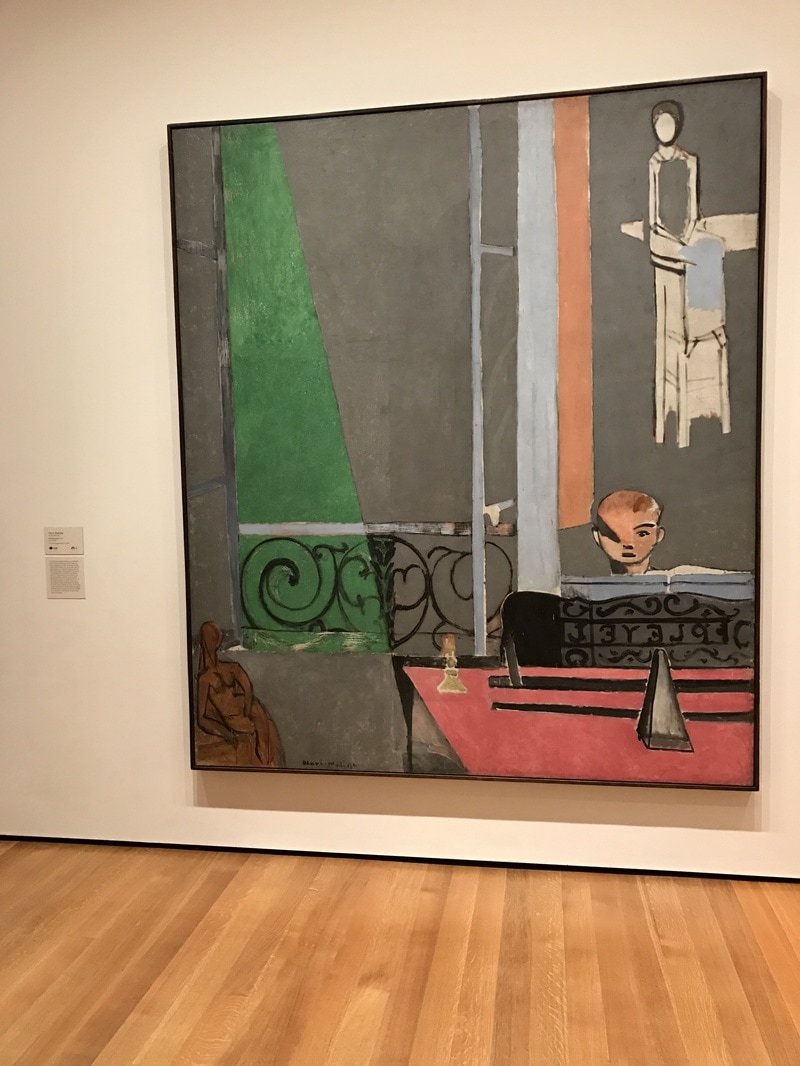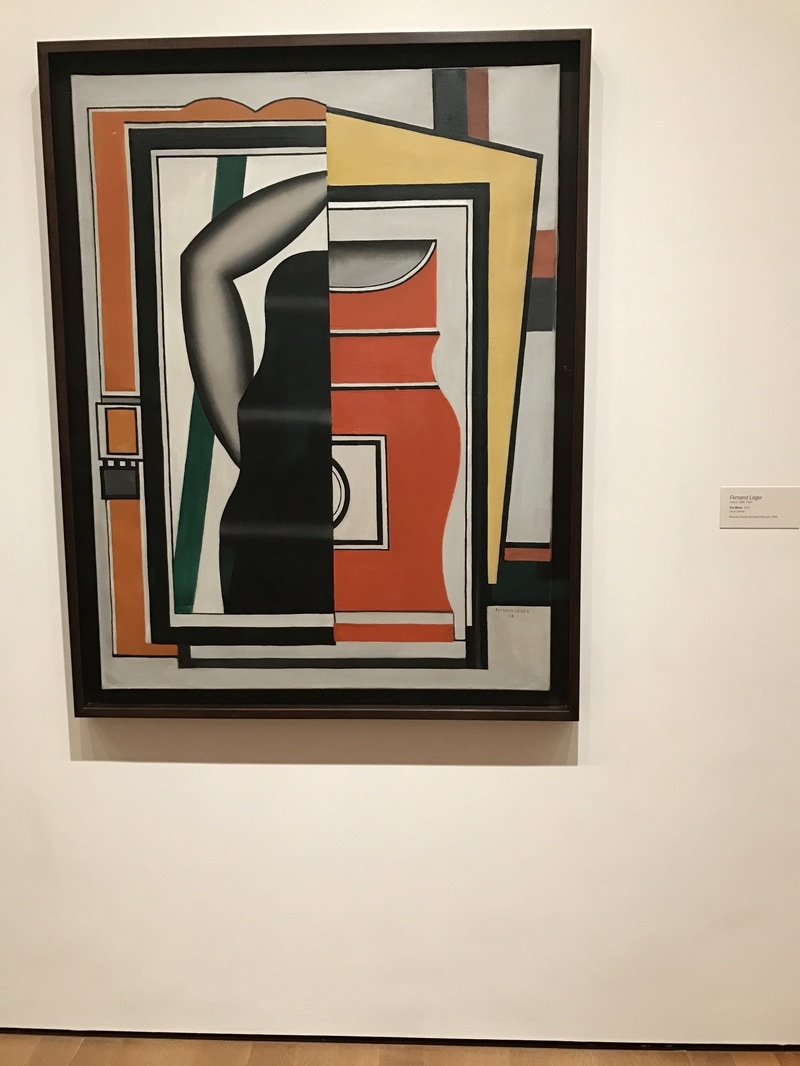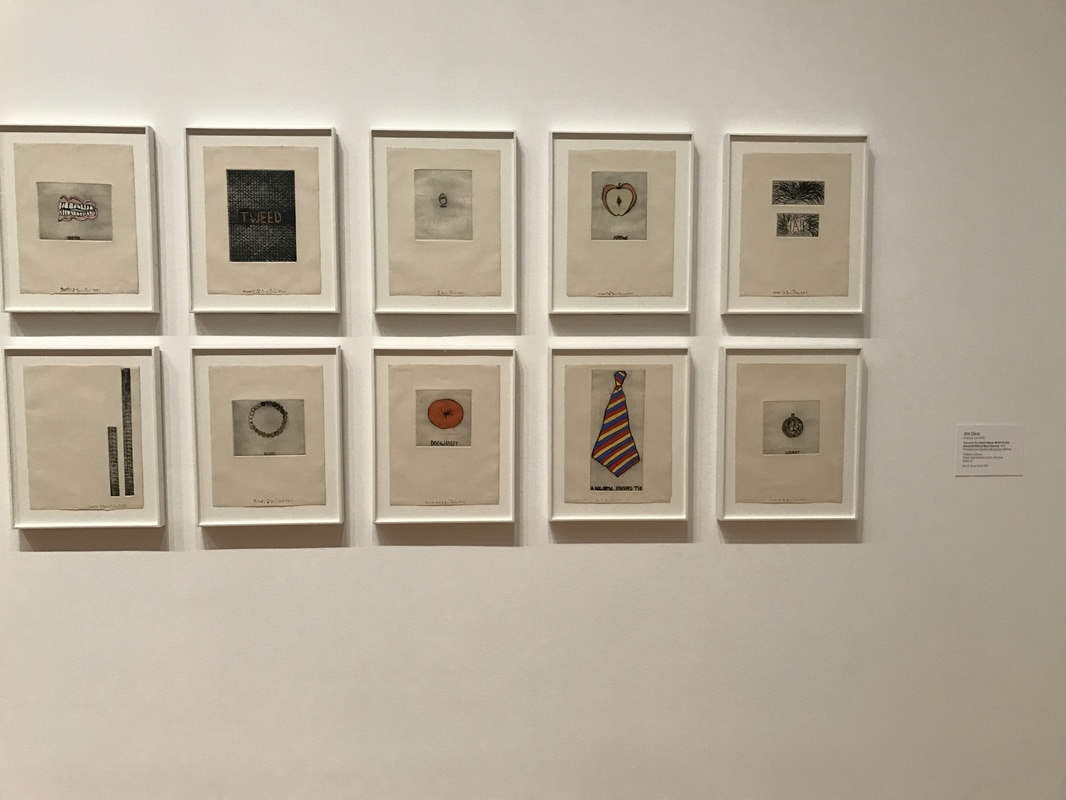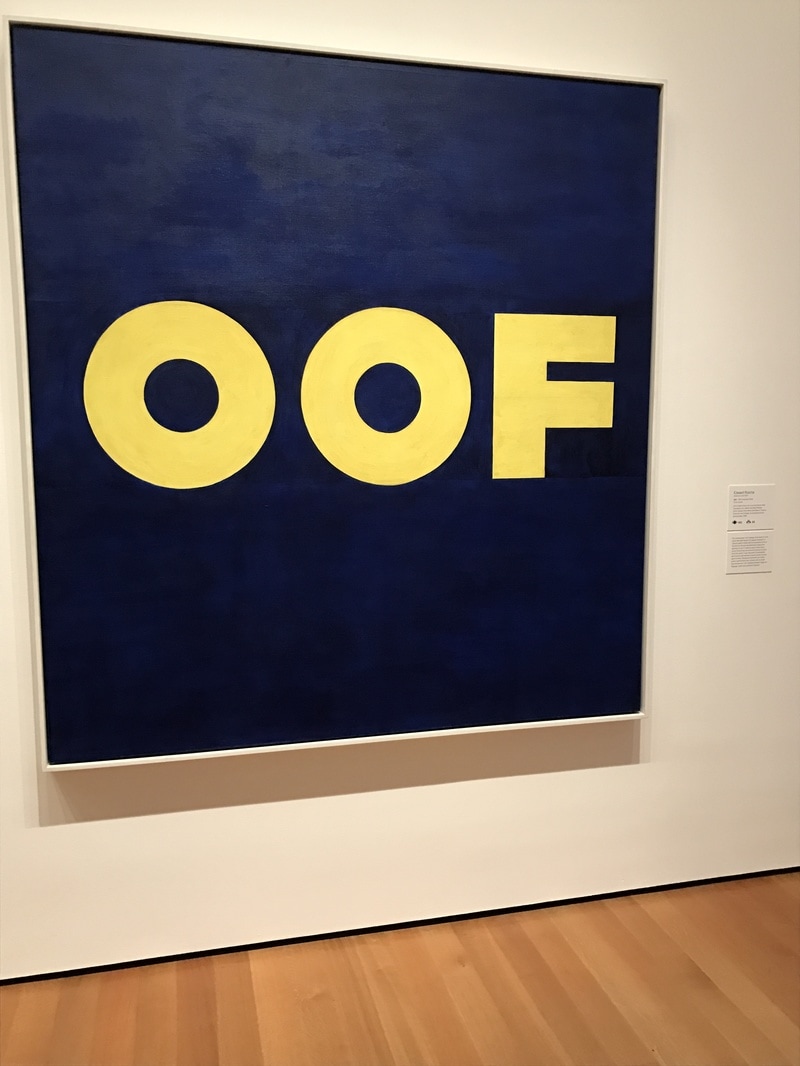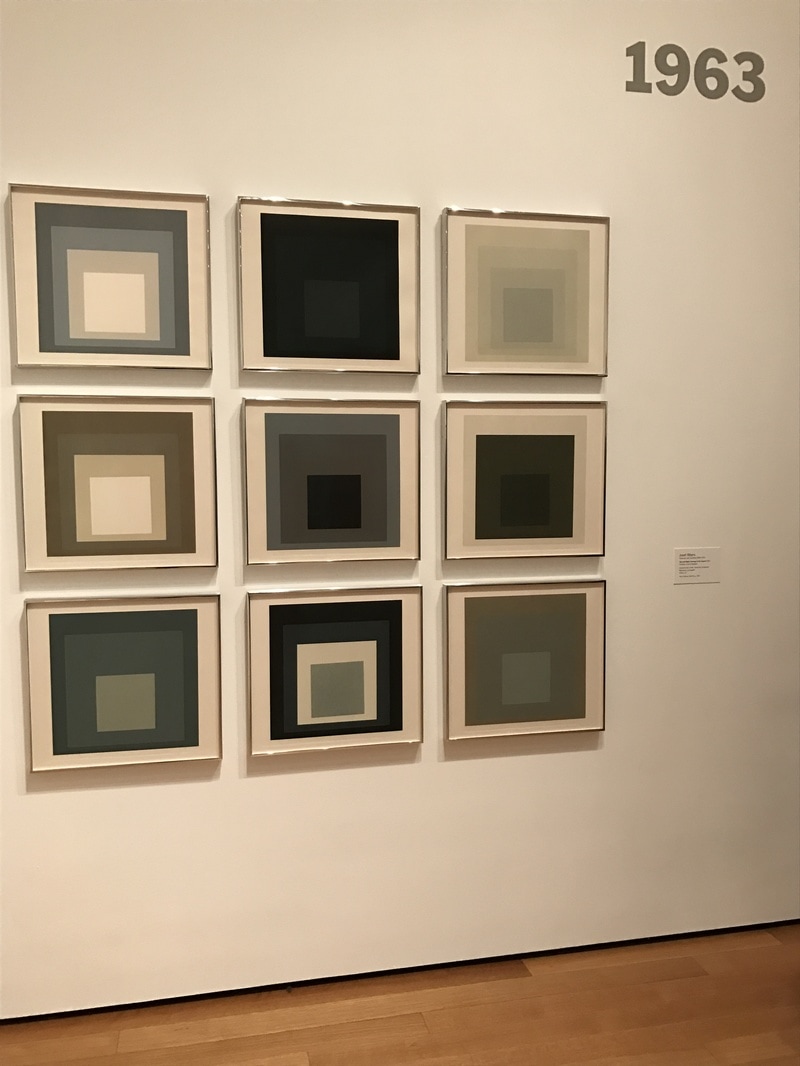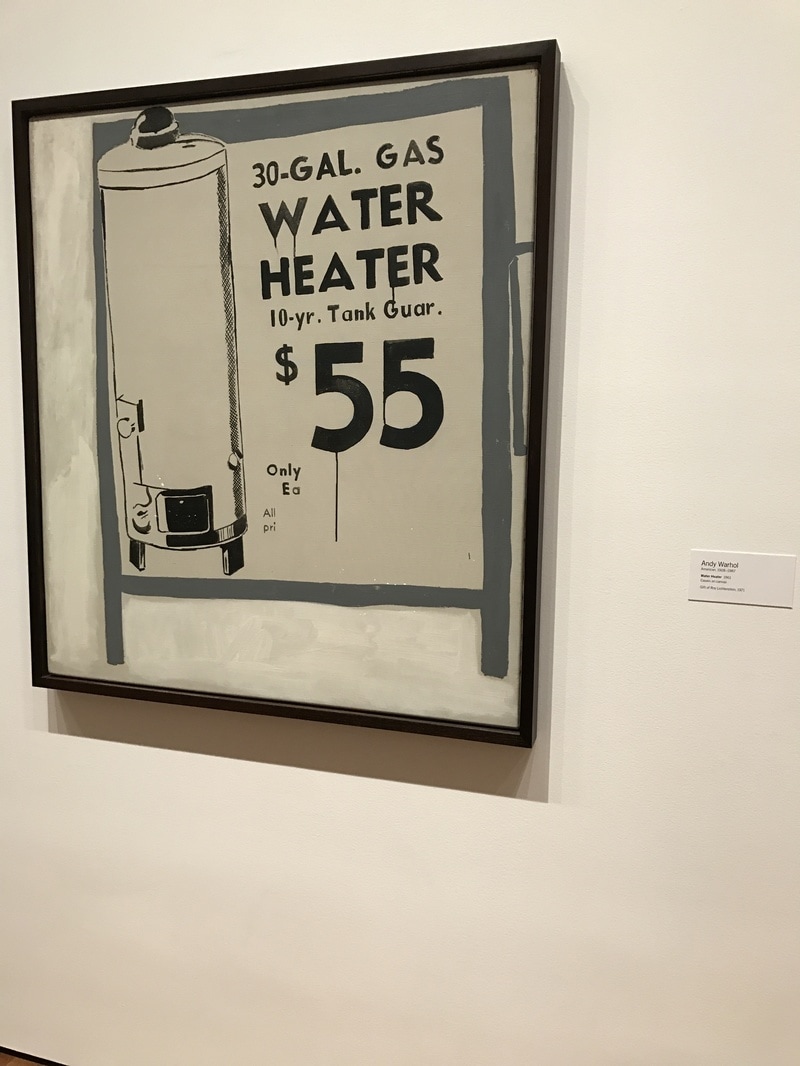Here is Willem de Kooning's 1937-1938 Oil on Masonite painting titled, "Untitled (The Cow Jumps Over The Moon). I learned that de Kooning was trained as a commercial artist and his artistic styles move back and forth between abstract and figurative methods. This painting below is one of his earlier works, which reminds me of Joan Miro's work to some degree. His later artwork, for which he is more well-known, is more gestural and epitomizes the abstract expressionism movement.
I stared at this painting below "Grazing Horses IV (The Red Horses), painted in 1911 by Franz Marc for quite a long time. Not because I love horses, but rather it struck me as fascinating. Franz Marc painted horses a lot, and was known for his preoccupation with animals. I learned that this particular painting was actually his first work of art to enter a museum's collection, the same year it was made. What struck me was his use of unnatural colors in a very natural scene. It's hard to see in the photo, but I was intrigued with the use of bright red in only one or two spots on the horses.
Below is Jasper johns' "The Dutch Wives", encaustic on canvas, created in 1975. If you haven't read my blog article on the Jasper johns retrospective exhibition at The Broad Museum in Los Angeles, you can find it HERE.
Below is a wonderful painting from a German artist that I was unfamiliar with named Corinne Wasmuht. It is titled, "50 U Heinrich-Heine-Str." oil on wood and created in 2009. The painting is a portrayal of Berlin's Heinrich Heine Street subway station and its surrounding neighborhood. It's hard to tell scale from photographs, but this is a huge painting and it's scale immerses the viewer, but the paintings various perspective points and different scales of objects also disorient the viewer. It's really a magnificent painting and I can see why it was gifted to Harvard's Busch-Reisinger Museum. Below are some fascinating samples taken from the Forbes Pigment Collection. Edward Forbes was the director of the Harvard Art Museums from 1909 to 1944. During his tenure, he traveled the world, collecting a large number of pigments for the library. Today, the Pigment Collection contains more than 2,500 samples that are beautifully displayed in cabinets on the 4th floor and are used to this day to help identify pigments used in historical artworks. I came across this wonderful, short video on the Forbes Pigment Collection that was created about 2 years ago. Check it out!
For more information about The Harvard Art Museums, please visit their website: www.harvardartmuseums.org. I definitely recommend visiting the Museum as you're in for a wonderful experience!
0 Comments
Here's a photo of me at the Los Angeles County Museum of Art in front of Chris Burden's sculpture, "Urban Light" installed in 2008. Burden restored over 200 cast-iron streetlamps to create this work of art. Burden was fascinated with urban life and how streetlamps are one of the fundamental building blocks of an urban metropolis. I found it interesting that the streetlamps were recently converted to LEDs, reducing the installations's annual energy consumption by 90%. The conversion to LEDs was funded by the Leonardo DiCaprio Foundation this year. Chris Burden was commissioned by Brandeis University's Rose Art Museum to create a similarly themed sculpture. You can see it by CLICKING HERE in an older blog article about the Rose Art Museum. Chis Burden's "Metropolis II" depicts an urban landscape. Burden created "Metropolis I" seven years before "Metropolis II". The earlier work featured eighty Hot Wheels cars zooming around a model city. This work is much larger and includes 1,100 custom designed cars, 18 highways, and a vast array of buildings and structures. The artwork runs on select days and times, so plan ahead! Richard Serra's "Band" is a massive sculpture that fills a huge exhibition hall from top to bottom, from front to back. The sculpture took two and a half years to develop. Made from over 200 tons of steel, it measures 12 feet high and over 70 feet in length. Below are two views of the same sculpture, titled "Phoenix" by Alexander Liberman, created in 1974-75. I love how a different view of this sculpture creates an entirely new image, a new feeling, a new perspective. "Levitated Mass" (Shown below) was conceived by artist, Michael Heizer, in 1969, but only realized in 2012. "Levitated Mass" is a 456-foot-long concrete pathway, over which sits a 340-ton granite boulder. As you walk down the pathway, it descends to fifteen feet in depth, directly underneath the massive boulder before ascending back up. Below are two views of the same Alexander Calder sculpture created in 1964 titled, "Three Quintains (Hello Girls)." It is made from sheet metal and paint with motor. To me, it appeared to be moved by the wind, but apparently it has a motor that moves the mobile sculpture.
In recent years as you've read in my previous blog posts, I visited museums like the Whitney, the Guggenheim, MOMA, the Brooklyn Museum, the New Museum, the Jewish Museum, just to name a few. I encourage you to look through the Categories Listing on the right side of this page and click on what interests you, whether it be museums, cities, or famous artists. The Met has been in the news this past week because it was announced that its admission policy is changing, requiring visitors to pay for admission (the Museum has been pay-as-you-wish for over 50 years). The new admission policy will go into effect on March 1, 2018. Residents of New York State, and students from New York, New Jersey, and Connecticut will remain pay-as-you-wish. Children under 12 will remain free. Be sure to check out their website for more information: www.metmuseum.org I'd recommend purchasing your ticket(s) online and arriving to the Museum when it first opens. You will wish you had more time for your visit if you don't! The line for admission seemed to span the entire length of the huge museum, but having purchased an advance ticket, I was able to walk in a separate door, check in, and head straight into the galleries. Admission will get you into the Met Fifth Avenue, the Met Cloisters, as well as the new Met Breuer. I didn't have the chance to visit the Met Cloisters and the Met Breuer. My visit to the Metropolitan Museum of New York on Fifth Avenue was amazing. First of all, it is massive. I forgot just how large the museum is that is located on the Upper East Side on Fifth Avenue between East 80th and East 84th Streets. This blog post covers my experience of the Metropolitan Museum of Art on Fifth Avenue, mainly what was on exhibit in their Modern & Contemporary Art galleries, 19th and Early 20th Century European Paintings and Sculpture, and some of their Asian Art collection. There were also two special exhibitions going on that I'll include: One on the hugely talented artist David Hockney. And the other on an artist that you may have heard of before, Michelangelo! At the end of this blog, I'll include a few other artistic surprises outside of the Met I encountered on my trip to NYC.
In Marc Chagall's painting shown below, "Le Pont de Passy et la Tour Eiffel," painted in 1911, we experience a fascinating view of Paris and the Eiffel Tower. The important thing about this painting is its composition. Chagall uses several converging diagonal lines: the bright red road, the orange cement wall, and the lines denoting the blue sky. If you think about the time period of the painting, it's interesting to note how it depicts some of the modern changes to the city of Paris, including the Eiffel Tower, the construction of the Pont de Passy Bridge and technologically modern train, electrical power-lines, and how it is juxtaposed alongside the element of the horses and wagon alluding to and earlier time in history.
With the onset of the Industrial Revolution, painters like Fernand Leger incorporated streamlined forms and contours of assembly-line production into their artwork. In the painting shown here, "Three Women by a Garden" painted by Fernand Leger in 1922, three generations of women are depicted. "Woman with a Cat" was painted in 1921.
Piet Mondrian is one of my favorite artists. Here is one of his iconic paintings called, "Composition" completed in 1921. It's an early example of the geometric style of painting that Mondrian called Neo-Plasticism, that emphasized planar relationships in painting, architecture, and design. Many people who look at my own personal artwork sometimes comment that they see hints of a Mondrian influence in my artwork. Here is Mondrian's painting at the Met, next to one of my paintings! Mondrian used black lines to divide the canvas into rectangles that are sometimes painted in shades of blue and red, creating lighter hues by mixing primary colors with white. Later on in his artistic process, Mondrian stopped creating these hues and used pure, primary colors. In comparing his painting with mine, we each use an entirely different process to create our black lines and blocks of color. If you notice, the black line at the bottom right of his painting doesn't quite reach the bottom. To me, it detracts from the overall design. Here are two other artists, whose works are hung alongside Mondrian's at the Metropolitan Museum of Art. I love Jackson Pollock's artwork! The painting below is called "Number 28" and was painted in 1950. His drip and pour paintings are widely recognized as his greatest achievement in art. He used simple sticks or paint stirrers and enamel house paint, sometimes poured right from the can, spilling lines directly onto raw canvas spread on the floor. What I love about his paintings are that the paint on the canvas we see is a record of the artist's creative process and his movement as he walked around all the sides of the canvas. One of the Special Exhibitions on display during my visit was "Michelangelo: Divine Draftsman and Designer." Michelangelo Buonarroti lived from 1475 to 1564 and is celebrated for his excellence of the power of drawing and invention that provided the foundation for all the arts. His drawing skills, design, sculpture, painting, and architecture all combined to give him the reputation of "The Divine One" by his contemporaries. The exhibition showed a range of over 200 works by the artist that was pulled together from 50 public and private collections across the United States and Europe. The exhibit opened in November and is on view through February 12, 2018. Below are just two of his incredible artworks I saw at the Met. #MetMichelangelo During my visit there was a magnificent exhibit of the British artist David Hockney that showcases 60 years of his art career. I highly recommend visiting this exhibit that is at the Met Fifth Avenue through February 25, 2018. David Hockney's painting address translating movement, space, and time into a two dimensional painting. Hockney is probably best known for depicting California swimming pools and backyards in the mid-1960s. Many of his paintings are quite large, perhaps over 6 or 7 feet square. I love how he uses Acrylic paint on canvas.
Alexander Calder created a series of moving sculptures called mobiles that he created in a diverse range of abstract configurations. Shown here, is a free-moving wind mobile that is carefully balanced on a movable pivot point. I learned that he was inspired by the work of Joan Miro, and the similar shapes and forms can be observed in Calder's mobiles. In the video below, you can see the kinetic nature of his mobile, "Mobile" created in 1941 from painted aluminum, steel, steel rod, and wire. Here are some of Claude Monet's masterpieces...
And lastly, I came across these wonderful sculptures created by artist, Jaume Plensa, that are permanently installed at the Grand Hyatt Hotel near Grand Central Terminal. I learned that these two huge sculptures are reminiscent of the Moai sculptures on Easter Island. Overall, my visit to the Metropolitan Museum of Art was simply amazing. I could have spent the entire day looking at all the art and taking photos of every piece of artwork, but I could only include these 6 dozen or so photos! I wish I had the time to visit Met Cloisters and Met Breuer as well. Well, reason for another visit! I hope you enjoyed this blog and I welcome your comments! Have a friend who would enjoy reading this blog? Then please share it with them via email or social media! You can click on the Facebook and Twitter buttons below! PS: If you liked this article, you might like these other articles on my artistic travels:
Kennebunkport, Maine Los Angeles, California New York City Street Art Napa Valley, California Park City, Utah Barcelona, Spain Caribbean Art I had the pleasure of visiting the Museum of Fine Arts Boston, which is always an incredible experience. There are always new exhibits to see as well as a chance to see some of one's favorite works of art since visiting last. Henri Matisse, perhaps one of the most famous artists in the world, was the subject of a fascinating exhibit. The "Matisse in the Studio" exhibit pushed the limits of how one experiences Matisse's work. Having seen his artwork countless of times at museums all over the world, including visiting the Matisse Museum in the south of France, I've never quite have seen artwork presented in this unique format. Henri Matisse was an artist who revolutionized 20th Century art. This international exhibition examines the critical importance of the objects in Matisse's studio and how they influenced his creative process and finished artwork. The exhibit has a number of thematic sections that each focus on different stages of his career as an artist. Matisse didn't limit his work to one medium like painting or sculpture, but also did many drawings, cut-outs, collages, prints, and more. What makes this exhibit particularly fascinating is that the artwork is presented next to the objects that helped inspire Matisse's creativity and served as subject matter for much of his work. Matisse found inspiration everywhere: In sculpture, in a chocolate pot, textiles, furniture. Below, the pewter jug served as inspiration for the painting below. You can see how the curved lines of the jug, the waviness, are imitated in the lines of the background tapestry, the woman's robe, and the actual jug he painted as a vase of flowers. As you can see in the close-up photos below, the wavy lines are not painted on, but Matisse rather scratched the paint off the surface of the canvas. This reminds me of how I used this technique in some of my artwork. You can see some of those paintings here and here. Show above is a table that appears in the painting to the left. And below is a female torso Roman sculpture that Matisse used to create the "Formes, Plate IX" for the illustrated book "Jazz". Matisse used cut paper as its own medium. He also uses Guache paint on paper that he cut and pasted on canvas to create "Mimosa" and "Panel with Mask". The movie, "A Model for Matisse" discussed the relationship between Matisse and his longtime friend and nun, Sister Jacques-Marie. Their relationship began when she started working for him as his nurse, but later she often served as a model for Matisse's most famous artworks. The nun also helped paint the paper that Matisse used for his cutouts. The sister was instrumental in helping Matisse design the Vence Chapel (the Chapelle du Rosaire), one of his greatest accomplishments in his career as an artist. The two large cutouts were designs for the robes that the priests were to wear while celebrating Catholic Mass. The "Matisse in the Studio" exhibit runs from April 9, 2017 to July 9, 2017. For more information, please visit www.mfa.org.
Art of the Americas. Level 3 Below is just a few snapshots I took during this visit to the MFA, some of my old favorites as well as some new favorites. Below from are some wonderful photos of Piet Mondrian's work, "Composition with Blue, Yellow, and Red," Georgia O'Keefe's "White Rose with Larkspur No. 2," Joseph Stella's "Old Brooklyn Bridge" large, oil on canvas painting, Pablo Picasso's sculpture, and his "The Bull" series completed in 1945 and 1946. Also below are two of Jackson Pollock's incredible paintings, along with a close up shot of his drip-work, splattering, etc. and lastly, I've included a piece by Charles Sheeler titled "On a Shaker Theme" and an incredible work of art by Stuart Davis, "Apples and Jug" where he takes the traditional still-life and transforms it into his modernist universe, with elements of cubism and even of advertising imagery. Contemporary Art In the Contemporary Art galleries, two pieces struck me on this visit. One is Carmen Herrera's, "Blanco y Verde (#1)", Acrylic on Canvas. Originally from Havana, Cuba, Herrera studied painting in New York. The simplicity of the forms here was really striking. I love the exactness of her straight lines, and her minimal use of color. We don't know if there is a background or a foreground, and we almost lose our-self within the painting completely. Carmen Herrera recently had a retrospective exhibit of her work a the Whitney Museum of American Art a few months ago.
Memory Unearthed: The Lodz Ghetto Photographs of Henryk Ross This powerful exhibit recently opened in March and will be on view through July 30, 2017. “Memory Unearthed” is a very moving exhibit that provides a rare glimpse of life during the Holocaust. Holocaust Survivor, Henryk Ross took this incredible display of photographs of life inside the Lodz Ghetto from 1940 to 1944. Henryk Ross was confined to the Lodz ghetto in 1940 and enlisted by the Nazi regime as a bureaucratic photographer taking photos for Jewish identification cards, for propaganda materials, etc. Secretly, Henryk Ross documented the horrible living conditions and persecution of the Jews under the Nazis. Ross his the photos and negatives before the last of the Jews were sent from the ghetto to the Auschwitz and Chelmno death camps. The photos seen in this exhibit survived because Ross buried the photos and negatives hoping to provide a historical record of the persecution of the Jews. All the photos were very powerful to see. However, there was one piece of artwork that I found completely incredible and breathtaking from an artistic perspective. I've included the photo below. It is actually a modern print from an original 35mm negative, depicting Ghetto police escorting residents for deportation. The image itself and the unfortunate and horrifying circumstances in the photo are very compelling. But beyond the face value of what is happening in the photo, you can see that the negative is partially destroyed, burned, or deteriorating. From one perspective, the visual piece of artwork is quite beautiful and striking. And from another perspective, it is quite ugly, off-putting, sad, and even symbolic. This exhibit helps us Never Forget the horrors of the Holocaust and its victims of persecution and death. Overall, this was an incredible visit to the Museum of Fine Arts Boston. With every visit, there are new things to see, experience, learn, and explore.
Part 1: Barcelona Architecture One cannot talk about Barcelona's architecture without mentioning Antoni Gaudi. Part of the Modernista movement of the late 19th Century, Antoni Gaudi is Barcelona's most famous architect. Almost anywhere you look in Barcelona, Gaudi had some part in its creation, from the houses, apartment buildings, churches, sidewalks, parks, and even the city benches lining the streets. In Modernism, nature was a huge element present in decorative motifs as well as present in the actual architectural structure of Gaudi's buildings. Below are some of Gaudi's masterpieces, but there are dozens of others throughout Barcelona to visit and experience. Casa Batllo I really enjoyed seeing Casa Batllo, which is situated on a main street in the heart of Barcelona. Mosaic is everywhere. The Chimneys of the building are works of art. The roof is representational of a dragon's back. The exterior facade demonstrates Gaudi's expert use of texture and color. Below are some photos of the exterior of the building as well as the interior. The sidewalk tiles as shown in the photos below line the streets and feature an underwater, marine-life motif. Sagrada Familia Gaudi's Sagrada Familia is innovative and highly symbolic. The architect's objective was to explain the teachings of the Church through sculpture and architecture. Following Gaudi's death, work on the Sagrada Familia continues to be carried out by collaborating architects and artists. The project is expected to be complete by 2026, coinciding with the 100th anniversary of Gaudi's death. The stained glass windows were perhaps one of the most beautiful aspects of the Sagrada Familia. The colors were so vivid and bright. Park Guell Park Guell is another one of Gaudi's masterpieces. It was build between 1900 and 1914. It was opened as a public park where Gaudi let his imagination run wild with his incredible use of mosaics throughout the park. Below are some photos of Park Guell. The mosaic work is unbelievable and reminds me very much of the mosaic illusion that I paint in many of my own paintings. La Pedrera La Pedrera is also known as Casa Mila. It was completed in 1912 as an apartment building. There are curved walls that seemingly defy the laws of gravity. The rooftop is amazing at night and includes all of Gaudi's architectural trademarks. Bricks in the attic create arched ceilings and are uniquely used using the log side of the brick, which also features the brick-maker's fingerprints. There are terrific wrought iron balconies and exquisite ceramic mosaics. I highly recommend visiting La Pedrera by booking a night tour, which includes a full tour of the building and a surreal visual light display on the rooftop under the stars, followed by a champagne toast and cookies! Although my time in Barcelona didn't permit me to visit the Palau Guell, I should mention that it is an excellent example of one of Antonio Gaudi's early architectural masterpieces. It is a UNESCO World Heritage Site, and is a magnificent example of domestic architecture in the context of Art Nouveau and one of the first important commissions Gaudi received at the start of his career. It is located just steps away from La Rambla, not far from La Boqueria. Part 2: Barcelona's Art Museums and Fine Art A Guide to Visiting Barcelona's Museums: If you plan to visit Barcelona, I highly recommend purchasing the Barcelona Museum Pass, also known as an art passport from ArtTicket BCN, which will give you access to six Barcelona museums, including the ability to skip the lines. The Passport give you access to the Picasso Museum (Museu Picasso), the Joan Miro Museum (Fundacio Joan Miro), the National Museum of Art of Catalunya (Museu Nacional d'Art de Catalunya), the Antoni Tapies Museum (Fundacio Antoni Tapies), the CCCB, and the MACBA. I purchased the passport online (for 30 Euros), and simply showed the ticket to the first museum I visited to receive the passport. The passport is stamped upon entry at each museum. To learn more about the ArtTicket BCN, check out their website: http://articketbcn.org/en/barcelona-museum-pass. I should also mention that it is very important to check the hours of each of the museums as they vary significantly. Most museums, with a few exceptions, are closed on Mondays. Also, all city museums are free at last one afternoon per month, so be sure to check the websites in advance for hours and special exhibition dates. If you're interested in contemporary art, check out this website that provides a network devoted to contemporary art in Barcelona: http://www.artbarcelona.es/circuit/en/. Picasso Museum in Barcelona The Museu Picasso of Barcelona is a wonderful center documenting Pablo Picasso's early years of apprenticeship. With over 4,000 works of art in its permanent collection, you'll see why this museum is one of the most popular tourist attractions in Barcelona. The Picasso Museum highlights the artist’s relationship with the city of Barcelona. I learned that Pablo Picasso's father was a teacher at the San Telmo Fine Art and Crafts School. and had an important influence on Picasso's future career as an artist, who demonstrated a strong interest in art from a very young age. There are some drawings and small panels in oil that give an idea of his efforts to give his own creativity free rein and explore new techniques by taking in his immediate environment. In Barcelona, Pablo Picasso continued his art education at the La Llotja Fine Art School. The photos here show his artwork featuring Barceloneta Beach and two ports. After taking these photos, I learned that photos were not allowed, so unfortunately, I do not have photos showing the rest of the museum. This Picasso museum focused on his earlier works, and very few on display were "well-known Picasso masterpieces." The museum highlighted Picasso's creative process of some of his work of his Blue Period. Some of the highlights of the museum included Las Meninas Series. This was a series of paintings based on the Velazquez painting Las Meninas. For more information, please visit www.museupicasso.bcn.cat. Fundacio Joan Miro The Joan Miro Museum (Fundacio Joan Miro) is located in the Montjuic area of Barcelona and houses the work of Joan Miro as well as temporary exhibitions of 20th and 21st Century art. The collection of paintings, sculptures, drawings displayed at the museum is one of the most comprehensive collections representing every stage of Miro's career as an artist. There are paintings related to Surrealism and works based on the Spanish Civil War. Miro's work on large canvases in the late 1970s onward demonstrate his use of large color fields and painting with free gesture. For more information, please visit www.fmirobcn.org.
Museums Further Afield from Barcelona: In the town of Girona, I visited the Museum of Jewish History. The goal of the Museum is to preserve the history of the Jewish communities of Catalunya. Art at this museum included various Jewish ritual objects. Be sure to visit if you are in Girona, which is not far from Figueres, where the Dali Museum is located.
On of my favorite pieces was this one below entitled, "Gala Contemplating the Mediterranean Sea which at a distance of 20 meters is transformed into the portrait of Abraham Lincoln (Homage to Rothko).” Gala was his wife and muse for many years. The exterior of the museum is a work of art as well. Statues with loaves of bread on their heads. Inside the museum in the open air courtyard is a spectacular and wild work of art called, "Rainy Taxi". If you put a Euro in the slot located at the base of the artwork, it will rain inside the taxi, and an umbrella will open up on top of the artwork!
The museum includes paintings by Old Masters with works from the 13th Century to the 18th Century. The largest section of the museum is devoted to works from the 19th and 20th Centuries and includes a wonderful selection of Catalan painting and sculpture of the Modern period. I was very impressed with their collection of paintings by the great masters of French and international impressionism (Degas, Sisley, Monet, Pisarro, Sargent, etc.). Picasso and Dali, avant-garde artists are also well represented! Part 3: Barcelona's Public Art The streets of Barcelona are filled with art by world renowned artists. Below are just a few of these that I came across on my artistic journey.
PS: If you liked this article, you might like these other articles on my artistic travels:
Los Angeles, California New York City New York City Street Art Napa Valley, California Park City, Utah Caribbean Art
Just recently, on February 14th, I came across an editorial article on Artsy.net by Isaac Kaplan entitled, "Do Francis Picabia's Anti-Semitic Remarks Tarnish his MoMA Retrospective?" After reading the article I learned about Picabia's anti-Jewish feelings (and womanizing behaviors). MoMA's exhibit apparently does address this part of Picabia's character; however, I must have missed this as I walked through the gallery. To answer Kaplan's question personally. I think it does, in fact, tarnish his reputation. I really enjoyed his artwork during my visit to the MoMA. But after learning more about the artist, I can't say that I can admire him. Famous artists are people that I want to look up to and admire. They are people that I want the next generation of artists to look up to. And so, while I can appreciate his artwork at face value and his artistic technique, learning about his anti-Semitic behavior does take him down several notches in my book. Similarly, just like we want our kids to admire our professional sports players, it's hard to have our kids look up to them if they do drugs, treat women badly, are anti-gay, or are anti-Jewish, or discriminate in any way. So, I'm kind of let down after my great experience viewing his work in the gallery. But for this blog article, I will continue to proceed sharing my thoughts on the exhibit as if I hadn't learned of his anti-Semitic feelings and behavior. Here is the link to the article for your information: https://www.artsy.net/article/artsy-editorial-francis-picabias-anti-semitic-remarks-tarnish-moma-retrospective As I walked though the gallery rooms, the one thing that struck me the most was how his artistic style changed throughout his lifetime. Picabia was an artist of many genres, and his body of work lacks consistency and categorization. He shifted styles over time. The exhibit highlights his impressionist landscapes, abstract works, paintings, photo-based nudes, etc. Here are some photos from the exhibit. These two Picabia paintings shown below reminded me of one of my own paintings that I painted earlier this past year, "Woof Woof! Gotta Get My Bone." All three works utilize black lines in a similar fashion. I should note that my painting was created without ever seeing Picabia's work; I am just noting the coincidence in how we both used these lines in the same fashion. "Revolutionary Impulse: the Rise of the Russian Avant-Garde" was another wonderful temporary exhibit at the Museum of Modern Art that runs through March 12, 2017. The fact that all the artwork on display comes directly from MOMA's permanent collection, demonstrates how wonderful MOMA is and how impressive their permanent collection is. Of all the artwork on view, there were two artists whose work caught my eye. The two photos below are from the Russian artist Alexandra Exter. The oil on canvas painting on the left, called "Theatrical Composition" was very intriguing to me. I loved the colors, shapes, and overall composition of the painting. The other smaller works, pictured to the right are six designs from various stage sets like The Merchant of Venice, Othello, and others.
To photograph all the well-know paintings from all the famous artists would be a huge undertaking. So I'm including a small selection of some of my favorite pieces along with some detailed close-up photos from the following artists: Georges Seurat, Vincent van Gogh, Pablo Picasso, Jasper Johns, Henri Matisse, Fernand Leger, Jim Dine, Andy Warhol, Edward Ruscha, Josef Albers, James Rosenquist, Robert Rauschenberg, and Sol LeWitt. I have the close-up photos to show the brushstrokes, the detailed use of color, and a glimpse into what the artist was focused on while painting their masterpiece. Pablo Picasso's Guitar Sculpture (3 views), and below, "Vase of Flowers" & "Les Demoiselles d'Avignon I highly recommend visiting the Museum of Modern Art in New York City. More information about the museum can be found on their website: www.moma.org. PS: If you liked this article, you might like these other articles on my artistic travels:
Kennebunkport, Maine Los Angeles, California New York City Street Art Napa Valley, California Park City, Utah Barcelona, Spain Caribbean Art |
The Art ConnectionWelcome to Eddie Bruckner's Art Blog! Archives
April 2022
Categories
All
|
